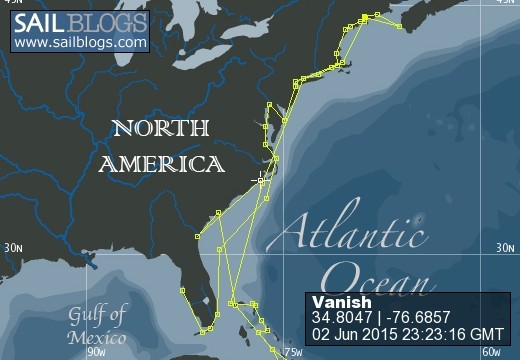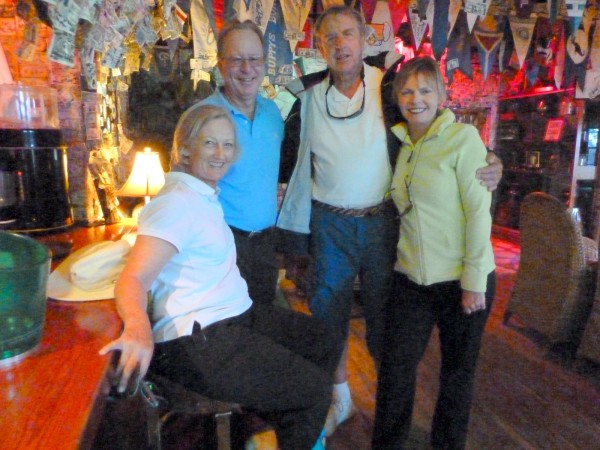

Vanish - Making The Switch From Sail to Power
29 October 2016 | Georgia, USA
29 October 2016 | Georgia, USA
08 October 2016 | Brunswick, Georgia, USA
07 October 2016 | Hotel on West Side of Hwy I-95, Brunswick, GA, USA
07 October 2016 | Brunswick, Georgia, USA
06 October 2016 | Brunswick, Georgia, USA
05 October 2016 | Brunswick, Georgia, USA
04 October 2016 | Photo off Outer Banks near Cape Lookout, North Carolina.
27 September 2016 | Piankatank River, Chesapeake Bay, Virginia, USA
22 September 2016 | Current Position - Sassafras River, Chesapeake Bay, Maryland, USA
16 September 2016 | Orient, Long Island, New York, USA
11 September 2016 | Ebenecook Harbor near Boothbay Harbor, Maine, USA
07 September 2016 | Penobscot Bay, Maine, USA
05 September 2016 | Penobscot Bay, Maine, USA
04 September 2016 | North Haven, Vinalhaven, Maine, USA
28 August 2016 | Castine, Maine, USA
27 August 2016 | Belfast, Maine, USA
12 August 2016 | Mount Washington, New Hampshire, USA
06 August 2016 | Canada/USA Border Crossing
04 August 2016 | La Malbaie, Quebec, Canada
George Stakey
29 October 2016 | Georgia, USA
Vicki
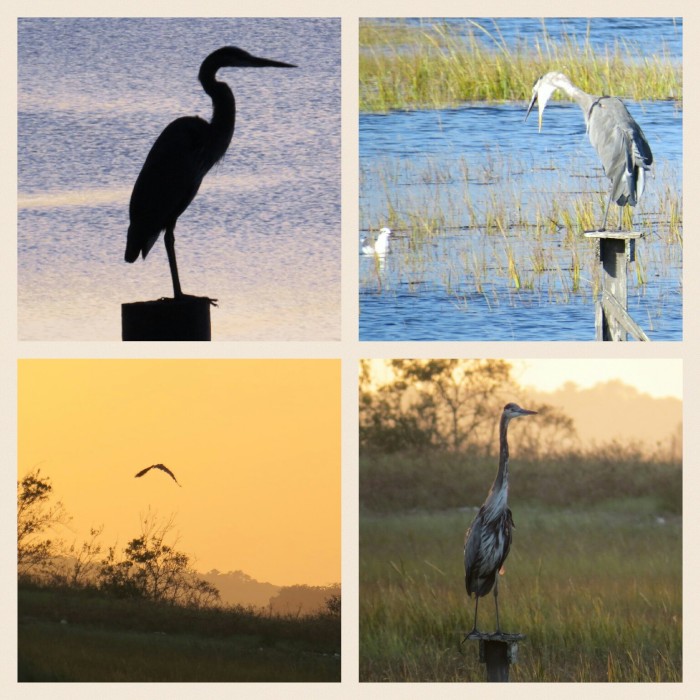
Being a bit of a bird enthusiast, I've been observing a great blue heron that lives in the marshes opposite Vanish at the marina. He is often seen standing on a stake, hence Maynard named him Stakey. One morning he landed on the stake at 8 a.m. and did not move until sunset but where he went was a mystery. He stood in the hot sun without eating or drinking all day. He often hangs out with the Gang of Fluff in a dead tree; an osprey, a couple of pelicans, a white form of a blue heron and a bunch of red-winged blackbirds. This scenario happens almost every day with the same birds doing the same things. One day I asked our neighbours on Black Pearl if they'd noticed Stakey. "Oh yes, that's George. He just LOVES your boat!" What do you mean? "Well, we just love watching him when he stands on your pulpit when you return to Australia on holiday every year. What! Sure enough, I waited until dark, crept up to the bow and there was George Stakey happily sound asleep dreaming and pooping to his heart's content. Not good.
Shocking Donnie
29 October 2016 | Georgia, USA
Vicki – Air 26 deg c, Sunny, 10 kn NE
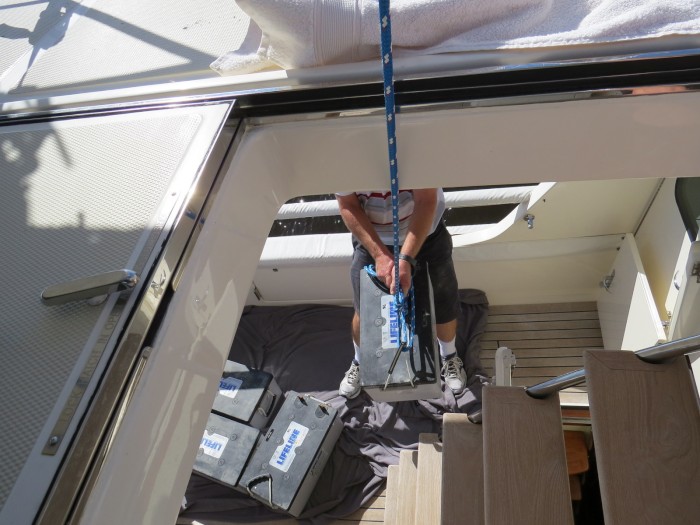
Not knowing whether Vanish would make it through the hurricane, we removed what we thought we would need in the weeks following the storm such as some clothing, food, electronics, chargers and valuables. The first week was spent returning things to normal on board and cleaning the marshland mud which covered much of the yacht. During the cleanup I actually found a 1" rock up on the aft top bridge deck which must have blown across the ditch in the 93 mph winds. Quite extraordinary. We figured that the supermarkets would have thrown away much of their food as electricity was turned off for a few days however, at least one store called Publix had invested in a generator and was well stocked the entire time. It was amazing to see how fast the authorities removed fallen trees and limbs and restored power and collected storm debris along the marshland roads. Within two days, restaurants and businesses were back open in our area.
With everything pretty much back to normal we organized for Ring Power, the Caterpillar dealer in Jacksonville, FL to come and replace the titanium aftercooler cores on both of our C-18 engines. It's a very big job taking two mechanics two days and needs to be done every six years. These cores, which cool exhaust gases are pretty exotic and are incredibly heavy. If these cores spring even a minute leak because they have saltwater running through them their entire lives, can and often do destroy engines.
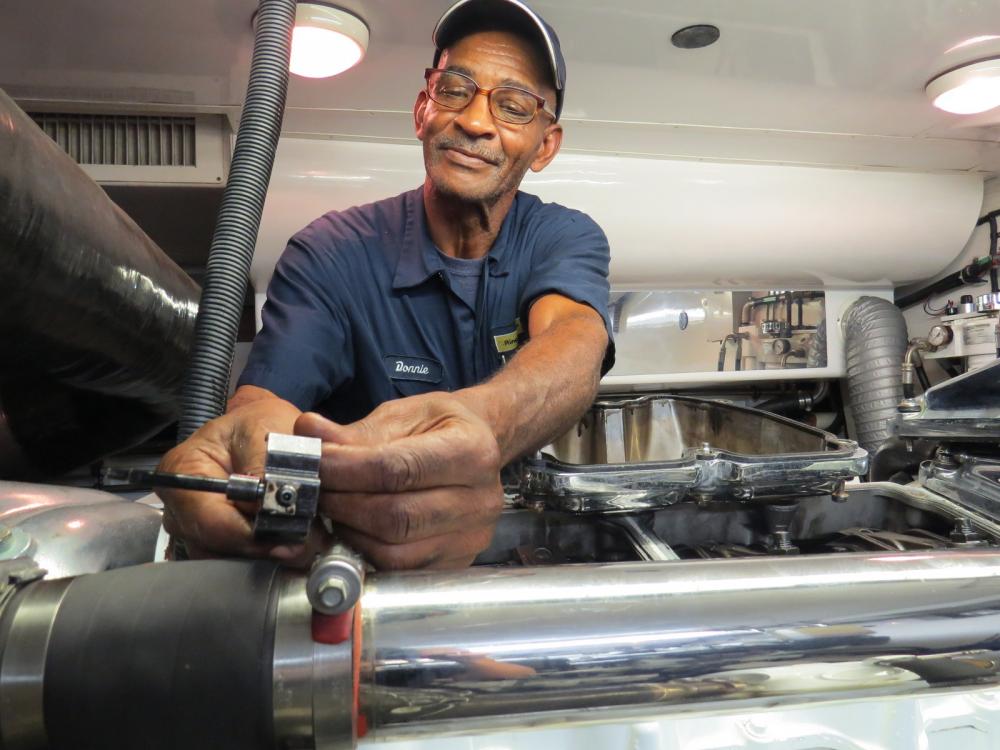
After the job was done, the engines were test run and while Donnie was leaning against the port engine valve cover, he was repeatedly shocked. He and Nick shut down the engines immediately and removed the valve cover. They were shocked to find a valve injector height tool, which was used by a mechanic last year while adjusting the valves, had been inadvertently left under the valve cover and was shorting out one of the injectors. They both commented how lucky we were that this oversight had not caused enormous amounts of damage. The tool was removed, the valve cover put back on and the engine ran normally. Nick also thought he heard a squeal in the alternator and recommended we replace it. Even after 6 years we are still covered by warranty so we naturally had it replaced.
Maynard had observed recently that the port side engine starting batteries had not been holding a charge as well as they should have. This possibly could be a result of a poorly performing alternator but as the batteries are six years old, we decided to replace all four 8DL Lifeline engine starting batteries. Unfortunately these batteries are located in a cabinet under the crew bed below a pair of house batteries. Given that the combined weight of these six batteries are over 1,000 lb and access to get even one of the batteries is difficult and limited, we wondered how in the world we two old-aged sailors were going to get them out. (Yes, it would have been easy to hire a few beefcakes but we wanted to try the do-it-yourself method.)
I noticed that our starboard side crane might just work to lift the batteries out of this difficult space. There is a sliding panel in the bridge deck located directly above the steps leading down to the crew cabin bunk. The cable from the crane was lowered through the bridge deck and down into the crew cabin. We set to work and slowly but surely all engine batteries which needed replacing were brought up on deck one at a time very slowly and carefully. The following day, the new batteries were delivered and knowing the task ahead, we hired a young man for a couple of hours to help Maynard maneuver them all back into place while I manned the crane. We were highly satisfied with our efforts.
Each day we are ticking off our boat jobs, and working out what comes next.
(For more photos, see Gallery named Shocking Donnie)
With everything pretty much back to normal we organized for Ring Power, the Caterpillar dealer in Jacksonville, FL to come and replace the titanium aftercooler cores on both of our C-18 engines. It's a very big job taking two mechanics two days and needs to be done every six years. These cores, which cool exhaust gases are pretty exotic and are incredibly heavy. If these cores spring even a minute leak because they have saltwater running through them their entire lives, can and often do destroy engines.
After the job was done, the engines were test run and while Donnie was leaning against the port engine valve cover, he was repeatedly shocked. He and Nick shut down the engines immediately and removed the valve cover. They were shocked to find a valve injector height tool, which was used by a mechanic last year while adjusting the valves, had been inadvertently left under the valve cover and was shorting out one of the injectors. They both commented how lucky we were that this oversight had not caused enormous amounts of damage. The tool was removed, the valve cover put back on and the engine ran normally. Nick also thought he heard a squeal in the alternator and recommended we replace it. Even after 6 years we are still covered by warranty so we naturally had it replaced.
Maynard had observed recently that the port side engine starting batteries had not been holding a charge as well as they should have. This possibly could be a result of a poorly performing alternator but as the batteries are six years old, we decided to replace all four 8DL Lifeline engine starting batteries. Unfortunately these batteries are located in a cabinet under the crew bed below a pair of house batteries. Given that the combined weight of these six batteries are over 1,000 lb and access to get even one of the batteries is difficult and limited, we wondered how in the world we two old-aged sailors were going to get them out. (Yes, it would have been easy to hire a few beefcakes but we wanted to try the do-it-yourself method.)
I noticed that our starboard side crane might just work to lift the batteries out of this difficult space. There is a sliding panel in the bridge deck located directly above the steps leading down to the crew cabin bunk. The cable from the crane was lowered through the bridge deck and down into the crew cabin. We set to work and slowly but surely all engine batteries which needed replacing were brought up on deck one at a time very slowly and carefully. The following day, the new batteries were delivered and knowing the task ahead, we hired a young man for a couple of hours to help Maynard maneuver them all back into place while I manned the crane. We were highly satisfied with our efforts.
Each day we are ticking off our boat jobs, and working out what comes next.
(For more photos, see Gallery named Shocking Donnie)
We're Through
08 October 2016 | Brunswick, Georgia, USA
Brunswick – Air 26 deg C, Cloud 6/8, Wind WNW 20-30 kn
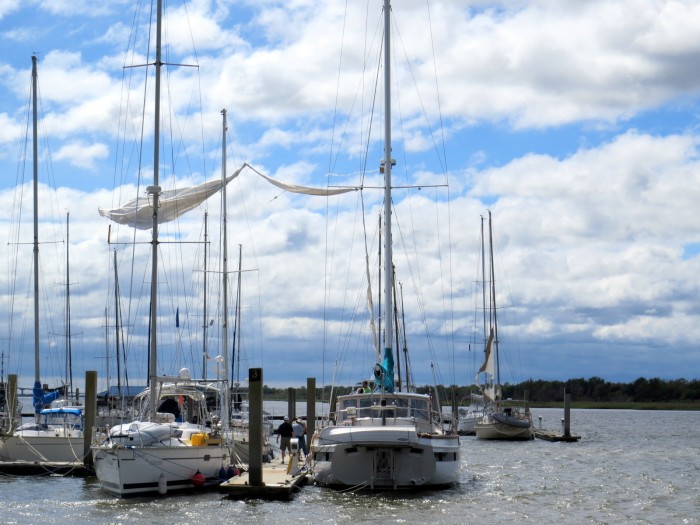
Last night looking out our hotel room window, we could see sheets of driving rain swirling through the carpark and between the cluster of hotels near Hwy I-95. We slept until the wind died sometime around midnight. Soon after, the roar started again from the west with driving horizontal rain and vibrating air vents in the room. To think of Vanish out there being crushed against the dock and all the lives, houses, and pets suffering in this weather was just sickening. The power went out as soon as the wind turned west. In the morning we packed the car and were on the road by 8.30 am but soon found that the police had barricaded every east exit off I-95 so we were told to return to our hotel. We called our friend who weathered the hurricane in the marina clubhouse to find out any news. He kindly walked to our berth and reported "Wow, it's a beautiful boat. It looks exactly the same as you left it!" He went on to say that hurricane force winds lasted over two hours in the marina. That's 78 mph with gusts much higher. The mitigating factors that saved us were that the hurricane was 60 miles offshore, we were in the safe quadrant, the vast surrounding wetland with absorbed all the water and the fact it arrived at low tide. If any of those factors had been different, the docks would have lifted off the posts and all boats would be piled together on the first high ground they hit. The fact that we still have Vanish is nothing short of a miracle.
The authorities allowed us back into Brunswick around noon. As we drove closer to the marina, the damage to houses and buildings increased. We saw uprooted trees and branches everywhere. Many homes and cars had trees laying across them. Spanish moss coated wire fences, billboards, street signs and traffic lights were strewn in the street. In the marina there were a number of trees blown over and a shed across the way from the clubhouse was pretty much blown apart with sheet metal flapping in the wind.
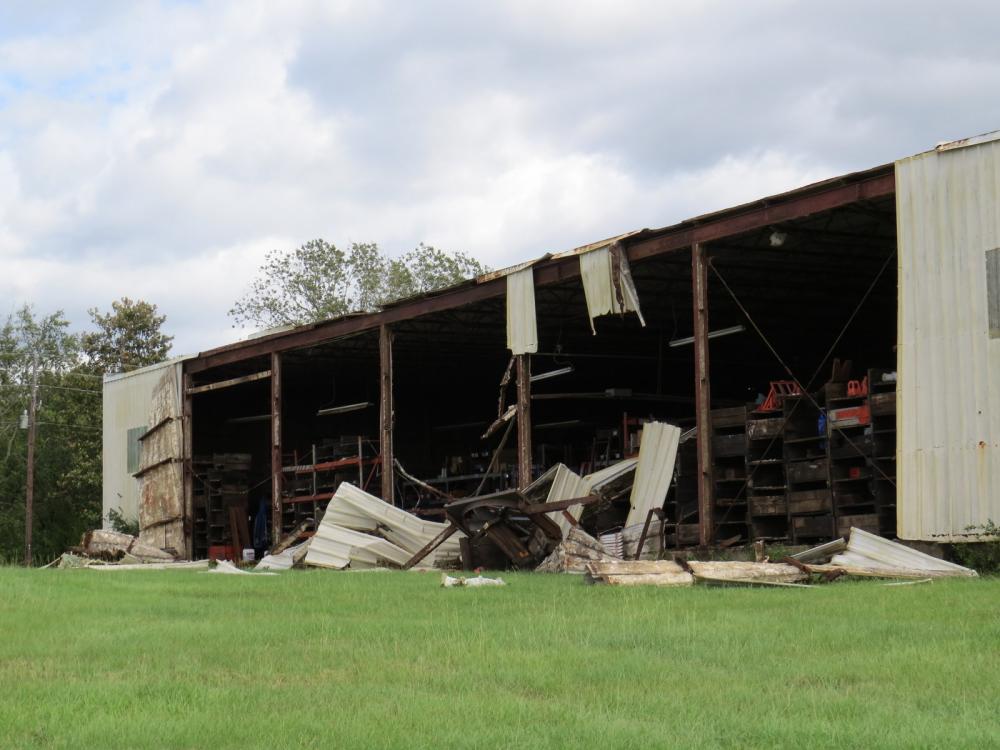
A few yachts had damage to their covers and jibs but no yachts were lost. We walked with trepidation down to Vanish on the T-head. We did a complete inspection and could not find a single bit of damage. A photo frame had fallen over but that was it. Yet, the yacht next to us on the downwind side had books strewn across the salon from the wave action on the westerly change. We can certainly vouch for our eight fenders. They took an extraordinary amount of pressure being squeezed between Vanish and the dock in the two hours of 70 + knots. They are light and easy to inflate or deflate and saved a lot of damage. (http://www.prostockmarine.com/index.php?id_product=28&controller=product)
When the westerly wind arrived, it blew all the surge water out to sea. The posts were around 14 ft high and the next worry was whether there was going to be enough water in the marina under the keels. The below photo shows that the marshlands and water levels are now back to normal.
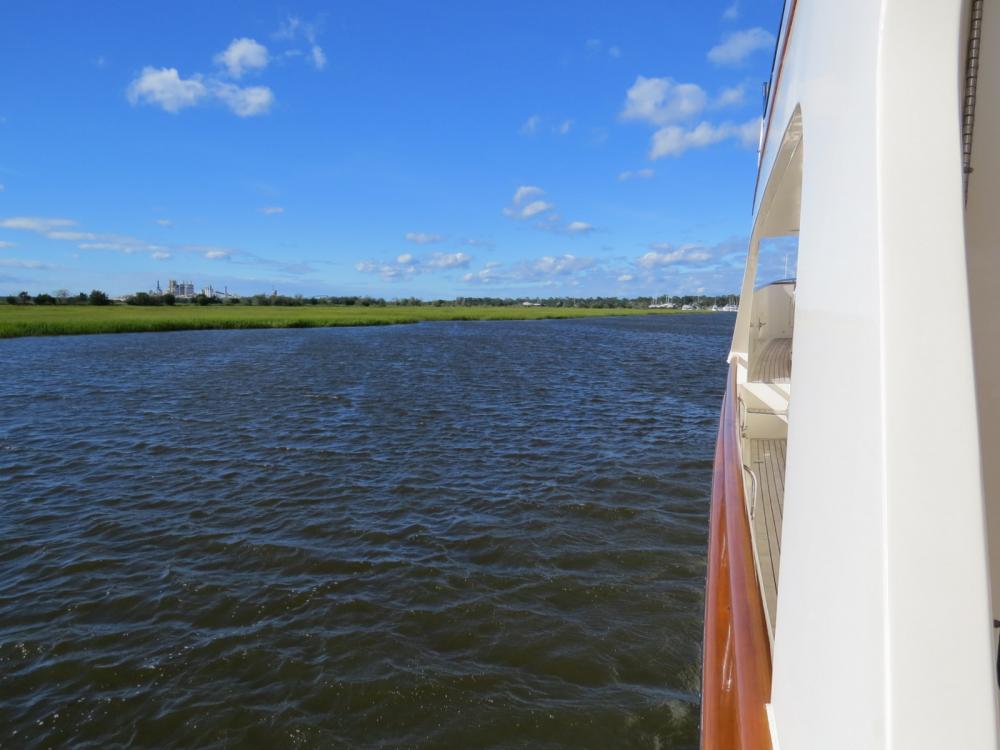
No doubt there will be an extraordinary amount of loss to others less fortunate as this storm followed the coastline from Florida to Virginia. It is still powering north of Cape Hatteras. We are through it all and on the other side safe and sound but feeling completely spent and shell shocked. My thoughts are with everyone who have lost so much.
The authorities allowed us back into Brunswick around noon. As we drove closer to the marina, the damage to houses and buildings increased. We saw uprooted trees and branches everywhere. Many homes and cars had trees laying across them. Spanish moss coated wire fences, billboards, street signs and traffic lights were strewn in the street. In the marina there were a number of trees blown over and a shed across the way from the clubhouse was pretty much blown apart with sheet metal flapping in the wind.
A few yachts had damage to their covers and jibs but no yachts were lost. We walked with trepidation down to Vanish on the T-head. We did a complete inspection and could not find a single bit of damage. A photo frame had fallen over but that was it. Yet, the yacht next to us on the downwind side had books strewn across the salon from the wave action on the westerly change. We can certainly vouch for our eight fenders. They took an extraordinary amount of pressure being squeezed between Vanish and the dock in the two hours of 70 + knots. They are light and easy to inflate or deflate and saved a lot of damage. (http://www.prostockmarine.com/index.php?id_product=28&controller=product)
When the westerly wind arrived, it blew all the surge water out to sea. The posts were around 14 ft high and the next worry was whether there was going to be enough water in the marina under the keels. The below photo shows that the marshlands and water levels are now back to normal.
No doubt there will be an extraordinary amount of loss to others less fortunate as this storm followed the coastline from Florida to Virginia. It is still powering north of Cape Hatteras. We are through it all and on the other side safe and sound but feeling completely spent and shell shocked. My thoughts are with everyone who have lost so much.
We're In It
07 October 2016 | Hotel on West Side of Hwy I-95, Brunswick, GA, USA
Vicki - Air 23 deg C, Wind 50+ knots, Heavy Rain, Barometer 994mb
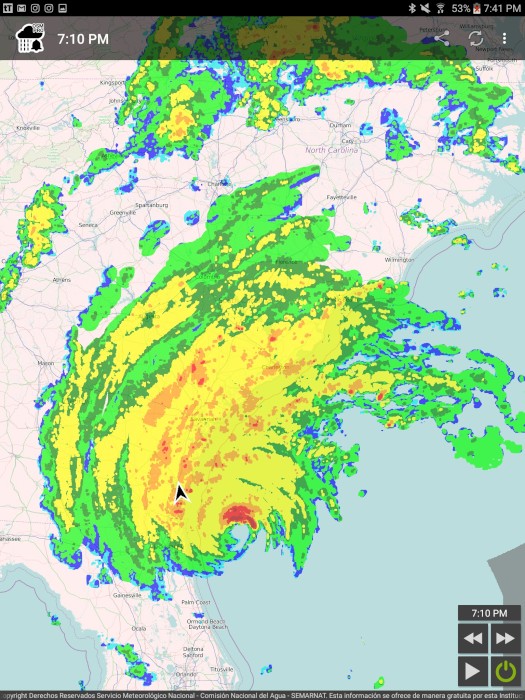
Tonight's the night. This hurricane started as an X called Disturbance 36L on the National Hurricane Centre's website on 23rd September, 2016 off Gambia, Africa. We have been watching it since that date and here we sit tonight in a hotel watching wave after wave of squalls, sheets of pelting, stinging rain, noise and mayhem. Poor Vanish. She's alone out there in the marina without us. This will all be over soon and we will see where we go from there.
We've Done All We Can Do
07 October 2016 | Brunswick, Georgia, USA
Vicki – 24 deg C, Wind 50 kn N, Horizontal Rain, 1000 mb Falling
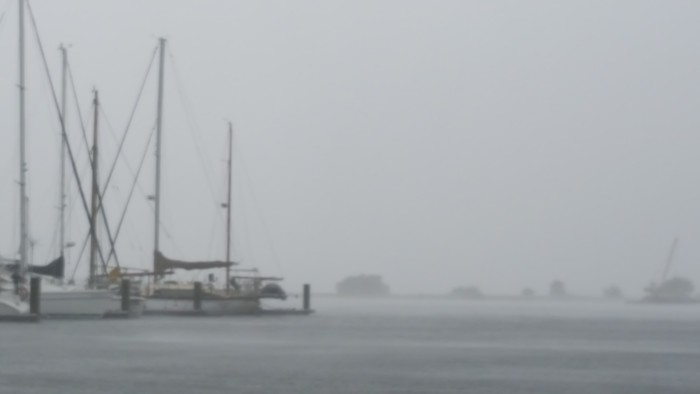
We spent last night in the marina and this morning stayed as long as we dared. This is quite a dangerous situation as Cat 3 Hurricane Matthew is still moving NNW at 12 mph with winds at 115 mph. The storm surge is expected to be 6 - 9 ft. The worst of the storm will be between 4 pm EST and midnight. As I mentioned yesterday, there are a few people staying on board their yachts although I cannot imagine why. We took one last look through the driving rain at Vanish and headed to our hotel this morning which is a 10 minute drive from the marina. Even though we are in Zone A in Brunswick where a mandatory evacuation order is in effect, we are able to drive back to the marina if we want to. The hotel staff have opened their breakfast bar and are providing food and beverages as people wait it out. They have also allowed people to bring their pets and every now and then we hear a quiet bark from either side of our room. Fantastic.
The rain bands from the hurricane come through in fierce waves. Watching the weather from the hotel room was too frustrating for Maynard. He wanted to go back to the marina just to check the water height and to see how our fenders and lines were doing. As we have vowed to stay together, I had to go along for the ride as he could not be swayed. We arrived around 2 pm at high tide. There was only 5 ft of post showing above the dock level which means even though the worst of the storm is hours away, we are already experiencing storm surge of 3 ft. The wind was blowing water off the top of the surface so it was blowing around 50 knots in the squalls. The worst problem was that the concrete post nearest Vanish was swaying an inch or two in the water. We didn't wait to check the other posts as it did not feel safe on the dock with so much movement. We went into the clubhouse where 4 or 5 people were watching the Weather Channel. In the hour we spent in the clubhouse with high tide supposedly passed, the tide rose another foot inundating the carpark. With so much rain and the hurricane still approaching, we are fearful that the docks could float over the top of the posts and be blown to who knows where.
The narrow inlet is no longer a narrow inlet. The reeds are completely covered and there is an expanse of water west of the marina which extends hundreds of meters.
Before:
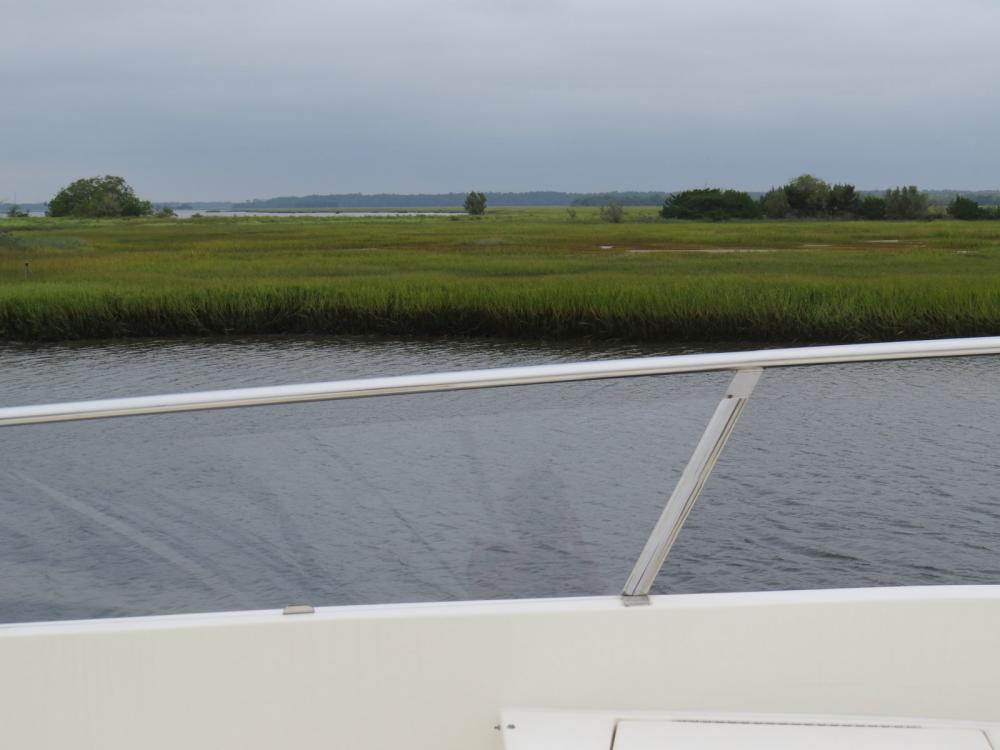
After:
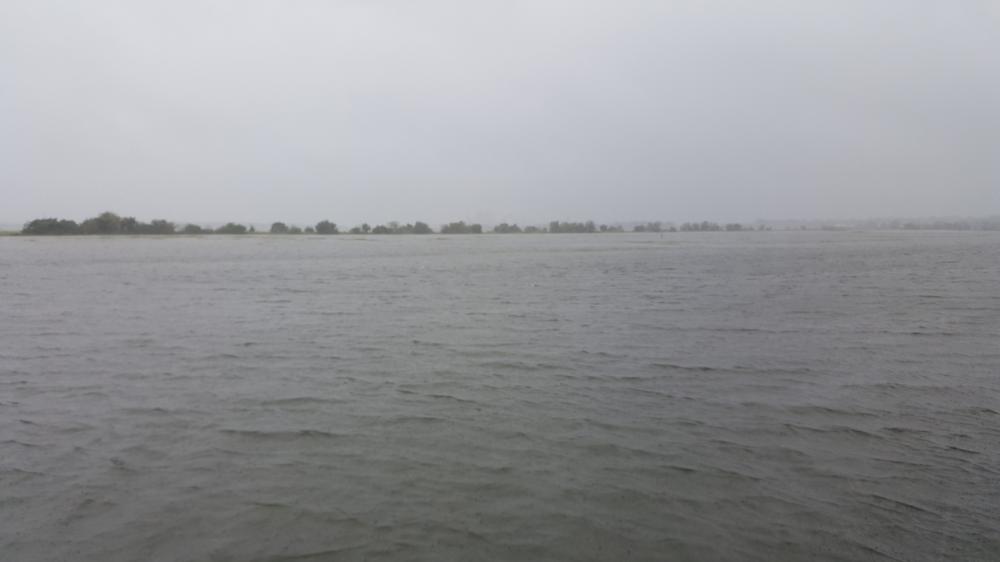
The squalls were becoming a white out situation so we got back into the car and drove back to the hotel. Debris and branches were now on the road and a small creek we'd crossed earlier was flooded and completely altered. We cannot go back out now. Maynard just called one of the guys at the marina who said the posts are still intact but it's still raining extremely hard and the worst wind is on its way. I'm not sure what will happen. I'm not sure if I will be able to write again if we lose power and internet. We are safe and that's all that matters.
(I would like to say a special thank you for the heart felt comments on my last post. I must be getting old as they brought more tears to my eyes. It is often a lonely position to be in and to know you are with us in spirit makes the world of difference.)
The rain bands from the hurricane come through in fierce waves. Watching the weather from the hotel room was too frustrating for Maynard. He wanted to go back to the marina just to check the water height and to see how our fenders and lines were doing. As we have vowed to stay together, I had to go along for the ride as he could not be swayed. We arrived around 2 pm at high tide. There was only 5 ft of post showing above the dock level which means even though the worst of the storm is hours away, we are already experiencing storm surge of 3 ft. The wind was blowing water off the top of the surface so it was blowing around 50 knots in the squalls. The worst problem was that the concrete post nearest Vanish was swaying an inch or two in the water. We didn't wait to check the other posts as it did not feel safe on the dock with so much movement. We went into the clubhouse where 4 or 5 people were watching the Weather Channel. In the hour we spent in the clubhouse with high tide supposedly passed, the tide rose another foot inundating the carpark. With so much rain and the hurricane still approaching, we are fearful that the docks could float over the top of the posts and be blown to who knows where.
The narrow inlet is no longer a narrow inlet. The reeds are completely covered and there is an expanse of water west of the marina which extends hundreds of meters.
Before:
After:

The squalls were becoming a white out situation so we got back into the car and drove back to the hotel. Debris and branches were now on the road and a small creek we'd crossed earlier was flooded and completely altered. We cannot go back out now. Maynard just called one of the guys at the marina who said the posts are still intact but it's still raining extremely hard and the worst wind is on its way. I'm not sure what will happen. I'm not sure if I will be able to write again if we lose power and internet. We are safe and that's all that matters.
(I would like to say a special thank you for the heart felt comments on my last post. I must be getting old as they brought more tears to my eyes. It is often a lonely position to be in and to know you are with us in spirit makes the world of difference.)
First Time in History
06 October 2016 | Brunswick, Georgia, USA
Vicki – Wind 20 kn N, Barometer 1017 mb falling, Cloud 8/8 Air 25 deg c, Atmosphere Eerie
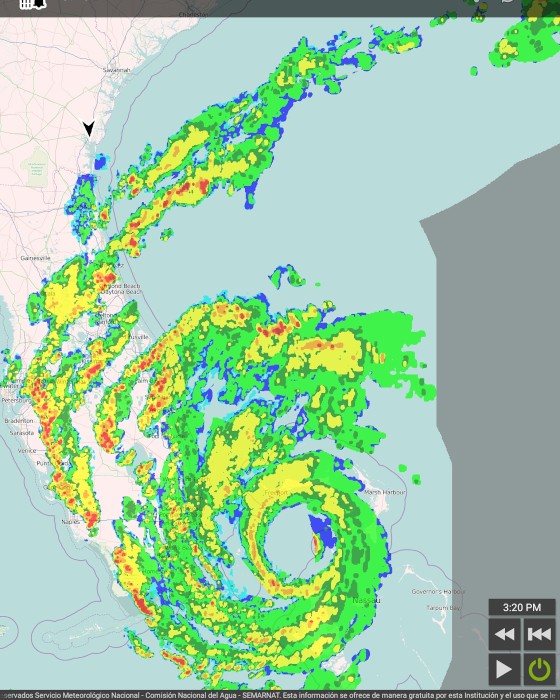
This is very difficult to write. Hurricane Matthew, as you can see above is heading for the Florida coast before moving to our position in Brunswick. You can see where we are located by the arrow on the radar photo above. It is moving at 14 mph to the north-west with winds of 140 mph, gusts to 165 mph and is a Category 4 hurricane. The storm surge maps indicate that we will experience surge of 7 to 11 feet. At high tide at 1230 today, there was around 8 feet left on the pylon on our dock. If the surge is higher than that, the dock will float over the top taking all vessels with it along with every other dock in the marina. The consequences will be disastrous.
We spent today securing the stainless steel storm shutters to the lower deck windows, adjusting lines, gathering important papers and packing our cases. In reality, this could be the last day we spend on Vanish. As we are in Glynn County, Georgia, a mandatory evacuation is in place. There are a number of yachties who intend riding out the storm in the marina, perhaps on their boats but more likely in the marina conference room or in their cars in the elevated carpark. Our hotel is located 10 miles from the ocean on the other side of I-95. All hotels on the east side of I-95 have been evacuated. We walked to downtown Brunswick for lunch and saw that many stores were sandbagged and windows were taped over. Only one establishment was open which turned out to be a vegetarian/Caribbean café which we enjoyed along with many others who dropped in. The café owner was closing this afternoon and would not be open again until next week. As we walked back from town, we saw many vehicles parked in the marina from the Weather Channel. Whenever they are in town, it’s a bad sign. The Marina Manager was extremely teary when we visited her office this afternoon. She is scared. Everyone is scared. No one knows what will happen. Nothing like this has ever been recorded on this coast before. This hurricane has not acted like any other one in history and because of that, we were lulled into believing the early models which showed it curving north to Cape Hatteras and into the Chesapeake Bay. The models were very very wrong.
(Feel free to leave comments. Please. If we lose power, I will not be able to do any updates so please bear with us. Thank you. The below photo was taken just before I burst into tears. A lucky shot huh!)
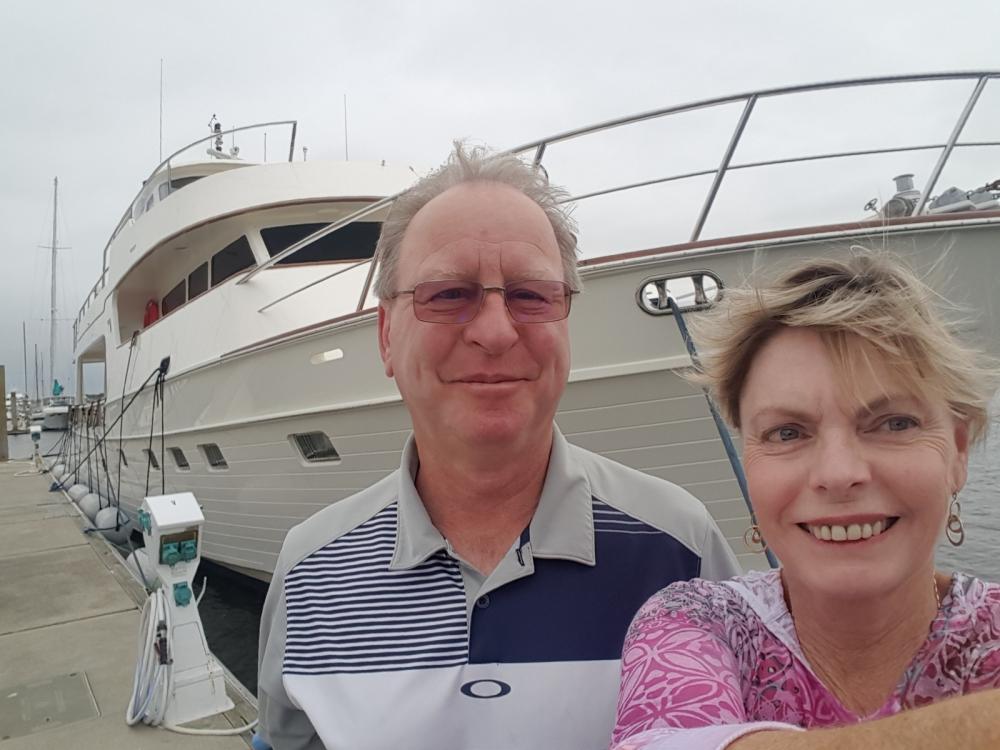
We spent today securing the stainless steel storm shutters to the lower deck windows, adjusting lines, gathering important papers and packing our cases. In reality, this could be the last day we spend on Vanish. As we are in Glynn County, Georgia, a mandatory evacuation is in place. There are a number of yachties who intend riding out the storm in the marina, perhaps on their boats but more likely in the marina conference room or in their cars in the elevated carpark. Our hotel is located 10 miles from the ocean on the other side of I-95. All hotels on the east side of I-95 have been evacuated. We walked to downtown Brunswick for lunch and saw that many stores were sandbagged and windows were taped over. Only one establishment was open which turned out to be a vegetarian/Caribbean café which we enjoyed along with many others who dropped in. The café owner was closing this afternoon and would not be open again until next week. As we walked back from town, we saw many vehicles parked in the marina from the Weather Channel. Whenever they are in town, it’s a bad sign. The Marina Manager was extremely teary when we visited her office this afternoon. She is scared. Everyone is scared. No one knows what will happen. Nothing like this has ever been recorded on this coast before. This hurricane has not acted like any other one in history and because of that, we were lulled into believing the early models which showed it curving north to Cape Hatteras and into the Chesapeake Bay. The models were very very wrong.
(Feel free to leave comments. Please. If we lose power, I will not be able to do any updates so please bear with us. Thank you. The below photo was taken just before I burst into tears. A lucky shot huh!)

Too Close for Comfort
05 October 2016 | Brunswick, Georgia, USA
Vicki – Barometer 1018 hP, Air 22 deg C, Sky 8/8, Wind N 20+ kn, Atmosphere Tense
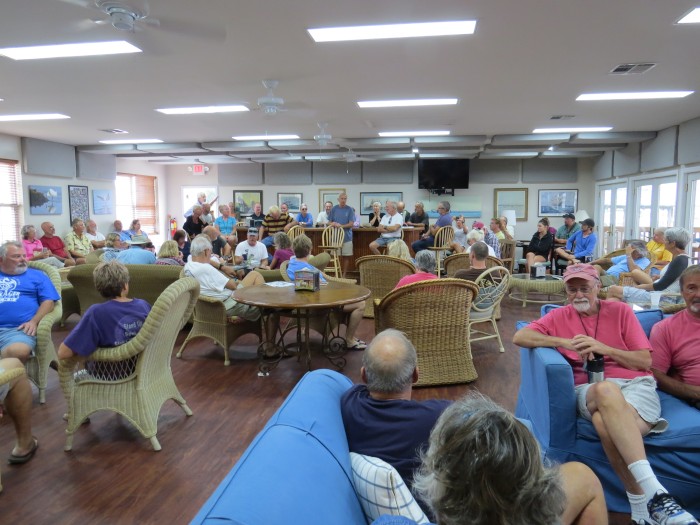
The turnout at this morning’s Hurricane Matthew meeting at the marina saw almost 100 people in attendance. We were given advice on shelters and hotels to go to for those not staying on their vessels and government websites with an evacuation plan, advice on tying up and what to put in a ditch bag. Storm surge is a real threat and NOAA has issued storm surge maps which show our area experiencing at least 3 to 6 feet of storm surge. We are also expected to receive around 6 to 10” of rain so flooding will be quite bad. A second hurricane named Hurricane Nicole is also in the Atlantic keeping Matthew company but will not affect us. However, Hurricane Matthew has sustained winds of 120 mph and is moving NW at 12 mph along the Florida coast towards our position in Georgia and will be here by Friday. Some people are staying on their boats, others are leaving. There is an evacuation order in place for South Carolina in the Charleston and Beaufort counties. At this point, the hurricane is expected to pass only 40 miles or so off the coast from us.
.jpg)
Friday’s weather report for our area reads:
“Hurricane conditions possible. NE winds 30-35 kn with gusts to around 60 kn becoming NNE 35 to 45 kn with gusts to around 70 kn in the afternoon. Seas building to 19 to 23 ft, occasionally 27 ft.
Friday Night: Hurricane conditions possible. NW winds 40 – 50 kn with gusts to around 70 kn. Seas 23 ft with occasional seas up to 29 ft subsiding to 21 ft but occasionally 27 ft after midnight. Inland waters extremely rough. Showers and a slight chance of thunderstorms."
Below is the forecast on Weather 4D:
.jpg)
Today, we double tied our lines, put 7 huge fenders along the dock, removed furniture and covers and tied down all items on the bridge deck. We booked a hotel room nearby, ensured we have car insurance for the duration of the storm, purchased water and will pack a grab bag so we can make our escape if it becomes dangerous. If conditions permit, we will stay here but if not, we will leave Vanish and pray it will be ok. Everyone in the marina is nervous. People have worked hard removing dodger covers, tying their lines and the lines of neighboring boats, adding fenders, removing jibs and mainsails and countless other jobs.
I think we have done as best as we can but in the long run, our lives are what’s important. You don’t mess with hurricanes. Period.
(Please see Gallery for more photos. All comments welcome.)
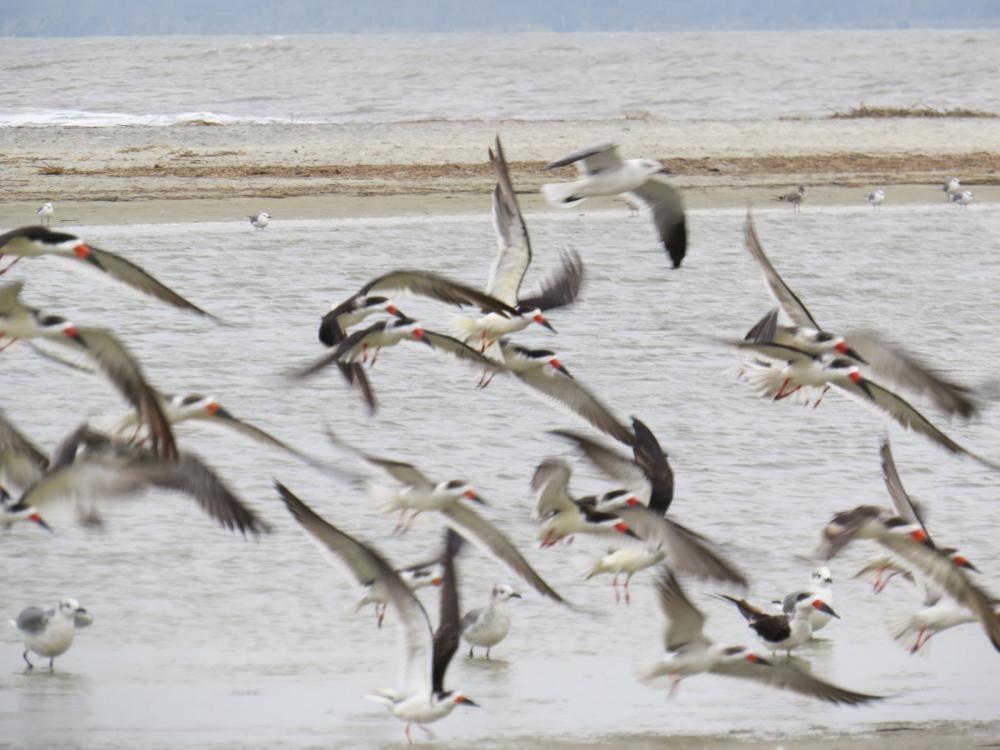
.jpg)
Friday’s weather report for our area reads:
“Hurricane conditions possible. NE winds 30-35 kn with gusts to around 60 kn becoming NNE 35 to 45 kn with gusts to around 70 kn in the afternoon. Seas building to 19 to 23 ft, occasionally 27 ft.
Friday Night: Hurricane conditions possible. NW winds 40 – 50 kn with gusts to around 70 kn. Seas 23 ft with occasional seas up to 29 ft subsiding to 21 ft but occasionally 27 ft after midnight. Inland waters extremely rough. Showers and a slight chance of thunderstorms."
Below is the forecast on Weather 4D:
.jpg)
Today, we double tied our lines, put 7 huge fenders along the dock, removed furniture and covers and tied down all items on the bridge deck. We booked a hotel room nearby, ensured we have car insurance for the duration of the storm, purchased water and will pack a grab bag so we can make our escape if it becomes dangerous. If conditions permit, we will stay here but if not, we will leave Vanish and pray it will be ok. Everyone in the marina is nervous. People have worked hard removing dodger covers, tying their lines and the lines of neighboring boats, adding fenders, removing jibs and mainsails and countless other jobs.
I think we have done as best as we can but in the long run, our lives are what’s important. You don’t mess with hurricanes. Period.
(Please see Gallery for more photos. All comments welcome.)
Oh Come On!
04 October 2016 | Photo off Outer Banks near Cape Lookout, North Carolina.
Vicki – Currently Brunswick, GA, Air 25 deg C, Many Heavy Rain Showers, Humid, 8/8 Cloud
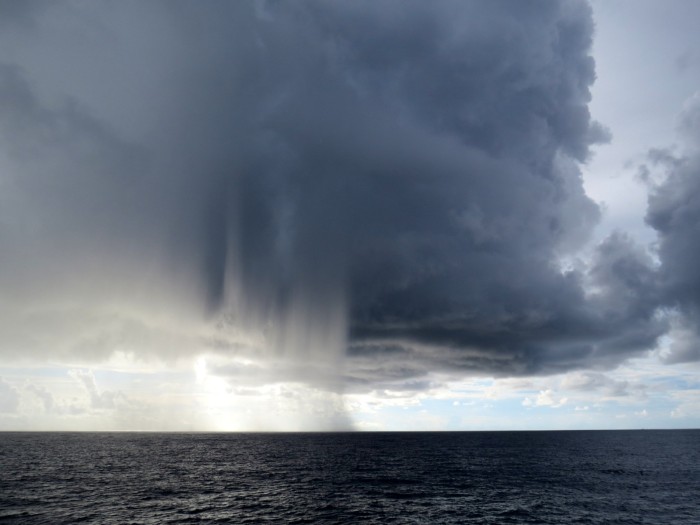
We woke early after little sleep last Wednesday 28th September and checked the hurricane forecast once again. We saw that Brunswick, Georgia, which is located the furthest west along the east coast of the USA was not expected to be in the projected cone for Hurricane Matthew as it would be passing out to sea. However, it appeared it would most likely pass over Cape Hatteras and move on into the Chesapeake Bay then turn towards New Jersey and the New York area. On that information, we departed on sunrise which was at 0700 under overcast skies. It wasn't going to be smooth sailing though as we had to face headwinds and lumpy seas until we were past Cape Hatteras. As we headed out, we saw on Marine Traffic that only one other cruiser, a Nordhavn, was moving south at sea 40 miles ahead of us. Others were powering down the ICW in order to escape Chesapeake Bay. It was a very lonely trip.
During part of the day we were accompanied by a US aircraft carrier USNS "Carson City" performing exercises with helicopter landings and takeoffs. They repeatedly announced that all vessels were to maintain a 3 NM limit which we did. For some reason, I am always the one on watch rounding Cape Hatteras and it always occurs around midnight on dark nights. This time, lightning streaked across the sky from storm cells which kept popping up in the extremely humid unstable air. I saw the Cape Hatteras Light and red tower to starboard and a cargo ship named "Spirit of Melbourne" which reminded me of home heading south on our port side. Our watches were roughly 4 hours on, 4 hours off and engine checks every hour.
We ran Vanish with both engines and air conditioning the entire time to keep ourselves comfortable and moving along at 8 to 9 knots. We had a constant counter current of 1 kn which slowed us down a little. The seas from Norfolk, Virginia to Cape Hatteras were not my favourite as the swells were 1.5 meters from the east and wind from the south-east. Once we turned the corner and changed course 50 degrees to the SW, the boat motion definitely improved. As the sun rose, the sea had become quite glassy with picture perfect 'popcorn 'storm clouds. We ducked into Cape Lookout and anchored next to a British yacht we had last seen on the Choptank River in the Chesapeake. The night was calm and quiet with no rain or thunderstorms but in my opinion, Cape Lookout is a vortex for the very worst weather it can gather. As we raised the anchor in the near dark on Friday, 30th September, a slight breeze arrived with a few spits of rain. The radar showed relentless severe storms and heavy rain all day at Cape Lookout after we left. For us, the day turned into episodes of drenching rain with headwinds to 28 kn followed by lulls of 8 kn and waves going everywhere. About 10 miles south of Cape Lookout, another US warship appeared. I was off watch at the time. The radio operator came on hailing Vanish and asked what our intentions were. Well, Maynard could have said he hoped he would live to be 100, be fat and happy with a dozen dancing nymphets. Or he could have said he intended having a rum and coke when he arrived back in Georgia, but was having a few tic tacs instead. He could have given so many excellent answers but he said something I certainly didn't think of. He said, "I intend holding my course," to which the warship answered, "Good. We'll pass behind you." This is why he is the Captain and I am the First Mate/Jokster I guess.
The stabilisers were working hard from Cape Lookout, NC past Cape Fear, NC. Some waves would double up causing a dip in the ocean which the bow would drop into, sometimes up to 5 ft but Vanish just kept rolling along easily at 10 kn. Spray would hit the bow and swirl off up over the bridge, but once past Cape Fear with another 20 deg turn towards the south-west in deeper water with less current, the seas started to finally behave. We saw a number of vessels head into shore through a secret shallow entrance north of Cape Fear, then pass Cape Fear on the ICW then head back out to sea. We didn't know this back door route and went past all capes at sea.
Again off Charleston, I was on watch at 2.30 a.m. I don't like passing Charleston at night as there is so much shipping to contend with. Maynard came up to do his watch and we both noticed that the lead red light into the Charleston channel was out. This was the second time we'd seen a major navigation light not working in the last week. I had also passed an unlit fishing buoy well out to sea and am so thankful for radar and excellent charts. There is no time to be complacent at sea as it is a full-time job tracking vessels, watching weather, checking boat systems and ensuring all is clear ahead both on the FLIR camera and the charts. We never play tv, radio or music at night as it is too distracting.
We arrived at Brunswick on Saturday 1st October around 6pm and tied up with not a soul to be seen in the marina at the time which was ok as we easily dock Vanish by ourselves. We'd travelled 600 miles since leaving the Chesapeake in 3 days with one overnight stop. In all, we have travelled 3,000 miles this cruising season so far. Considering it is just the two of us onboard, we feel happy with this achievement and know we have a much better handle on each other's jobs and capabilities.
Unfortunately, the computer models have shifted Hurricane Matthew closer to the east coast of the USA and Brunswick, GA is well in the cone of this storm. The storm has taken longer to arrive than expected, and in that time, the wind sheer has lessened allowing it to bobble more towards the west. The below GFS Ensemble shows the latest tracks of Hurricane Matthew.
.jpg)
We knew the models could change but we are very disappointed that we might be caught up in this storm. There are tens of thousands of boats along the coast of Florida, Georgia, North and South Carolina that will all be affected. The Brunswick Landing Marina is nearly full here today. Last night at Happy Hour at the marina, 40 of us all talked about the prospects for our vessels and where we would go if we could go anywhere. Everyone thought we were in the best location so here we stay. The storm is expected to arrive on Friday. We have rented a car but if we have storm surge of as little as 3 ft on a high tide, the car will be inundated in the carpark as the area is dead flat. The car is our ultimate escape but it's no use if it's under water. I am not looking forward to the decisions ahead.
(I will be posting each day until this situation is behind us so please keep checking for further updates. See Photo Gallery for more pictures. Please feel free to comment as we always love your feedback. Don't be shy.)
During part of the day we were accompanied by a US aircraft carrier USNS "Carson City" performing exercises with helicopter landings and takeoffs. They repeatedly announced that all vessels were to maintain a 3 NM limit which we did. For some reason, I am always the one on watch rounding Cape Hatteras and it always occurs around midnight on dark nights. This time, lightning streaked across the sky from storm cells which kept popping up in the extremely humid unstable air. I saw the Cape Hatteras Light and red tower to starboard and a cargo ship named "Spirit of Melbourne" which reminded me of home heading south on our port side. Our watches were roughly 4 hours on, 4 hours off and engine checks every hour.
We ran Vanish with both engines and air conditioning the entire time to keep ourselves comfortable and moving along at 8 to 9 knots. We had a constant counter current of 1 kn which slowed us down a little. The seas from Norfolk, Virginia to Cape Hatteras were not my favourite as the swells were 1.5 meters from the east and wind from the south-east. Once we turned the corner and changed course 50 degrees to the SW, the boat motion definitely improved. As the sun rose, the sea had become quite glassy with picture perfect 'popcorn 'storm clouds. We ducked into Cape Lookout and anchored next to a British yacht we had last seen on the Choptank River in the Chesapeake. The night was calm and quiet with no rain or thunderstorms but in my opinion, Cape Lookout is a vortex for the very worst weather it can gather. As we raised the anchor in the near dark on Friday, 30th September, a slight breeze arrived with a few spits of rain. The radar showed relentless severe storms and heavy rain all day at Cape Lookout after we left. For us, the day turned into episodes of drenching rain with headwinds to 28 kn followed by lulls of 8 kn and waves going everywhere. About 10 miles south of Cape Lookout, another US warship appeared. I was off watch at the time. The radio operator came on hailing Vanish and asked what our intentions were. Well, Maynard could have said he hoped he would live to be 100, be fat and happy with a dozen dancing nymphets. Or he could have said he intended having a rum and coke when he arrived back in Georgia, but was having a few tic tacs instead. He could have given so many excellent answers but he said something I certainly didn't think of. He said, "I intend holding my course," to which the warship answered, "Good. We'll pass behind you." This is why he is the Captain and I am the First Mate/Jokster I guess.
The stabilisers were working hard from Cape Lookout, NC past Cape Fear, NC. Some waves would double up causing a dip in the ocean which the bow would drop into, sometimes up to 5 ft but Vanish just kept rolling along easily at 10 kn. Spray would hit the bow and swirl off up over the bridge, but once past Cape Fear with another 20 deg turn towards the south-west in deeper water with less current, the seas started to finally behave. We saw a number of vessels head into shore through a secret shallow entrance north of Cape Fear, then pass Cape Fear on the ICW then head back out to sea. We didn't know this back door route and went past all capes at sea.
Again off Charleston, I was on watch at 2.30 a.m. I don't like passing Charleston at night as there is so much shipping to contend with. Maynard came up to do his watch and we both noticed that the lead red light into the Charleston channel was out. This was the second time we'd seen a major navigation light not working in the last week. I had also passed an unlit fishing buoy well out to sea and am so thankful for radar and excellent charts. There is no time to be complacent at sea as it is a full-time job tracking vessels, watching weather, checking boat systems and ensuring all is clear ahead both on the FLIR camera and the charts. We never play tv, radio or music at night as it is too distracting.
We arrived at Brunswick on Saturday 1st October around 6pm and tied up with not a soul to be seen in the marina at the time which was ok as we easily dock Vanish by ourselves. We'd travelled 600 miles since leaving the Chesapeake in 3 days with one overnight stop. In all, we have travelled 3,000 miles this cruising season so far. Considering it is just the two of us onboard, we feel happy with this achievement and know we have a much better handle on each other's jobs and capabilities.
Unfortunately, the computer models have shifted Hurricane Matthew closer to the east coast of the USA and Brunswick, GA is well in the cone of this storm. The storm has taken longer to arrive than expected, and in that time, the wind sheer has lessened allowing it to bobble more towards the west. The below GFS Ensemble shows the latest tracks of Hurricane Matthew.
.jpg)
We knew the models could change but we are very disappointed that we might be caught up in this storm. There are tens of thousands of boats along the coast of Florida, Georgia, North and South Carolina that will all be affected. The Brunswick Landing Marina is nearly full here today. Last night at Happy Hour at the marina, 40 of us all talked about the prospects for our vessels and where we would go if we could go anywhere. Everyone thought we were in the best location so here we stay. The storm is expected to arrive on Friday. We have rented a car but if we have storm surge of as little as 3 ft on a high tide, the car will be inundated in the carpark as the area is dead flat. The car is our ultimate escape but it's no use if it's under water. I am not looking forward to the decisions ahead.
(I will be posting each day until this situation is behind us so please keep checking for further updates. See Photo Gallery for more pictures. Please feel free to comment as we always love your feedback. Don't be shy.)
Back or Forth
27 September 2016 | Piankatank River, Chesapeake Bay, Virginia, USA
Vicki – Air 21 deg , Water 24 deg C, 8/8 Cloud, Rain Showers, 1 kn S
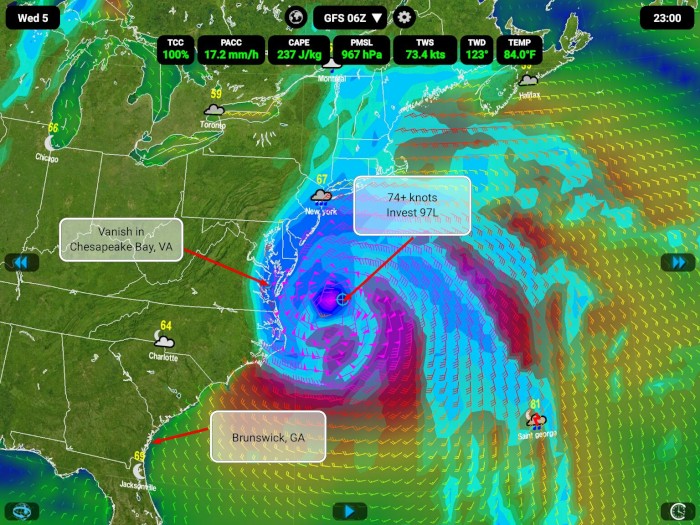
One could spend a lifetime exploring the Chesapeake Bay. It is 200 miles long with a width ranging from 4 to 30 miles across. The bay and its tributaries have a length of 11,684 miles, only 5,000 miles less than Australia’s entire coastline. The average depth of the bay is just 21 feet making it easy in which to anchor. There are always hidey holes to escape every direction of wind and in a number of places, the anchorages are almost enclosed so that no real weather can intrude. In the last few days, we’ve anchored just off the Choptank River in the Tred Avon River and also the Piankatank River which provides wonderful protection for all wind directions. We passed a lighthouse called Sharps Island Light leaning at a crazy angle off Tilghman Island and is known as the Leaning Tower of Pisa. This current lighthouse was constructed in 1892 and was knocked sideways due to an ice floe in 1977. Up until I saw this lighthouse, I didn’t realise Chesapeake Bay often freezes in winter.

A tropical disturbance appeared a few days ago spinning off Gambia in Africa called Invest 97L. Today it is expected to be upgraded to a Tropical Depression called Matthew with further development as a hurricane. The models show it travelling in a westerly direction before making a sharp right to pass over the Dominican Republic where it will continue northward through the Bahamas thence onto the USA. These models change daily but we watch them carefully as we need to decide what action to take heading south to Georgia. Yesterday I found an interesting website http://www.vaemergency.gov/readyvirginia/stay-informed/hurricanes/hurricane-history which documents the effects of hurricanes recorded in the Chesapeake Bay since 1635. It was interesting to read the months these hurricanes arrived in the area, the amount of surge recorded (between 8 and 15 feet), the fact that tornadoes associated with the hurricanes also greatly impacted the lives of many and just the sheer damage caused by the force of waves and wind. Just looking onshore at some of the houses near our current anchorage, some are indeed set at 15 feet above sea level, a very wise decision. This information told us that in the event of Invest 97L making an impact on the Chesapeake Bay, we would need to return as far north up the Chesapeake Bay, possibly to Baltimore or Philadelphia to avoid flooding and wind effects.
The Weather 4D model above for October 5 shows Invest 97L passing close to our current position. The weather models only need to move the hurricane slightly westward for us to take action. We either need to wait and watch, ready to move or sneak down the coast ahead of it before adverse weather affects wind and wave heights out at sea. Brunswick, GA is 500 miles away and can be reached in 2 to 3 days if the weather co-operates. Again, if the models change and Brunswick is in or close to its path, we would not like to think what would happen to Vanish. If we wait here until the hurricane passes, it will be several weeks before we can travel south. Time is ticking. What would YOU do?

A tropical disturbance appeared a few days ago spinning off Gambia in Africa called Invest 97L. Today it is expected to be upgraded to a Tropical Depression called Matthew with further development as a hurricane. The models show it travelling in a westerly direction before making a sharp right to pass over the Dominican Republic where it will continue northward through the Bahamas thence onto the USA. These models change daily but we watch them carefully as we need to decide what action to take heading south to Georgia. Yesterday I found an interesting website http://www.vaemergency.gov/readyvirginia/stay-informed/hurricanes/hurricane-history which documents the effects of hurricanes recorded in the Chesapeake Bay since 1635. It was interesting to read the months these hurricanes arrived in the area, the amount of surge recorded (between 8 and 15 feet), the fact that tornadoes associated with the hurricanes also greatly impacted the lives of many and just the sheer damage caused by the force of waves and wind. Just looking onshore at some of the houses near our current anchorage, some are indeed set at 15 feet above sea level, a very wise decision. This information told us that in the event of Invest 97L making an impact on the Chesapeake Bay, we would need to return as far north up the Chesapeake Bay, possibly to Baltimore or Philadelphia to avoid flooding and wind effects.
The Weather 4D model above for October 5 shows Invest 97L passing close to our current position. The weather models only need to move the hurricane slightly westward for us to take action. We either need to wait and watch, ready to move or sneak down the coast ahead of it before adverse weather affects wind and wave heights out at sea. Brunswick, GA is 500 miles away and can be reached in 2 to 3 days if the weather co-operates. Again, if the models change and Brunswick is in or close to its path, we would not like to think what would happen to Vanish. If we wait here until the hurricane passes, it will be several weeks before we can travel south. Time is ticking. What would YOU do?
Obama Drama
22 September 2016 | Current Position - Sassafras River, Chesapeake Bay, Maryland, USA
Vicki – Air 29 deg C, Water 25.6 deg C, Cloud 1/8, Wind 1 kn NW
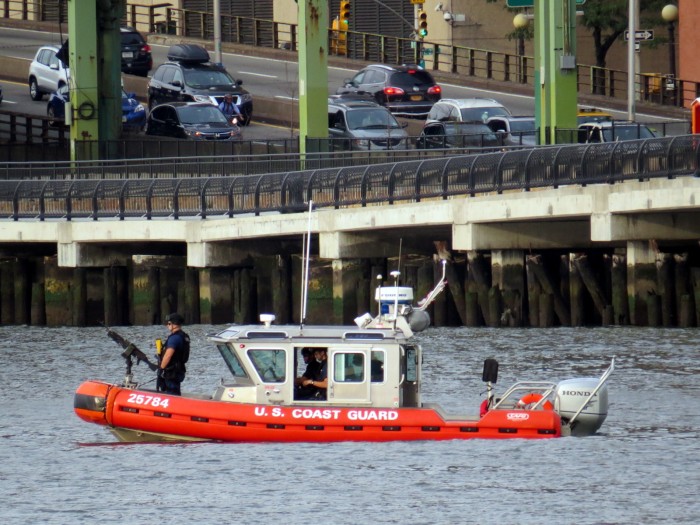
We made our way down Long Island Sound spending a day anchored at Oyster Bay in heavy rain giving Vanish a lovely wash down.
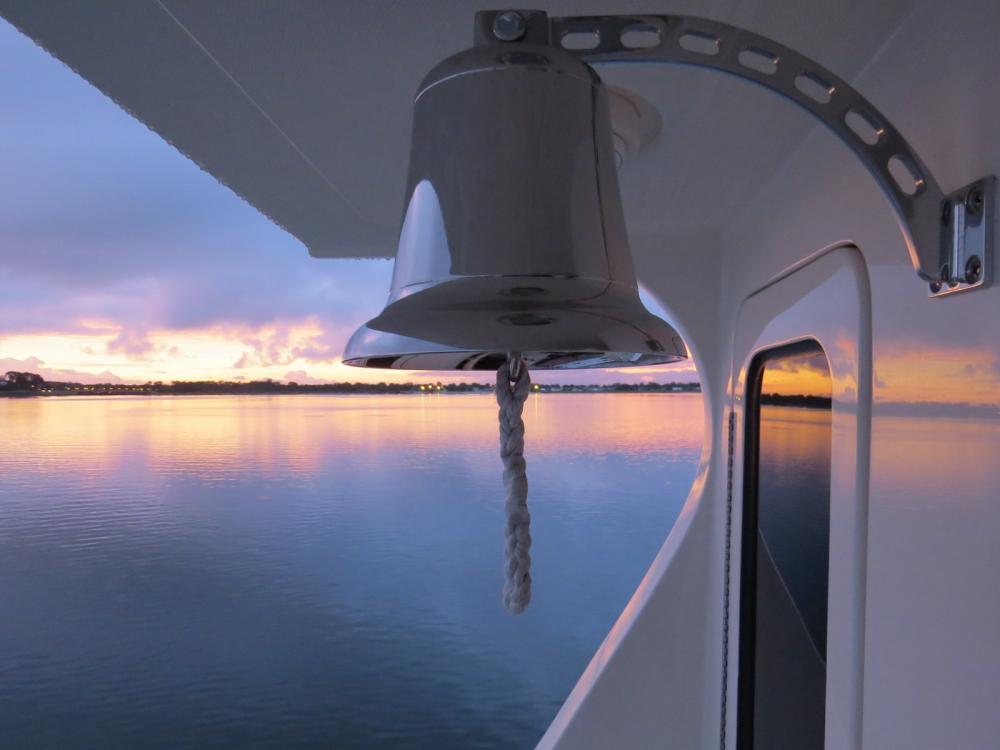
Oyster Bay is also the site of President Theodore Roosevelt's summer home "Sagamore Hill" which he purchased in 1885 and lived in until his death in 1919. The number of beautiful homes lining the many harbours of Long Island is astounding. We'd found a great weather window to continue our passage down the coast off New Jersey catching the slack tide through Hell's gate on the East River in New York City at 1pm on Tuesday. As we passed under the Throggs Bridge, another cruiser (who had just turned around) announced on the radio "All you boats heading towards Hell's Gate, the East River is closed due to the United Nations General Assembly. What!!! This is the only way for us to head out to sea on our planned voyage south. President Obama was speaking that day at the UN and all access past the UN Building which is right on the East River was closed until 5.45 p.m. We turned around and returned to Manhasset Bay to wait until the following day. As the East River was again closing on Wednesday at 8.55 a.m., we made sure we were up bright and early so that we could pass the U.N. Building in plenty of time before it closed again. As we approached the U.N., there were countless NYPD boats, coast guard tenders and larger coast guard ships all with machine guns mounted on the bow. There had been a terrorist bombing in New York City early this week so security was extremely high. Maynard said, just to make me laugh I'm sure, "If Vanish's autopilot goes crazy and turns at a right angle towards the U.N., you know they're going to shoot us dead don't you?" Ha ha. Very funny. (I checked and we were not on Auto Pilot!) We dodged all machine gun bullets and continued through New York City and out into the North Atlantic Ocean overnight in NE 10-20 kn, seas 3 ft. We motored up the Delaware Bay today, through the Chesapeake/Delaware Canal and are currently anchored in one of many beautiful anchorages on the Chesapeake Bay.
Oyster Bay is also the site of President Theodore Roosevelt's summer home "Sagamore Hill" which he purchased in 1885 and lived in until his death in 1919. The number of beautiful homes lining the many harbours of Long Island is astounding. We'd found a great weather window to continue our passage down the coast off New Jersey catching the slack tide through Hell's gate on the East River in New York City at 1pm on Tuesday. As we passed under the Throggs Bridge, another cruiser (who had just turned around) announced on the radio "All you boats heading towards Hell's Gate, the East River is closed due to the United Nations General Assembly. What!!! This is the only way for us to head out to sea on our planned voyage south. President Obama was speaking that day at the UN and all access past the UN Building which is right on the East River was closed until 5.45 p.m. We turned around and returned to Manhasset Bay to wait until the following day. As the East River was again closing on Wednesday at 8.55 a.m., we made sure we were up bright and early so that we could pass the U.N. Building in plenty of time before it closed again. As we approached the U.N., there were countless NYPD boats, coast guard tenders and larger coast guard ships all with machine guns mounted on the bow. There had been a terrorist bombing in New York City early this week so security was extremely high. Maynard said, just to make me laugh I'm sure, "If Vanish's autopilot goes crazy and turns at a right angle towards the U.N., you know they're going to shoot us dead don't you?" Ha ha. Very funny. (I checked and we were not on Auto Pilot!) We dodged all machine gun bullets and continued through New York City and out into the North Atlantic Ocean overnight in NE 10-20 kn, seas 3 ft. We motored up the Delaware Bay today, through the Chesapeake/Delaware Canal and are currently anchored in one of many beautiful anchorages on the Chesapeake Bay.
Woof Woof
16 September 2016 | Orient, Long Island, New York, USA
Vicki – Air 18 deg C, Water 22.3 deg C, Cloud 1/8, Wind 8 kn SE
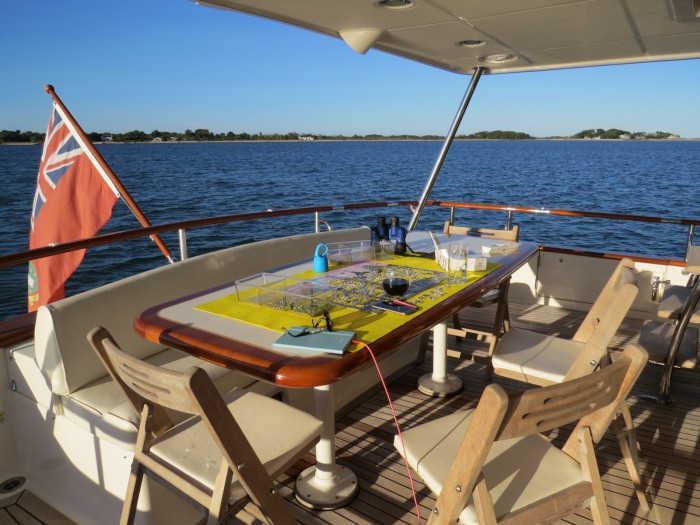
On Monday, we left our anchorage at Ebenecook Harbor near Boothbay Harbor bidding a fond farewell to Maine. Our first night was spent at Hull, Boston and the next day we transited the Cape Cod Canal. Just south of Maine we passed by the Minot Ledge Light which is a 90 ft tall structure made of interlocking granite sitting on a rocky outcrop 1 mile offshore in the North Atlantic. This lighthouse has quite an amazing history which you would find fascinating if you google http://www.newenglandlighthouses.net/minots-ledge-light-history.html The first lighthouse was swept away in a gale in 1851 with the loss of two young lighthouse assistants. So many ships were wrecked on this treacherous ledge and in fact, in a 9 year period in the 1800's, 40 ships were lost on the ledge. The current lighthouse was completed in 1860. It is entered via a 40 ft ladder from the sea in calm conditions.
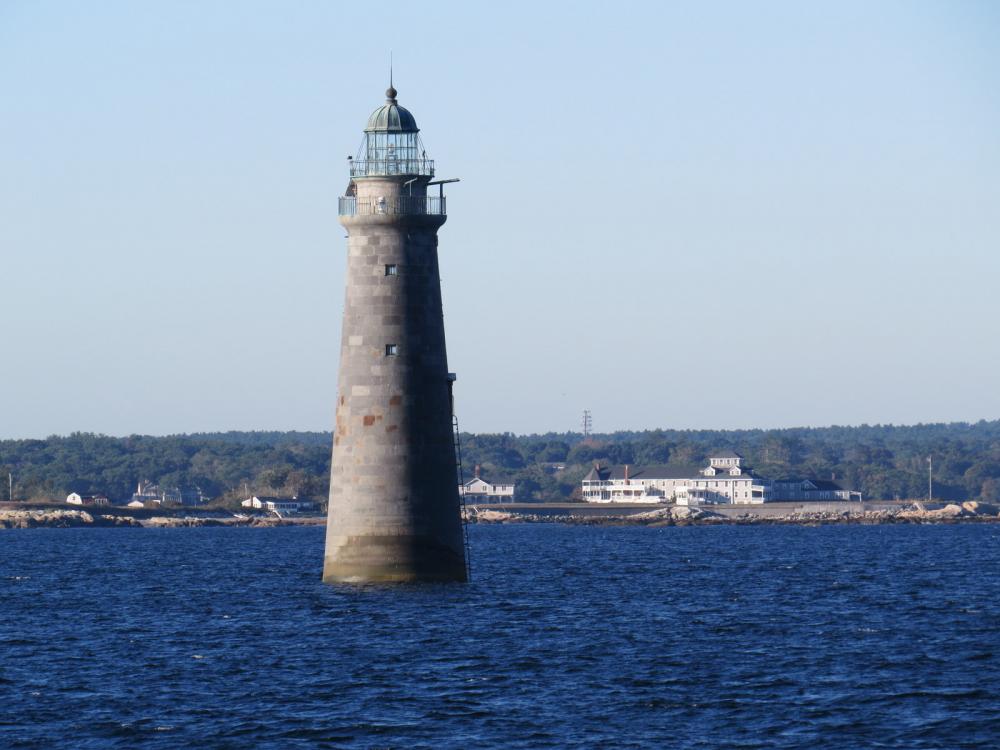
It has withstood countless tempests and actually sways during particularly bad storms. In 1909, on Christmas Day, Keeper Milton Reamy claimed that a wave 176 ft in height hit the lighthouse. It is in a truly impressive spot and one I would not care to visit on a stormy night.
On our trip to the canal, we saw a number of whales and dolphins as the visibility was excellent. Once through the Cape Cod Canal we stopped at Mattapoisett, Massachusetts and weathered a sunset storm then proceded onto Bristol, Rhode Island. Today we moved again and are currently in Orient, Long Island. As soon as the anchor was set and the aft deck washed down, we sat outside to enjoy the end of a great day doing a Jane Wooster Scott jigsaw puzzle, listening to Trentemoller Radio on Pandora, sipping wine and watching as our friends on their motor yacht Woofie anchored nearby. We met the "Woofites" last year and have bumped into them numerous times this year. We are both heading south and looking for the right weather window but are keeping an eye on Tropical Storm Karl spinning off Africa right now. If you look closely, the bullseye in the middle of the pink section shows the average wave height to be 8.4 meters (27 feet) just south of Bermuda. No plans to go to Bermuda, that's for sure.
(For more photos click Gallery above.)
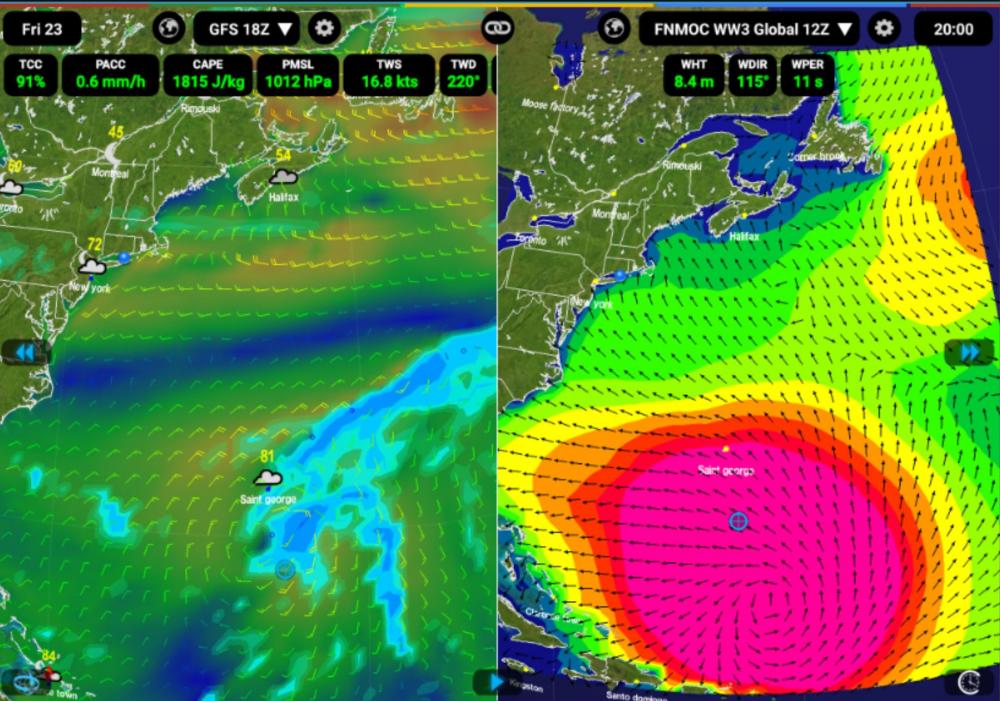
It has withstood countless tempests and actually sways during particularly bad storms. In 1909, on Christmas Day, Keeper Milton Reamy claimed that a wave 176 ft in height hit the lighthouse. It is in a truly impressive spot and one I would not care to visit on a stormy night.
On our trip to the canal, we saw a number of whales and dolphins as the visibility was excellent. Once through the Cape Cod Canal we stopped at Mattapoisett, Massachusetts and weathered a sunset storm then proceded onto Bristol, Rhode Island. Today we moved again and are currently in Orient, Long Island. As soon as the anchor was set and the aft deck washed down, we sat outside to enjoy the end of a great day doing a Jane Wooster Scott jigsaw puzzle, listening to Trentemoller Radio on Pandora, sipping wine and watching as our friends on their motor yacht Woofie anchored nearby. We met the "Woofites" last year and have bumped into them numerous times this year. We are both heading south and looking for the right weather window but are keeping an eye on Tropical Storm Karl spinning off Africa right now. If you look closely, the bullseye in the middle of the pink section shows the average wave height to be 8.4 meters (27 feet) just south of Bermuda. No plans to go to Bermuda, that's for sure.
(For more photos click Gallery above.)
Set and Relax
11 September 2016 | Ebenecook Harbor near Boothbay Harbor, Maine, USA
Vicki – Air 19 dec C, Cloud 2/8, Wind 17 kn, W
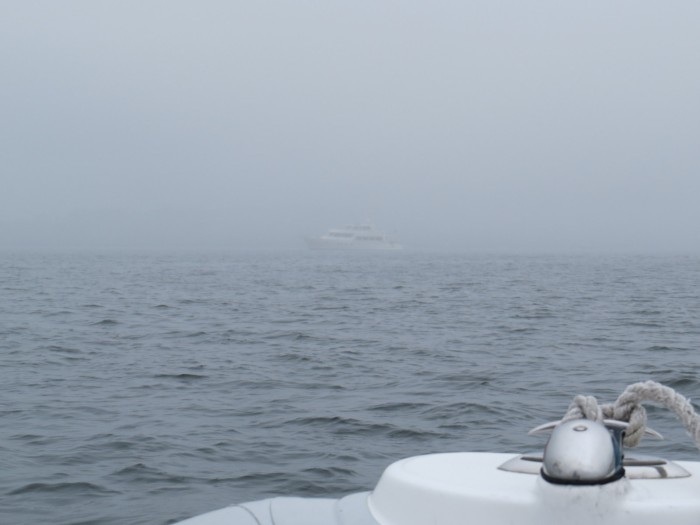
We’re currently anchored in another picture perfect spot in one of our favourite anchorages, Ebenecook Harbour on the Sheepscot River near Boothbay. We left Rockland last Friday after a number of consecutive foggy days. The seas were 3 to 4 foot with high fog which burned off by late morning. Yesterday we took the dinghy through Townsend Gut and spent Saturday in Boothbay being tourists. We met artist Maria Boord at her studio in town. She paints up to 15 works at a time in oil on canvas and wood and her pieces really capture the feel and beauty of Maine. One painting in particular took my fancy and Maria kindly showed us on a tourist map where to find the actual scene of a shack covered in lobster buoys. Unfortunately the painting had sold otherwise I would have been very tempted. It was getting late in the day and was quite cool but we decided to find the shack and headed in the general direction of the map but then converted to the Navionics App on Maynard’s phone to try to locate it.
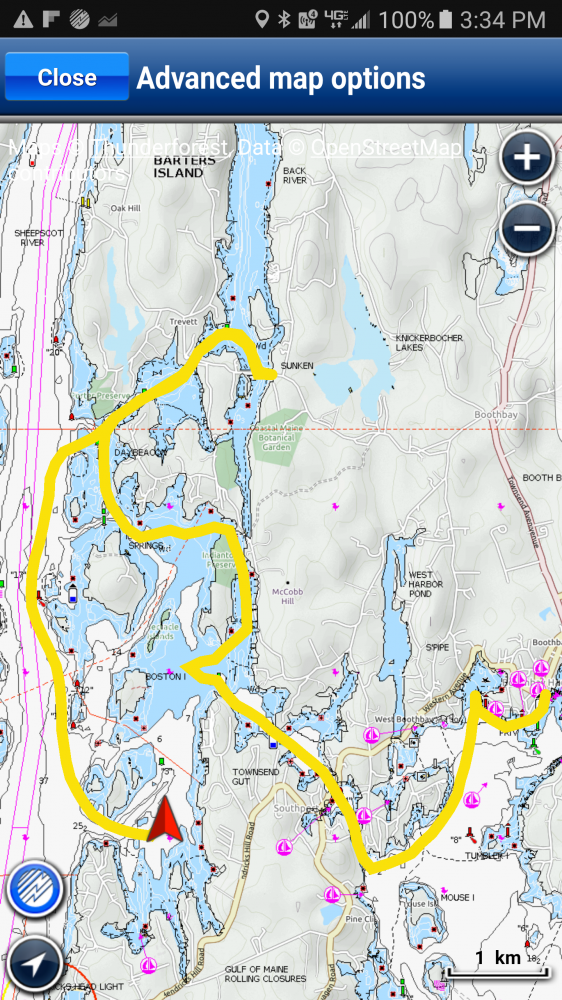
It wasn’t easy as there are a myriad amount of waterways, rocks, the ubiquitous lobster buoys, bridges, and docks and a tourist map is not at all like a marine chart. We eventually found it (at the top of the above map) and I was able to take photographs of the colourful lobster buoys. It was a worthy and successful hunt.
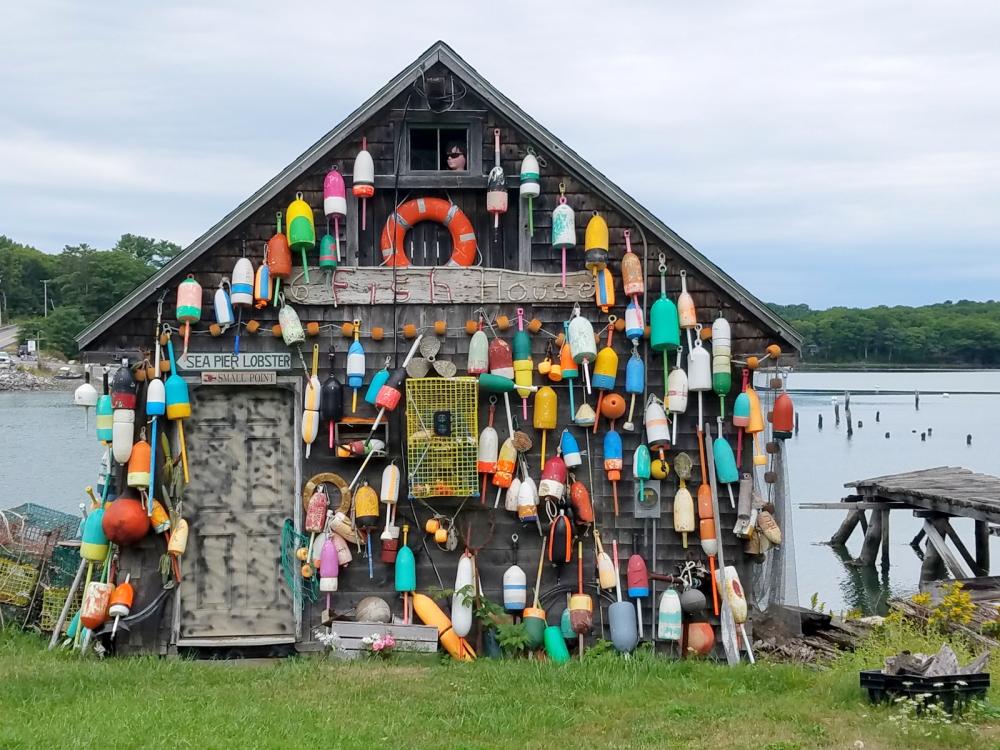
Everything happens at 3:00 am on a boat doesn’t it. A front was due to arrive after midnight. We have previously dragged anchor at Ebenecook Harbour with the CQR, so I made a special note before retiring of the direction of a red light tower, the moon, a nearby island etc so that if our anchor alarm screamed at us, I could leap out of bed and know exactly where we were. At 3:07 am, we awoke to flashes of light and the sound of thunder very close. I leapt out of bed, put my nose to the flyscreen and could see a white wall. Huh? Wake up Vicki. Something’s not right. Maynard waited for a report under the covers. I went outside and couldn’t see a thing as we were surrounded by the thickest fog ever. The subdued flashes of lightning continued from the nearby storm but to see fog and lightning together like this is rare. It is possible for thunder fog to occur when there is a very moist stable layer at the surface with a very unstable atmosphere above it. Last year we experienced thunder fog one morning in Massachusetts. The storms passed north of us and by the morning the fog had lifted. We experienced another storm mid-morning today with wind and our anchor pattern shows we have not moved an inch with the new Rocna. It’s starting to truly feel like a “set and relax” anchor.

It wasn’t easy as there are a myriad amount of waterways, rocks, the ubiquitous lobster buoys, bridges, and docks and a tourist map is not at all like a marine chart. We eventually found it (at the top of the above map) and I was able to take photographs of the colourful lobster buoys. It was a worthy and successful hunt.

Everything happens at 3:00 am on a boat doesn’t it. A front was due to arrive after midnight. We have previously dragged anchor at Ebenecook Harbour with the CQR, so I made a special note before retiring of the direction of a red light tower, the moon, a nearby island etc so that if our anchor alarm screamed at us, I could leap out of bed and know exactly where we were. At 3:07 am, we awoke to flashes of light and the sound of thunder very close. I leapt out of bed, put my nose to the flyscreen and could see a white wall. Huh? Wake up Vicki. Something’s not right. Maynard waited for a report under the covers. I went outside and couldn’t see a thing as we were surrounded by the thickest fog ever. The subdued flashes of lightning continued from the nearby storm but to see fog and lightning together like this is rare. It is possible for thunder fog to occur when there is a very moist stable layer at the surface with a very unstable atmosphere above it. Last year we experienced thunder fog one morning in Massachusetts. The storms passed north of us and by the morning the fog had lifted. We experienced another storm mid-morning today with wind and our anchor pattern shows we have not moved an inch with the new Rocna. It’s starting to truly feel like a “set and relax” anchor.
The Fog
07 September 2016 | Penobscot Bay, Maine, USA
Vicki – Air 18 deg c, Sea 17.5 deg c, Fog, Wind 2 kn E
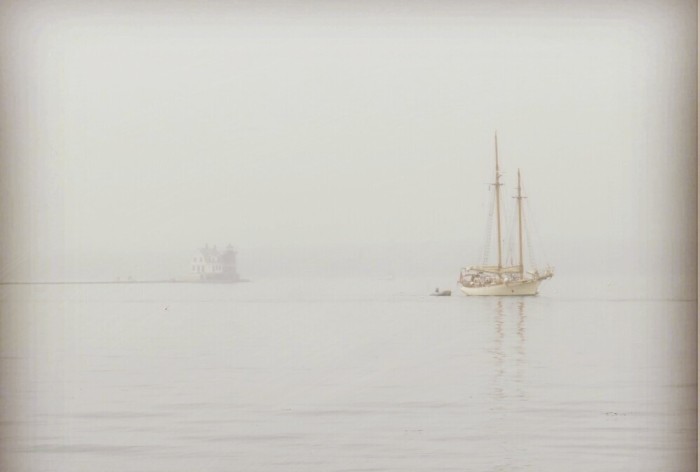
If you're wondering why we are still in the same general area, we spent last week dealing with the USA health system trying to fill a couple of prescriptions. This simple act took the entire week and it is no wonder that the American health system is in such disarray. This week we are waiting for the weather to abate further south and for the seas to die down from ex Hurricane Hermine. Meanwhile Maynard has been on the phone constantly with an incredible amount of work for his company. The older he gets, the harder he works it seems although I am trying to convince him otherwise. Fortunately we are very comfortable as Vanish is set up like a home with phone and internet access plus we have access to all that the local towns provide. We experienced only the slightest effect from Hurricane Hermine. My mackerel sky observation at 6pm the previous night brought a 20 kn north-easterly 9 hours later but we had moved behind the Rockland Breakwater on sunset. Rockland Harbor is exposed to the east and north-east so boats tend to anchor behind the rock wall in bad weather although the lobbie men have potted it out with lobster buoys so it's difficult to find swinging room. We are gaining more confidence in our new Rocna anchor and it means we can anchor with slightly less chain on the bottom so we can squeeze in a little better. Whenever we raise the anchor, it comes up with at least a couple of hundred pounds of sticky mud which Maynard pushes off with the boat hook so it is definitely grabbing the bottom beautifully. We find it doesn't slide at all when we put Vanish in reverse to set it. It just drops and grabs and is a totally different experience to the CQR. So far, so good.
Our marina in Brunswick, Georgia bore the brunt of Hurricane Hermine with 75 mph winds coming directly into the inlet with 5 foot waves which destroyed the dock house on Dock 1. Dock 1 sacrificed itself to save all the other yachts in the marina which all survived without damage. The outer bands here in Maine associated with Hurricane Hermine provided us with a beautiful sunset before the north-easterly arrived in the night.
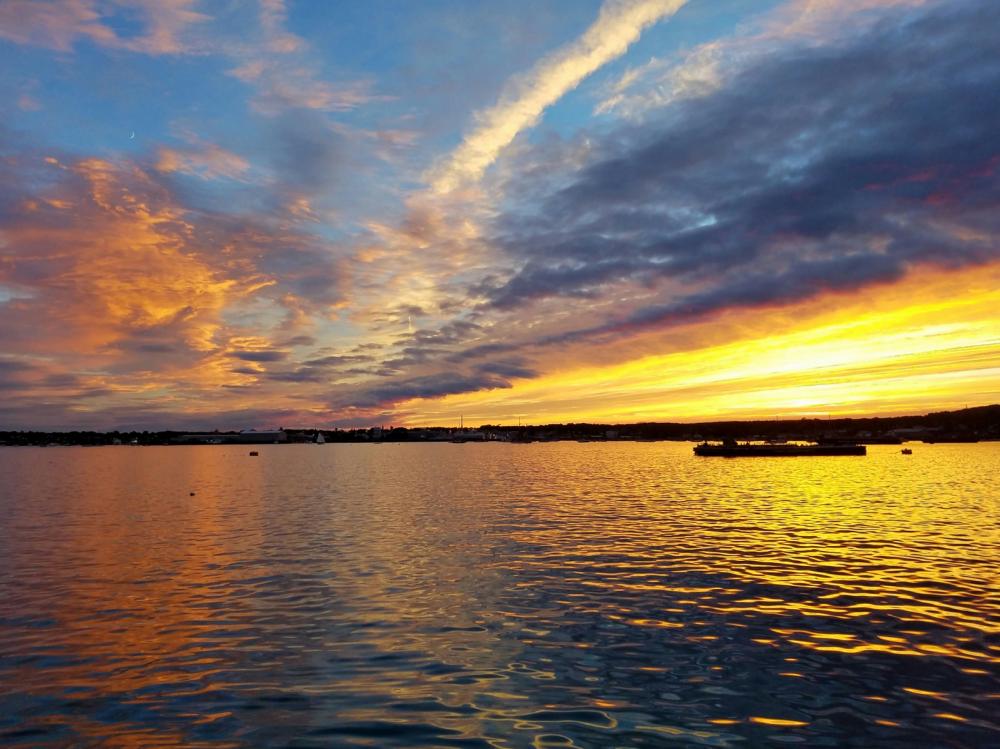
The next day, the fog rolled in as you can see in the above photo. The sea surface was glassy and every now and again a seal or loon would pop up nearby. It became very thick after dark and it was impossible to see any nearby yachts or their anchor lights. It was Maynard's birthday but unfortunately he was on the phone to Australia until late so we could not go to town for a birthday dinner. Around 9 pm, we saw a bright light outside in the pitch dark. When we went onto the bow to investigate, we saw that a lobster boat had come into the anchorage and was tying up to a nearby mooring. Even with radar, this would have been an incredibly difficult maneuver with lit and unlit boats, lobster buoys, moorings, barges and navigation markers. It is hard enough when it's dark but brutal with less than 100 meters of visibility with the fog. It felt super creepy outside but warm and toasty in the well-lit salon of Vanish. It is again foggy today and is forecast to be so again tomorrow with drizzle and then thunderstorms by the end of the week.
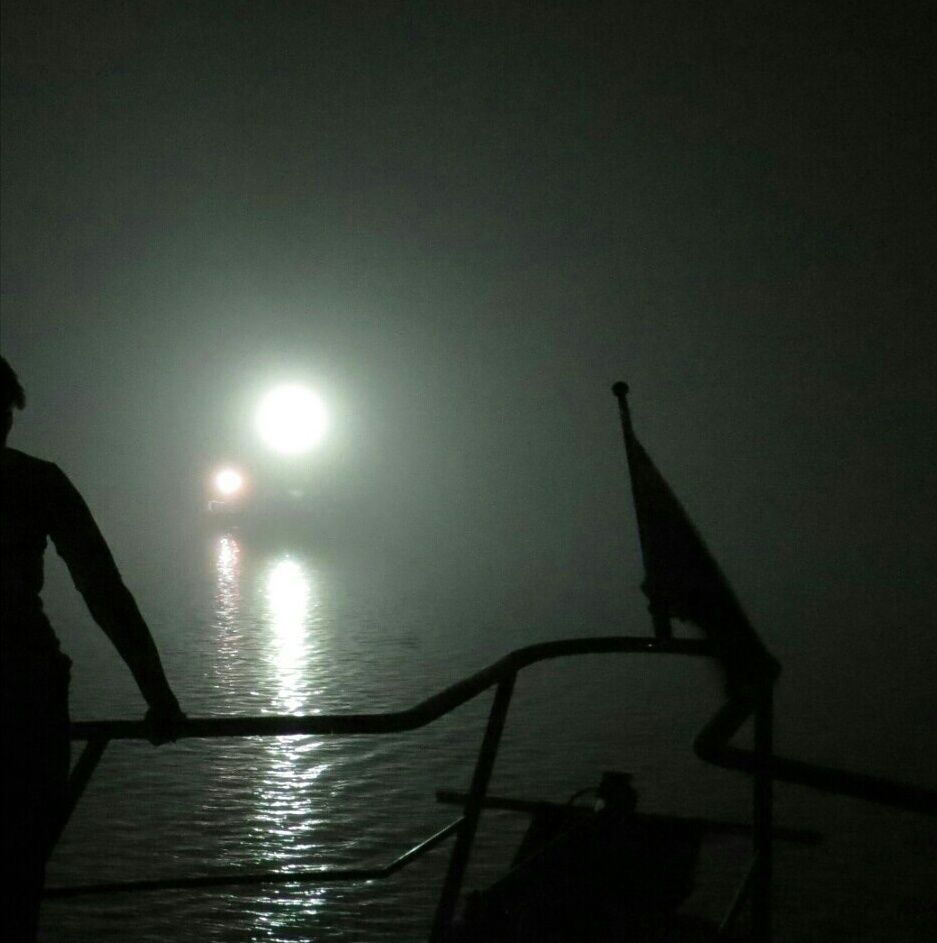
Our marina in Brunswick, Georgia bore the brunt of Hurricane Hermine with 75 mph winds coming directly into the inlet with 5 foot waves which destroyed the dock house on Dock 1. Dock 1 sacrificed itself to save all the other yachts in the marina which all survived without damage. The outer bands here in Maine associated with Hurricane Hermine provided us with a beautiful sunset before the north-easterly arrived in the night.

The next day, the fog rolled in as you can see in the above photo. The sea surface was glassy and every now and again a seal or loon would pop up nearby. It became very thick after dark and it was impossible to see any nearby yachts or their anchor lights. It was Maynard's birthday but unfortunately he was on the phone to Australia until late so we could not go to town for a birthday dinner. Around 9 pm, we saw a bright light outside in the pitch dark. When we went onto the bow to investigate, we saw that a lobster boat had come into the anchorage and was tying up to a nearby mooring. Even with radar, this would have been an incredibly difficult maneuver with lit and unlit boats, lobster buoys, moorings, barges and navigation markers. It is hard enough when it's dark but brutal with less than 100 meters of visibility with the fog. It felt super creepy outside but warm and toasty in the well-lit salon of Vanish. It is again foggy today and is forecast to be so again tomorrow with drizzle and then thunderstorms by the end of the week.

Holy Mackerel
05 September 2016 | Penobscot Bay, Maine, USA
Vicki - Air - 22 deg c, 5/8 Clouds
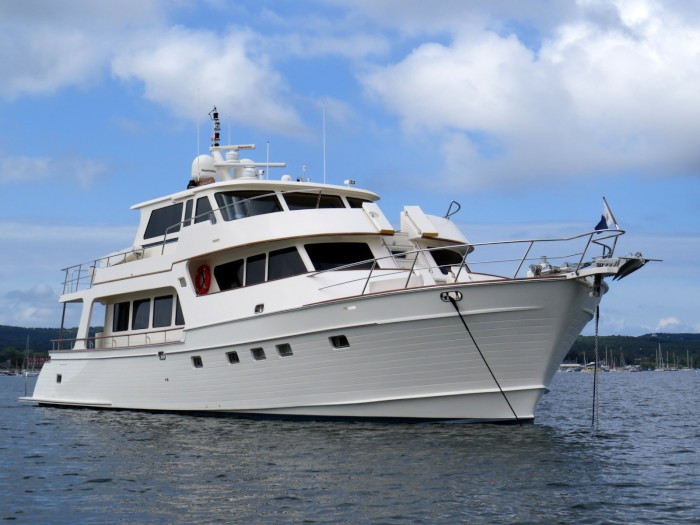
This afternoon I spotted mackerel clouds in the sky. I am trying to note these clouds to see if they do indeed bring wind in 6 to 12 hours. We will soon find out. The 5 day Marine Weather Forecast for Penobscot Bay AN 151 said today 5 to 10 knots NE but when scrolling to the bottom of the 5 day forecast under Watches & Warnings it forecast 20 to 30 kn NE. So which do we believe? 5 - 10 kn or 20 - 30 kn. We do not understand this method of forecasting at all. If it's going to be 20 - 30 kn, we need to move behind the Rockland Breakwater as the harbor is open to the east and northeast. Hmmm. What to do....
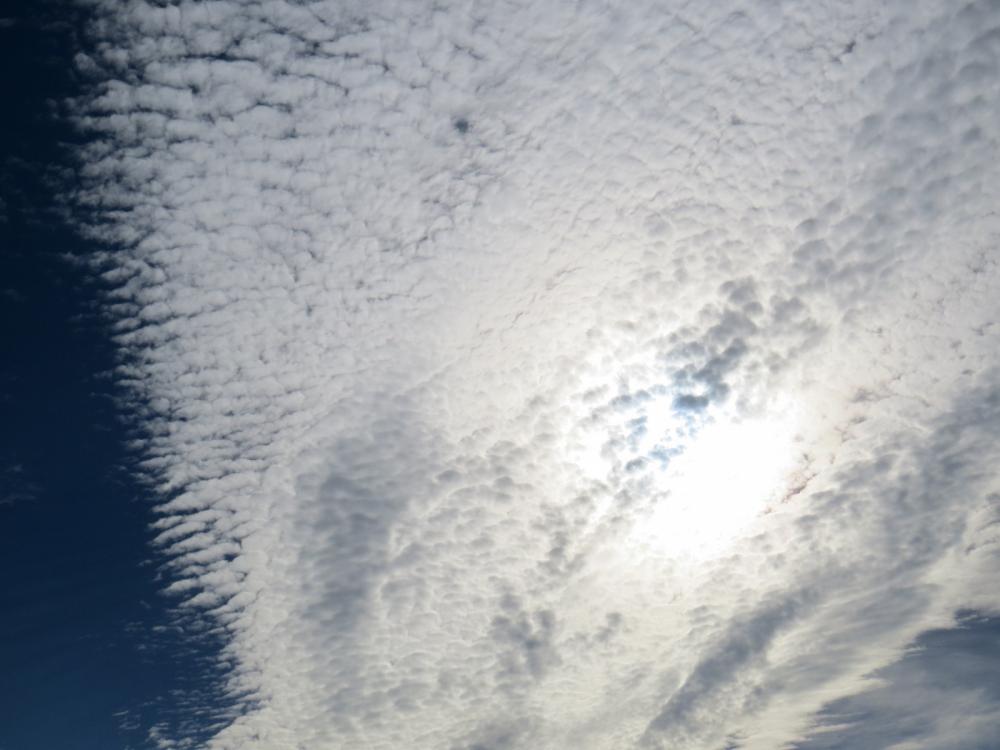
Here We Go Again
04 September 2016 | North Haven, Vinalhaven, Maine, USA
Vicki – Air 21 deg C, No Cloud, Sea 17 deg c, Wind 2 kn E
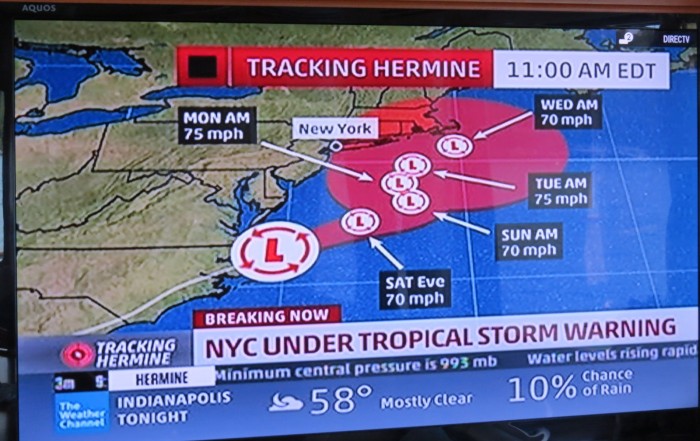
Without doubt, the trickiest part of our cruising is the return trip to Georgia. We were caught in Hurricane Sandy in the Bahamas in 2012 and last year we were caught in an east coast low for a week at Cape Lookout in Southern Carolina. I would like to think that we can deliver Vanish without any hiccups this year. The main issue is deciding how long to stay in Maine before the strong northerlies arrive, yet leave late enough so that we don’t run into a hurricane. We’ve watched the progress of Invest 99L, now named Hurricane Hermine since August 16. It finally crossed the coast in the Big Bend area of Florida during the week before crossing out to sea in the Carolinas and threatening the whole of the east coast of the USA as it headed up to Long Island, New York. Right now, it is expected to spin offshore of New Jersey, New York and Massachusetts for a couple of days and then meander north, perhaps north-westward before heading east. The above photo from the Weather Channel, where the reporters are excitedly describing the mayhem which may ensue, shows a lot of wind south of us. We are located approximately under the ‘N’ in the words across the photo at the top “TRACKING HERMINE”. The seas are expected to be quite large so even after it passes, we will wait until the ocean has calmed again before making our way south. As long as it stays well offshore, we’re happy. Last night we saw a flock of Canada geese heading south, a sure sign it's nearly time to go.
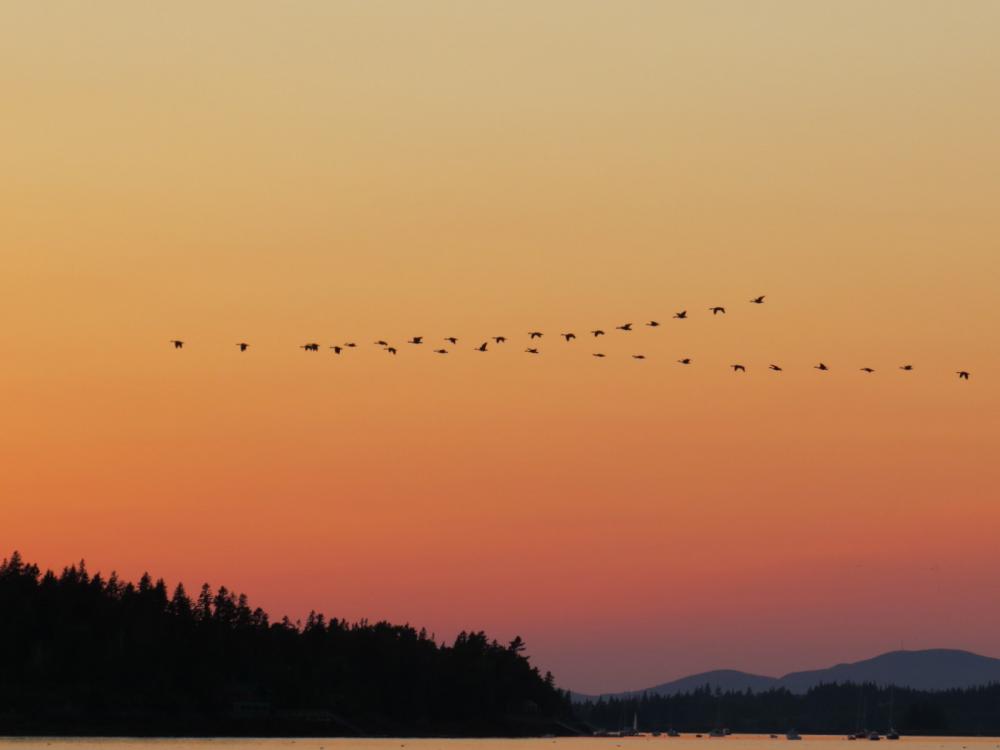
Error Code 7
28 August 2016 | Castine, Maine, USA
Vicki - Air – 20 deg C, Cloud 6/8, Water 17 deg C
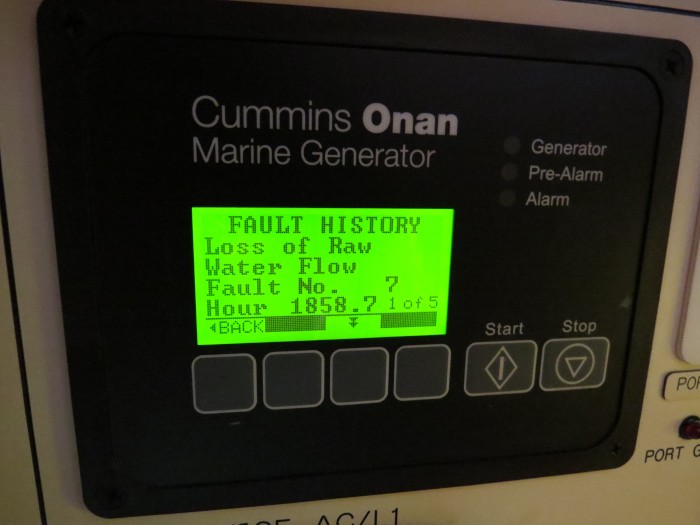
Vanish has two 25 kw Onan gensets which keep the batteries charged and provide a reliable source of 240 volt electricity when we are anchored out. We run them approximately three hours a day and along with the trickle charge from our solar panels, we never have a shortage of power. This morning, Maynard started the portside genset as normal then after a few seconds it turned itself off. Really? This was a first after five amazing years of trouble free reliability. Sundays are days for messing around in the dinghy, going to lunch, exploring creeks and hiking through local National Parks but no, not today as the engine room was calling. The genset will switch itself off for a large number of reasons as it has many sensors. The genset display said it had an Error Code 7, Loss Of Raw Water Flow meaning it was not getting any water or that there was a blockage somewhere in the saltwater intake or possibly a raw water pump failure or perhaps the impeller is damaged.
He checked the sea chest where the raw water intake on Vanish is located and it all looked clear. He closed the seacock and inspected the impeller and it all looked fine with saltwater still being in the saltwater pump. He restarted the genset and once again it went off after a few seconds. It ran long enough for him to determine that the raw water pump was circulating water so it must be some sort of sensor failure or some other obscure problem. He removed all the panels around the genset for access and located the raw water pump pressure sensor and unfortunately in the process, badly tore a back muscle, something he hasn't done all year. One of the wires to the sensor was a bit rusty and one of the terminals on the sensor was also a bit rusty. He cleaned them up and restarted the motor and again it died after 3 or 4 seconds.
He removed the suspect sensor, brought it up and checked its conductivity which seemed ok. After a few pain pills and a prescription anti-inflammatory called Mobic, he thought about taking the sensor off the starboard genset to see if that would solve the problem. He decided not to do that as we have one functioning genset and he has a basic policy of not messing with things that work. I suggested we look in our spares to see if we had a spare one but it was a long shot. When we first started out on Vanish five years ago, Onan prepared a spare parts kit for us. As Maynard could now barely move, I jumped down into the pump room which is located under the floor on the lower deck, and hauled out a 50 lb box which contained all our genset spares and right on top was exactly what we needed, a spare Raw Water Pressure Sensor Part No.0309-0717. Apparently, these things fail from time to time and Onan includes a couple of them in their spare parts kit. He hobbled down to the engine room again carefully, put the part in, started it up and it roared to life without any complaint unlike his back which will take some time to heal. We'd planned on moving Vanish today but will wait until Maynard has more mobility.
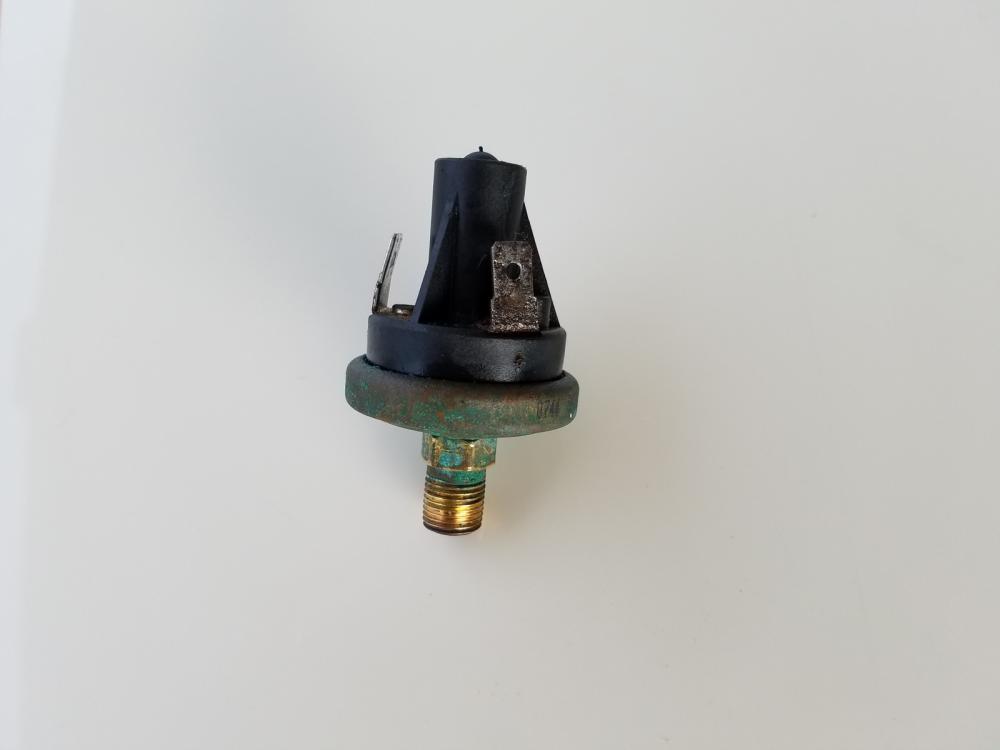
He checked the sea chest where the raw water intake on Vanish is located and it all looked clear. He closed the seacock and inspected the impeller and it all looked fine with saltwater still being in the saltwater pump. He restarted the genset and once again it went off after a few seconds. It ran long enough for him to determine that the raw water pump was circulating water so it must be some sort of sensor failure or some other obscure problem. He removed all the panels around the genset for access and located the raw water pump pressure sensor and unfortunately in the process, badly tore a back muscle, something he hasn't done all year. One of the wires to the sensor was a bit rusty and one of the terminals on the sensor was also a bit rusty. He cleaned them up and restarted the motor and again it died after 3 or 4 seconds.
He removed the suspect sensor, brought it up and checked its conductivity which seemed ok. After a few pain pills and a prescription anti-inflammatory called Mobic, he thought about taking the sensor off the starboard genset to see if that would solve the problem. He decided not to do that as we have one functioning genset and he has a basic policy of not messing with things that work. I suggested we look in our spares to see if we had a spare one but it was a long shot. When we first started out on Vanish five years ago, Onan prepared a spare parts kit for us. As Maynard could now barely move, I jumped down into the pump room which is located under the floor on the lower deck, and hauled out a 50 lb box which contained all our genset spares and right on top was exactly what we needed, a spare Raw Water Pressure Sensor Part No.0309-0717. Apparently, these things fail from time to time and Onan includes a couple of them in their spare parts kit. He hobbled down to the engine room again carefully, put the part in, started it up and it roared to life without any complaint unlike his back which will take some time to heal. We'd planned on moving Vanish today but will wait until Maynard has more mobility.

Not Going Anywhere
27 August 2016 | Belfast, Maine, USA
Vicki – Air 26 dec Cloud 4/8, Water 17.5 deg C, Wind 10 kn N
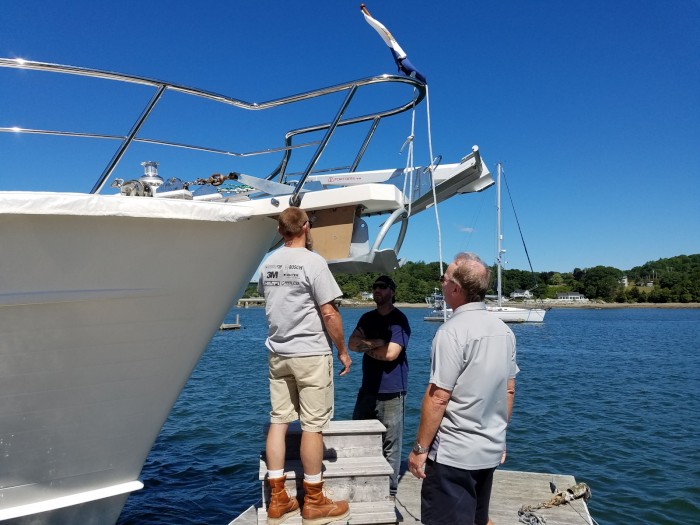
Well the good news is that Vanish was only in the Front Street Shipyard on the hard for two weeks. A boat yard is a bit like swimming in molasses. It seems like a sweet idea at the time but getting to the end is much harder than one can imagine. There are so many people working at one time. It’s quite stressful keeping an eye on all the various jobs to ensure we end up with what we want. We arrived back from our trip to Canada just in time to watch over the bigger jobs.
Our transom door needed resealing as the seals were becoming worn out after 5 years. We added another coat of Biocop antifoul to the bottom, the seacocks were serviced, the underwater lights were cleaned and the zincs were replaced and prop shafts cleaned and painted and a complete engine service was done. The trim tab sensors were not working although the trim tabs went up and down but we did not know what their position was. (Trim tabs lower the bow as power is applied. They keep the boat flatter allowing us to get on a plane easier.) This failure occurred during a nearby lightning strike a couple of years ago in Charleston and these sorts of failures are always hard to find. It turned out that it was an actuator sensor fault, a faulty switch pad and a faulty relay box and all three of these faults interacted in a confusing way. It took some pretty clever work by the Front Street head electrician Ben Feeney to sort it all out. Once all the parts were fixed and reattached in the right order the whole trim tab system works perfectly.
Another job which was high on our list was to make an improvement to our swim platform. The platform is quite large around 6 m x 1.5 m with 4 slatted teak sections covering around half the area. At anchor when we are full of fuel with Vanish sitting quite a bit lower in the water, whenever the wake from passing boats hits the platform, water shoots up between the slats and makes it hard to stay dry whenever we are working on the platform or boarding the dinghy. The first thought was to replace the slats with solid teak but in the end we decided to attach lexan under the slatted sections leaving room for water to drain around the lexan panels. This prevents water from wetting the platform and still allows us to see our underwater lights under the platform.
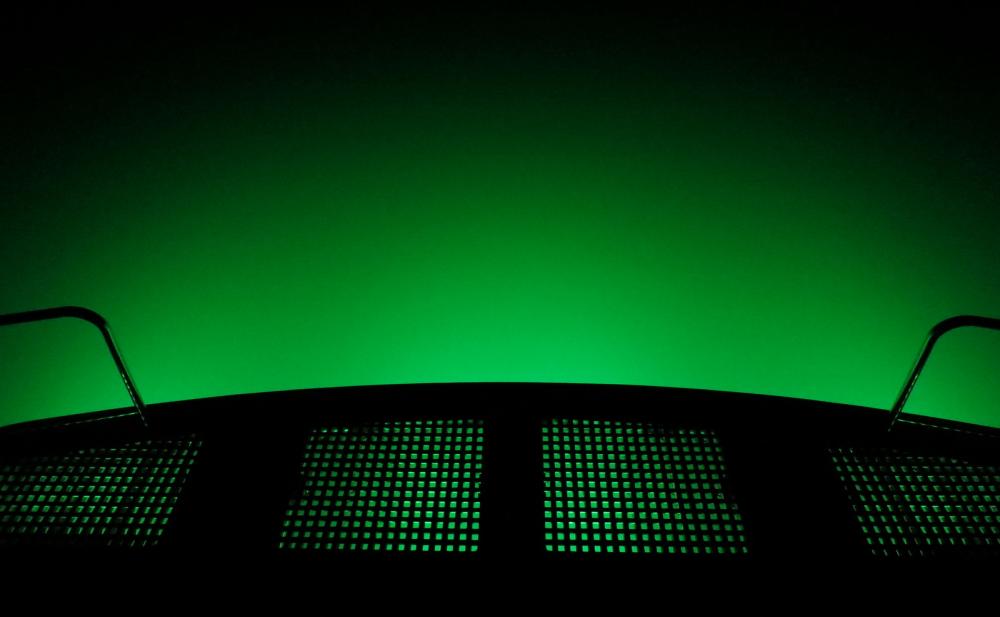
Out of the 61 days we were at anchor this season, our 180 lb CQR anchor has let go three times each time after Vanish had sat in the same spot for a day or two with the wind less than 30 knots. However, in the 40 to 50 knot blow in Rhode Island a couple of months ago, we sat perfectly with no dragging. No one likes “anchor unpredictability” so we decided to change to a modern Rocna 70 anchor. This required substantial modifications to the bow roller assembly which the Front Street boys handled very well. We will report back and let you know if this anchor is better. We also decided to put our Fortress anchor on the bow as our secondary anchor. These two anchors give us a lot of flexibility in all the bottom types we are likely to run into.
This work was done at the dock in Belfast allowing us to move back on board and act like tourists again in Belfast town. We were also given access to the yard’s very old Volvo for shopping trips and to see the World Championship Boatyard Dog Trials in Rockland which was a real hoot. Each competitor had to negotiate lobster traps on the dock, jump in and out of an unstable dinghy, fetch a frisby in the cold water and perform tricks with their owners. Some dogs refused to jump in once their paws felt the water temperature so their handlers had to jump in instead. Another dog shucked corn with his teeth. The dog winners were a pair of labradors who stood on a paddleboard until one of them walked to the end upending the board causing them to both fall in. It was great fun. Maine has so many events during the summer season.
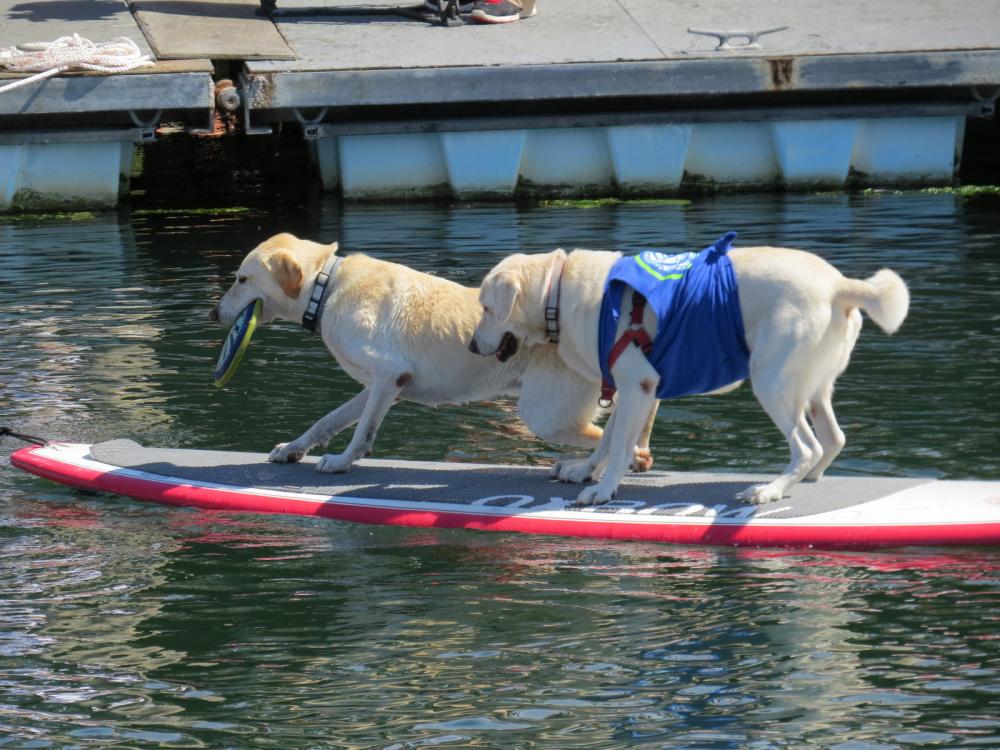
Last night, the anchor was deployed at Castine, about 7 miles from Belfast, for the very first time. Hopefully we are not going anywhere and this anchor will prove itself. Maybe it was psychological, but it sure felt secure when we dug it in. We noticed that the paddlewheel for our speedo was not working on the trip over to Castine so once again, Maynard had to brave the cold water in his wetsuit to dive down to free it. The alternative is to pull the speedo sensor out to fix it but it is located in the bilge in the twin room and the thought of a seawater fountain in the interior before shoving it back in is quite unpalatable. We always used to remove the paddlewheel in Cruz Control whenever we left it in the marina for some time but we don’t normally do this on Vanish.
My nightly routine before sleep at anchor is to study the anchor patter on the Google app called Anchor Pro to ensure we’re not dragging. No one likes to wake up to the sound of an anchor alarm or to look out the window and see a completely different vista from the one that should be there. Interestingly, an extremely experienced couple on a Nordhaven 55 called Dirona who are currently in Newfoundland mentioned in their blog yesterday that they have never dragged anchor with their Rocna whilst on their three year navigation. That’s definitely music to my ears.
Our transom door needed resealing as the seals were becoming worn out after 5 years. We added another coat of Biocop antifoul to the bottom, the seacocks were serviced, the underwater lights were cleaned and the zincs were replaced and prop shafts cleaned and painted and a complete engine service was done. The trim tab sensors were not working although the trim tabs went up and down but we did not know what their position was. (Trim tabs lower the bow as power is applied. They keep the boat flatter allowing us to get on a plane easier.) This failure occurred during a nearby lightning strike a couple of years ago in Charleston and these sorts of failures are always hard to find. It turned out that it was an actuator sensor fault, a faulty switch pad and a faulty relay box and all three of these faults interacted in a confusing way. It took some pretty clever work by the Front Street head electrician Ben Feeney to sort it all out. Once all the parts were fixed and reattached in the right order the whole trim tab system works perfectly.
Another job which was high on our list was to make an improvement to our swim platform. The platform is quite large around 6 m x 1.5 m with 4 slatted teak sections covering around half the area. At anchor when we are full of fuel with Vanish sitting quite a bit lower in the water, whenever the wake from passing boats hits the platform, water shoots up between the slats and makes it hard to stay dry whenever we are working on the platform or boarding the dinghy. The first thought was to replace the slats with solid teak but in the end we decided to attach lexan under the slatted sections leaving room for water to drain around the lexan panels. This prevents water from wetting the platform and still allows us to see our underwater lights under the platform.
Out of the 61 days we were at anchor this season, our 180 lb CQR anchor has let go three times each time after Vanish had sat in the same spot for a day or two with the wind less than 30 knots. However, in the 40 to 50 knot blow in Rhode Island a couple of months ago, we sat perfectly with no dragging. No one likes “anchor unpredictability” so we decided to change to a modern Rocna 70 anchor. This required substantial modifications to the bow roller assembly which the Front Street boys handled very well. We will report back and let you know if this anchor is better. We also decided to put our Fortress anchor on the bow as our secondary anchor. These two anchors give us a lot of flexibility in all the bottom types we are likely to run into.
This work was done at the dock in Belfast allowing us to move back on board and act like tourists again in Belfast town. We were also given access to the yard’s very old Volvo for shopping trips and to see the World Championship Boatyard Dog Trials in Rockland which was a real hoot. Each competitor had to negotiate lobster traps on the dock, jump in and out of an unstable dinghy, fetch a frisby in the cold water and perform tricks with their owners. Some dogs refused to jump in once their paws felt the water temperature so their handlers had to jump in instead. Another dog shucked corn with his teeth. The dog winners were a pair of labradors who stood on a paddleboard until one of them walked to the end upending the board causing them to both fall in. It was great fun. Maine has so many events during the summer season.
Last night, the anchor was deployed at Castine, about 7 miles from Belfast, for the very first time. Hopefully we are not going anywhere and this anchor will prove itself. Maybe it was psychological, but it sure felt secure when we dug it in. We noticed that the paddlewheel for our speedo was not working on the trip over to Castine so once again, Maynard had to brave the cold water in his wetsuit to dive down to free it. The alternative is to pull the speedo sensor out to fix it but it is located in the bilge in the twin room and the thought of a seawater fountain in the interior before shoving it back in is quite unpalatable. We always used to remove the paddlewheel in Cruz Control whenever we left it in the marina for some time but we don’t normally do this on Vanish.
My nightly routine before sleep at anchor is to study the anchor patter on the Google app called Anchor Pro to ensure we’re not dragging. No one likes to wake up to the sound of an anchor alarm or to look out the window and see a completely different vista from the one that should be there. Interestingly, an extremely experienced couple on a Nordhaven 55 called Dirona who are currently in Newfoundland mentioned in their blog yesterday that they have never dragged anchor with their Rocna whilst on their three year navigation. That’s definitely music to my ears.
Stop Laughing!
12 August 2016 | Mount Washington, New Hampshire, USA
Vicki – Hot 31 deg c at base, 52 mph at summit and 56 deg F
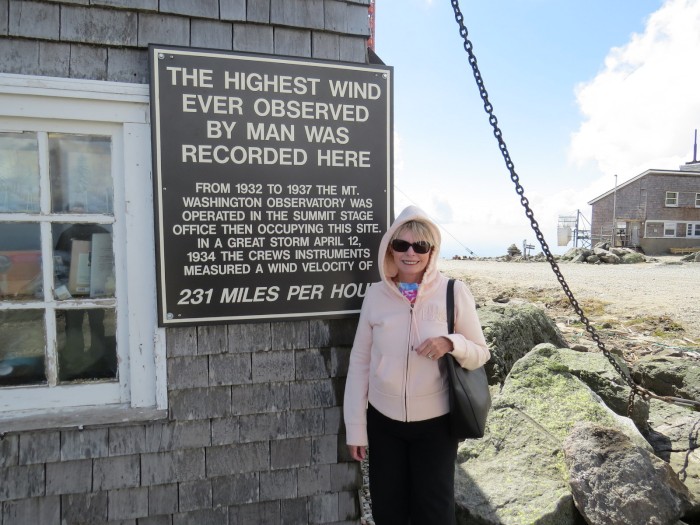
We weren't due back to the boatyard until Monday. We figured that 10 days in Canada would have been ample time to do the antifouling, the modifications to the swim platform, polish the lower portion of the hull, re-seal the transom door, sikaflex areas on deck and look at what would be required to install a new Rocna anchor. We normally would have stayed to oversee these projects but unfortunately getting our visas renewed took priority. We felt we were in good hands at the Front Street Shipyard so we stayed with the plan to see the White Mountains in New Hampshire. Of course, Maynard had not been on the Auto Road which threads its way to the summit of Mount Washington, the highest peak in the White Mountains since he was 6 years of age. He could not have imagined he'd be married to someone who was, let's not beat around the bush, absolutely scared senseless while driving up the guard rail free 8 mile road to the summit at 6,289 ft. We had been on many terrifying jaunts around the world in the past. Heck, I'd shakily walked down the steel steps of the Eiffel Tower, been down the incredible Mexican Hat road in Utah, walked across footbridges hundreds of feet high, but nothing got to me as much as this Auto Road. I admit, the noises were pathetic, the crying, the moaning, the "I don't wanna dies", the "I hate this" over and over. "Just shut your eyes. Now, why are you moaning again?" said Maynard. "I'm peeking," said I. "Stop peeking," said hubby trying to stifle laughter. The dirt road section was the worst with vehicles slowing passing each other so that their tyres wouldn't go off the edge plummeting the occupants thousands of feet to the bottom. How we (and the hundreds of other cars) made it up was a miracle. At the top, I met other people who were equally terrified. One lady put her young son in the front seat so she could lie down on the back seat. It was totally worth the challenge though.
Mount Washington holds the record for the highest wind ever recorded by man at 235 mph on 12th April, 1934 during a great storm. The view from the top was amazing with over 100 miles of visibility in all directions. It is a perfect place for research and weather monitoring as it is located at the convergence of three major storm tracks. It also has unique topography and elevation which creates extreme weather unlike anywhere else in the world. There is a great website at www.mountwashington.org if you also wish to watch the weather throughout the year at any time. The wind recordings and forecasts are quite abnormal. A wooden building on the summit has two heavy linked chains across the roof which are bolted into the ground to keep it from blowing away. There is also a stone building 2 ft thick which is very well insulated against the worst weather and a heated observatory. A three mile trip each way on the cog railway takes people up and down the mountain at an average grade of 25% and and a maximum of 37%. I would love to have travelled on the train the following day as it is the world's first mountain-climbing cog railway but the thought of it falling off the mountain with me in it was too much to think about.
The last two nights of our holiday away from Vanish were spent in The Victoria Inn B&B in Bethel, Maine, not something we ever do as B&B's are not our style but we couldn't find accommodation elsewhere. The house was built in 1895 and is described as having ornate rooms and loft suites but it seemed to be more distressed Victorian style to us. We turned up and no one was there to greet us. The front door was open and the housekeeper had left a key with a note to take Room 8 although our names were not on the note. Bethel is a pretty country town with good restaurants and pleasant neat homes, a nearby ski slope and hiking trails. We enjoyed a great meal in town and just before bed, I put my hand on the inside handle of the bathroom door and heard raucous laughter from a group of ladies out where Maynard was sitting in the bedroom. I thought, "Oh no, this is going to be a noisy place. I hope those women stop laughing." I opened the door and asked Maynard, "Did you hear that?" He said no, so I dropped the subject but funnily, you could hear a pin drop in the room. Well that's weird. During the night, Maynard woke up around 3 a.m. Someone was knocking on the door. Loudly. He heard it twice. I was awake but heard nothing. He even got out of bed and looked under the door, but no one was there. In the morning at breakfast with sour milk and fizzy out of date orange juice, I asked the housekeeper if someone was staying in our section of the house. "No, there's no one there. The room on one side of yours is empty and the room on the other side is where the owner lives but she's in hospital right now." We couldn't wait to get out of there and back to Vanish.
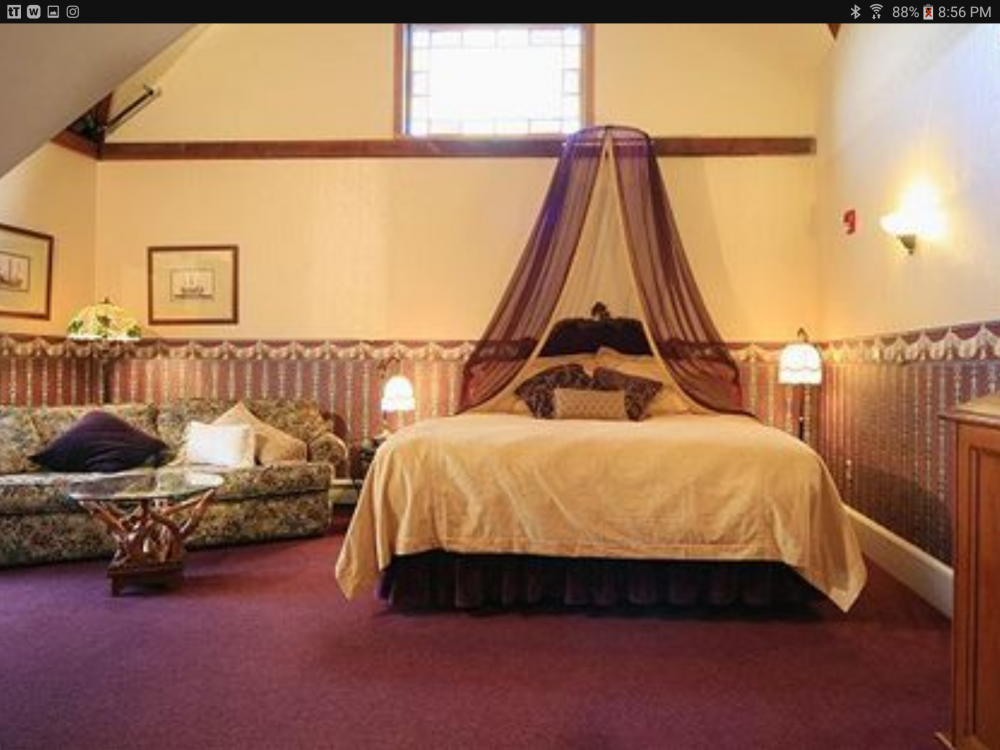
Mount Washington holds the record for the highest wind ever recorded by man at 235 mph on 12th April, 1934 during a great storm. The view from the top was amazing with over 100 miles of visibility in all directions. It is a perfect place for research and weather monitoring as it is located at the convergence of three major storm tracks. It also has unique topography and elevation which creates extreme weather unlike anywhere else in the world. There is a great website at www.mountwashington.org if you also wish to watch the weather throughout the year at any time. The wind recordings and forecasts are quite abnormal. A wooden building on the summit has two heavy linked chains across the roof which are bolted into the ground to keep it from blowing away. There is also a stone building 2 ft thick which is very well insulated against the worst weather and a heated observatory. A three mile trip each way on the cog railway takes people up and down the mountain at an average grade of 25% and and a maximum of 37%. I would love to have travelled on the train the following day as it is the world's first mountain-climbing cog railway but the thought of it falling off the mountain with me in it was too much to think about.
The last two nights of our holiday away from Vanish were spent in The Victoria Inn B&B in Bethel, Maine, not something we ever do as B&B's are not our style but we couldn't find accommodation elsewhere. The house was built in 1895 and is described as having ornate rooms and loft suites but it seemed to be more distressed Victorian style to us. We turned up and no one was there to greet us. The front door was open and the housekeeper had left a key with a note to take Room 8 although our names were not on the note. Bethel is a pretty country town with good restaurants and pleasant neat homes, a nearby ski slope and hiking trails. We enjoyed a great meal in town and just before bed, I put my hand on the inside handle of the bathroom door and heard raucous laughter from a group of ladies out where Maynard was sitting in the bedroom. I thought, "Oh no, this is going to be a noisy place. I hope those women stop laughing." I opened the door and asked Maynard, "Did you hear that?" He said no, so I dropped the subject but funnily, you could hear a pin drop in the room. Well that's weird. During the night, Maynard woke up around 3 a.m. Someone was knocking on the door. Loudly. He heard it twice. I was awake but heard nothing. He even got out of bed and looked under the door, but no one was there. In the morning at breakfast with sour milk and fizzy out of date orange juice, I asked the housekeeper if someone was staying in our section of the house. "No, there's no one there. The room on one side of yours is empty and the room on the other side is where the owner lives but she's in hospital right now." We couldn't wait to get out of there and back to Vanish.

"You're Gaming the System"
06 August 2016 | Canada/USA Border Crossing
Atmosphere - Chilly
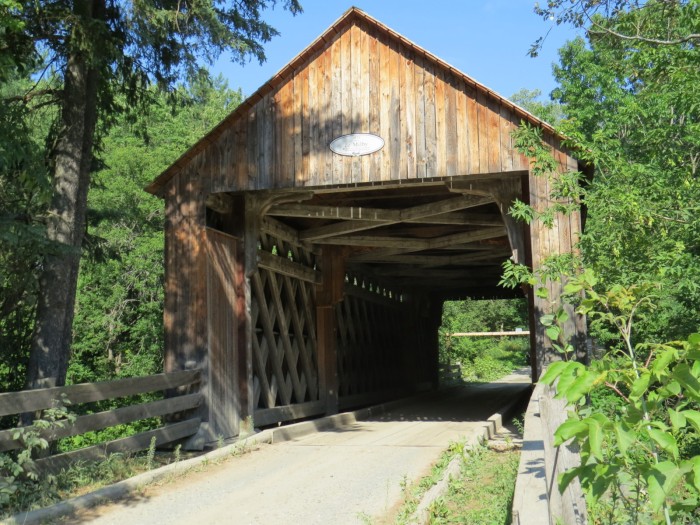
Maynard once lived in New Hampshire when he was very very young. His Mum and Dad would take the family on long road trips to the White Mountains in New Hampshire, USA so he really wanted me to see them as well. The best touristy way to see them was by going to Sherbrooke in Quebec, then cross back into the US at Canaan, Vermont. When we last spoke to CBP (Customs and Border Protection) in Portland, Maine weeks ago, we were told that in order to renew our B1/B2 visas, we needed to have a 'meaningful departure' to Canada before returning to the US. But for how long? No one would tell us. We were at the mercy of the Officer on duty on the day. Meanwhile, we spent a couple of days in lovely Sherbrooke exploring the lakes, the country roads and restaurants in the area. Interestingly, we passed road signs to towns called Asbestos and Thetford Mines, an area which became the hub of the largest asbestos deposits in the world.
Yesterday, through broken English in a nearby café called Le Houte, the waitress told us to make sure we visited the Parc de la Gorge de Coaticook so first we headed down to the town of Magog for lunch. We sat in the Guacamole Y Tequila restaurant overlooking the Magog River sipping a margarita on yet another very hot day enjoying the best Mexican food we'd had in a long time. We saw a number of covered bridges during the day, the first I'd ever seen. We arrived at the Coaticook Gorge which was well worth the visit except for the fact my vertigo was yet again challenged by having to walk across the longest walking suspension bridge in the world, a distance of 554 ft. The drop to the bottom of the gorge was over 164 feet. I'm really not getting used to these heights at all. At night, the gorge and forest are lit up during the summer months and magical lit forest figures appear from behind trees to the delight (?) of visitors in what's called Lumina Foresta.
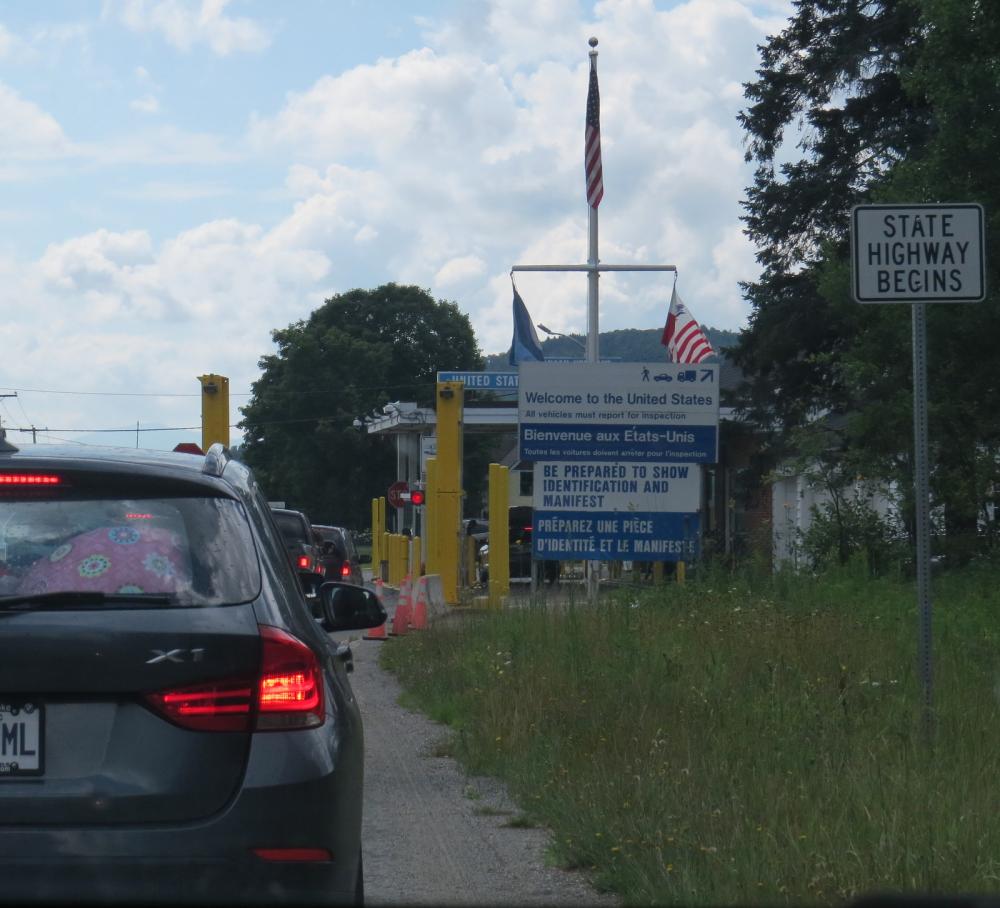
Well today was the day we drove to the USA/Canada border. Nine cars were in front of us and all were sent on their way. The officer saw our B1/B2 visas, asked us how long we'd been in Canada and asked us to pull over and come into the office. No surprises so far. We explained we were on holiday and had gone to Canada and wanted to come back so that we could take our yacht back to Georgia and return home to Australia. He seemed to be quite bothered that we'd already been in the US for 6 months, had gone to Canada for 10 days and wanted to return again. To him, it looked as though we wanted to live in the USA which is not the case. He actually told us very politely that we were gaming the system. We didn't even know what the system was and certainly weren't trying to game anything. We spent well over an hour with him answering his questions while he filled out an onscreen form. He finally said he could not let us back in. "I cannot give you the visa." Oh no. What now? Our minds were racing with ideas on who could take Vanish back south for us and the logistics of it all. When we didn't burst into tears or complain he said he would call his supervisor on the phone.
He told his supervisor that he had people in the office who 'claim' they have a boat in Belfast, Maine and want to come back into the US to take it back to Georgia but then he started talking softly and we couldn't hear the rest. We sat still and quiet. We'd answered all questions calmly and honestly but knew our lives were in his hands. He finally got off the phone and said his supervisor said, "We can give you three months, that's it." Alright, well that's not great due to the hurricane season limitations on getting back to Georgia, but maybe we can make it work. I decided to go to the bathroom and while there, he asked Maynard more questions. When Maynard also went to the bathroom, he started chit chatting to me asking me to write down the address of the shipyard which was easy as it was in my head. I also mentioned we'd been married 33 years and we also chatted about various islands we'd visited in Maine, all of which were familiar to him. Time was ticking on and on. His demeanor seemed a lot more relaxed. We don't know what questions satisfied him, but he spun the date on his stamp, stamped our passports and handed them back to us saying, "You have a free pass." WHAT? We looked at the passports and he'd given us six months. Oh wow. The Officer was actually a really nice guy who treated us very well. It would not be an easy job to assess people all day long and he was fair with us. We now had time to deal with Vanish in the boatyard and wait for the right weather to get her safely back to Georgia and go home. We got back in the car and crossed the border to Vermont, USA feeling extremely relieved and looking forward to the next chapter on Vanish.
Yesterday, through broken English in a nearby café called Le Houte, the waitress told us to make sure we visited the Parc de la Gorge de Coaticook so first we headed down to the town of Magog for lunch. We sat in the Guacamole Y Tequila restaurant overlooking the Magog River sipping a margarita on yet another very hot day enjoying the best Mexican food we'd had in a long time. We saw a number of covered bridges during the day, the first I'd ever seen. We arrived at the Coaticook Gorge which was well worth the visit except for the fact my vertigo was yet again challenged by having to walk across the longest walking suspension bridge in the world, a distance of 554 ft. The drop to the bottom of the gorge was over 164 feet. I'm really not getting used to these heights at all. At night, the gorge and forest are lit up during the summer months and magical lit forest figures appear from behind trees to the delight (?) of visitors in what's called Lumina Foresta.
Well today was the day we drove to the USA/Canada border. Nine cars were in front of us and all were sent on their way. The officer saw our B1/B2 visas, asked us how long we'd been in Canada and asked us to pull over and come into the office. No surprises so far. We explained we were on holiday and had gone to Canada and wanted to come back so that we could take our yacht back to Georgia and return home to Australia. He seemed to be quite bothered that we'd already been in the US for 6 months, had gone to Canada for 10 days and wanted to return again. To him, it looked as though we wanted to live in the USA which is not the case. He actually told us very politely that we were gaming the system. We didn't even know what the system was and certainly weren't trying to game anything. We spent well over an hour with him answering his questions while he filled out an onscreen form. He finally said he could not let us back in. "I cannot give you the visa." Oh no. What now? Our minds were racing with ideas on who could take Vanish back south for us and the logistics of it all. When we didn't burst into tears or complain he said he would call his supervisor on the phone.
He told his supervisor that he had people in the office who 'claim' they have a boat in Belfast, Maine and want to come back into the US to take it back to Georgia but then he started talking softly and we couldn't hear the rest. We sat still and quiet. We'd answered all questions calmly and honestly but knew our lives were in his hands. He finally got off the phone and said his supervisor said, "We can give you three months, that's it." Alright, well that's not great due to the hurricane season limitations on getting back to Georgia, but maybe we can make it work. I decided to go to the bathroom and while there, he asked Maynard more questions. When Maynard also went to the bathroom, he started chit chatting to me asking me to write down the address of the shipyard which was easy as it was in my head. I also mentioned we'd been married 33 years and we also chatted about various islands we'd visited in Maine, all of which were familiar to him. Time was ticking on and on. His demeanor seemed a lot more relaxed. We don't know what questions satisfied him, but he spun the date on his stamp, stamped our passports and handed them back to us saying, "You have a free pass." WHAT? We looked at the passports and he'd given us six months. Oh wow. The Officer was actually a really nice guy who treated us very well. It would not be an easy job to assess people all day long and he was fair with us. We now had time to deal with Vanish in the boatyard and wait for the right weather to get her safely back to Georgia and go home. We got back in the car and crossed the border to Vermont, USA feeling extremely relieved and looking forward to the next chapter on Vanish.
Where Are We Going?
04 August 2016 | La Malbaie, Quebec, Canada
Vicki – Air 27 C, Cloud 1/8
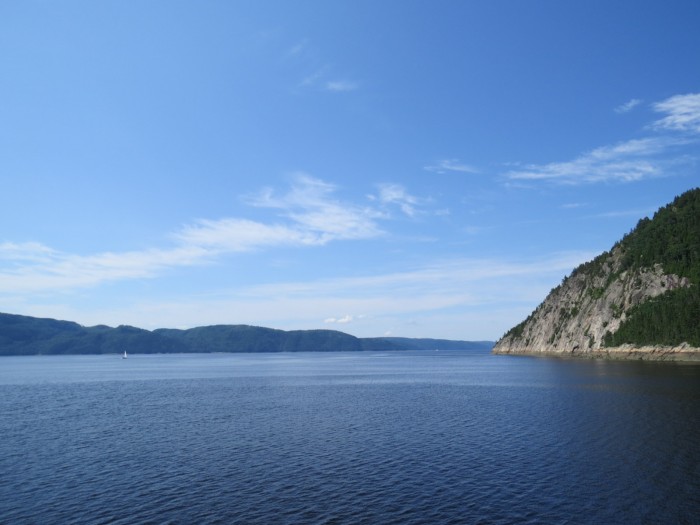
We finally figured out why everyone was in such a good mood and why there were crowds of people in all the restaurants and hotels in Quebec. It was the Construction Holiday. No, I haven’t heard of it either. Back in 1970, Quebec legislated an annual 2 week holiday for construction workers but most Quebecers also take their holidays at the same time. This was going to make it tricky to find hotels. We stayed in the Hotel Chicoutimi in Saguenay/Chicoutimi, the town with two names. It was a lovely town with great restaurants and river walks but in winter, it has some of the very worst weather one can imagine. Along with snow, the average high temperature in January is -10.7 deg C (13.7 deg F) although in early 2015, they recorded a temperature of -43 deg C which is considerably lower than their average of -21.1 deg C (-6 deg F). A resident told us that once it warmed up to -5 deg c after that cold day he felt he could remove all his heavy coats as it felt so warm!! We saw no sign of any cold weather at all.
Our hotel room overlooked the beautiful Saguenay River and fjord which we only learned was in existence when doing a tiny bit of research on where to head next from Quebec City. The Saguenay Fjord is 65 miles in length with a width of between 1 and 2.5 miles. It has an average depth of 690 feet. The cliffs above the fjord rise to 1,150 feet but average out at 500 feet. It is the fourth largest fjord in the world and yet I have not spoken to anyone who has heard of it. We drove to one of the town’s well-known attractions, Le Petite Maison Blanche, (the Little White House) the only house left standing after a dam burst, located about 150 meters away, sweeping away 488 homes after 2.4 m (8 ft) of rain fell over two days in July, 1996. The rainfall accumulated to the equivalent of the volume of water that tumbles over Niagara Falls in 4 weeks. We could see foundations of the missing homes nearby. The Little White House stands as a symbol of resilience against adversity. By searching You Tube, you can see live footage of the event.
We took an afternoon cruise on the fjord leaving from Parc National du Saguenay from Rivière-Éternité on a picture perfect day. The fjord was truly spectacular with the expanse of water and the high cliffs. A number of sailing yachts were cruising up and down the fjord as well. We wished we could have stayed longer but all hotels were fully booked so we threw a dart at the map and decided to go to La Malbaie via Tadoussac.
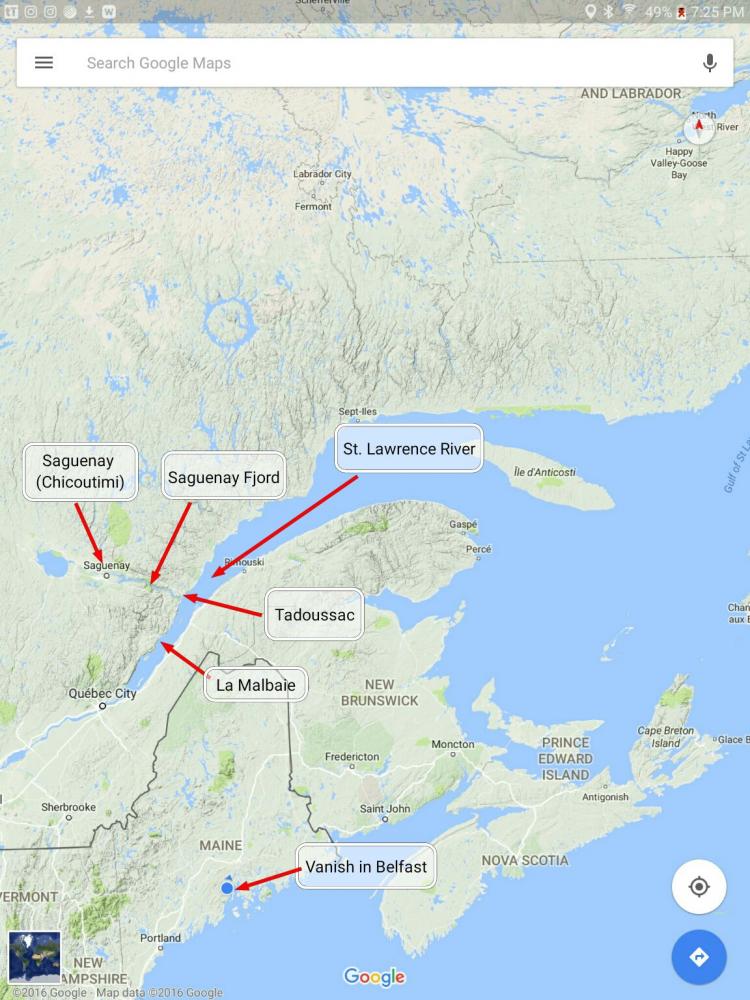
Tadoussac is a town at the far eastern end of the Saguenay Fjord where it meets the St. Lawrence River. Ferries cross the fjord every 15 minutes, 24 hours a day for free. We had been driving along in hot weather on Highway 172 which follows a valley with a beautiful trout river. Occasionally we would see people standing in the stream fishing for trout. The mountains were high and lined with pine trees with virtually no habitation until we found ourselves in Tadoussac heading downhill onto the ferry. We couldn’t understand any of the signs on the roadway or overhead as it is a strictly French in these parts.
We waited about 5 minutes and were then guided onto the ferry but had no idea of our destination due to the fog. The 7 kn current was absolutely vicious as there is an incredible change in depth from 156 meters in the fjord rising to a bank just a few meters deep outside the fjord before plunging down to 316 meters in the St. Lawrence. Also, because water at the bottom of the fjord rises to the top of the bank, the water temperature was only 5 deg C. We could make out a couple of yachts hurtling down current into a fog bank towards the east. There are many warnings on the navigational charts in this area. It is such a wild area and wonderful to see. Around 1,000 beluga whales live in the St. Lawrence River so whale watching is a huge tourist attraction in Tadoussac.
After our ferry ride we stopped for lunch at a roadside picnic bench overlooking the St. Lawrence where we could see unusual fog patterns rising from the river. We both sat on one side of the bench which normally is not an issue, however, this picnic bench was completely unbalanced and sent us tumbling backwards before Maynard somehow leant forward and saved us from having this huge heavy table on top of us. Everything on the table slid off and something hit me in the eye. I now have a very nice black eye. My phone also hit the tarmac and shattered. It would have made a great photo for my blog!
We spent a night at the Fairmont Manoir Richelieu in La Malbaie which is right on the river. It looked very nice but was our least favourite hotel. With such perfect weather it was very hard to imagine that this massive river freezes over in winter. Our next stop is Sherbrooke, Quebec before we attempt the border crossing back to the US. We need to get back to the boat yard to oversee the work being done on Vanish. But what happens if they don’t let us back in???
(Check out more photos by clicking on Gallery above. Go to Where Are We Going?)
Our hotel room overlooked the beautiful Saguenay River and fjord which we only learned was in existence when doing a tiny bit of research on where to head next from Quebec City. The Saguenay Fjord is 65 miles in length with a width of between 1 and 2.5 miles. It has an average depth of 690 feet. The cliffs above the fjord rise to 1,150 feet but average out at 500 feet. It is the fourth largest fjord in the world and yet I have not spoken to anyone who has heard of it. We drove to one of the town’s well-known attractions, Le Petite Maison Blanche, (the Little White House) the only house left standing after a dam burst, located about 150 meters away, sweeping away 488 homes after 2.4 m (8 ft) of rain fell over two days in July, 1996. The rainfall accumulated to the equivalent of the volume of water that tumbles over Niagara Falls in 4 weeks. We could see foundations of the missing homes nearby. The Little White House stands as a symbol of resilience against adversity. By searching You Tube, you can see live footage of the event.
We took an afternoon cruise on the fjord leaving from Parc National du Saguenay from Rivière-Éternité on a picture perfect day. The fjord was truly spectacular with the expanse of water and the high cliffs. A number of sailing yachts were cruising up and down the fjord as well. We wished we could have stayed longer but all hotels were fully booked so we threw a dart at the map and decided to go to La Malbaie via Tadoussac.

Tadoussac is a town at the far eastern end of the Saguenay Fjord where it meets the St. Lawrence River. Ferries cross the fjord every 15 minutes, 24 hours a day for free. We had been driving along in hot weather on Highway 172 which follows a valley with a beautiful trout river. Occasionally we would see people standing in the stream fishing for trout. The mountains were high and lined with pine trees with virtually no habitation until we found ourselves in Tadoussac heading downhill onto the ferry. We couldn’t understand any of the signs on the roadway or overhead as it is a strictly French in these parts.
We waited about 5 minutes and were then guided onto the ferry but had no idea of our destination due to the fog. The 7 kn current was absolutely vicious as there is an incredible change in depth from 156 meters in the fjord rising to a bank just a few meters deep outside the fjord before plunging down to 316 meters in the St. Lawrence. Also, because water at the bottom of the fjord rises to the top of the bank, the water temperature was only 5 deg C. We could make out a couple of yachts hurtling down current into a fog bank towards the east. There are many warnings on the navigational charts in this area. It is such a wild area and wonderful to see. Around 1,000 beluga whales live in the St. Lawrence River so whale watching is a huge tourist attraction in Tadoussac.
After our ferry ride we stopped for lunch at a roadside picnic bench overlooking the St. Lawrence where we could see unusual fog patterns rising from the river. We both sat on one side of the bench which normally is not an issue, however, this picnic bench was completely unbalanced and sent us tumbling backwards before Maynard somehow leant forward and saved us from having this huge heavy table on top of us. Everything on the table slid off and something hit me in the eye. I now have a very nice black eye. My phone also hit the tarmac and shattered. It would have made a great photo for my blog!
We spent a night at the Fairmont Manoir Richelieu in La Malbaie which is right on the river. It looked very nice but was our least favourite hotel. With such perfect weather it was very hard to imagine that this massive river freezes over in winter. Our next stop is Sherbrooke, Quebec before we attempt the border crossing back to the US. We need to get back to the boat yard to oversee the work being done on Vanish. But what happens if they don’t let us back in???
(Check out more photos by clicking on Gallery above. Go to Where Are We Going?)
Into The Wild
02 August 2016 | Photo: Quebec City. Current Location: Saguenay, Quebec, Canada
Vicki - Air 27 dec c, Cloud 6/8
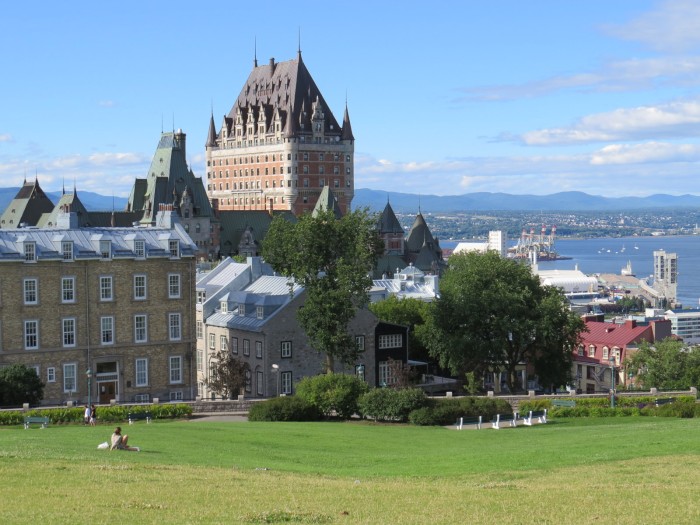
So much has happened since my last blog that I really don't know where to start. Firstly, Vanish is currently on the hard in the Front Street Shipyard at Belfast, Maine having annual maintenance carried out. We were hauled out last year in Belfast so we decided to go back and have another coat of antifouling applied and a few maintenance issues taken care of plus a small modification to our swim platform. We should only be out of the water for a couple of weeks.
Meanwhile, we are ticking a couple of boxes regarding visa renewals by combining a milestone birthday of mine and departing the USA with a trip to Canada. We left Belfast on Saturday 30th and drove 230 miles north through Maine and crossed the border into Canada north of Jackman at the post called Sandy Bay Township. It was a very quiet outpost as there were no other vehicles coming or going across the border when we were there. Our passports were stamped and just like that we were in Canada. We did little preparation for our Canadian trip. In fact, we had no idea where we even wanted to go until I decided I wanted to spend my birthday in Quebec City. We rented a car, threw a few things in a bag, put our hotel address in Google Maps and headed off. We forgot to take a French dictionary, and it became very apparent immediately on crossing the border into Quebec that both of us were struggling to remember our high school French. It was actually quite a shock walking into a pizza restaurant and not being able to read the menu or converse properly. We have visited France in the past and were mentally prepared for the language difference, however, Maine is very American yet borders Quebec which is definitely French. The Quebecers are, let's say, over-zealous with road signs and a great deal of them seem to have no obvious meaning at all (see attached photos). The northern part of Maine seemed economically challenged but once on Quebec soil, the roads, farms, towns and houses looked incredibly prosperous and reminded us of home in Australia.
We drove on until we arrived at our beautiful hotel in downtown Quebec City, threw our bags into our room then walked miles around the old part of the city crowded with people strolling along the streets and people dining at the many sidewalk cafes and bistros. It felt just like Paris with everyone laughing, drinking, conversing and enjoying the hot summer weather outside. Wine and beer were being consumed at an enormous rate very early in the afternoon so, not wanting to miss out, we landed at the Restaurant Le Grand Café and found a perfect table right on Grande Allee E. The passing parade was enthralling. The Quebecers have two good months a year to enjoy the hot summer weather and this was it. We met a lovely couple Helene and Jean who told us in broken English the sights to see around Quebec City.
The next day Sunday, we visited the Marina du Port de Quebec in Quebec City on the St. Lawrence River where the marina is enclosed by a lock. It appears that the lock is opened around once an hour, most probably just during the 2 months of summer. At that time, all the boats who wish to go sailing leave their berths and wait in line while the ones ahead of them are tied in the lock. The water in the lock is equalized to the St. Lawrence River and the boats then exit and go sailing. Of course, they have to go through the same hour long procedure once they return to the marina.
We visited Canyon Saint-Anne, a spectacular canyon and waterfall 74 meters in height about 40 minutes out of the city. Today we also visited Chute Montmorency, a waterfall 30 meters higher than Niagara Falls yet it is only 15 minutes from Quebec City.
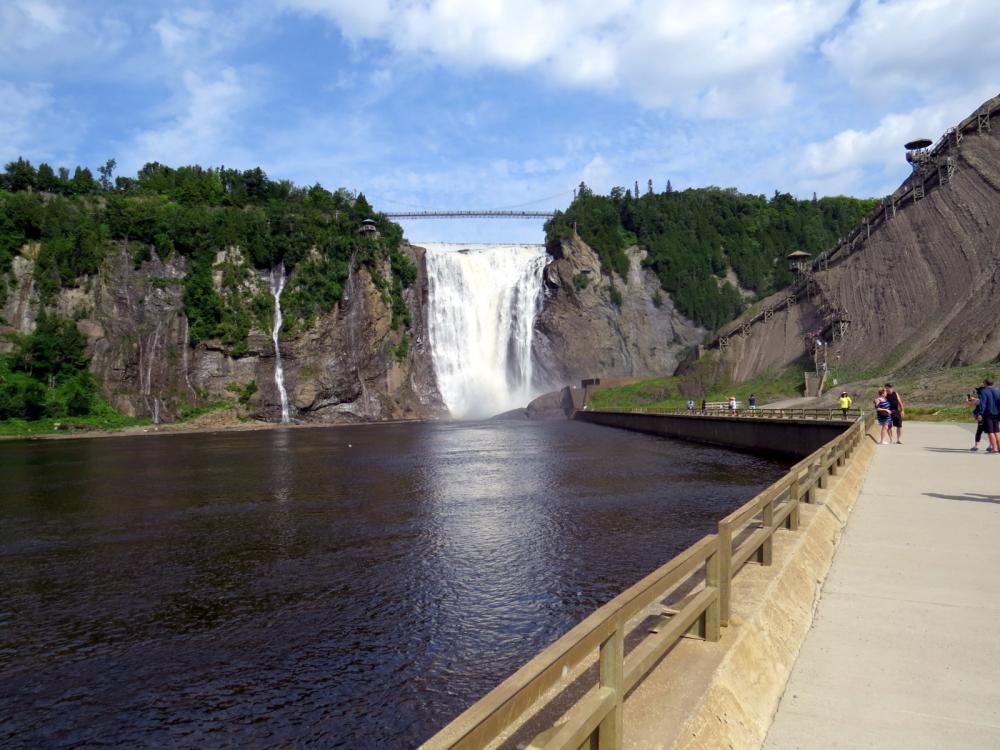
It is 84 meters in height. We rode the cable car to the top of the falls and walked across a footbridge to view the water tumbling over the cliffs with the St. Lawrence River in sight in the distance.
Today we headed north again on Highways 73 and 175, a four-lane perfect highway lined with nothing but magnificent huge Christmas trees so thick that it would be impossible to walk between them. The hills and mountains are covered in these pine trees as far as the eye can see. There are no billboards along the road, no houses, no farms, nothing but trees for most of the 211 km until arriving at the town of Saguenay which has a population of 157,000. Saguenay is at the end of the road. There are roads going east, west and northwest but no roads go due north from the area into the wilderness. There are no human settlements due north of Saguenay all the way to the Canadian Artic islands except for a few isolated Cree and Inuit villages. We are at latitude 48 deg N (the same as Paris) and it is interesting to note that it would have been possible to bring Vanish here had we rounded Nova Scotia and Newfoundland and travelled down the St Lawrence River then up the Saguaney River, a distance of around 1,200 miles. And yes, that's 1,200 miles to return to Maine, then another 1,200 miles to get back to Georgia.
All this just to get our visas renewed!! And why not I say.
Meanwhile, we are ticking a couple of boxes regarding visa renewals by combining a milestone birthday of mine and departing the USA with a trip to Canada. We left Belfast on Saturday 30th and drove 230 miles north through Maine and crossed the border into Canada north of Jackman at the post called Sandy Bay Township. It was a very quiet outpost as there were no other vehicles coming or going across the border when we were there. Our passports were stamped and just like that we were in Canada. We did little preparation for our Canadian trip. In fact, we had no idea where we even wanted to go until I decided I wanted to spend my birthday in Quebec City. We rented a car, threw a few things in a bag, put our hotel address in Google Maps and headed off. We forgot to take a French dictionary, and it became very apparent immediately on crossing the border into Quebec that both of us were struggling to remember our high school French. It was actually quite a shock walking into a pizza restaurant and not being able to read the menu or converse properly. We have visited France in the past and were mentally prepared for the language difference, however, Maine is very American yet borders Quebec which is definitely French. The Quebecers are, let's say, over-zealous with road signs and a great deal of them seem to have no obvious meaning at all (see attached photos). The northern part of Maine seemed economically challenged but once on Quebec soil, the roads, farms, towns and houses looked incredibly prosperous and reminded us of home in Australia.
We drove on until we arrived at our beautiful hotel in downtown Quebec City, threw our bags into our room then walked miles around the old part of the city crowded with people strolling along the streets and people dining at the many sidewalk cafes and bistros. It felt just like Paris with everyone laughing, drinking, conversing and enjoying the hot summer weather outside. Wine and beer were being consumed at an enormous rate very early in the afternoon so, not wanting to miss out, we landed at the Restaurant Le Grand Café and found a perfect table right on Grande Allee E. The passing parade was enthralling. The Quebecers have two good months a year to enjoy the hot summer weather and this was it. We met a lovely couple Helene and Jean who told us in broken English the sights to see around Quebec City.
The next day Sunday, we visited the Marina du Port de Quebec in Quebec City on the St. Lawrence River where the marina is enclosed by a lock. It appears that the lock is opened around once an hour, most probably just during the 2 months of summer. At that time, all the boats who wish to go sailing leave their berths and wait in line while the ones ahead of them are tied in the lock. The water in the lock is equalized to the St. Lawrence River and the boats then exit and go sailing. Of course, they have to go through the same hour long procedure once they return to the marina.
We visited Canyon Saint-Anne, a spectacular canyon and waterfall 74 meters in height about 40 minutes out of the city. Today we also visited Chute Montmorency, a waterfall 30 meters higher than Niagara Falls yet it is only 15 minutes from Quebec City.
It is 84 meters in height. We rode the cable car to the top of the falls and walked across a footbridge to view the water tumbling over the cliffs with the St. Lawrence River in sight in the distance.
Today we headed north again on Highways 73 and 175, a four-lane perfect highway lined with nothing but magnificent huge Christmas trees so thick that it would be impossible to walk between them. The hills and mountains are covered in these pine trees as far as the eye can see. There are no billboards along the road, no houses, no farms, nothing but trees for most of the 211 km until arriving at the town of Saguenay which has a population of 157,000. Saguenay is at the end of the road. There are roads going east, west and northwest but no roads go due north from the area into the wilderness. There are no human settlements due north of Saguenay all the way to the Canadian Artic islands except for a few isolated Cree and Inuit villages. We are at latitude 48 deg N (the same as Paris) and it is interesting to note that it would have been possible to bring Vanish here had we rounded Nova Scotia and Newfoundland and travelled down the St Lawrence River then up the Saguaney River, a distance of around 1,200 miles. And yes, that's 1,200 miles to return to Maine, then another 1,200 miles to get back to Georgia.
All this just to get our visas renewed!! And why not I say.
Snagged
21 July 2016 | Mackerel Bay, Swan’s Island, Maine, USA
Vicki – Air 19 deg c, Water 14 deg c, Cloud 6/8, Wind 15 kn SW, Storms tomorrow.
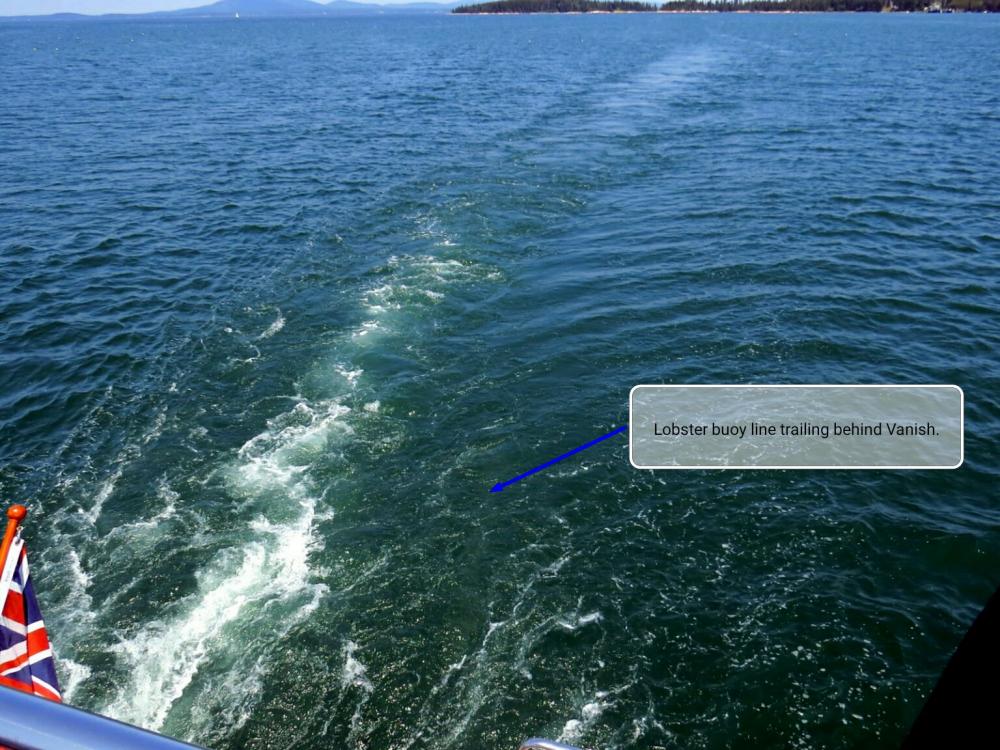
I always wondered what would happen if we snagged a lobster buoy. In three seasons, we've skillfully dodged and weaved around the 3 million lobster buoys in Maine which bob up and down in the waves in sunshine, cloud, fog, wind, whitecaps and rain. I've written about these pesky little bits of styrofoam many times as they are gorgeous but insidious little devils. We've weaved around lobster buoys that suddenly fly away (seagulls) and lobster buoys that have grown whiskers and suddenly dive (seals). We dodge the black and white lobster buoys that have bright red legs (guillemots) while trying to motor down the German Road, the French Road, the Fairy Floss Pink Buoy road or whatever colour road the lobstermen have painted their buoys. We talk about them nonstop on every passage as I am sure everyone else does too. Vanish has a 21 foot beam so we are always trying not to end up in a dead end down one of these 'lobster roads' especially when the lobstermen have carpet bombed a particular area. They will normally drop 5 to 8 buoys of a similar colour in a line (which we call a road) but the problem is that 20 lobstermen have their own crisscrossed roads as well. Then there is the added problem that some of the lobster buoys are tied too short to the lobster traps and lurk just beneath the surface and then there is the ever present toggles which are joined to the buoys with another line. We've dodged them all. It's the one that we didn't see at all which grabbed us.
We were looking for the perfect place to anchor at the time in a small bay. We felt a shudder on the port side prop and realized we must have hooked a buoy. We immediately put the port side engine into neutral and when Maynard walked onto the swim platform, he saw a long length of rope trailing from underneath the boat.
We were already close to where we wanted to anchor so we dropped the anchor in a buoy free area. We couldn't dig the anchor in as that would mean going in reverse and the line could easily have fouled our starboard prop. We didn't want to make matters worse. We let the wind pull Vanish back on the anchor. Oh dear. What do we do now? The surface water temperature is 13.8 deg c but below the surface, it is probably 10 deg c. Although Maynard has years of surfing and windsurfing in his background, I wasn't comfortable with him getting in such frigid water so I busied myself finding phone numbers on the internet for various dive services in the area. Meanwhile he had donned his wetsuit so I put down my ePad and grabbed various knives and the boat hook. There's nothing creepier than getting into freezing water with low visibility and going under an 82 foot boat! If you read my last blog, Eleanor Roosevelt's words were ringing loud and clear, "You must do the things you think you cannot do." Was she talking to school children at the time or the elderly like us? The visibility was 3 feet so Maynard had to virtually put his face next to the prop to see the length of rope. The rope was securely around the prop. So what's the plan man?
He went back in the water and as I guided the boat hook from above, he hooked the rope and we dragged it onto the boat and tied it to a forward stanchion to keep it away from the starboard prop. The line was wrapped around the forward spindle on the prop. It could not be pulled free. At least we could now motor over to Buck's Harbor or South West Harbor to get a diver to help us now. But no, let's be independent and see if we can fix this ourselves. I turned on the port engine and at Maynard's instruction, gave a quick jab in reverse to see what would happen. The line tightened considerably. Now jab it into forward. Ready. Set. Go. My jaw dropped as Maynard reeled in the 40ft piece of line with a chopped up lobster buoy attached on a 3" metal ring. Oh my goodness. We were free. What a relief. I guess we were lucky this was our first time getting a line around our prop as I am sure there are many stories of similar instances. No matter what we encounter, the trick is not to make the situation cascade into more serious problems. Luckily this one was done and dusted in less than an hour. Now it's time to warm up with a double slug of rum. Doctor's orders.
What Do You Do
19 July 2016 | Rockland, Maine, USA
Vicki - Air 22c, Water 15c, Wind N 13 kn, Cloud 7/8
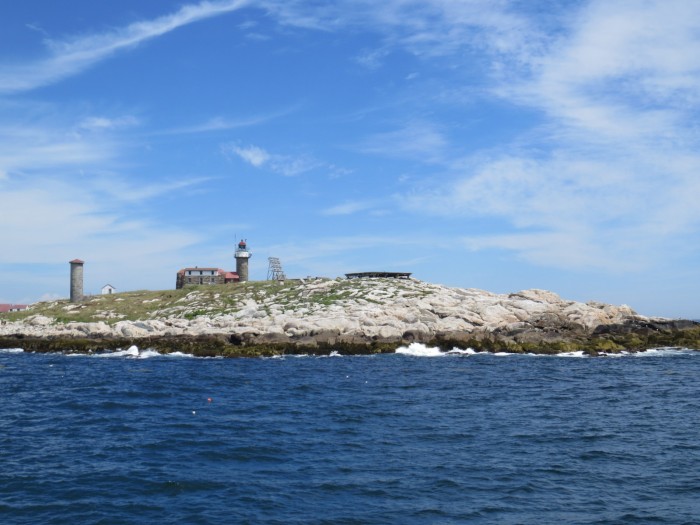
Where does all the time go? Each morning starts with checking the weather. No, not just sitting up in bed and looking out the window, but checking all the various weather apps. Next, turn off the anchor light, turn on the genset, turn on the watermaker and then do all the jobs that need doing while the genset is running. This can be anything from putting the dinghy in the water for shore based fun to vacuuming to washing/drying and dishwasher while Maynard checks the engine room and tends to any loose hose clamps, checks bilges and goes through the day’s maintenance jobs if any. The genset runs approximately two hours each morning and evening and during the day, if the sun is out, the batteries are charged with the solar panels. We have our power consumption down to a fine art. So far this cruising season, we’ve been on the anchor for the last 57 days straight with no time on a dock at all. We provide all our own power and water and are completely comfortable 99.9% of the time. Our objective is usually to find new anchorages and go back to those we love.
Last weekend we took Vanish out to Matinicus Rock, a distance of 25 NM offshore as the forecast was 5 to 10 kn SW and 1 to 2 ft seas although it turned out we experienced higher winds. Matinicus Rock was an ideal place for puffins to breed amongst the rocks and tufts of grass but by 1908 only 1 pair of puffins remained as the rest had been slaughtered for their meat and feathers. We visited Matinicus Rock back in 2012 to see the new colony of puffins and were so impressed that we wanted to see them again this year. There are now over 500 pairs of puffins breeding on the rock every year during the summer months. Matinicus Rock is a very lonely foreboding rock in the middle of the ocean subject to huge swells and the worst of the weather. A lighthouse was built on the rock in 1827 which was built again and again due to it being constantly washed away. A stone lighthouse now exists which has a foghorn and radio beacon.
Back in the middle of the 19th Century, Samuel Burgess and his family were lightkeepers on the Rock. He spent a great deal of his time fishing and counted on his daughter Abbie to tend the light when he was away. Abbie described the great gale of January 19, 1856 in a letter to a friend when she was 17 years old. Her mother was sick and her father had rowed, yes rowed, to the mainland as they were short of food. “Early in the day, as the tide rose, the sea made a complete breach over the rock, washing every movable thing away, and of the old dwelling not one stone was left upon another. The new dwelling was flooded, and the windows had to be secured to prevent the violence of the spray from breaking them in. As the tide came, the sea rose higher and higher, till the only endurable places were the light towers. If they stood we were saved, otherwise our fate was only too certain. But for some reason, I know not why, I had no misgivings, and went on with my work, as usual…
“You know the hens were our only companions. Becoming convinced as the gale increased, that unless they were brought into the house they would be lost, I said to mother, ‘I must try to save them.’ She advised me not to attempt it. The thought, however, of parting with them without an effort was not be be endured, so seizing a basket, I ran out a few yards after the rollers had passed and the sea fell off a little, with the water knee deep, to the coop, and rescued all but one. It was the work of a moment, and I was back in the house with the door fastened, but I was none too quick, for at that instant my little sister, standing at the window, exclaimed, ’Oh look! Look there! The worst sea is coming.’ That wave destroyed the old dwelling and swept the rock. I cannot think you would enjoy remaining there any great length of time, for the sea is never still and when agitated, its roar shuts out every other sound, even drowning our voices.” Abbie’s story is now a wonderful children’s book which I gave to my eldest Granddaughter in 2012, Keep the Lights Burning, Abbie. Again back in 1975 as keepers watched from the light tower, another great wave once again swept across Matinicus Rock which is impressive considering it is 56 feet above sea level.
We circled the island carefully avoiding the many lobster buoys, weird currents and swells pushing us up onto the rocks. We saw puffins, razorbills, guillemots and terns in abundance. We also went to Seal Rock to view puffins. A live camera is set up and can be viewed during daylight hours on the internet. If you google “puffin project webcam” you can also view the puffins. The chart shows a large red circle completely surrounding Seal Rock saying “DANGER AREA” so we didn’t stay long.
So, each day contains a new experience and often a new adventure. Eleanor Roosevelt once said, “You must do the things you think you cannot do.” I’m not sure I can live by her mantra, but I’m sure trying.
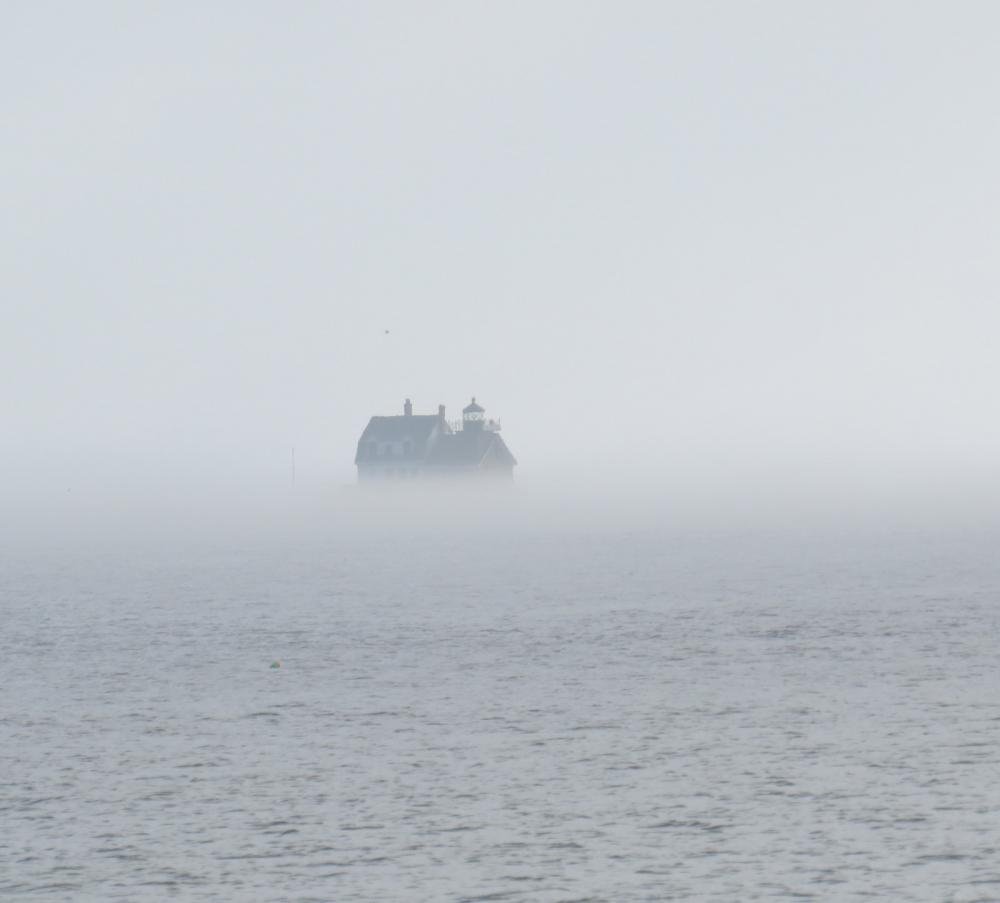
Last weekend we took Vanish out to Matinicus Rock, a distance of 25 NM offshore as the forecast was 5 to 10 kn SW and 1 to 2 ft seas although it turned out we experienced higher winds. Matinicus Rock was an ideal place for puffins to breed amongst the rocks and tufts of grass but by 1908 only 1 pair of puffins remained as the rest had been slaughtered for their meat and feathers. We visited Matinicus Rock back in 2012 to see the new colony of puffins and were so impressed that we wanted to see them again this year. There are now over 500 pairs of puffins breeding on the rock every year during the summer months. Matinicus Rock is a very lonely foreboding rock in the middle of the ocean subject to huge swells and the worst of the weather. A lighthouse was built on the rock in 1827 which was built again and again due to it being constantly washed away. A stone lighthouse now exists which has a foghorn and radio beacon.
Back in the middle of the 19th Century, Samuel Burgess and his family were lightkeepers on the Rock. He spent a great deal of his time fishing and counted on his daughter Abbie to tend the light when he was away. Abbie described the great gale of January 19, 1856 in a letter to a friend when she was 17 years old. Her mother was sick and her father had rowed, yes rowed, to the mainland as they were short of food. “Early in the day, as the tide rose, the sea made a complete breach over the rock, washing every movable thing away, and of the old dwelling not one stone was left upon another. The new dwelling was flooded, and the windows had to be secured to prevent the violence of the spray from breaking them in. As the tide came, the sea rose higher and higher, till the only endurable places were the light towers. If they stood we were saved, otherwise our fate was only too certain. But for some reason, I know not why, I had no misgivings, and went on with my work, as usual…
“You know the hens were our only companions. Becoming convinced as the gale increased, that unless they were brought into the house they would be lost, I said to mother, ‘I must try to save them.’ She advised me not to attempt it. The thought, however, of parting with them without an effort was not be be endured, so seizing a basket, I ran out a few yards after the rollers had passed and the sea fell off a little, with the water knee deep, to the coop, and rescued all but one. It was the work of a moment, and I was back in the house with the door fastened, but I was none too quick, for at that instant my little sister, standing at the window, exclaimed, ’Oh look! Look there! The worst sea is coming.’ That wave destroyed the old dwelling and swept the rock. I cannot think you would enjoy remaining there any great length of time, for the sea is never still and when agitated, its roar shuts out every other sound, even drowning our voices.” Abbie’s story is now a wonderful children’s book which I gave to my eldest Granddaughter in 2012, Keep the Lights Burning, Abbie. Again back in 1975 as keepers watched from the light tower, another great wave once again swept across Matinicus Rock which is impressive considering it is 56 feet above sea level.
We circled the island carefully avoiding the many lobster buoys, weird currents and swells pushing us up onto the rocks. We saw puffins, razorbills, guillemots and terns in abundance. We also went to Seal Rock to view puffins. A live camera is set up and can be viewed during daylight hours on the internet. If you google “puffin project webcam” you can also view the puffins. The chart shows a large red circle completely surrounding Seal Rock saying “DANGER AREA” so we didn’t stay long.
So, each day contains a new experience and often a new adventure. Eleanor Roosevelt once said, “You must do the things you think you cannot do.” I’m not sure I can live by her mantra, but I’m sure trying.
Yuck A Freaking Duck
07 July 2016 | Rockland, Maine, USA
Vicki – Air 11.9 deg c (53 deg f), Dense Fog, Wind 10 kn East, Sea 13 deg c
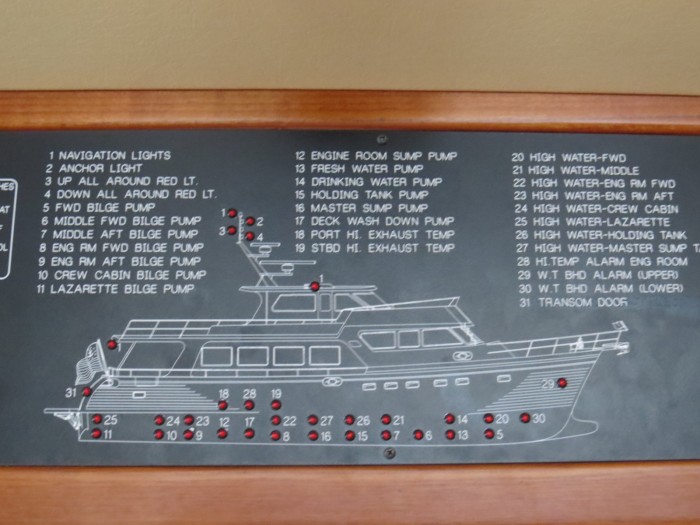
The fog arrived today after many days of hot sunny weather. It's heavy, dense and very wet and it's so cold. It's 53 deg f, which is 11.9 deg c and the wind chill makes it very unsavory. This morning Maynard was up at 5.30 am in order to switch off our anchor light. It was foggy and blowing 18 - 20+ knots from the east instead of the 5 - 10 knots we'd seen in the forecast. Rockland Harbor is exposed to the east so we're usually not here in an easterly particularly in any reinforced wind. However, we have ordered a few things and are just waiting for them to arrive. The first thing he noticed was that the No. 22 light was on up in the bridge. Some lights aren't too critical but No. 22 is the High Water Engine Room Bilge Forward light. What the hey! The alarm hadn't sounded because someone, probably (certainly) me, had cleaned the bridge recently and flicked it off by mistake so we hadn't heard an alarm. Maynard took off down to the engine room at 5.31 am, checked all the bilges and didn't find any water. What a relief. It seems that the moisture from all the fog and humidity must have caused a sensor to go off in the engine room bilge and once he'd found the offender, the light went off again. We never have water in the bilge. It is bone dry and every drop is traced down diligently if it dares to appear.
We are anchored with what looks like a 49ft Marlow called Gale Warning but as yet haven't had a chance to meet them. It's so foggy we can't tell exactly. We last saw them going past us at a distance at Orient, New York a few weeks ago. They too are socked in in the fog probably catching up on many jobs as we are. We also have a 56 meter superyacht nearby but they are hard to see in the fog.
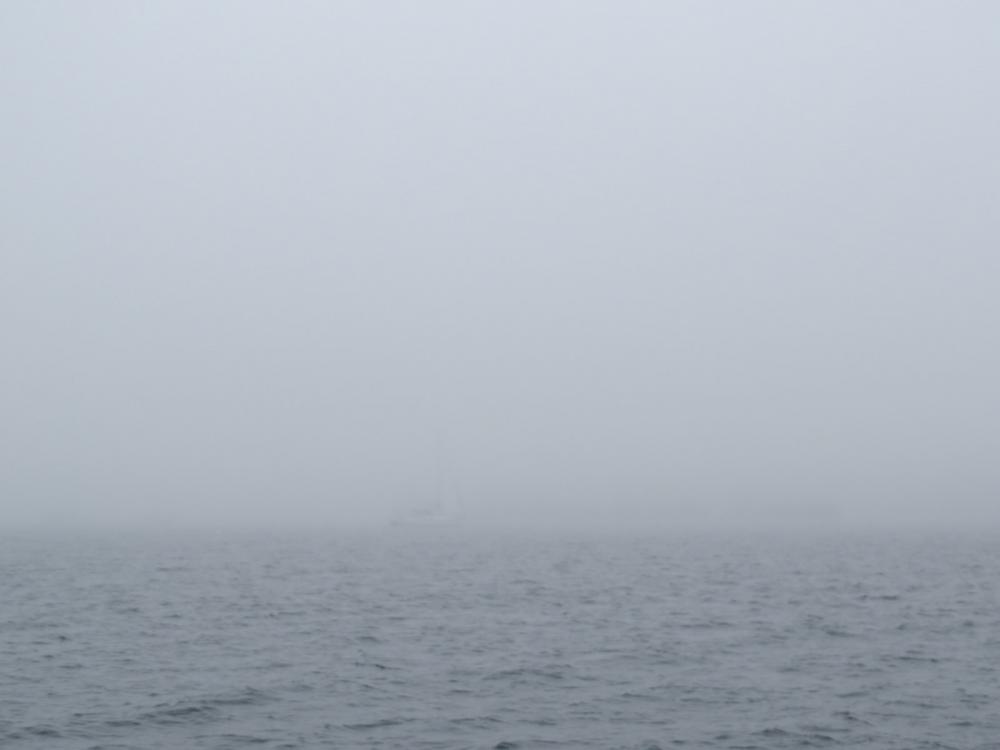
Maynard went to town this afternoon once the wind died down in the general direction of the shore even though he couldn't quite see where he was going. The replacement Raymarine instrument is the ST70+ which displays the depth and speed data throughout the system along with a host of other parameters including sea and air temperature. He installed it this afternoon and we now have all systems running again. It has been a good productive day even though we can't see squat.
(Title of blog compliments of the Captain who took an extremely short walk on deck before scurrying back into the warmth of the salon with the above words.)
We are anchored with what looks like a 49ft Marlow called Gale Warning but as yet haven't had a chance to meet them. It's so foggy we can't tell exactly. We last saw them going past us at a distance at Orient, New York a few weeks ago. They too are socked in in the fog probably catching up on many jobs as we are. We also have a 56 meter superyacht nearby but they are hard to see in the fog.
Maynard went to town this afternoon once the wind died down in the general direction of the shore even though he couldn't quite see where he was going. The replacement Raymarine instrument is the ST70+ which displays the depth and speed data throughout the system along with a host of other parameters including sea and air temperature. He installed it this afternoon and we now have all systems running again. It has been a good productive day even though we can't see squat.
(Title of blog compliments of the Captain who took an extremely short walk on deck before scurrying back into the warmth of the salon with the above words.)
Camden for Fireworks
05 July 2016 | Camden, Maine, USA
Vicki - Air 28c, Water 14.8c, 1/8 Cloud
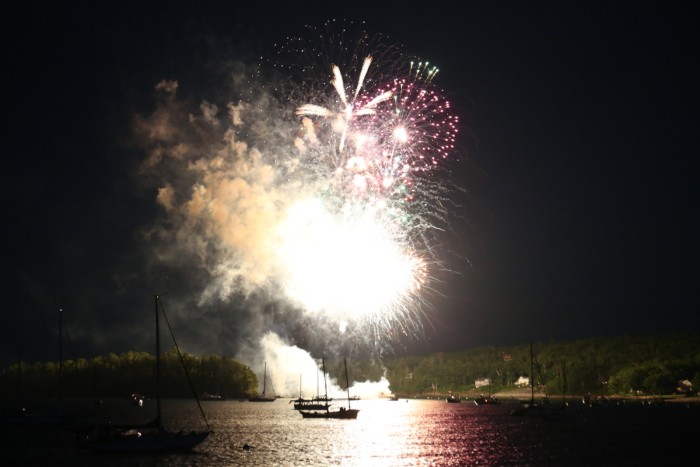
Last year we were in Bar Harbor for 4th July but this year we headed to Camden. It has a very tight inner harbor and an outer harbor with moorings. There is room to anchor for only a couple of yachts. Lyman Morse had a 100ft mooring which we took for the night. Again, the fireworks were lit from a nearby barge so we had a great view. It was a pretty rolly anchorage though even with the light south, south-west breeze and not somewhere to spend a lot of time unless you are onshore. It is certainly a very beautiful town.
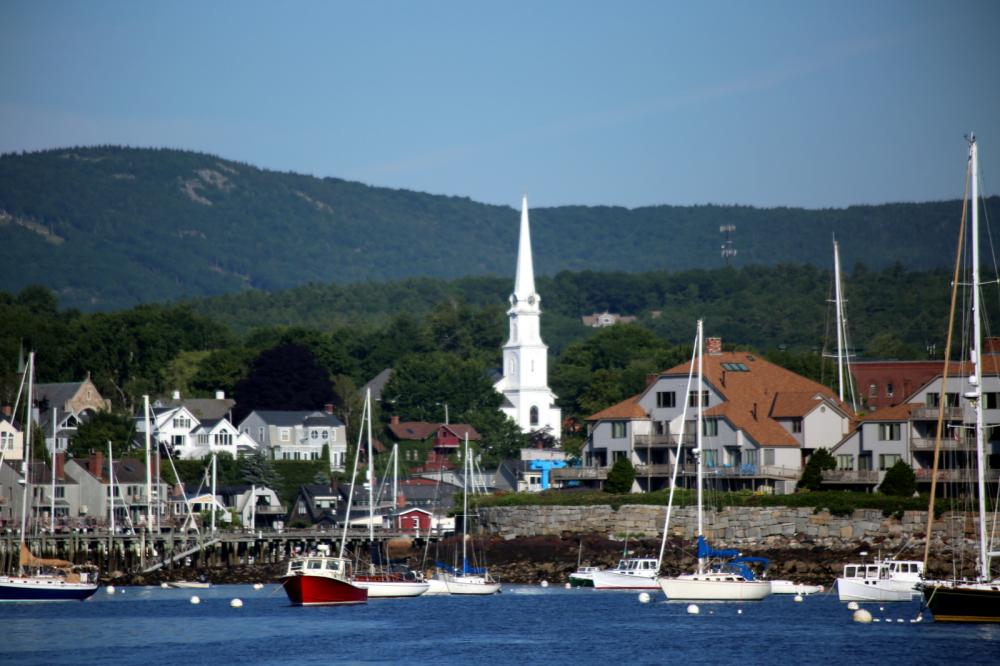
Puffin Away
02 July 2016 | Rockland, Maine, USA
Vicki – Clear Skies, Air – 26c, W 20-25+
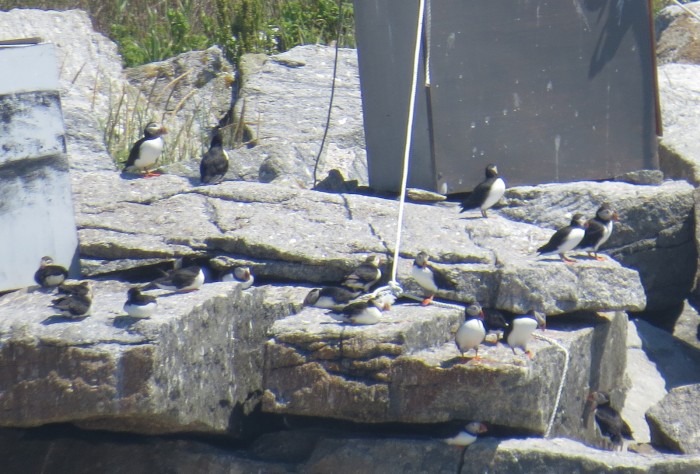
Back in 2012, we visited Matinicus Rock, a distance of 18 miles from Rockland, to view the puffin colony. Every year since then during summer, I often connect to the Live Streaming of puffins on the internet to watch as they rest, eat, and strut around the rocks on Seal Island. Puffins spend most of their time at sea, however for a period of around 8 weeks, they arrive to breed on Eastern Egg Island, Matinicus Rock and Seal Island. Back in 1973 Dr. Stephen Kress from the National Audubon Society started a project to restore puffins on Eastern Egg Rock in Muscongus Bay. As puffins usually return to breed on the same island where they hatch, 954 young pufflings were transplanted from Newfoundland between 1973 and 1986 to Eastern Egg Rock. The transplanted puffins began returning in June 1977.
We left Boothbay in order to go back to Matinicus Rock, however, Eastern Egg Rock was close to our track to Penobscot Bay, so we changed course to see this interesting island. It is quite a small rocky island with a grassy tufted area where the puffin burrows are located. There are a few wooden puffin decoys positioned on the rock ledges to lure puffins to the island and make them feel safe. During the summer months a team of volunteers spend time on the island studying and researching the puffins. At present there are 150 breeding pairs. Being bird enthusiasts, we felt quite privileged to see these rare quirky birds. If you would like to see the puffins live on Seal Rock, go to:
http://explore.org/#!/live-cams/player/puffin-loafing-ledge-cam
During the afternoon, we saw clouds moving in from the west. Maynard put out 70 meters of chain in 7 meters of water as we were the only ones in our part of the anchorage at the time. We don't like worrying about the anchor and like having a lot of swinging room. After sunset, the wind came up to 25 - 30 knots with the approaching storm front. It was accompanied by lightning and very heavy rain which came through in waves from around 10pm to 2am. Five windjammers anchored next to us as but at a good distance. They didn't move and neither did we overnight. The bonus was that we received a lovely free freshwater wash down in the process, a saving for our watermaker.
(For more photos, see Gallery named "Puffin Away"). Link for the Live Streaming of Puffins in the sidebar to the right of this blog.
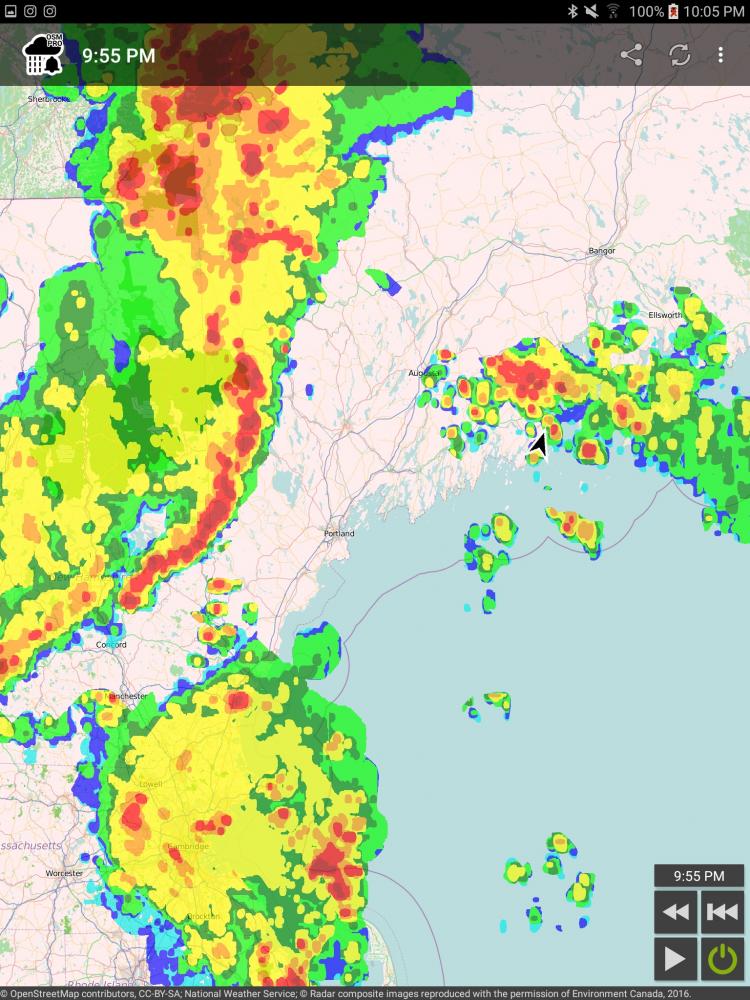
We left Boothbay in order to go back to Matinicus Rock, however, Eastern Egg Rock was close to our track to Penobscot Bay, so we changed course to see this interesting island. It is quite a small rocky island with a grassy tufted area where the puffin burrows are located. There are a few wooden puffin decoys positioned on the rock ledges to lure puffins to the island and make them feel safe. During the summer months a team of volunteers spend time on the island studying and researching the puffins. At present there are 150 breeding pairs. Being bird enthusiasts, we felt quite privileged to see these rare quirky birds. If you would like to see the puffins live on Seal Rock, go to:
http://explore.org/#!/live-cams/player/puffin-loafing-ledge-cam
During the afternoon, we saw clouds moving in from the west. Maynard put out 70 meters of chain in 7 meters of water as we were the only ones in our part of the anchorage at the time. We don't like worrying about the anchor and like having a lot of swinging room. After sunset, the wind came up to 25 - 30 knots with the approaching storm front. It was accompanied by lightning and very heavy rain which came through in waves from around 10pm to 2am. Five windjammers anchored next to us as but at a good distance. They didn't move and neither did we overnight. The bonus was that we received a lovely free freshwater wash down in the process, a saving for our watermaker.
(For more photos, see Gallery named "Puffin Away"). Link for the Live Streaming of Puffins in the sidebar to the right of this blog.

Bang
01 July 2016 | Boothbay, Maine, USA
Vicki – Clear 18c, Wind S, 10kn
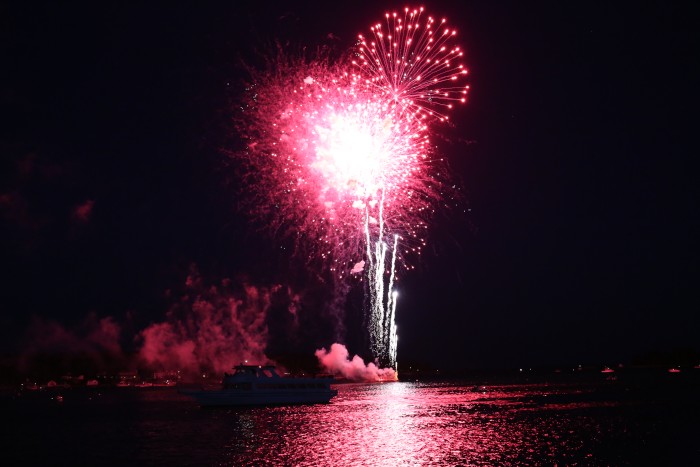
With everyone having so much fun without us, we moved Vanish from Ebenecook Harbour around to Boothbay where the Windjammer Days Festival was in full swing. One of the marina boys told us that there were to be fireworks on Wednesday night. Nothing is better than the smell of fireworks and blowing things up so the anticipation was mounting. This is the first time we’ve anchored in Boothbay as we thought it would be too open to the ocean swells coming in from the south, the predominant wind direction. It also appeared to be extremely busy with vessels coming and going. However, it was perfectly fine and wonderful to see the huge variety of boats in the bay. The next day seven windjammers sailed into the harbor and anchored downtown.
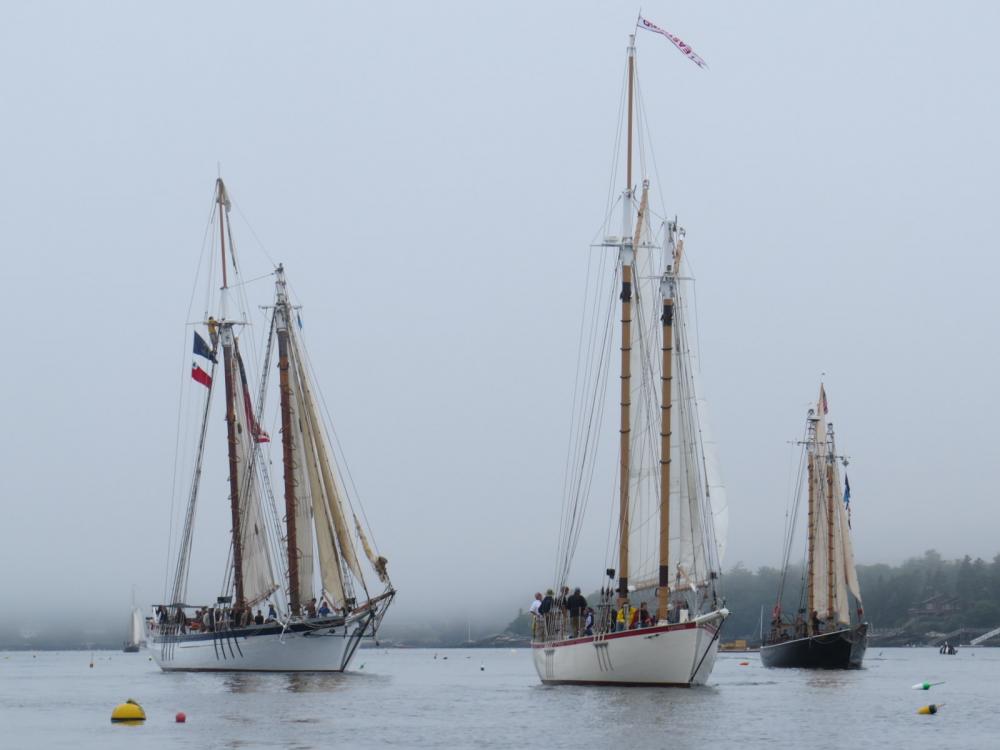
Our AB dinghy has proven itself over and over as a very useful, seaworthy craft with its 40hp Evinrude engine. Whether we are in the midst of lobster boat blessings, windjammers coming into town or heading off in search of blueberry delights, the dinghy is a critical part of our travels. Most towns here have public docks, marinas or restaurants where we can tie up the dinghy for free or a minimal cost.
We were looking forward to the fireworks on Wednesday night at 9.15pm. The day started out foggy and quite cool but cleared again. The fireworks experts worked diligently all day on the nearby barge next to Vanish preparing for the big show. At 9.11pm, the dew point must have reached a critical number as within minutes, fog appeared out of nowhere and we couldn’t see more than 100 feet and just like that, the show was postponed to the following evening. We’d intended leaving the following day but decided to stay which was a great decision as the fireworks were terrific. We turned on all outside lights on Vanish and our colourful underwater lights as we wanted to make sure the dozens of boats buzzing around in the harbor at night could see us. Back in 2012 when we were anchored in The Basin on the New Meadows River, we met a lovely couple on their yacht who kindly gave us their Canadian flag. We were leaving for Canada and didn’t have a flag at that time. That same couple spotted us in Boothbay and dropped by to see us for a very short visit. We are constantly amazed at the friendliness of Maine residents. Last week when we were in Portland, we saw a Parking Ticket Officer tear up a ticket he’d just written as the female offender returned to her vehicle, apparently just in time. That would never ever happen in Australia. They both laughed as if it was pretty normal. We do like this place.
Our AB dinghy has proven itself over and over as a very useful, seaworthy craft with its 40hp Evinrude engine. Whether we are in the midst of lobster boat blessings, windjammers coming into town or heading off in search of blueberry delights, the dinghy is a critical part of our travels. Most towns here have public docks, marinas or restaurants where we can tie up the dinghy for free or a minimal cost.
We were looking forward to the fireworks on Wednesday night at 9.15pm. The day started out foggy and quite cool but cleared again. The fireworks experts worked diligently all day on the nearby barge next to Vanish preparing for the big show. At 9.11pm, the dew point must have reached a critical number as within minutes, fog appeared out of nowhere and we couldn’t see more than 100 feet and just like that, the show was postponed to the following evening. We’d intended leaving the following day but decided to stay which was a great decision as the fireworks were terrific. We turned on all outside lights on Vanish and our colourful underwater lights as we wanted to make sure the dozens of boats buzzing around in the harbor at night could see us. Back in 2012 when we were anchored in The Basin on the New Meadows River, we met a lovely couple on their yacht who kindly gave us their Canadian flag. We were leaving for Canada and didn’t have a flag at that time. That same couple spotted us in Boothbay and dropped by to see us for a very short visit. We are constantly amazed at the friendliness of Maine residents. Last week when we were in Portland, we saw a Parking Ticket Officer tear up a ticket he’d just written as the female offender returned to her vehicle, apparently just in time. That would never ever happen in Australia. They both laughed as if it was pretty normal. We do like this place.
Under Attack
26 June 2016 | Ebenecook Harbour nr Southport, Maine, USA
Vicki – Air 20c, Sea 18c, Clouds 1/8, Wind 10kn S
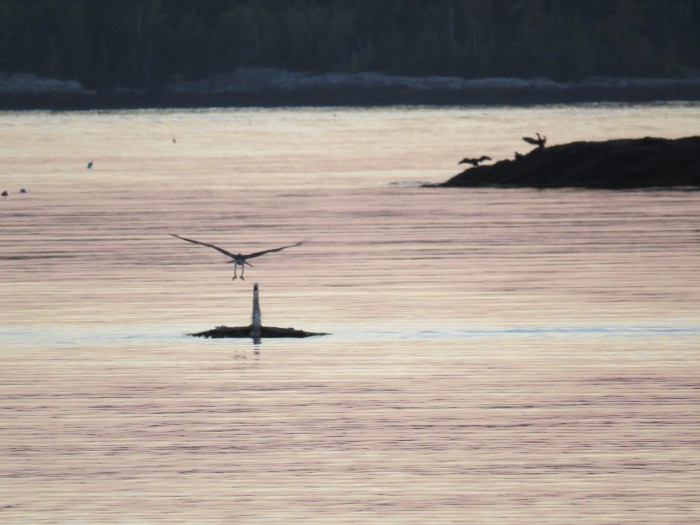
Perhaps I shouldn’t tempt fate but we’ve had an amazing trip so far. Vanish is working like a dream and Maynard and I are very happy that we have the freedom to do as we want without dealing with boat issues. For the last 35 days, we've been travelling and sitting at anchor. We haven't spent time at a marina yet. With only two people on board the demands on Vanish are quite minimal so we’re spending more time than ever doing land based activities. This week we moved from our Snow Island anchorage at Harpswell to Ebenecook Harbour near Southport, ME. After anchoring we whizzed over to Boothbay Harbour 3.5 miles away in our dinghy down Townsend Gut, the thoroughfare between the two bays. We didn’t realise the Windjammer Days Festival was in progress and found ourselves in the middle of the blessing of the lobster fleet. As we zoomed in and out of the 30 or so lobster boats packed with people having loads of fun, I waved at the Catholic priest onshore who kindly blessed us as well.
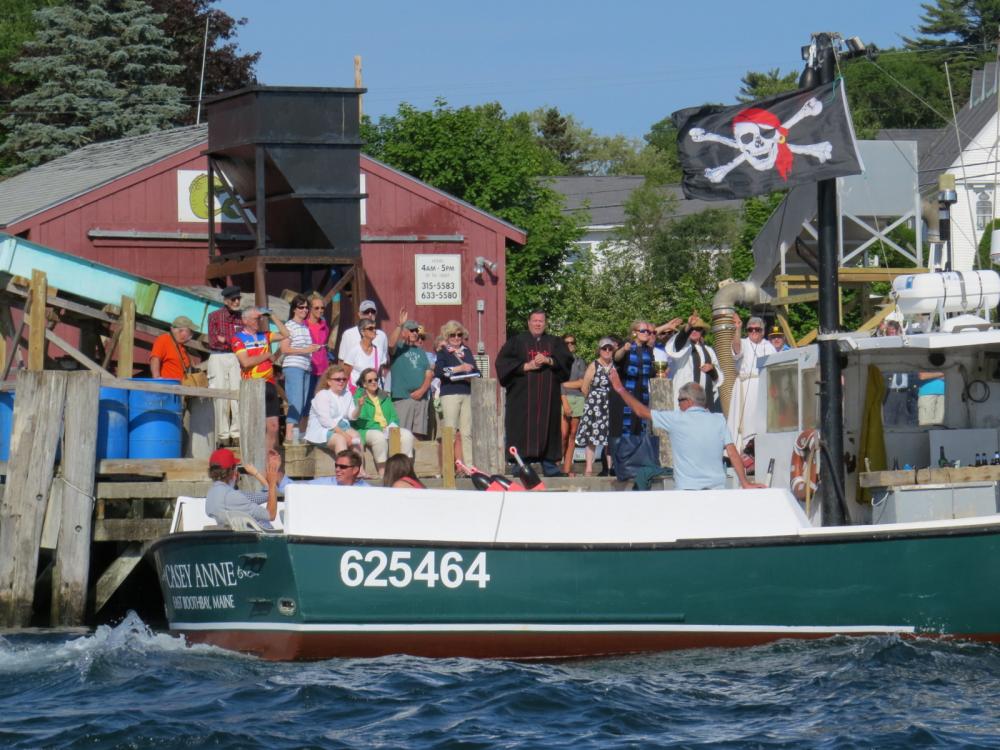
Back on Vanish this evening, we heard extremely unusual sounds of screeching, moaning and trumpeting. In the distance we saw an osprey attacking a sandhill crane in the water. It tried to fly away but the osprey was relentless. A sandhill crane is 47” tall with a very long neck. It is not normally found in Maine. It lifted its wings, it laid its neck along the water and did all it could to survive, screaming and flailing. What a battle. Finally the osprey had taught the crane a lesson on never coming back to Ebenecook Harbor and flew off to a nearby tree. A very lucky day for the crane. There is always something happening out on the water.
I love all comments and appreciate you continuing to read our Vanish blog.
(For more photos, see Album called Under Attack.)
Back on Vanish this evening, we heard extremely unusual sounds of screeching, moaning and trumpeting. In the distance we saw an osprey attacking a sandhill crane in the water. It tried to fly away but the osprey was relentless. A sandhill crane is 47” tall with a very long neck. It is not normally found in Maine. It lifted its wings, it laid its neck along the water and did all it could to survive, screaming and flailing. What a battle. Finally the osprey had taught the crane a lesson on never coming back to Ebenecook Harbor and flew off to a nearby tree. A very lucky day for the crane. There is always something happening out on the water.
I love all comments and appreciate you continuing to read our Vanish blog.
(For more photos, see Album called Under Attack.)
Uh Oh
25 June 2016 | Snow Island, nr Harpswell, Maine, USA
Vicki – Air 18c, Clear Skies, 5 – 10 kn variable wind
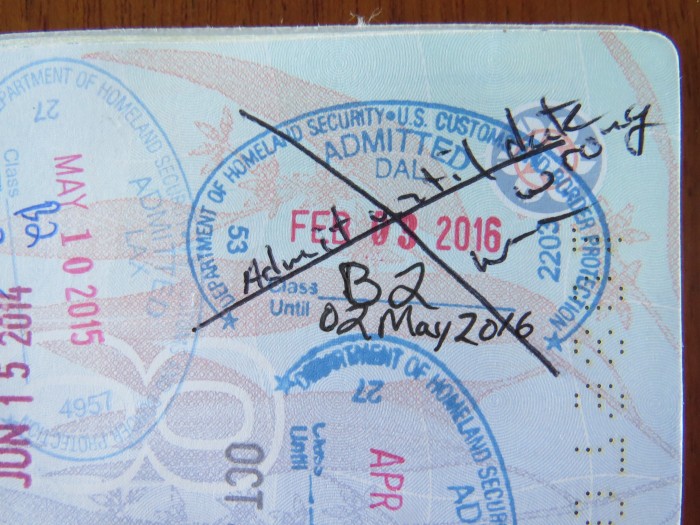
Yesterday started out with such promise. We had a rental car for a couple of days and had taken care of re-provisioning in the nearby town of Brunswick, Maine. After shopping, we drove south to the Dolphin Point Restaurant and Marina which overlooks Potts Harbour and Casco Bay as we had done last year. My heart’s desire was to again experience a blueberry muffin served with my pasta main course, followed by homemade blueberry pie with ice cream.
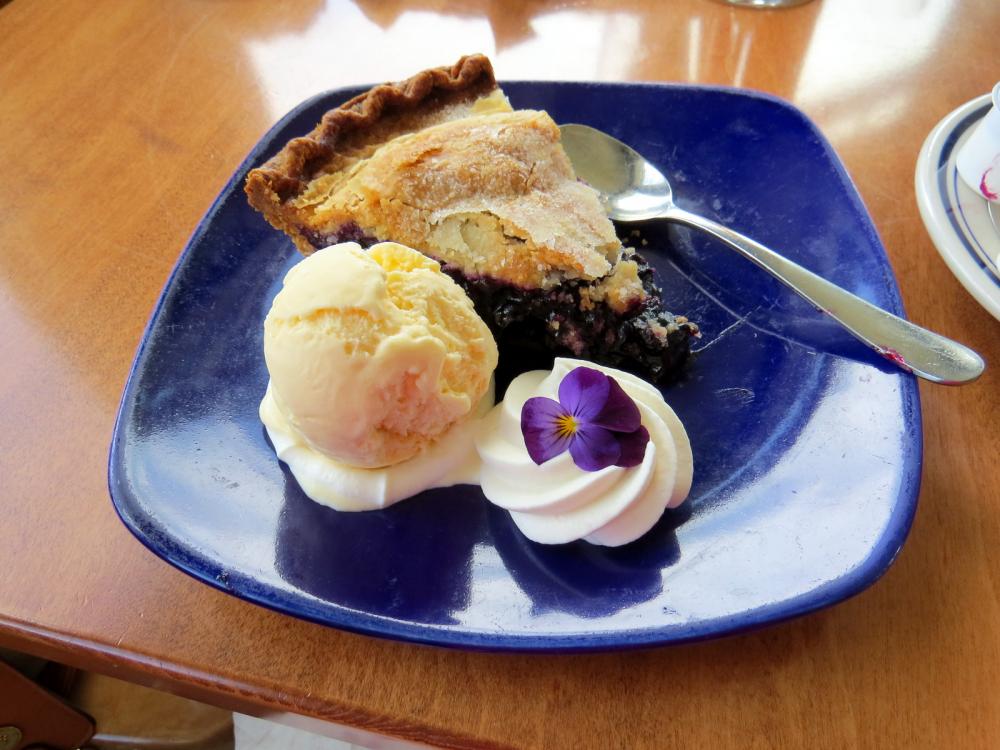
During lunch, the conversation turned towards our visas and the fact that we would soon be nearing the end of our 6 month stay on our current visa. We decided to head back to town, turn in the car and return to Vanish on anchor.
Once back onboard, I casually checked my passport and to my horror, saw that my visa had expired on 2 May, 2016. Considering yesterday was 24th June, 2016, I have been living in the USA as an illegal alien for 50 days. No amount of staring at my passport caused the date to change. Next step. Tell Maynard. His eyes became the size of dinner plates before he searched through HIS passport to find that his expiration date was 2 August, 2016. Somehow, when we arrived in the USA on 2 February, 2016, I was given a 3 month visa and Maynard was given 6 months even though we were both standing next to each other. The Officer just smiled pleasantly as he handed back our passports. He probably even said, “Have a nice day (although I’ve just ruined your life).” I simply assumed I was given 6 months and had never bothered to look at the stamp.
Google is good for everything so we googled what to do in the event of an ‘overstay’ in the USA. Many lawyer ads popped up along with information stating that I had better not try re-entering the USA if I had overstayed my visa. Worse, once I had reached an overstay of 180 days, the penalty would most likely be a ban on re-entering the USA for 3 years and possibly 10 years. The more we read, the worse I felt. What would we do if I was deported? Should we just pick up the anchor and head to Canada, now, this minute? But how would I ever get back into the USA? Should I fly home and Maynard find crew to help him bring Vanish back to Georgia? The possibilities and terror were endless. Picturing myself in handcuffs was too grim to imagine.
As we are honest people, we both thought that the best outcome would be to tell the truth and face the consequences. Perhaps we would get lucky and find a kind soul in Customs and Border Protection (CBP). Huh! It seemed an impossible quandary. We’d turned in the car so again we had to leave Vanish on anchor, get into Brunswick to rent a car again, and then drive down to Portland to face the music. We arrived at 9.30 am after not sleeping a good deal of the night.
It’s a good thing that Google Maps knew how to find the CBP as there was no signage whatsoever on their building, nothing, I mean nothing. We walked into the fortress type building and 3 officers approached us, one of them smiling from ear to ear. Well that’s a good sign. We said we were Australians and the Grinning Man laughed and said, “Well CONGRATULATIONS!” He was turning into my hero there and then. I explained my predicament and they all muttered to each other and nodded then asked us if we carried any weapons such as guns and knives and whether we had any identification on us. Oh, and did we have any bushwhackers on us? He was quite a comedian and put us both at ease. We were then sent through a bomb proof door and waited while my information was ascertained. After another half hour the lead officer advised us that although 2 May, 2016 was written in my passport, he had typed in 2 August, 2016 in the computer. It was just a clerical error. The relief for both of us was enormous, just enormous. Our whole lives were flashing before our faces prior to his explanation and now we could continue on our journey. Whew. That was close. Definitely time for a Bex, a cuppa and a lie down.
During lunch, the conversation turned towards our visas and the fact that we would soon be nearing the end of our 6 month stay on our current visa. We decided to head back to town, turn in the car and return to Vanish on anchor.
Once back onboard, I casually checked my passport and to my horror, saw that my visa had expired on 2 May, 2016. Considering yesterday was 24th June, 2016, I have been living in the USA as an illegal alien for 50 days. No amount of staring at my passport caused the date to change. Next step. Tell Maynard. His eyes became the size of dinner plates before he searched through HIS passport to find that his expiration date was 2 August, 2016. Somehow, when we arrived in the USA on 2 February, 2016, I was given a 3 month visa and Maynard was given 6 months even though we were both standing next to each other. The Officer just smiled pleasantly as he handed back our passports. He probably even said, “Have a nice day (although I’ve just ruined your life).” I simply assumed I was given 6 months and had never bothered to look at the stamp.
Google is good for everything so we googled what to do in the event of an ‘overstay’ in the USA. Many lawyer ads popped up along with information stating that I had better not try re-entering the USA if I had overstayed my visa. Worse, once I had reached an overstay of 180 days, the penalty would most likely be a ban on re-entering the USA for 3 years and possibly 10 years. The more we read, the worse I felt. What would we do if I was deported? Should we just pick up the anchor and head to Canada, now, this minute? But how would I ever get back into the USA? Should I fly home and Maynard find crew to help him bring Vanish back to Georgia? The possibilities and terror were endless. Picturing myself in handcuffs was too grim to imagine.
As we are honest people, we both thought that the best outcome would be to tell the truth and face the consequences. Perhaps we would get lucky and find a kind soul in Customs and Border Protection (CBP). Huh! It seemed an impossible quandary. We’d turned in the car so again we had to leave Vanish on anchor, get into Brunswick to rent a car again, and then drive down to Portland to face the music. We arrived at 9.30 am after not sleeping a good deal of the night.
It’s a good thing that Google Maps knew how to find the CBP as there was no signage whatsoever on their building, nothing, I mean nothing. We walked into the fortress type building and 3 officers approached us, one of them smiling from ear to ear. Well that’s a good sign. We said we were Australians and the Grinning Man laughed and said, “Well CONGRATULATIONS!” He was turning into my hero there and then. I explained my predicament and they all muttered to each other and nodded then asked us if we carried any weapons such as guns and knives and whether we had any identification on us. Oh, and did we have any bushwhackers on us? He was quite a comedian and put us both at ease. We were then sent through a bomb proof door and waited while my information was ascertained. After another half hour the lead officer advised us that although 2 May, 2016 was written in my passport, he had typed in 2 August, 2016 in the computer. It was just a clerical error. The relief for both of us was enormous, just enormous. Our whole lives were flashing before our faces prior to his explanation and now we could continue on our journey. Whew. That was close. Definitely time for a Bex, a cuppa and a lie down.
Don't Fall In
19 June 2016 | Maine, USA
Vicki – Air 18c , Water 15c (57f), Cloud 1/8, Wind 15kn S, Forest Smell
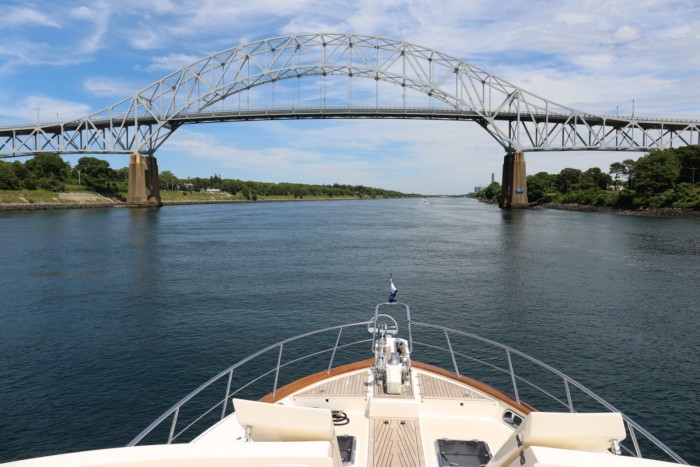
In three and a half weeks we’ve reached our second goal arriving in Maine, a distance of 1,200 miles from Brunswick, Georgia. Our first goal was to see if we could handle Vanish on our own which, so far, has gone very well. Since our last post, we’ve moved 222 miles stopping over at Mattapoisett, Massachusetts before continuing through the Cape Cod Canal the following day. Timing the tide through the canal is important as the tidal range on the western end of the canal is 4 ft yet the range at the eastern end is 9 ft. This equates to a current in the canal that can be up to 6 knots. As all vessels must transit the canal in 2.5 hours under motor, it is critical to work out the optimum time. We went through in 1.5 hours an hour before slack tide with little traffic and lots of photographic opportunities.
Cape Cod Bay on the eastern end was at its very best with no sea or swell. We saw our first seal as the water temperature is now down to 15c deg (57f). In previous seasons we normally follow the coastline northwards stopping at Boston, Massachusetts but the weather was benign with no fog and little wind so we headed out to The Hook of Cape Cod anchoring at Provincetown. The following morning we were up and about in bright light at 4.30am and departed for Maine. Again, the conditions were ideal with oily seas, 3 knots of variable wind and excellent visibility. It was so good in fact that we saw the biggest number of whales we’ve ever seen including humpbacks breaching and possibly Sei and fin whales. Often, we would see a distant spout burst into the air or we would see a fin followed by a breach or the back of a whale diving deep into the ocean. At one stage, I spotted two large fins and as I was interested in finding sunfish sunbathing on the surface, we turned Vanish towards the fins to take a closer look. I ran out on deck with my camera and was shocked to see the biggest great white shark Maynard or I had ever seen. In fact, we’ve never seen a great white shark.
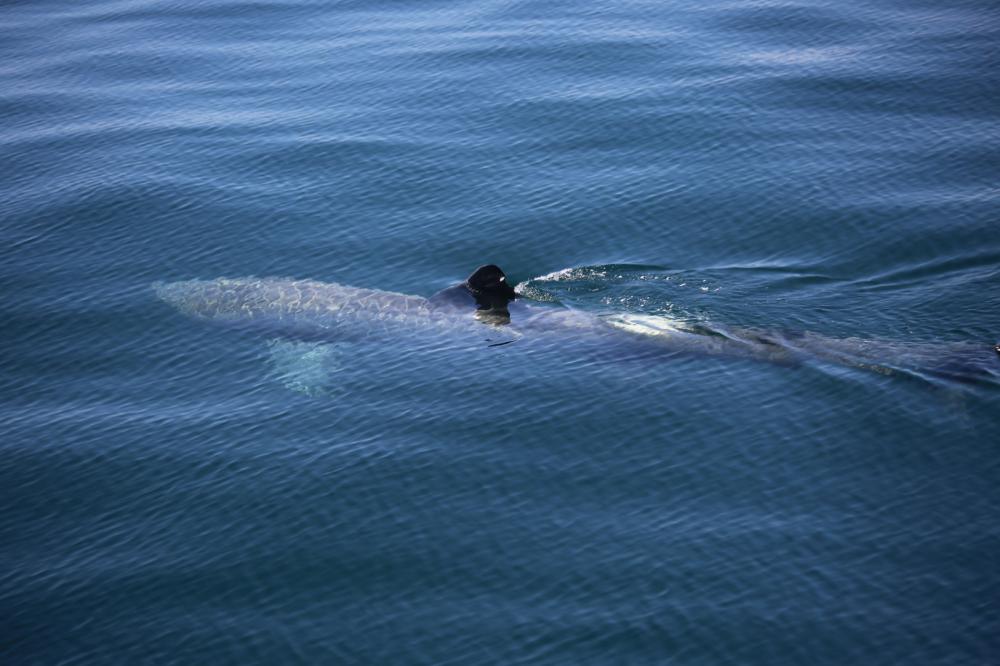
The two fins were its dorsal fin and its tail swishing through the water. We estimated its length to be 20ft. It was a monster. I had to keep telling myself not to fall in or jump overboard by accident. It really gave us the creeps to think of something which could easily swallow us both for morning tea.
Not long after the shark sighting, about a mile further on, we saw a husband and wife sunfish sunning themselves under Cape Cod skies. They apparently spend a great deal of time warming their bodies after diving deep into the ocean where they feed on jellyfish legs and jellyfish gonads. How’s that for an interesting fact! They are also easily spotted on calm days as they lazily flap a fin on the ocean surface. It was the most interesting day for viewing sea life we’d had on any sailing trip.
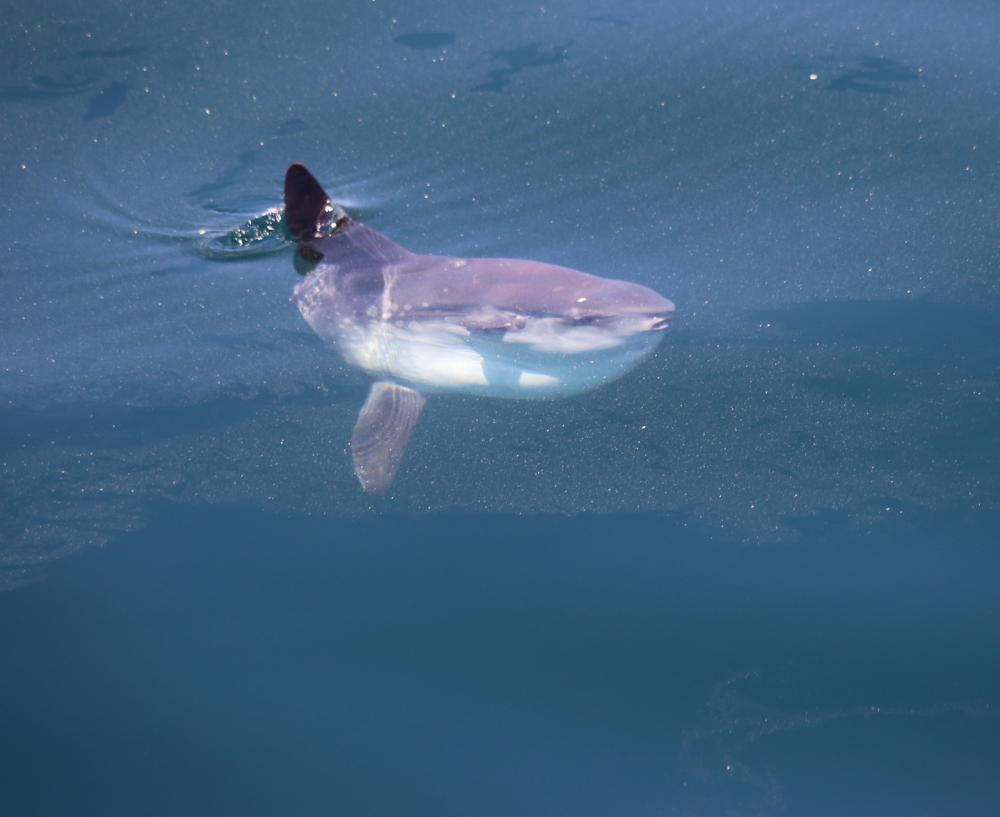
We are now in a different weather zone and hopefully out of reach of gales with any luck during our time here in Maine. Vanish is washed, pollen free and salt free with the only problem being a raw water pump that has failed on the port genset. The Captain is currently buried in the engine room working on replacing the pump, not an easy job. He is an excellent engineer so we are in good hands. All those early years working endlessly on broken down engines on his 1959 MGA, a 1957 VW Bug, a 1960 VW Kombi, and a 1974 Alfa Romeo GTV plus our various sailing vessels have paid dividends in learning to operate Vanish with a fair amount of confidence. There’s one thing about boats and being on the ocean. There is a never ending amount to learn and no shortage of jobs.
For More Photos, Click on Gallery at the top of this page and go to Album named Don't Fall In.
Cape Cod Bay on the eastern end was at its very best with no sea or swell. We saw our first seal as the water temperature is now down to 15c deg (57f). In previous seasons we normally follow the coastline northwards stopping at Boston, Massachusetts but the weather was benign with no fog and little wind so we headed out to The Hook of Cape Cod anchoring at Provincetown. The following morning we were up and about in bright light at 4.30am and departed for Maine. Again, the conditions were ideal with oily seas, 3 knots of variable wind and excellent visibility. It was so good in fact that we saw the biggest number of whales we’ve ever seen including humpbacks breaching and possibly Sei and fin whales. Often, we would see a distant spout burst into the air or we would see a fin followed by a breach or the back of a whale diving deep into the ocean. At one stage, I spotted two large fins and as I was interested in finding sunfish sunbathing on the surface, we turned Vanish towards the fins to take a closer look. I ran out on deck with my camera and was shocked to see the biggest great white shark Maynard or I had ever seen. In fact, we’ve never seen a great white shark.
The two fins were its dorsal fin and its tail swishing through the water. We estimated its length to be 20ft. It was a monster. I had to keep telling myself not to fall in or jump overboard by accident. It really gave us the creeps to think of something which could easily swallow us both for morning tea.
Not long after the shark sighting, about a mile further on, we saw a husband and wife sunfish sunning themselves under Cape Cod skies. They apparently spend a great deal of time warming their bodies after diving deep into the ocean where they feed on jellyfish legs and jellyfish gonads. How’s that for an interesting fact! They are also easily spotted on calm days as they lazily flap a fin on the ocean surface. It was the most interesting day for viewing sea life we’d had on any sailing trip.
We are now in a different weather zone and hopefully out of reach of gales with any luck during our time here in Maine. Vanish is washed, pollen free and salt free with the only problem being a raw water pump that has failed on the port genset. The Captain is currently buried in the engine room working on replacing the pump, not an easy job. He is an excellent engineer so we are in good hands. All those early years working endlessly on broken down engines on his 1959 MGA, a 1957 VW Bug, a 1960 VW Kombi, and a 1974 Alfa Romeo GTV plus our various sailing vessels have paid dividends in learning to operate Vanish with a fair amount of confidence. There’s one thing about boats and being on the ocean. There is a never ending amount to learn and no shortage of jobs.
For More Photos, Click on Gallery at the top of this page and go to Album named Don't Fall In.
Are We At Sea?
16 June 2016 | Cape Cod Bay, Massachusetts, USA
Vicki - 2kn variable winds, Sea 14.7c, Air 22c, Cloud 1/8
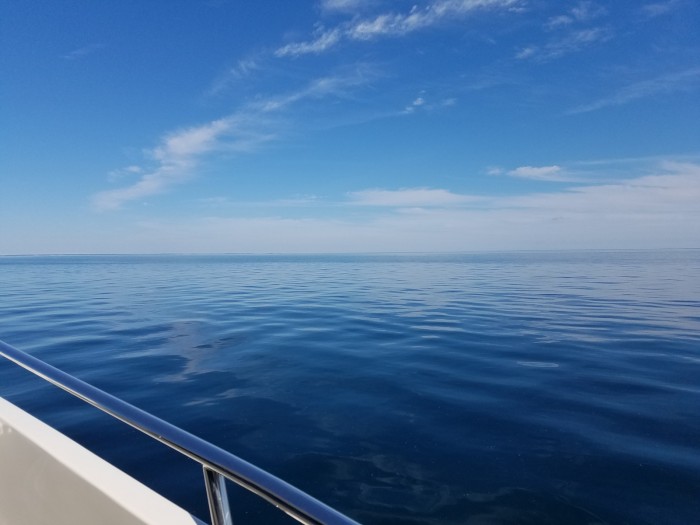
This is the prettiest, flattest sea I think I've ever seen. We are on our way from transitting the Cape Cod Canal to Provincetown located at the tip of Cape Cod.
Sailor's Delight
13 June 2016 | Greenwich Bay, Rhode Island, USA
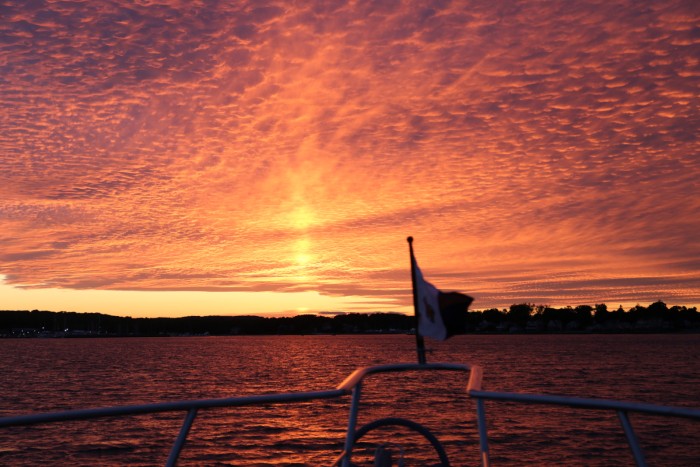
Last night's sunset after yesterday's gale. This morning we went into the East Greenwich Yacht Club to top up our fuel. We were given a good price of $2.35/gal, not as good as Brunswick, GA where we paid $1.91/gal, but a lot better than Shelter Island near Greenport, NY Harbor at $3.43/gal. We hold 4,750 gallons which equates to 4,000 miles at 8 knots and 2,000 miles at 10 knots. As many power boaters have found, fuel is a relatively minor expense and maybe accounts for 15 - 20% of the cost of operating a yacht.
We are off to Prudence Island again in preparation for moving north tomorrow.
We are off to Prudence Island again in preparation for moving north tomorrow.
Another Day, Another Gale
12 June 2016 | Rhode Island, USA
Vicki – 42kn WNW, Air 25c, 3/8 Cloud, Barom 1002 mb

The decision to stay in Narragansett Bay a few days ago has meant that we're now in the middle of our second gale in 4 days. We stayed one night at Prudence Island but didn't sleep too well. Everything was fine until about 1am when the wind changed from a very light southerly to a strong north north-west at 25 knots with higher gusts. We checked our anchor pattern (see below) for a good while as it was pretty obvious that the anchor had dragged but reset itself. Once we were comfortable with the new anchor pattern, we went back to sleep.
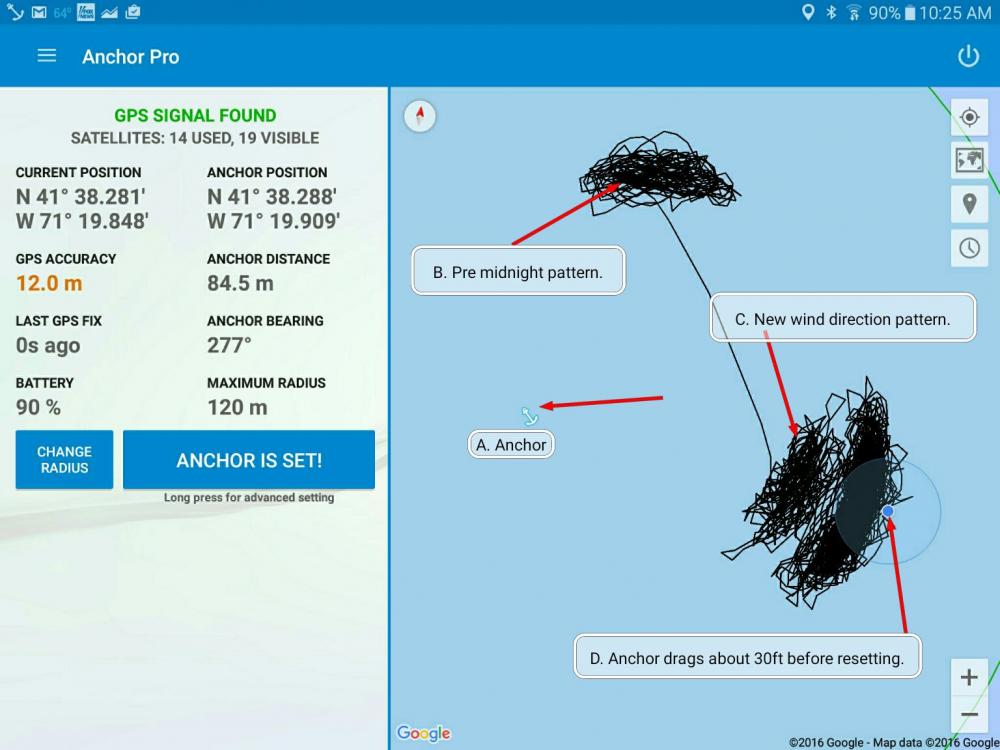
In the morning the wind was down to 10 knots so we grabbed a mooring near the town of Bristol. The next day it blew 30 - 35 knots for most of the day and as you can see below, we repositioned our mooring just a wee bit. We were told that the mooring was good for 100 ton vessels and we are 75 tons. The boat before us had been on the mooring for 3 weeks while it 'blew like stink' we were told.
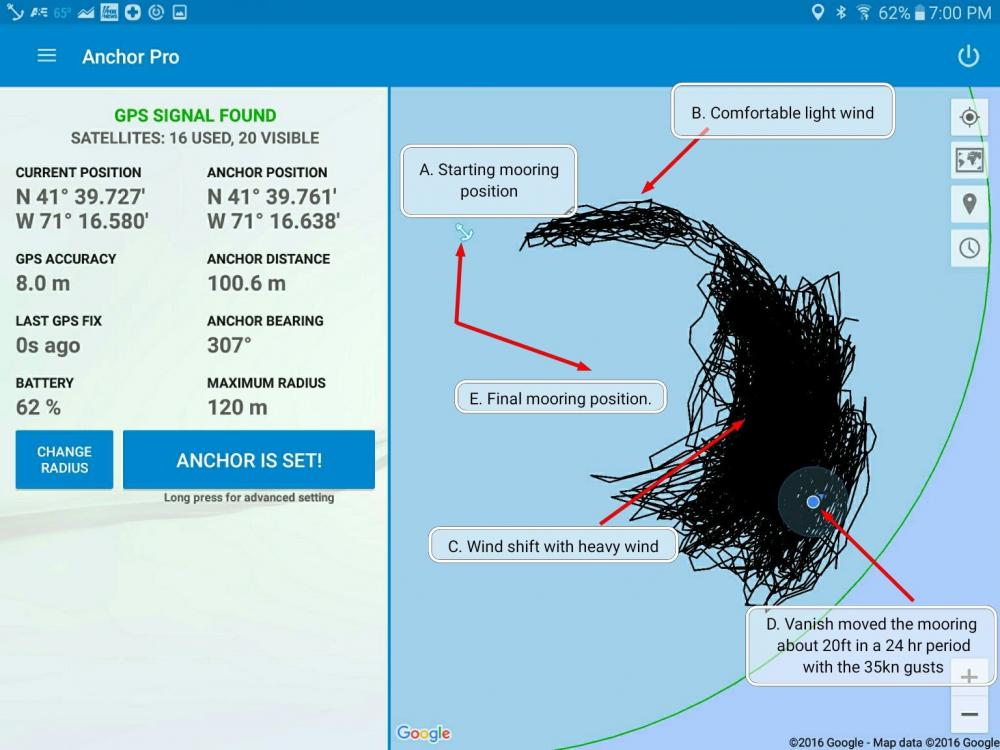
The day after the blow we visited the Herreshoff Maritime Museum in Bristol which is dedicated to the Herreshoff boat building company, yachting and the America's Cup. It was wonderful to see the half size replica of the America's Cup and photographs of all those involved in Australia's win back in 1983.
Anchor patterns tell wonderful stories. I wish I had kept a photographic record of all the amazing patterns we've seen over the years as they are all so different due to wind, tide, drag and snag which occurred once many years ago on a coral bommie in a near gale on the Great Barrier Reef. That particular anchor pattern was a worst nightmare situation as it showed a wind shift where the anchor chain wrapped itself around a coral head. With Maynard's brilliant ingenuity, we unwound ourselves and sailed back to port.
Our second gale is currently going on outside as I write this in Greenwich Bay. We are in a low and the main front is due to pass soon so the wind should die back to only 20 - 25 knots....please be good and do that. The weather report this morning read, Gale Warning, 10 - 15 kn with gusts to 35 kn. Are you kidding? What has happened to these weather reports? They should read 20 - 30 kn with gusts to 35 kn. People were out in pontoon boats, rubber dinghies and kayaks. Did they simply read 10 - 15 kn and stayed with their plans? I had been watching a group of 5 kayakers trying to paddle into 33 kn winds. One tipped over then another and another. We called the Harbormaster on the radio who then brought in two Coast Guard vessels to save them as had been in the 18c water for a long time and had drifted hundreds of meters in the maelstrom. The wind has been 30 to 40 kn with gusts to 51 kn. We heard many rescues on the radio and saw a number of boats being towed back to port. This time our anchor pattern was so steady that we felt we had very good holding even though the water depth is 4 meters. The main bonus is that this gale arrived during the day. It is definitely a much wilder weather year than ever before.
The next gale is due in about 6 days. Where will we ride that one out or can we avoid it?

In the morning the wind was down to 10 knots so we grabbed a mooring near the town of Bristol. The next day it blew 30 - 35 knots for most of the day and as you can see below, we repositioned our mooring just a wee bit. We were told that the mooring was good for 100 ton vessels and we are 75 tons. The boat before us had been on the mooring for 3 weeks while it 'blew like stink' we were told.

The day after the blow we visited the Herreshoff Maritime Museum in Bristol which is dedicated to the Herreshoff boat building company, yachting and the America's Cup. It was wonderful to see the half size replica of the America's Cup and photographs of all those involved in Australia's win back in 1983.
Anchor patterns tell wonderful stories. I wish I had kept a photographic record of all the amazing patterns we've seen over the years as they are all so different due to wind, tide, drag and snag which occurred once many years ago on a coral bommie in a near gale on the Great Barrier Reef. That particular anchor pattern was a worst nightmare situation as it showed a wind shift where the anchor chain wrapped itself around a coral head. With Maynard's brilliant ingenuity, we unwound ourselves and sailed back to port.
Our second gale is currently going on outside as I write this in Greenwich Bay. We are in a low and the main front is due to pass soon so the wind should die back to only 20 - 25 knots....please be good and do that. The weather report this morning read, Gale Warning, 10 - 15 kn with gusts to 35 kn. Are you kidding? What has happened to these weather reports? They should read 20 - 30 kn with gusts to 35 kn. People were out in pontoon boats, rubber dinghies and kayaks. Did they simply read 10 - 15 kn and stayed with their plans? I had been watching a group of 5 kayakers trying to paddle into 33 kn winds. One tipped over then another and another. We called the Harbormaster on the radio who then brought in two Coast Guard vessels to save them as had been in the 18c water for a long time and had drifted hundreds of meters in the maelstrom. The wind has been 30 to 40 kn with gusts to 51 kn. We heard many rescues on the radio and saw a number of boats being towed back to port. This time our anchor pattern was so steady that we felt we had very good holding even though the water depth is 4 meters. The main bonus is that this gale arrived during the day. It is definitely a much wilder weather year than ever before.
The next gale is due in about 6 days. Where will we ride that one out or can we avoid it?
Circumnavigation by Default
08 June 2016 | Prudence Island, Rhode Island, USA
Vicki – Clear, Cirrus Clouds, 22c (72f), Water Temp 18c (64f)
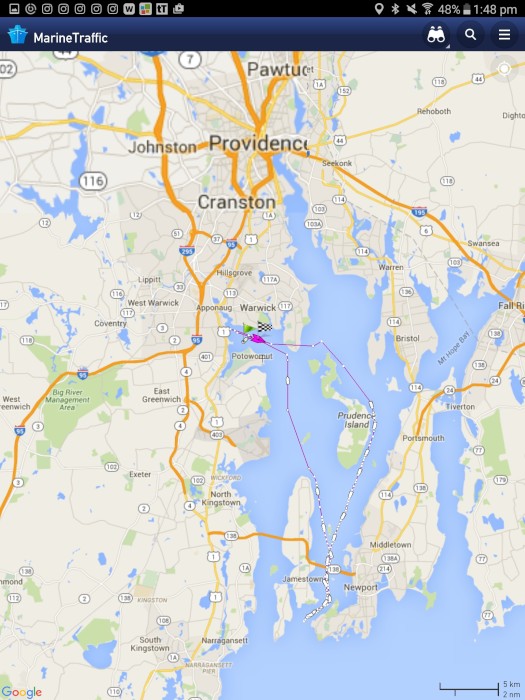
Our new anchor spot at East Greenwich, Rhode Island turned out to be a good one except that we were there on a weekend. One of the nicest changes since we started cruising the USA is that the authorities are extra nice to us. Colin, the Greenwich Bay Harbormaster/Police dropped by to see if we needed anything. The only problem we had was that we had to endure countless boats making the most of the good weather as they roared past us from the nearby marinas. Another lesson learned. Don’t anchor on a lovely day outside a marina. As if that wasn’t bad enough, a drone circled us for around 5 minutes taking photos only 20 feet from the superstructure. Is that legal? Times like those, one would like to take a pot shot. Maybe next time. Be warned if you are reading this. The forecast 20 – 25 knot front approached on Sunday preceded with undulates asperatus clouds which raced across the sky for at least an hour or more. They are uncommon clouds and were only named as a new cloud type in 2009. The rain and fog then moved in but because of the surrounding land protection, we didn’t see any wind stronger than 15 knots.
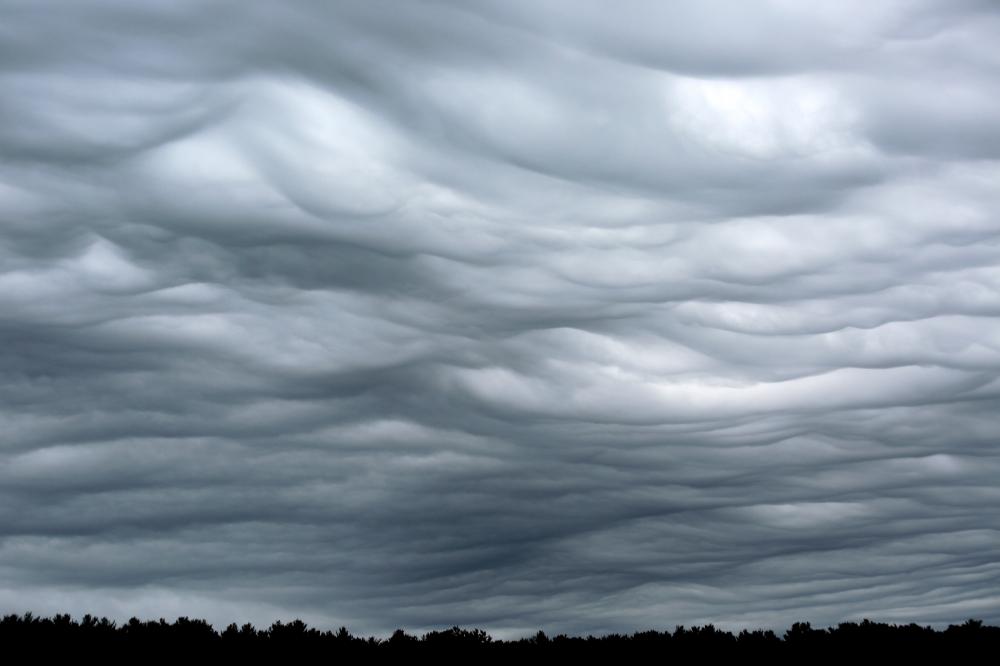
Once again another Tropical Storm was named, this one called Colin. It is the first time three named storms have occurred this early in the season since 1851. Well that’s just great! Hopefully, it will be the last but I won’t hold my breath. So many cruisers have been stuck south of Cape Hatteras by T/S Bonnie and now T/S Colin. If we hadn’t shot north when we did, we might still be looking for a weather window like so many others.
Yesterday we got ourselves together (earlier than normal) and motored out of the Narragansett Bay with the intention of going towards Buzzards Bay. We were so distracted with work issues that Maynard only checked the forecast when we were ready to head out to sea. Does anyone still check our position on Marine Traffic? If so, you would have seen that we did a very mysterious circumnavigation of Narragansett Bay when Maynard proclaimed that he was reading the worst forecast he’d seen since we endured Hurricane Sandy in the Bahamas. There was no question but to turn around and head back up the bay but this time we anchored at Prudence Island which seemed to have very good protection. The forecast on Weather 4D showed a 50 knot nor’easter developing off the coast of Cape Cod in 5 days’ time and would affect the whole region so with our tails between our legs, we anchored again to wait out the latest blow.
Once again another Tropical Storm was named, this one called Colin. It is the first time three named storms have occurred this early in the season since 1851. Well that’s just great! Hopefully, it will be the last but I won’t hold my breath. So many cruisers have been stuck south of Cape Hatteras by T/S Bonnie and now T/S Colin. If we hadn’t shot north when we did, we might still be looking for a weather window like so many others.
Yesterday we got ourselves together (earlier than normal) and motored out of the Narragansett Bay with the intention of going towards Buzzards Bay. We were so distracted with work issues that Maynard only checked the forecast when we were ready to head out to sea. Does anyone still check our position on Marine Traffic? If so, you would have seen that we did a very mysterious circumnavigation of Narragansett Bay when Maynard proclaimed that he was reading the worst forecast he’d seen since we endured Hurricane Sandy in the Bahamas. There was no question but to turn around and head back up the bay but this time we anchored at Prudence Island which seemed to have very good protection. The forecast on Weather 4D showed a 50 knot nor’easter developing off the coast of Cape Cod in 5 days’ time and would affect the whole region so with our tails between our legs, we anchored again to wait out the latest blow.
Learning Curve
03 June 2016 | Noyack Bay, nr Sag Harbor, Long Island, New York, USA
Vicki – 14c (57f), Overcast, Light Drizzle, Fog Patches
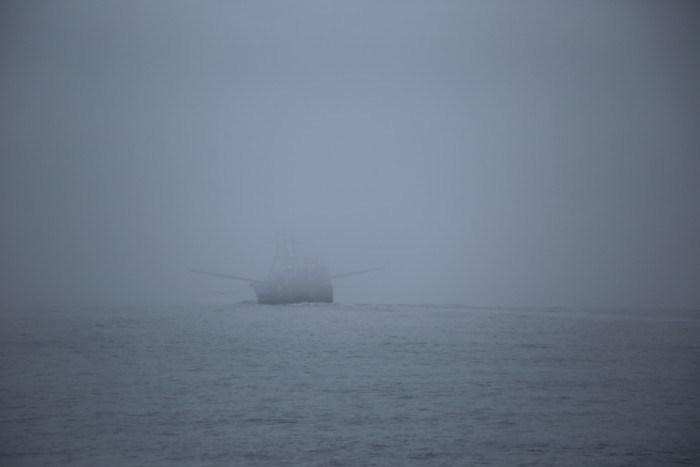
We’re heading out today under cold, overcast skies and drizzle from our quiet anchorage at Noyack Bay. In the distance I can barely see a fishing vessel as it motors into a fog bank on the Block Island Sound. The visibility is around ½ mile which I consider to be excellent when it comes to fog but it’s eerie seeing vessels one minute then next thing, they are gone. It is fairly rare to see fog back home in Australia but after 5 seasons (4 in the USA), we are more used to it. Thank goodness for radar!
We spent time in the quaint towns of Greenport and Sag Harbor in the last couple of days. While having lunch on the beach at Sag Harbor, we thought we saw Vanish motoring into the marina without us! However, it turned out to be another Marlow called Paws For Life which we had seen last year in Belfast, Maine. We briefly said hello from our dinghy but would love to catch up if we see them further north.
The season feels so different already with just Maynard and I. He taught our last couple of crew members how to operate the boat his way and now it’s my turn. When we owned Cruz Control, our Santa Cruz 52 sailing yacht, we worked wordlessly while handling the anchor or deploying the dinghy or raising sails or performing sail changes. We are now getting back to how we were for 15 years on Cruz. Maynard is an excellent teacher so it won’t be long before we are again the two person team that we were. It has taken Maynard a few years to learn what he knows about Vanish so I feel very lucky to be his student. Vanish is 82 feet LOA and Cruz Control was 52 feet but the techniques are basically the same. We each have certain jobs we perform and no doubt will improve upon this season.
Last night we studied our charts and found a new anchorage that we haven’t tried before in Rhode Island which looks very protected for the 25 kn SW-SE weather so this is where we are heading. This morning a tropical system called Invest 93L has formed in the Gulf of Mexico. It looks like we’ll have to keep our heads about us this year so that we’re not involved in any really bad weather. We’ve already experienced much more wind than other years as it seems that fronts are coming through every few days. Hopefully it will calm down soon and summer will begin.
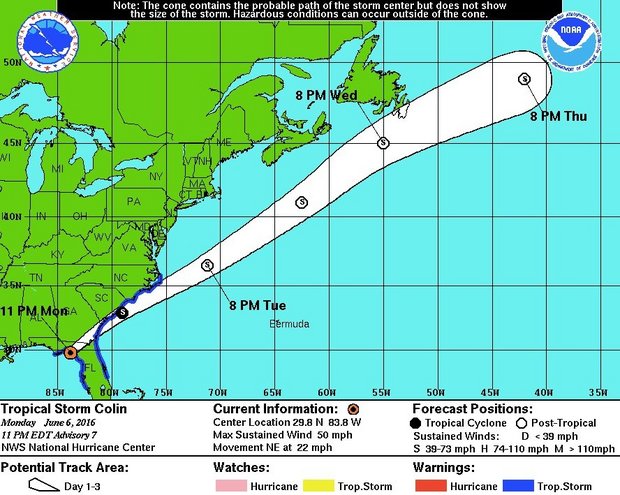
We spent time in the quaint towns of Greenport and Sag Harbor in the last couple of days. While having lunch on the beach at Sag Harbor, we thought we saw Vanish motoring into the marina without us! However, it turned out to be another Marlow called Paws For Life which we had seen last year in Belfast, Maine. We briefly said hello from our dinghy but would love to catch up if we see them further north.
The season feels so different already with just Maynard and I. He taught our last couple of crew members how to operate the boat his way and now it’s my turn. When we owned Cruz Control, our Santa Cruz 52 sailing yacht, we worked wordlessly while handling the anchor or deploying the dinghy or raising sails or performing sail changes. We are now getting back to how we were for 15 years on Cruz. Maynard is an excellent teacher so it won’t be long before we are again the two person team that we were. It has taken Maynard a few years to learn what he knows about Vanish so I feel very lucky to be his student. Vanish is 82 feet LOA and Cruz Control was 52 feet but the techniques are basically the same. We each have certain jobs we perform and no doubt will improve upon this season.
Last night we studied our charts and found a new anchorage that we haven’t tried before in Rhode Island which looks very protected for the 25 kn SW-SE weather so this is where we are heading. This morning a tropical system called Invest 93L has formed in the Gulf of Mexico. It looks like we’ll have to keep our heads about us this year so that we’re not involved in any really bad weather. We’ve already experienced much more wind than other years as it seems that fronts are coming through every few days. Hopefully it will calm down soon and summer will begin.

Bonnie Doom
31 May 2016 | Orient, North Fork, Long Island, New York
Vicki – Temp 20c, Clear, Sea 18c, S wind 8 kn

It didn't take much convincing for us to leave Cape Lookout after seeing the forecast for North Carolina which showed a low forming south of our position. The prediction was that it would probably turn into a hurricane and come into the anchorage. The near term near term forecast north of Cape Lookout was 5 to 10 knots with seas of 1 to 2 feet. How could we resist? We headed out towards the Gulf Stream where the sea temperature went from 21.6c (72f) to 26.6c (81f) and the north flowing current added up to 5.3 knots to our SOG (Speed Over Ground). As the sun set at 8.10pm and the moon rose at midnight, it was very comfortable taking 4 hour watches with so much light. Maynard prefers the 8pm to midnight watch and I enjoy the post-midnight watch so we were immediately comfortable with our sleep patterns. Both of us found we had much to do so the watches flew by in no time. North of Cape Hatteras the Gulf Stream heads away from the US coast so we were about 80 miles offshore which is fine if you don't think about it too much. Invest 91L was now declared Tropical Storm Bonnie and it crossed the coast near Charleston, South Carolina, went inland then north and reformed and spun over Cape Lookout. It must have been looking for us.
During our trip, we saw a pod of minke whales, a Northern right whale and several families of dolphins. Occasionally we would see ships and cruising vessels but mostly it was a very lonely trip. On the second night when I was due to take my midnight watch during the changeover, I could see that the moon was just a small orange sliver. Now that we were back out of the Gulf Stream, the temperature of the water had plummeted to 13.5c (55f). I stuck my head out of the bridge door and saw clouds of mist swirling on the starboard side of the boat. It was as if the heat of the engines on the starboard side were mixing with the cold air and were engulfing us in an eerie fog. Being at sea on dark nights on a large vessel takes a steady mind but for some reason that particular night, the cold water and the mist and darkness made me very uneasy. Maynard immediately said he would do a double watch if I could do the same during daylight which of course I agreed to. It was light again at 4am so I was soon back on deck and Maynard was able to rest easy until 11am.
Off the Long Island coast, we both encountered fishing fleets with dozens of boats moving in completely random patterns. Weaving in and out of these guys took lots of concentration and the shipping lanes leading in and out of New York added a fair amount of excitement. I saw one ship many miles away that was on a collision course for a long time. Maynard was in bed but had always told me to make decisive moves which show the other vessel my intentions. It is often the case that ships are on collision courses ie 500 ft or less CPA (Closest Point of Approach). I like to know well in advance which way they're going and how long to 'impact' so I find their AIS information on the chart plotter and instigate a vector so I can decide whether I need to make any adjustments. At times, it's not for the faint of heart, I can tell you. Even though we've cruised for many years, one has to be fully alert at all times. If I have any doubts, I always call Maynard and this way, he can sleep better. We have so much information at hand these days with radar and AIS that it's much easier than when we sailed across the Pacific in 1998 and stuck our heads out of the cockpit every 15 minutes to see if anyone was around.
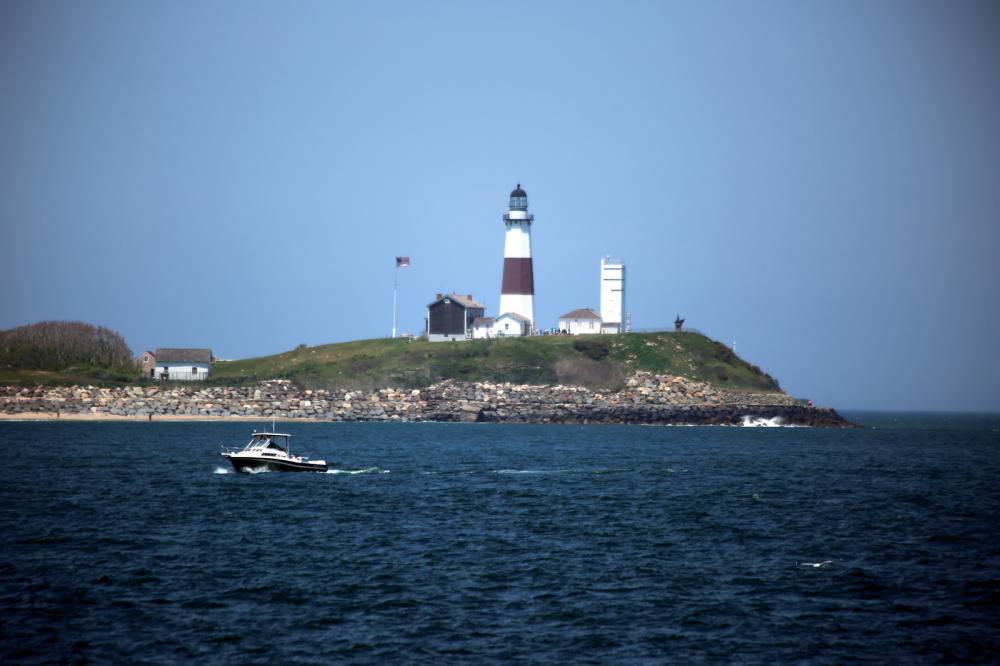
In past seasons we've anchored at Sandy Hook, New Jersey but this means we have to negotiate the Staten Island ferries and mayhem of New York. It was easier this time to stay out to sea aiming for Montauk Point at the far north-eastern end of Long Island. On the afternoon of the third day after going through fog patches, we passed the Montauk Point Light where the wind was funneling at 28 knots. We anchored in a quiet bay south of Montauk near a town called Orient. We'd done it. Bonnie had kicked us out and sent us a long way north. We'd just taken Vanish nearly 1,000 miles, 3 nights and 5 days at sea with 1 stopover by ourselves. It was now time for a few days of rest and reflection.
During our trip, we saw a pod of minke whales, a Northern right whale and several families of dolphins. Occasionally we would see ships and cruising vessels but mostly it was a very lonely trip. On the second night when I was due to take my midnight watch during the changeover, I could see that the moon was just a small orange sliver. Now that we were back out of the Gulf Stream, the temperature of the water had plummeted to 13.5c (55f). I stuck my head out of the bridge door and saw clouds of mist swirling on the starboard side of the boat. It was as if the heat of the engines on the starboard side were mixing with the cold air and were engulfing us in an eerie fog. Being at sea on dark nights on a large vessel takes a steady mind but for some reason that particular night, the cold water and the mist and darkness made me very uneasy. Maynard immediately said he would do a double watch if I could do the same during daylight which of course I agreed to. It was light again at 4am so I was soon back on deck and Maynard was able to rest easy until 11am.
Off the Long Island coast, we both encountered fishing fleets with dozens of boats moving in completely random patterns. Weaving in and out of these guys took lots of concentration and the shipping lanes leading in and out of New York added a fair amount of excitement. I saw one ship many miles away that was on a collision course for a long time. Maynard was in bed but had always told me to make decisive moves which show the other vessel my intentions. It is often the case that ships are on collision courses ie 500 ft or less CPA (Closest Point of Approach). I like to know well in advance which way they're going and how long to 'impact' so I find their AIS information on the chart plotter and instigate a vector so I can decide whether I need to make any adjustments. At times, it's not for the faint of heart, I can tell you. Even though we've cruised for many years, one has to be fully alert at all times. If I have any doubts, I always call Maynard and this way, he can sleep better. We have so much information at hand these days with radar and AIS that it's much easier than when we sailed across the Pacific in 1998 and stuck our heads out of the cockpit every 15 minutes to see if anyone was around.
In past seasons we've anchored at Sandy Hook, New Jersey but this means we have to negotiate the Staten Island ferries and mayhem of New York. It was easier this time to stay out to sea aiming for Montauk Point at the far north-eastern end of Long Island. On the afternoon of the third day after going through fog patches, we passed the Montauk Point Light where the wind was funneling at 28 knots. We anchored in a quiet bay south of Montauk near a town called Orient. We'd done it. Bonnie had kicked us out and sent us a long way north. We'd just taken Vanish nearly 1,000 miles, 3 nights and 5 days at sea with 1 stopover by ourselves. It was now time for a few days of rest and reflection.
Two-Up
26 May 2016 | Cape Lookout, near Beaufort, North Carolina, USA
Vicki - 25 c (77f), 1/8 Cloud. Wind SW 8 knots
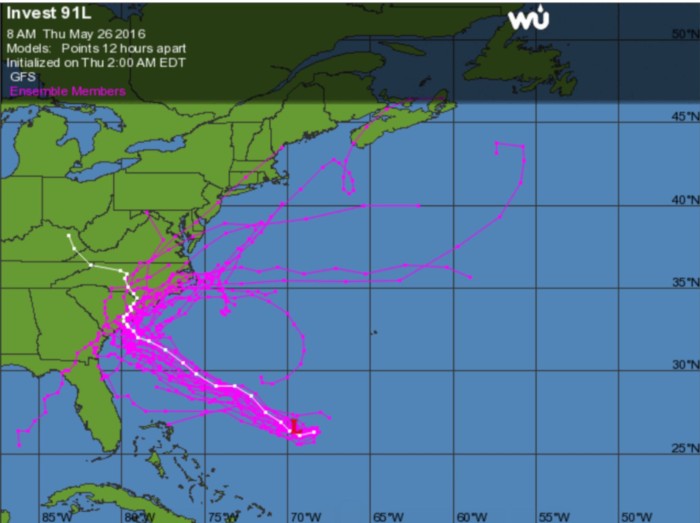
Well we're back folks for another season on Vanish in the USA. This time there is only the two of us, Maynard and myself as Mike left in January to pursue his yachting career down in Florida. As Vanish is located overseas from our home in Australia, we have felt that it was prudent to have crew to look after her full-time. However, we've done a 180 deg on that idea as we've found we can simply get on the phone and find professional help whenever we need it no matter where we are in the US or overseas. In fact, Mike helped prepare Vanish for our departure from Brunswick, Georgia by testing systems, cleaning the boat inside and out, changing the oil, stocking the fridge and doing dozens of other jobs. The last time we were on Vanish was in October last year so it had been a long time since we had seen her. She still looks brand new with her polished stainless, polished hull, antifouling, and new carpet and blinds and new bedding. Whenever we step onboard after a long time, we just look at each other and say, "Wow."
We have actually been in the US for three months while Maynard attended to work in Louisiana so we were both more than ready for a break. We departed Brunswick with a great forecast of a week of relatively calm weather and flat seas where we could spend the time at Cape Lookout swimming and walking and getting used to operating Vanish by ourselves. We could have stopped for the first night at Beaufort, South Carolina but decided that things were going so smoothly that we would continue so we ticked off our first overnight passage on Vanish. Done. Easy. The seas were less than ½ meter and a number of other vessels were making their way north at the same time. Luckily the moon was at 90% so the night passage had good visibility which is something I prefer. During the day, I saw an F-18 drop 6 white flares about 5 miles in front of Vanish for some reason. Later in the day we had to avoid a warship exclusion zone. After 333 miles we anchored on the evening of the second day pretty pleased with ourselves at our first two-up passage. However, this morning a storm called Invest 91L has shown up and is making a beeline straight for our holiday anchorage. Last year we endured 7 days on the anchor at Cape Lookout while a low spun offshore bringing 40 knots of wind, rain and noise. Not again!
(Two-Up: Aussie term for a gambling game involving a designated spinner throwing two coins of pennies into the air. Players gamble on how the coins will fall.)
We have actually been in the US for three months while Maynard attended to work in Louisiana so we were both more than ready for a break. We departed Brunswick with a great forecast of a week of relatively calm weather and flat seas where we could spend the time at Cape Lookout swimming and walking and getting used to operating Vanish by ourselves. We could have stopped for the first night at Beaufort, South Carolina but decided that things were going so smoothly that we would continue so we ticked off our first overnight passage on Vanish. Done. Easy. The seas were less than ½ meter and a number of other vessels were making their way north at the same time. Luckily the moon was at 90% so the night passage had good visibility which is something I prefer. During the day, I saw an F-18 drop 6 white flares about 5 miles in front of Vanish for some reason. Later in the day we had to avoid a warship exclusion zone. After 333 miles we anchored on the evening of the second day pretty pleased with ourselves at our first two-up passage. However, this morning a storm called Invest 91L has shown up and is making a beeline straight for our holiday anchorage. Last year we endured 7 days on the anchor at Cape Lookout while a low spun offshore bringing 40 knots of wind, rain and noise. Not again!
(Two-Up: Aussie term for a gambling game involving a designated spinner throwing two coins of pennies into the air. Players gamble on how the coins will fall.)
Decisions at Sea
10 October 2015 | Georgia, USA
Vicki
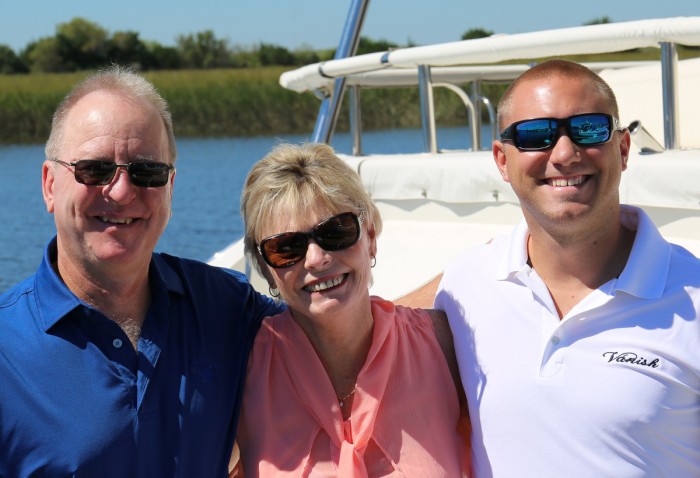
Once Vanish was safely in her berth in Georgia at the end of September, we kept a close eye on marinetraffic.com to see how other vessel captains dealt with the rapidly changing weather conditions due to Hurricane Joaquin. We'd left Cape Lookout (which is south of Cape Hatteras) on Saturday 27th September. A sub tropical low had formed off the Outer Banks in our area which explained our consistent 30 to 45 kn wind readings. Each morning for a week I asked Maynard whether the National Hurricane Center were forecasting a hurricane as the atmosphere felt heavy, warm and humid reminding me so much of our experience at Cape Lookout in the weeks before Hurricane Sandy in 2012.
Virtually no cruisers were transiting the East Coast of the USA at this time due to the rough seas and high winds. On Sunday, a tropical depression developed north of the Bahamas and was predicted to move WNW before turning N. We watched this system carefully during our two day sea passage on Saturday and Sunday and were extremely happy when we tied up to our dock Sunday evening 28th September. Finally we felt relatively safe from any risk from a developing weather system, however, we kept a close eye on every report.
On Tuesday, the system was declared a tropical storm and given the name Joaquin. The next day, Wednesday, it became a Category 3 hurricane with wind speeds of over 150 mph and seas in excess of 50 feet. The Wednesday 4 pm cone model showed that the hurricane would most likely cross the Outer Banks at the end of the week right where we'd anchored just a few days before. We kept monitoring Marinetraffic.com and saw many yachts departing the Beaufort, SC marinas on sunset after that particular update . Weighing up whether to put to sea, tie the vessel to a dock or move inland if possible is a decision which weighs heavily on all captains. None of us want to be anywhere near a hurricane. Avoiding a hurricane is an art in itself taking into account weather reports, sea states, captain and crew experience and the capabilities of the vessel.
Joaquin did not behave like a normal hurricane. Most move at a fairly fast rate, however Joaquin sat in virtually the same area pummelling The Bahamian islands of Long Island and Crooked Island for 3 days. Further north on the Outer Banks and up to the Chesapeake Bay area and north to New York, mariners could not safely move south. The seas were large and the winds were relentless. Day after day, wind speeds at Cape Lookout were consistently 30 to 50 knots with torrential rain. Yachts were finding berths at docks and just waiting for the storm to pass. Larger ships were spreading out in their attempt to avoid the hurricane. On Tuesday night an 800 ft RORO (roll on roll off) vessel named El Faro departed Jacksonville, Florida with its cargo of vehicles and 28 US and 5 Polish crew bound for San Juan, Puerto Rico.
The hurricane was expected to move to the N but instead it drifted slowly SW at a rate of 5 mph. El Faro was in the NW quadrant of the hurricane. With the hurricane unexpectedly stationary, the seas and winds were increasing as the hurricane intensified. Could the Captain outrun the hurricane by staying north or should he stay south hoping the hurricane would move north as forecast? El Faro was being sucked into the eye of the storm running downwind with following seas. A crewmember wrote in an email to her mother, "We are heading straight into it, Category 3, last we checked, winds are super bad. Love to everyone." A vessel of any size is at great risk when it is broadside to waves. It is an extremely hard decision to turn around before it is impossible to do so.
On Wednesday night with the hurricane at Category 3, the Captain contacted the Coast Guard stating he was listing 15 degrees and had experienced a loss of propulsion and was taking on water. Perhaps his cargo had moved or holed his vessel. On Thursday morning with Hurricane Joaquin at Category 4 around 7.30 am the Captain reported the water ingress was under control. We can only speculate on what happened next. Our hearts go out to all families involved in this tragic event as the ship rolled over and sunk with all lives lost. We are members of the maritime community. Every sailor, whether they are in a canoe or a bulk carrier are our family. Sometimes things don't work out. We all do our best to make the right decisions to keep our crews and land based families safe. We may never know the entire story but one thing is for sure, unknown events overcame the safety of the ship on Thursday. Judgement calls are well and good in hindsight, but often difficult to recognize under extreme duress. I pray that in time, peace will come to those left behind.
Hurricane Joaquin was one of the longest lived hurricanes in the history of the Atlantic. It has been 149 years since the Bahamas have experienced a Category 4 hurricane in the month of October, the last one being in the early 1800s during another global warming event. Hurricane Joaquin actually did not cross the coast of the US but brought about floods and fatalities in the Carolinas and extensive damage to parts of the Bahamas. The Acklin Islands in the Bahamas were reported to be completely under water. 5 ft of floodwaters submerged 70% of Crooked Island and Long Island was subject to an 18 ft storm surge that flooded homes with up to 12 ft of water. Joaquin was one of the strongest known hurricanes to impact the Bahamas and was comparable to Hurricane Andrew in 1992. We spend a great deal of time studying the weather with various weather forecasting programs and apps. So far we've dodged many bullets and I'm glad we were nowhere near this one.
We feel fortunate to have had another good year on Vanish enjoying the hospitality of everyone we encountered. Unlike our experience in 2012, we were not hassled at all by Coast Guard boardings, Harbor Master interrogations or any other authorities. This was in stark contrast to feeling so unwelcome by the authorities on our previous cruise in the USA. Other cruisers also remarked how enjoyable the cruising has become.
So now we say goodbye to the 2015 cruising season and hope you've enjoyed another year with us on board our little piece of paradise, Vanish. Until next time, this is Vanish....Out.
.JPG)
Virtually no cruisers were transiting the East Coast of the USA at this time due to the rough seas and high winds. On Sunday, a tropical depression developed north of the Bahamas and was predicted to move WNW before turning N. We watched this system carefully during our two day sea passage on Saturday and Sunday and were extremely happy when we tied up to our dock Sunday evening 28th September. Finally we felt relatively safe from any risk from a developing weather system, however, we kept a close eye on every report.
On Tuesday, the system was declared a tropical storm and given the name Joaquin. The next day, Wednesday, it became a Category 3 hurricane with wind speeds of over 150 mph and seas in excess of 50 feet. The Wednesday 4 pm cone model showed that the hurricane would most likely cross the Outer Banks at the end of the week right where we'd anchored just a few days before. We kept monitoring Marinetraffic.com and saw many yachts departing the Beaufort, SC marinas on sunset after that particular update . Weighing up whether to put to sea, tie the vessel to a dock or move inland if possible is a decision which weighs heavily on all captains. None of us want to be anywhere near a hurricane. Avoiding a hurricane is an art in itself taking into account weather reports, sea states, captain and crew experience and the capabilities of the vessel.
Joaquin did not behave like a normal hurricane. Most move at a fairly fast rate, however Joaquin sat in virtually the same area pummelling The Bahamian islands of Long Island and Crooked Island for 3 days. Further north on the Outer Banks and up to the Chesapeake Bay area and north to New York, mariners could not safely move south. The seas were large and the winds were relentless. Day after day, wind speeds at Cape Lookout were consistently 30 to 50 knots with torrential rain. Yachts were finding berths at docks and just waiting for the storm to pass. Larger ships were spreading out in their attempt to avoid the hurricane. On Tuesday night an 800 ft RORO (roll on roll off) vessel named El Faro departed Jacksonville, Florida with its cargo of vehicles and 28 US and 5 Polish crew bound for San Juan, Puerto Rico.
The hurricane was expected to move to the N but instead it drifted slowly SW at a rate of 5 mph. El Faro was in the NW quadrant of the hurricane. With the hurricane unexpectedly stationary, the seas and winds were increasing as the hurricane intensified. Could the Captain outrun the hurricane by staying north or should he stay south hoping the hurricane would move north as forecast? El Faro was being sucked into the eye of the storm running downwind with following seas. A crewmember wrote in an email to her mother, "We are heading straight into it, Category 3, last we checked, winds are super bad. Love to everyone." A vessel of any size is at great risk when it is broadside to waves. It is an extremely hard decision to turn around before it is impossible to do so.
On Wednesday night with the hurricane at Category 3, the Captain contacted the Coast Guard stating he was listing 15 degrees and had experienced a loss of propulsion and was taking on water. Perhaps his cargo had moved or holed his vessel. On Thursday morning with Hurricane Joaquin at Category 4 around 7.30 am the Captain reported the water ingress was under control. We can only speculate on what happened next. Our hearts go out to all families involved in this tragic event as the ship rolled over and sunk with all lives lost. We are members of the maritime community. Every sailor, whether they are in a canoe or a bulk carrier are our family. Sometimes things don't work out. We all do our best to make the right decisions to keep our crews and land based families safe. We may never know the entire story but one thing is for sure, unknown events overcame the safety of the ship on Thursday. Judgement calls are well and good in hindsight, but often difficult to recognize under extreme duress. I pray that in time, peace will come to those left behind.
Hurricane Joaquin was one of the longest lived hurricanes in the history of the Atlantic. It has been 149 years since the Bahamas have experienced a Category 4 hurricane in the month of October, the last one being in the early 1800s during another global warming event. Hurricane Joaquin actually did not cross the coast of the US but brought about floods and fatalities in the Carolinas and extensive damage to parts of the Bahamas. The Acklin Islands in the Bahamas were reported to be completely under water. 5 ft of floodwaters submerged 70% of Crooked Island and Long Island was subject to an 18 ft storm surge that flooded homes with up to 12 ft of water. Joaquin was one of the strongest known hurricanes to impact the Bahamas and was comparable to Hurricane Andrew in 1992. We spend a great deal of time studying the weather with various weather forecasting programs and apps. So far we've dodged many bullets and I'm glad we were nowhere near this one.
We feel fortunate to have had another good year on Vanish enjoying the hospitality of everyone we encountered. Unlike our experience in 2012, we were not hassled at all by Coast Guard boardings, Harbor Master interrogations or any other authorities. This was in stark contrast to feeling so unwelcome by the authorities on our previous cruise in the USA. Other cruisers also remarked how enjoyable the cruising has become.
So now we say goodbye to the 2015 cruising season and hope you've enjoyed another year with us on board our little piece of paradise, Vanish. Until next time, this is Vanish....Out.
We've Had Enough
27 September 2015 | At Sea off Savannah, Georgia
Vicki – Weather 23 F/73 F, Sea 25 C/77 F, Cloud 8/8, Wind 15 kn NE
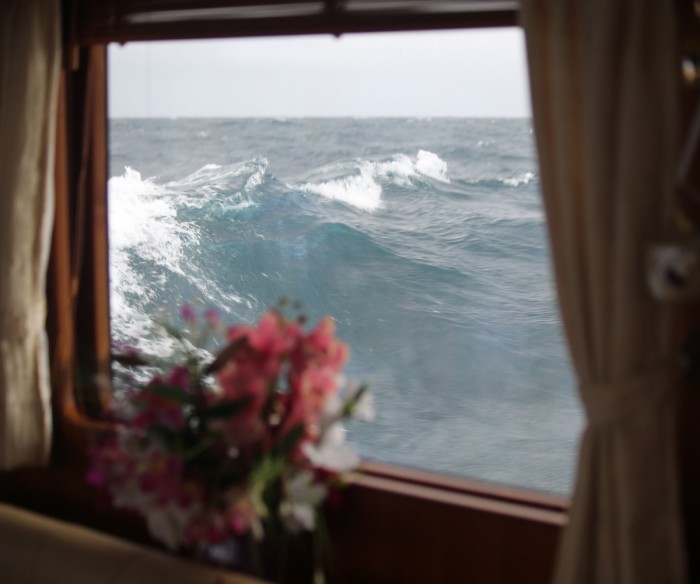
Picture this. You’re lying in bed listening to wind hitting the boat in wave after wave of rain squalls when something changes outside. The boat just ‘feels’ different. It’s 5 a.m. on Friday and pitch dark outside except for the lightning. I race up to the bridge where horizontal rain is drenching the carpet through the open aft door while Maynard checks our position. He discovers that the wind has changed to a westerly and we are now in 3 meters of water on high tide being blown onto a bank. Just because we’ve had 7 days of consistent north-easterly winds, doesn’t mean the Gods can’t mix it up a bit. We should have anchored another 100 meters away and are now paying the price. No matter how long you’ve been cruising, these things can and do happen. Mike, vigilant as ever, had been awake for hours and came up immediately to help raise the anchor in the dark to move Vanish back out to the middle of the more exposed anchorage. It was safer out there but we endured another 24 hours in 30 knots of once again north-easterly wind.
By now, after 7 days of terrible weather sitting under this east coast low, we’re getting worn down. Yesterday’s near beaching was scary. We could have spent our time at the marina in Beaufort, NC but we’d pictured kayaking, swimming, and beach walks while waiting for this event to dissipate. It didn’t happen. So now it’s 24 hours later on Saturday morning at 5 a.m. We’ve had very little sleep again listening to the maelstrom outside. With 40 knot gusts, Maynard’s anchor alarm app on his tablet goes off. The app is called Anchor Watch Pro by Pro Medial for Android. It sounds like 100 New York cop cars racing to an emergency with all sirens blaring. This is the sound we woke to. What now! Oh great. The anchor is dragging and we are heading for the opposite beach…..rather quickly. The adrenaline is pumping. Raising the anchor in high wind is hard. So much can go wrong.
When the anchor was finally raised, we knew immediately why it had let go. The ground tackle closest to the anchor had fouled and become kinked holding the anchor at an angle to the proper direction of pull. This rarely happens and we were unfortunate that it happened here. We’d set it correctly and backed down on it with both engines to the equivalent of 40 knots of wind. However, we’d had two windshifts in the past 24 hours and this had caused the anchor to roll over and for the chain to become kinked.
Finally, Maynard and Mike had the anchor on deck. It was still dark and blowing like stink. Maynard decided to motor out of the anchorage slowly and take stock of our situation. He looked at the weather reports which called for 30 – 35 kn winds with higher gusts and thunderstorms. We looked at the weather South of our position which showed 2 – 3 meter seas with wind of 30 knots but abating once south of Cape Fear to 20 – 25 knots. Every mile south was better. With the wind and swell behind us, even though it was sizeable, Vanish rides with extreme stability and smoothness in those conditions. In fact, it seldom rolled more than 2 – 3 degrees. Maximum roll was 5 degrees on one occasion. It was remarkably more comfortable than at the Cape Lookout anchorage and we all felt much safer. We knew we’d get more rest and sleep at sea than where we were.
As you can see above, we experienced waves breaking down both sides of Vanish as we rode the swells south. There were no other pleasure vessels on Marine Traffic at sea from Sandy Hook, New York all the way to Florida. It looks like most cruisers are either stuck in New York or the Chesapeake Bay or are waiting in marinas for this low to abate. As it turned out, it was a brilliant move to leave when we did. The boat was comfortable, we were able to watch the College football games on TV, and eat and do our watches with no trouble while constantly observing less wind and smaller seas. Oh, what a feeling.
(See Photo Gallery)
By now, after 7 days of terrible weather sitting under this east coast low, we’re getting worn down. Yesterday’s near beaching was scary. We could have spent our time at the marina in Beaufort, NC but we’d pictured kayaking, swimming, and beach walks while waiting for this event to dissipate. It didn’t happen. So now it’s 24 hours later on Saturday morning at 5 a.m. We’ve had very little sleep again listening to the maelstrom outside. With 40 knot gusts, Maynard’s anchor alarm app on his tablet goes off. The app is called Anchor Watch Pro by Pro Medial for Android. It sounds like 100 New York cop cars racing to an emergency with all sirens blaring. This is the sound we woke to. What now! Oh great. The anchor is dragging and we are heading for the opposite beach…..rather quickly. The adrenaline is pumping. Raising the anchor in high wind is hard. So much can go wrong.
When the anchor was finally raised, we knew immediately why it had let go. The ground tackle closest to the anchor had fouled and become kinked holding the anchor at an angle to the proper direction of pull. This rarely happens and we were unfortunate that it happened here. We’d set it correctly and backed down on it with both engines to the equivalent of 40 knots of wind. However, we’d had two windshifts in the past 24 hours and this had caused the anchor to roll over and for the chain to become kinked.
Finally, Maynard and Mike had the anchor on deck. It was still dark and blowing like stink. Maynard decided to motor out of the anchorage slowly and take stock of our situation. He looked at the weather reports which called for 30 – 35 kn winds with higher gusts and thunderstorms. We looked at the weather South of our position which showed 2 – 3 meter seas with wind of 30 knots but abating once south of Cape Fear to 20 – 25 knots. Every mile south was better. With the wind and swell behind us, even though it was sizeable, Vanish rides with extreme stability and smoothness in those conditions. In fact, it seldom rolled more than 2 – 3 degrees. Maximum roll was 5 degrees on one occasion. It was remarkably more comfortable than at the Cape Lookout anchorage and we all felt much safer. We knew we’d get more rest and sleep at sea than where we were.
As you can see above, we experienced waves breaking down both sides of Vanish as we rode the swells south. There were no other pleasure vessels on Marine Traffic at sea from Sandy Hook, New York all the way to Florida. It looks like most cruisers are either stuck in New York or the Chesapeake Bay or are waiting in marinas for this low to abate. As it turned out, it was a brilliant move to leave when we did. The boat was comfortable, we were able to watch the College football games on TV, and eat and do our watches with no trouble while constantly observing less wind and smaller seas. Oh, what a feeling.
(See Photo Gallery)
Scope It Out
25 September 2015 | North Carolina, USA
Maynard & Vicki – Weather: Air – 22 C/71 F, Sea 26 C/78 F, Rain, Wind 25 – 30 kn ENE
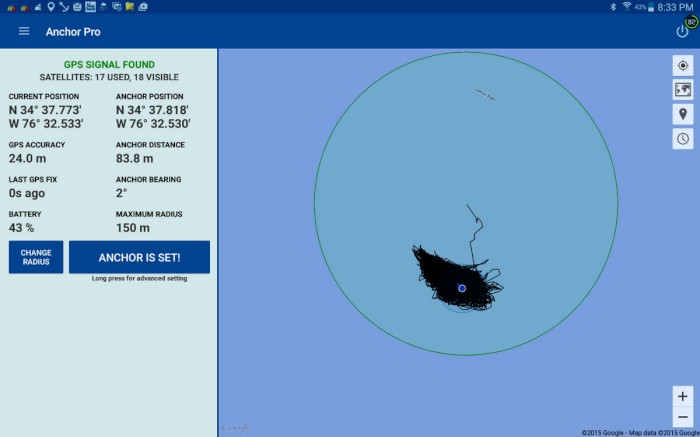
The last time we were able to leave Vanish was 5 days ago. We'd returned from a shopping/restaurant outing on Monday to find the wind in the anchorage had increased to 25 - 30 knots and was building with the development of an offshore low. As it was nearing sunset, we decided to move Vanish a few hundred meters closer to an area called Shackleford Banks in the Cape Lookout anchorage providing us with flatter, more protected conditions. Maynard put out 65 meters of chain but in hindsight we should have, and could have put out 95 meters of chain. Better in the water than in the locker!
Whilst lying in bed listening to the wind howl at 2:30 am for the third night in a row at a very lonely Cape Lookout anchorage, one tends to try to keep their mind busy thinking about almost anything but where you are actually at. Inevitably, you begin to wonder how that anchor could possibly hold this big yacht as you feel a particularly large gust pound into the starboard side of the yacht forcing it to heel over and charge off in the opposite direction. The loads must be tremendous!
Maynard has a mathematical mind and being completely trapped on Vanish during the current East Coast low sitting off Cape Hatteras, decided to do a bit of research to quantify the forces involved in holding a boat the size of Vanish in 30 to 40 knots of gusting wind day after day. It turns out that there a number of real world empirical formulas which at least gives one an idea as to what the holding power of an anchor is and the forces acting on a yacht associated with wind. The following are his thoughts on the matter.
"Vanish is a Marlow Explorer 76LR, an 82 foot vessel whose primary anchor is a Lewmar CQR 185lb steel anchor. We have been very happy with it as it sets well and has held us in all sorts of conditions. I realize that there are more modern anchors which have received a lot of acclaim but at this stage we are sticking with the CQR.
The following formula has been derived to describe the maximum holding power of modern steel anchors:
F=K*M to the power of 1.4 where F= maximum holding force (assumes infinite scope)
K= holding coefficient
M= Anchor Mass or weight in pounds
K, the holding co-efficient is dependent on anchor type and the holding strength of the sea bed material. For hard bottoms such as a thin veneer of sand on coral, our CQR has K between 3 and 6. If we use a K of 5 then on hard bottoms with no or very little anchor penetration, our anchor would have an F of 5,400 pounds For soft low density muds, K is generally between 12 and 15. These are the sorts of bottoms that, when you back down on a set anchor, the anchor slides a little bit or feels spongy. Using a K of 12, our anchor would have an F of 13,000 pounds. Most recognized anchorages have good holding denser muds or sand combinations and have a K in the 20 - 30 range. For a K of 22, our anchor would have a maximum holding force of 23,000 pounds. It is interesting to note that the next size up CQR is 225 pounds. For this small 40 pound increase in weight, the maximum holding power increases by 30%. So size really does matter.
These values of K tend to work out pretty accurately based on our experience with our CQR anchor. Modern manufacturers of anchors such as Rocna argue that the holding coefficient for a given bottom type is 30 - 50% higher with their new improved designs. This may well be true but testing and confirmation is continuing.
Scope is another important consideration. For our CQR with a scope of 3 to 1 you need to multiply the maximum holding power F by 40%. At 6 to 1 multiply F by 70%. At a scope of 10 to 1 the maximum holding power should be multiplied by 95%.
As the wind was whistling overhead in the middle of the night I began to wonder why I had not put out more chain. We put out 65 meters of chain in 6 meters of water at low tide. The tides are about 2 meters and the bow height is also about 2 meters. So at 10 meters maximum effective depth with 65 meters of chain out we have a scope of 6.5 to 1 which gives us a holding strength of 16,000 pounds. I wonder how much force is being exerted on Vanish by the 40+ knot gusts?
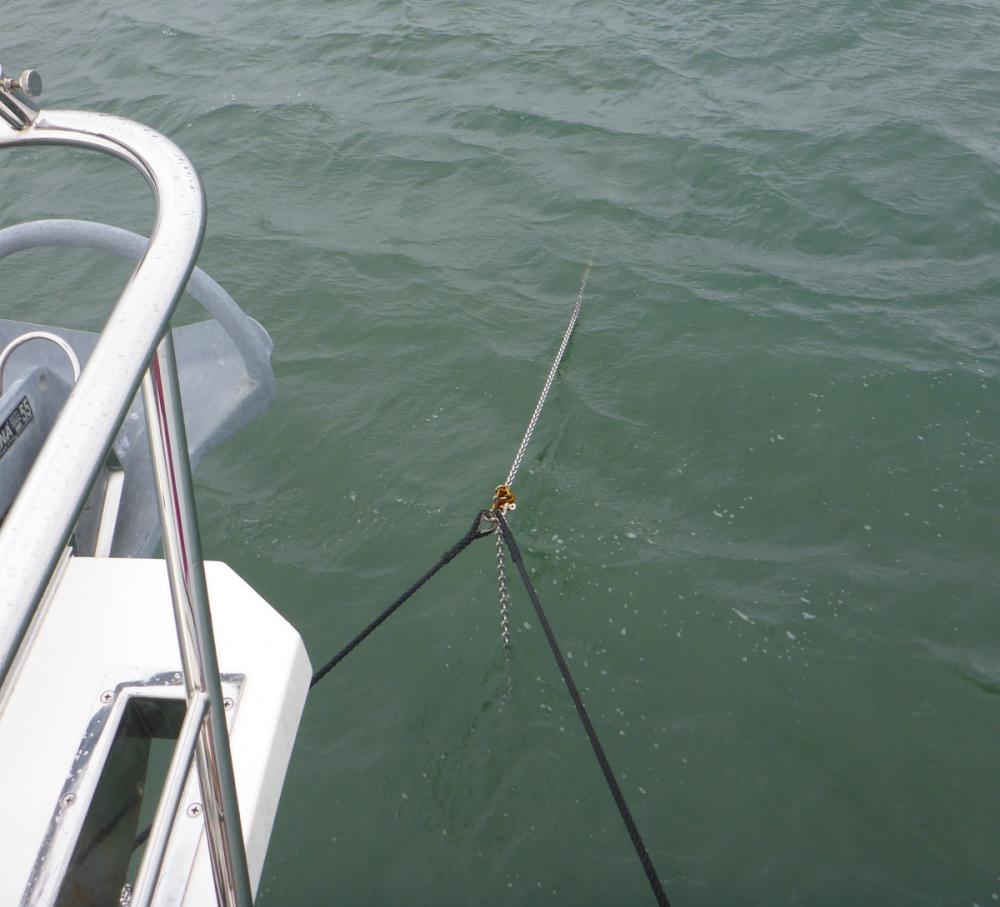
Fortunately the American Boat and Yacht Council (ABYC) have worked up a simple nomogram that can be used to estimate the forces acting on your yacht type for a given wind speed. For Vanish, the ABYC nomogram yields a windage force of 1,000 pounds at 15 knots, 3,600 pounds at 30 knots, at 45 knots the force acting on Vanish is 8,500 pounds. In a hurricane with 70 knots of wind it would exert 20,000 pounds of force on Vanish. Definitely time to start the motors. These force values are pretty conservative and have been found to be remarkably accurate in real world situations. One word of caution. Vanish does tend to wander around a bit and sometimes the wind attack angle exceeds 25 degrees so that the wind is hitting the vessel more side on. At a 45 degree wind angle you can increase the wind force by up to 50% from the above numbers.
So let's recap Vanish's situation over the last few days. If we assume a maximum gust of 45 knots and a maximum angle of attack of 35 degrees, then Vanish would have had approximately 10,000 pounds of maximum force acting on it. At a scope of 6 to 1 Vanish's anchor had a holding power of at least 16,000 pounds assuming a K of 22. I expect that the holding in the firm Cape Lookout sand would have a K closer to 30 making my estimate of 16,000 pounds of holding power pretty conservative. Hence, one would expect not to have moved. In fact when you look at Vanish's anchor pattern throughout this gale, Vanish indeed did not move at all. Next time however, I will put out a scope of 10 to 1 so as to maximize my safety factor and hopefully improve my sleep!"
(See Photo Gallery)
Whilst lying in bed listening to the wind howl at 2:30 am for the third night in a row at a very lonely Cape Lookout anchorage, one tends to try to keep their mind busy thinking about almost anything but where you are actually at. Inevitably, you begin to wonder how that anchor could possibly hold this big yacht as you feel a particularly large gust pound into the starboard side of the yacht forcing it to heel over and charge off in the opposite direction. The loads must be tremendous!
Maynard has a mathematical mind and being completely trapped on Vanish during the current East Coast low sitting off Cape Hatteras, decided to do a bit of research to quantify the forces involved in holding a boat the size of Vanish in 30 to 40 knots of gusting wind day after day. It turns out that there a number of real world empirical formulas which at least gives one an idea as to what the holding power of an anchor is and the forces acting on a yacht associated with wind. The following are his thoughts on the matter.
"Vanish is a Marlow Explorer 76LR, an 82 foot vessel whose primary anchor is a Lewmar CQR 185lb steel anchor. We have been very happy with it as it sets well and has held us in all sorts of conditions. I realize that there are more modern anchors which have received a lot of acclaim but at this stage we are sticking with the CQR.
The following formula has been derived to describe the maximum holding power of modern steel anchors:
F=K*M to the power of 1.4 where F= maximum holding force (assumes infinite scope)
K= holding coefficient
M= Anchor Mass or weight in pounds
K, the holding co-efficient is dependent on anchor type and the holding strength of the sea bed material. For hard bottoms such as a thin veneer of sand on coral, our CQR has K between 3 and 6. If we use a K of 5 then on hard bottoms with no or very little anchor penetration, our anchor would have an F of 5,400 pounds For soft low density muds, K is generally between 12 and 15. These are the sorts of bottoms that, when you back down on a set anchor, the anchor slides a little bit or feels spongy. Using a K of 12, our anchor would have an F of 13,000 pounds. Most recognized anchorages have good holding denser muds or sand combinations and have a K in the 20 - 30 range. For a K of 22, our anchor would have a maximum holding force of 23,000 pounds. It is interesting to note that the next size up CQR is 225 pounds. For this small 40 pound increase in weight, the maximum holding power increases by 30%. So size really does matter.
These values of K tend to work out pretty accurately based on our experience with our CQR anchor. Modern manufacturers of anchors such as Rocna argue that the holding coefficient for a given bottom type is 30 - 50% higher with their new improved designs. This may well be true but testing and confirmation is continuing.
Scope is another important consideration. For our CQR with a scope of 3 to 1 you need to multiply the maximum holding power F by 40%. At 6 to 1 multiply F by 70%. At a scope of 10 to 1 the maximum holding power should be multiplied by 95%.
As the wind was whistling overhead in the middle of the night I began to wonder why I had not put out more chain. We put out 65 meters of chain in 6 meters of water at low tide. The tides are about 2 meters and the bow height is also about 2 meters. So at 10 meters maximum effective depth with 65 meters of chain out we have a scope of 6.5 to 1 which gives us a holding strength of 16,000 pounds. I wonder how much force is being exerted on Vanish by the 40+ knot gusts?
Fortunately the American Boat and Yacht Council (ABYC) have worked up a simple nomogram that can be used to estimate the forces acting on your yacht type for a given wind speed. For Vanish, the ABYC nomogram yields a windage force of 1,000 pounds at 15 knots, 3,600 pounds at 30 knots, at 45 knots the force acting on Vanish is 8,500 pounds. In a hurricane with 70 knots of wind it would exert 20,000 pounds of force on Vanish. Definitely time to start the motors. These force values are pretty conservative and have been found to be remarkably accurate in real world situations. One word of caution. Vanish does tend to wander around a bit and sometimes the wind attack angle exceeds 25 degrees so that the wind is hitting the vessel more side on. At a 45 degree wind angle you can increase the wind force by up to 50% from the above numbers.
So let's recap Vanish's situation over the last few days. If we assume a maximum gust of 45 knots and a maximum angle of attack of 35 degrees, then Vanish would have had approximately 10,000 pounds of maximum force acting on it. At a scope of 6 to 1 Vanish's anchor had a holding power of at least 16,000 pounds assuming a K of 22. I expect that the holding in the firm Cape Lookout sand would have a K closer to 30 making my estimate of 16,000 pounds of holding power pretty conservative. Hence, one would expect not to have moved. In fact when you look at Vanish's anchor pattern throughout this gale, Vanish indeed did not move at all. Next time however, I will put out a scope of 10 to 1 so as to maximize my safety factor and hopefully improve my sleep!"
(See Photo Gallery)
Watch It
18 September 2015 | North Carolina, USA
Vicki – Weather: Air 24c/75f, Sea 26c/80f, Cloud 6/8, Rain Showers, Wind 10kn E
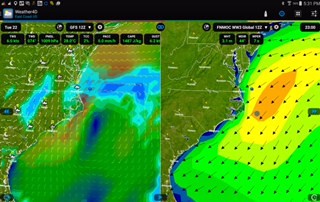
Maynard’s night watch at sea is 7.30pm to 11pm. Mike does the 11pm to 2.30am watch and I do the 2.30am to 6am watch. We all prefer our individual watch hours and don’t like switching them around as they work so well. Last night though, Mike and I ended up overlapping from 3am to 4am as we rounded Cape Hatteras as it was busy with marine traffic and heavy rain cells on either side of us. Cape Hatteras is always busy as it is the most eastern point of the US coastline and vessels converge here as they travel north and south. The guys tell me they spend their watches snacking the entire time (eg. popcorn, Diet Coke, Reese’s Buttercups, crackers – all healthy foods they tell me) while I am boring and eat apples and drink club soda. We don’t listen to music or watch tv as we are pretty serious about our night watches. This allows the off watch crew to sleep soundly in their beds.
Once all the targets on the monitors at Cape Hatteras had been identified and vectors established at the beginning of my watch, Mike headed off to bed and I continued until it was Maynard’s turn to come up. I like knowing way in advance which way vessels are going so I can have time to decide whether to and how to avoid everyone. During a pre-sunrise watch on the first day 40 miles out to sea off Delaware Bay, one of my targets was coming at us at 26 knots and the CPA was 200 meters in 4 minutes but I couldn’t see him in the binoculars as he blended into a distant ship. It turned out to be a sportsfish boat who swerved across our bow on his way to a favourite fishing hole. He could have passed behind us but he didn’t. Perhaps he wanted to avoid our wake. Whatever he was thinking, it sure had my heart pounding.
The seas were now beam onto Vanish at around 1.5 meters and the wind was at times up to 20 knots. Conditions were changing as ex tropical depression Grace had crossed the Atlantic a few days ago. It moved across southern Florida from east to west then back again to the east and is currently forming a low in the southern Carolina/Georgia area, just out to sea and south of our current position. The clouds are heavy with rain and remind me of the giant thunderheads we often see off Cape Byron in Australia. The above GRIB file shows expected winds up to 30 knots but the forecasts are different every 4 hours. So far, the forecasters say there is a 40% chance of a tropical depression forming from the remnants of Grace but it is moving to the NE. We’ll keep an eye on it, trust me.
(CPA – Closest Point of Approach)
Once all the targets on the monitors at Cape Hatteras had been identified and vectors established at the beginning of my watch, Mike headed off to bed and I continued until it was Maynard’s turn to come up. I like knowing way in advance which way vessels are going so I can have time to decide whether to and how to avoid everyone. During a pre-sunrise watch on the first day 40 miles out to sea off Delaware Bay, one of my targets was coming at us at 26 knots and the CPA was 200 meters in 4 minutes but I couldn’t see him in the binoculars as he blended into a distant ship. It turned out to be a sportsfish boat who swerved across our bow on his way to a favourite fishing hole. He could have passed behind us but he didn’t. Perhaps he wanted to avoid our wake. Whatever he was thinking, it sure had my heart pounding.
The seas were now beam onto Vanish at around 1.5 meters and the wind was at times up to 20 knots. Conditions were changing as ex tropical depression Grace had crossed the Atlantic a few days ago. It moved across southern Florida from east to west then back again to the east and is currently forming a low in the southern Carolina/Georgia area, just out to sea and south of our current position. The clouds are heavy with rain and remind me of the giant thunderheads we often see off Cape Byron in Australia. The above GRIB file shows expected winds up to 30 knots but the forecasts are different every 4 hours. So far, the forecasters say there is a 40% chance of a tropical depression forming from the remnants of Grace but it is moving to the NE. We’ll keep an eye on it, trust me.
(CPA – Closest Point of Approach)
Moving On
17 September 2015 | Currently At Sea
Vicki – Weather: Air 24c/75f, Sea 23c/73f, Wind 7kn W, Clear Skies, 1023 hP
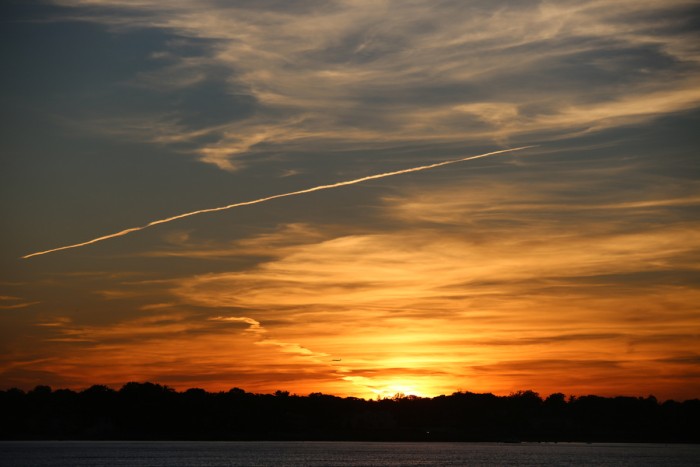
Motoring SW along the northern coast of Long Island, New York, we discovered another great anchorage in Manhasset Harbour which is relatively close to the tidal gate called Hells Gate. As we are now at the end of the season, there was ample room to anchor with protection from all directions except perhaps a strong NW although I doubt this direction would be a problem. The towns of Kings Point, Great Neck, Port Washington, Manhasset and Manorhaven surround the bay. After another brilliant sunset, we departed the following day ready to negotiate the East River. We waited for the tide at Hell Gate to slacken a little then continued on through New York City. The sights, smells and sounds of New York with helicopters overhead, sirens wailing along the shore-side freeways, Staten Island ferries, sightseeing tours, barges being pushed and towed by tugs and a myriad of other distractions is always a sensory overload. However, it is such a vibrant fantastic city, we always feels honoured to be allowed to pass through it whenever we're there. It's certainly much easier to go to New York by boat instead of by car.
On the East River we passed a blue and white ship with no windows anchored near the Rikers Island jail complex and thought this looked really strange but it turns out that this 625 foot long ship is the world's largest floating prison. It was brought to New York in 1992 to reduce overcrowding on Rikers Island and holds 800 prisoners. The inmates have a full-sized gym with a basketball court on the top deck and we could easily see the prisoners exercising as we passed by. It is known by inmates and guards as "The Boat" but its true name is the Vernon C. Bain Center. Funny as it may seem, for 10 years three maritime crew were maintained on The Ship under Coast Guard regulations but after years of monitoring the prison barge, it was finally accepted that it was in fact a jail, not a boat and no longer needed coast guard supervision.
It is always an exciting event seeing the Statue of Liberty and the city but after an hour and a half, we were through it all and ready for some quiet time at sea. We headed down the New Jersey coast in flat seas with 7 knots of easterly breezes and a 400 mile trip ahead of us. This was the best window we'd seen for quite a while. Many others were also taking advantage of the conditions. The strong NW winds we experienced a few days earlier had completely flattened the seas and took us all the way to Cape Hatteras in these same conditions. But the upcoming forecast will take some thought and careful planning.
(See Photo Gallery for more photos.)
On the East River we passed a blue and white ship with no windows anchored near the Rikers Island jail complex and thought this looked really strange but it turns out that this 625 foot long ship is the world's largest floating prison. It was brought to New York in 1992 to reduce overcrowding on Rikers Island and holds 800 prisoners. The inmates have a full-sized gym with a basketball court on the top deck and we could easily see the prisoners exercising as we passed by. It is known by inmates and guards as "The Boat" but its true name is the Vernon C. Bain Center. Funny as it may seem, for 10 years three maritime crew were maintained on The Ship under Coast Guard regulations but after years of monitoring the prison barge, it was finally accepted that it was in fact a jail, not a boat and no longer needed coast guard supervision.
It is always an exciting event seeing the Statue of Liberty and the city but after an hour and a half, we were through it all and ready for some quiet time at sea. We headed down the New Jersey coast in flat seas with 7 knots of easterly breezes and a 400 mile trip ahead of us. This was the best window we'd seen for quite a while. Many others were also taking advantage of the conditions. The strong NW winds we experienced a few days earlier had completely flattened the seas and took us all the way to Cape Hatteras in these same conditions. But the upcoming forecast will take some thought and careful planning.
(See Photo Gallery for more photos.)
It's A Bit Windy
15 September 2015 | Eatons Neck , Long Island, New York, USA
Vicki – Weather: Air 14 C/57 F, Wind NW 33 kn
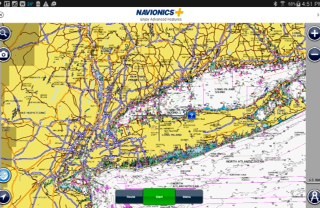
On Sunday we moved a further 70 miles SW down Long Island to one of our favourite anchorages, Eatons Neck near the town of Huntington. As I’ve mentioned previously, Eatons Neck recorded one of the highest gusts of wind in Hurricane Sandy in 2012 at 94 knots. Another front was approaching us so we needed to find protection from the WNW. We hid behind the sandspit with another motor vessel called Phoenix in wind with gusts to well over 40 knots. As we’ve had virtually no wind to speak of in over two months, this was a good test for our ground tackle and anchoring techniques. The anchor alarm was set for the night so we slept comfortably knowing it would let us know if we dragged at all. The only problem we encountered was that Mike’s cabin window was open during the night and a large wave from a passing vessel dumped a bucket full of saltwater onto him and his bed. Nice one. He has a great sense of humour and thought it was hilarious….luckily.
Thunderfog
12 September 2015 | Mattapoisett, Massachusetts, USA
Vicki – Weather: Air 20 C/68 F, Sea 22.5 C/72 F, Clear
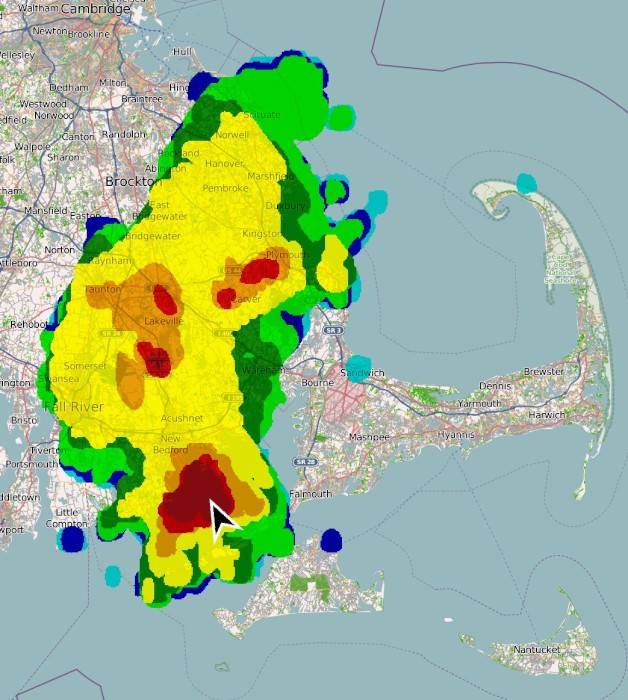
The trip down from Boston to the east end of the Cape Cod Canal was uneventful with calm seas. The Canal runs in a SW to NE direction. The wind was calm until we approached the entrance. We soon found that the wind was funnelling down the Canal at 25 kn from the SW. We noticed a flock of around 7,000 or more white-throated swifts swooping en masse as they caught insects in the air in the lee of the trees near the beach. In May this year a North Atlantic Right Whale was spotted by a pedestrian early in the morning happily swimming the 7 mile length of the canal at its own pace. The Canal was closed for 45 minutes until it exited to join a pod of 40 other whales waiting out to sea. It will be interesting to see if it now chooses this route every year on its annual migration.
We anchored at Mattapoisett Harbor off Buzzards Bay, just south of the Canal. In the morning we awoke to dense fog and as we picked our way past fishing vessels, stray lobster buoys and channel markers, we heard loud rumbling in the distance; our first ever thunderfog! Of course, we couldn't see anything with our eyes, but the radar showed line after line of approaching storms. My SkyScan lightning detector was busy showing a rainbow of colours telling us the distance to each strike from 40 to less than 3 miles away. As the rain began to hit us, the fog lifted slightly so that we had around 500 meters of visibility. As the rain increased, the fog continued to lift but we were still experiencing the same low visibility due to the amount of rain. This was some of the heaviest rain we've seen while at sea on Vanish.
We arrived at Orient, New York on the NE end of Long Island where we stayed for a few days. We knew Sag Harbour in the Hamptons had a marina for megayachts and superyachts so we took the dinghy 10 miles to town to check it all out. Other than seeing a BMW mini on the top deck of a megayacht instead of the usual dinghy, we found it wasn't our kind of town so we then went over to Greenport in the dinghy to the Mitchell Marina. We loved Greenport and would happily spend more time there. In fact, we felt we could easily have spent a few weeks in the Great Peconic Bay, Noyack Bay and Shelter Island Sound area on Long Island. Summer In New York and Maine on a boat, any boat, is a privilege and something we appreciate beyond words.
(See Photo Gallery for more Photos.)
We anchored at Mattapoisett Harbor off Buzzards Bay, just south of the Canal. In the morning we awoke to dense fog and as we picked our way past fishing vessels, stray lobster buoys and channel markers, we heard loud rumbling in the distance; our first ever thunderfog! Of course, we couldn't see anything with our eyes, but the radar showed line after line of approaching storms. My SkyScan lightning detector was busy showing a rainbow of colours telling us the distance to each strike from 40 to less than 3 miles away. As the rain began to hit us, the fog lifted slightly so that we had around 500 meters of visibility. As the rain increased, the fog continued to lift but we were still experiencing the same low visibility due to the amount of rain. This was some of the heaviest rain we've seen while at sea on Vanish.
We arrived at Orient, New York on the NE end of Long Island where we stayed for a few days. We knew Sag Harbour in the Hamptons had a marina for megayachts and superyachts so we took the dinghy 10 miles to town to check it all out. Other than seeing a BMW mini on the top deck of a megayacht instead of the usual dinghy, we found it wasn't our kind of town so we then went over to Greenport in the dinghy to the Mitchell Marina. We loved Greenport and would happily spend more time there. In fact, we felt we could easily have spent a few weeks in the Great Peconic Bay, Noyack Bay and Shelter Island Sound area on Long Island. Summer In New York and Maine on a boat, any boat, is a privilege and something we appreciate beyond words.
(See Photo Gallery for more Photos.)
Hippos of the Sea
09 September 2015 | Boston, Massachusetts, USA
Vicki – Weather: Air 26C/79F, Sea 19C/66F, Wind 3 kn SW-SE, Seas 1-2 ft
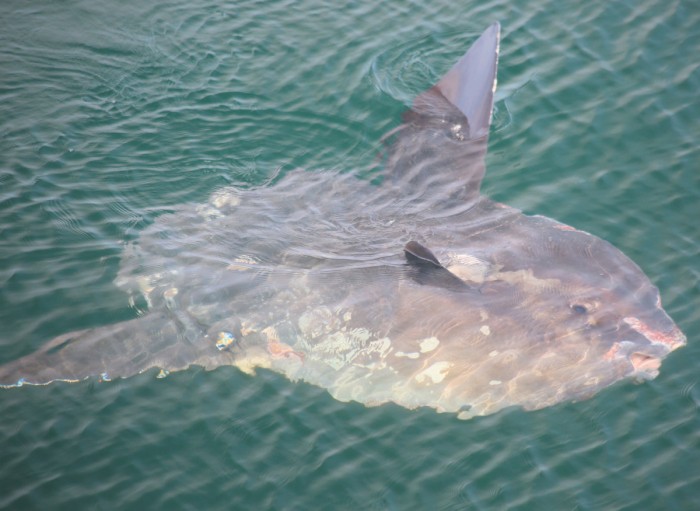
In glassy seas off Kennebunkport, Massachusetts we saw what looked like a fish in distress on the surface slowly waving its fins back and forth. From a distance, it looked like a lobster buoy but as we closed, it turned out to be an ocean sunfish, something we've heard horror stories of in rum soaked yacht clubs around the world but never seen. The above photo doesn't do it justice when it comes to scale as it was at least 6 ft in length and around 5 ft across. A quick google search shows they can be anywhere from 545 lb up to 2,000 lb (247 - 1000 kg) and mostly live on jellyfish. They are slow moving and can be extremely hazardous to boats if you run into one or if they become caught in propellers. They can easily hole a yacht, become pierced on the keel or they can crack a rudder as has happened in the Sydney to Hobart Yacht Race. Worse yet, they can leap 10 ft into the air, or onto a vessel if you can imagine that, and can dive to 600 ft. Tall tales but true. We saw 3 on our trip yesterday in a 100 mile section. We idled up to them, put the engines in neutral and watched as they slowly became aware we were there before diving to the depths again after their pleasant sunbake. I can assure you, I was ready for the photo of the decade if they leapt into the air! We also saw a pod of around 150 dolphins busily slapping the water with their tails and leaping about while herding fish. The calm conditions made it a great day for viewing the sea-life.
This past weekend we celebrated the Captain's birthday in style by taking the dinghy 9.5 miles south of Vanish's anchorage in Quahog Bay, Maine to one of our favourite restaurants, the Dolphin Restaurant. It took an hour each way as we passed the ever present lobster buoys, ledges, islands and under bridges and around rocky points to arrive at Basin Point, South Harpswell. Chris Saxton, the Manager, found us a table immediately even though they were extremely busy with it being the Labor Day Weekend. It turns out that Chris follows expedition type sailing blogs around the world and was very interested in the fact we are Australians exploring the Atlantic side of the world. The big drawcard at the restaurant, apart from their shoestring onion rings and blueberry pie are the free blueberry muffins with all main meals! Such a great idea, and so Maine-ish. Why not!
The Great State of Maine Airshow at Brunswick was underway all weekend as well featuring the U.S. Navy's Blue Angels F/A-18 Hornets. We had a great view of their practice runs and the actual show for quite a few days. I was lucky enough to capture a photo of a bald eagle flying towards Vanish with the Blue Angels in the background (see Photo Gallery). Her nest was located on Snow Island with a 360 degree view up and down Quahog Bay.
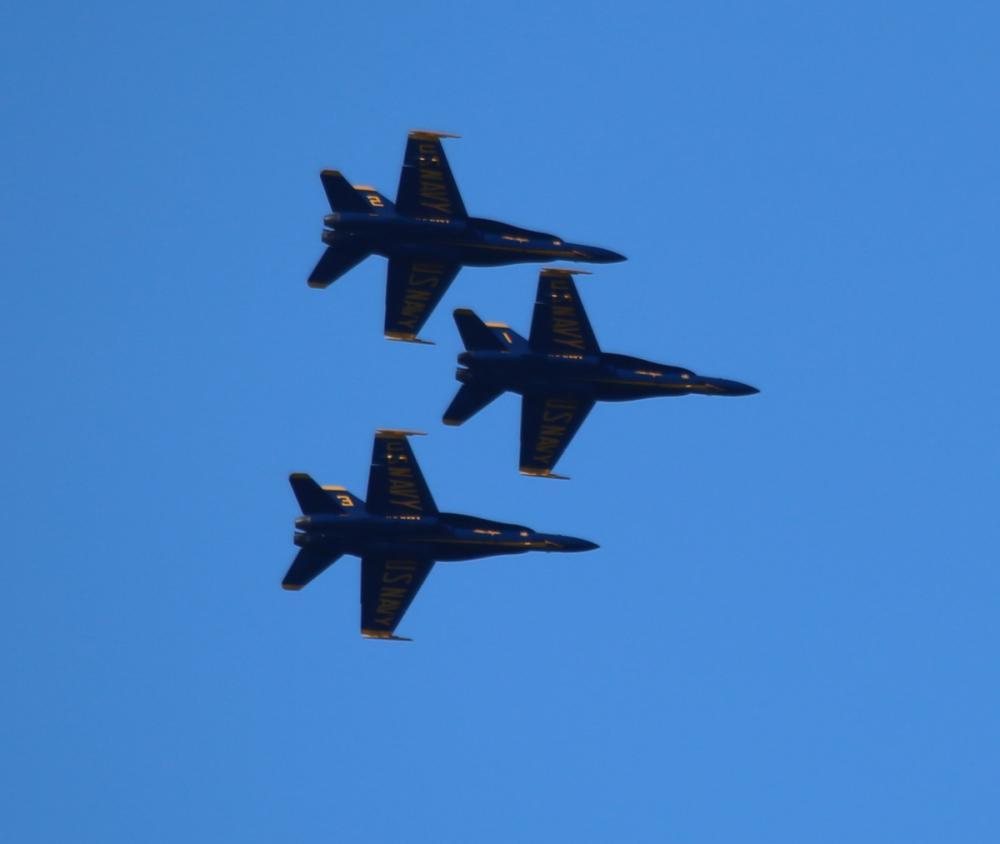
We are currently moving in a southerly direction with the Canada geese but keeping a wary eye out for any hurricane activity. Vanish is on the move again. She is working like a charm. Stay tuned.
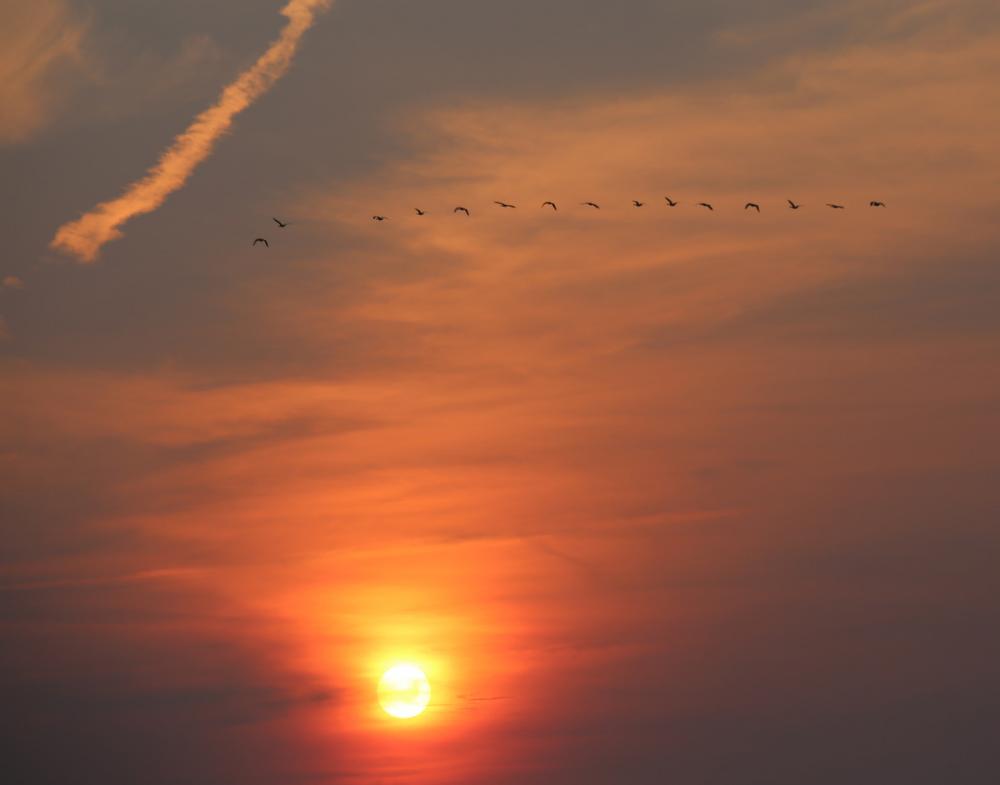
This past weekend we celebrated the Captain's birthday in style by taking the dinghy 9.5 miles south of Vanish's anchorage in Quahog Bay, Maine to one of our favourite restaurants, the Dolphin Restaurant. It took an hour each way as we passed the ever present lobster buoys, ledges, islands and under bridges and around rocky points to arrive at Basin Point, South Harpswell. Chris Saxton, the Manager, found us a table immediately even though they were extremely busy with it being the Labor Day Weekend. It turns out that Chris follows expedition type sailing blogs around the world and was very interested in the fact we are Australians exploring the Atlantic side of the world. The big drawcard at the restaurant, apart from their shoestring onion rings and blueberry pie are the free blueberry muffins with all main meals! Such a great idea, and so Maine-ish. Why not!
The Great State of Maine Airshow at Brunswick was underway all weekend as well featuring the U.S. Navy's Blue Angels F/A-18 Hornets. We had a great view of their practice runs and the actual show for quite a few days. I was lucky enough to capture a photo of a bald eagle flying towards Vanish with the Blue Angels in the background (see Photo Gallery). Her nest was located on Snow Island with a 360 degree view up and down Quahog Bay.
We are currently moving in a southerly direction with the Canada geese but keeping a wary eye out for any hurricane activity. Vanish is on the move again. She is working like a charm. Stay tuned.
Rescue at Lower Hell Gate
31 August 2015 | Ebenecook Harbour near Boothbay, Maine, USA
Vicki - Weather Temp 26c/78f, Sea 17c/62f, Cloud 7/8, Wind 3kn S
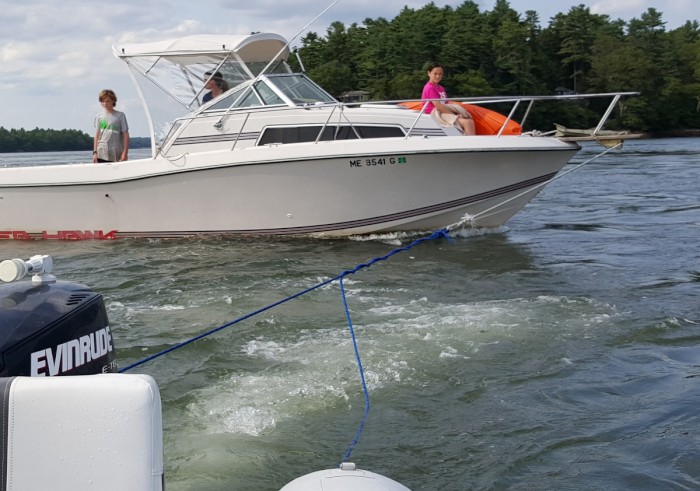
How time flies when one is idling about Maine taste-testing wild blueberry pies and dodging lobster buoys in the fog. Almost a month has passed since my last post yet we have visited many towns and harbours we missed back in 2012. Over the last few weeks we’ve anchored at North Haven on Vinalhaven, Stonington on Deer Island, Holbrook Island near Castine, Eggemoggin Reach, Rockland and Ebencook Harbour near Boothbay. All of these anchorages are perfect with great views, great restaurants nearby and solitude which suits us to a tee. The great thing about Maine is how the sea is such an integral part of everyone’s lives for young and old. Every type of craft is on the water in summer with opportunities to entertain friends and relatives on everything from chartered schooners to classic beautifully made wooden sailboats, and everything else in between.
.JPG)
A few weeks ago we had the pleasure of joining David and Barbara Marlow, the Owners of Marlow Yachts for dinner in an excellent restaurant near their summer cottage in Maine. It was a wonderful lively evening with much laughter and boating stories from both sides of the table. They have been extremely supportive of all our adventures and everything we’ve done on Vanish.
Our dinghy has proven to be a little trooper when it comes to covering large distances away from Vanish. Boothbay is in an adjacent harbour to where we were anchored yesterday, and taking the dinghy 6 miles to town through the Townsend Gut is easy and a very pleasant trip. A 140 ft superyacht decided to take a shortcut through the swing bridge on Townsend Gut, a narrow waterway which joins Boothbay to Ebencook Harbour. It’s not something we would have done as the clearance on either side of their vessel was only around 10 ft and the current was 3 knots with lobster buoys in the middle of the channel however, they made it through with some bow and stern thrusting along the way. The tides over the last couple of days have been huge with the full moon, this one being called a super moon with super high tides as the moon is so close to the earth. Near our anchorage at Ebencook Harbour is another interesting waterway joining the Sheepscot and Kennebec Rivers called the Sasanoa River. Maynard and I took the dinghy through two sections called Lower Hell Gate and Upper Hell Gate where we saw currents of 8 knots with overfalls, whirlpools and rapids on our way to the town of Bath for the Saturday morning Farmers Market. On the way, we were searching for a red channel marker but it was completely submerged and an obvious danger to navigation for any boat passing over it at high speed.
.jpg)
On Sunday we returned to Lower Hells Gate for more whirlpool dinghy excitement and while taking photos, we noticed a cabin cruiser being swept rapidly down river in the massive current with smoke billowing from his engine. He was busy looking in the engine compartment while heading towards the rocky shoreline and other vessels were passing him at full speed without noticing his predicament. He seemed very distressed so we sped over to him and ended up towing him 1-1/2 miles downstream to the Robinhood Marina where he could assess his next move. His little family looked very grim as the engine looked well and truly fried.
A few nights ago we heard Canada Geese honking nearby. Is this a sign that winter is coming? Already, boats are being hauled out of the water and stowed under plastic in the shipyards. Their summer is now over so soon it will be time for us to follow those geese and start our journey ourselves. Until then, we’ll make the most of every day in our favourite State of the USA.
A few weeks ago we had the pleasure of joining David and Barbara Marlow, the Owners of Marlow Yachts for dinner in an excellent restaurant near their summer cottage in Maine. It was a wonderful lively evening with much laughter and boating stories from both sides of the table. They have been extremely supportive of all our adventures and everything we’ve done on Vanish.
Our dinghy has proven to be a little trooper when it comes to covering large distances away from Vanish. Boothbay is in an adjacent harbour to where we were anchored yesterday, and taking the dinghy 6 miles to town through the Townsend Gut is easy and a very pleasant trip. A 140 ft superyacht decided to take a shortcut through the swing bridge on Townsend Gut, a narrow waterway which joins Boothbay to Ebencook Harbour. It’s not something we would have done as the clearance on either side of their vessel was only around 10 ft and the current was 3 knots with lobster buoys in the middle of the channel however, they made it through with some bow and stern thrusting along the way. The tides over the last couple of days have been huge with the full moon, this one being called a super moon with super high tides as the moon is so close to the earth. Near our anchorage at Ebencook Harbour is another interesting waterway joining the Sheepscot and Kennebec Rivers called the Sasanoa River. Maynard and I took the dinghy through two sections called Lower Hell Gate and Upper Hell Gate where we saw currents of 8 knots with overfalls, whirlpools and rapids on our way to the town of Bath for the Saturday morning Farmers Market. On the way, we were searching for a red channel marker but it was completely submerged and an obvious danger to navigation for any boat passing over it at high speed.
.jpg)
On Sunday we returned to Lower Hells Gate for more whirlpool dinghy excitement and while taking photos, we noticed a cabin cruiser being swept rapidly down river in the massive current with smoke billowing from his engine. He was busy looking in the engine compartment while heading towards the rocky shoreline and other vessels were passing him at full speed without noticing his predicament. He seemed very distressed so we sped over to him and ended up towing him 1-1/2 miles downstream to the Robinhood Marina where he could assess his next move. His little family looked very grim as the engine looked well and truly fried.
A few nights ago we heard Canada Geese honking nearby. Is this a sign that winter is coming? Already, boats are being hauled out of the water and stowed under plastic in the shipyards. Their summer is now over so soon it will be time for us to follow those geese and start our journey ourselves. Until then, we’ll make the most of every day in our favourite State of the USA.
A Lucky Catch
06 August 2015 | Penobscot Bay, Maine, USA
Vicki – Weather: Air 18c/64f, Wind 12kn South, 6/8 Cloud, Sea 12.6c/53f
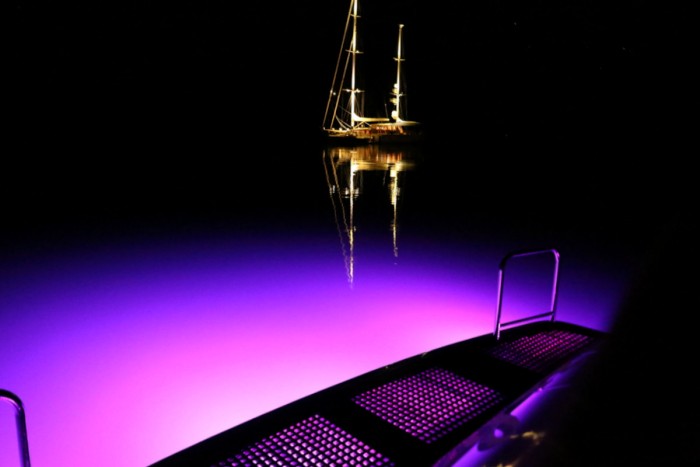
Maine may not have the clarity of Bahamian waters, but you have to say that our new underwater lights look awfully flash. Last night, the sky was clear and dark with not a breath of wind. A 117ft sailing yacht anchored near us so of course we turned on our new lights which cycled through every colour of the rainbow. It’s wonderful to be cruising again. We’ve visited Camden, the island of Vinalhaven and still have much to see. We are now in the middle of wild blueberry season and lobster season with lobster festivals onshore and mega pot buoys offshore. Last week a deckhand on a lobster boat near Friendship, Maine hauled in a 3 ft long 20lb lobster estimated to be 75 years old which they then released.
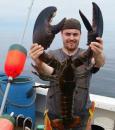 The season has had a slow start which is believed to be caused by the cold water left over from the brutal winter. Just south of the island of Vinalhaven, the sea temperature is still only 12.6 c/53 f.
The season has had a slow start which is believed to be caused by the cold water left over from the brutal winter. Just south of the island of Vinalhaven, the sea temperature is still only 12.6 c/53 f.
Another lucky catch was finding this bubble in a high pressure watermaker hose.
 This would have made quite a mess if it had gone undetected and burst under 800 lbs of pressure. The boys at Front Street Shipyard noticed that the end fitting was incorrect and probably led to the herniation. It was fixed within an hour with the correct fitting and new hose.
This would have made quite a mess if it had gone undetected and burst under 800 lbs of pressure. The boys at Front Street Shipyard noticed that the end fitting was incorrect and probably led to the herniation. It was fixed within an hour with the correct fitting and new hose.
Unlike our last visit to Maine in 2012, there have been no hurricanes this year on the East Coast of the USA….so far. Fingers crossed it stays this way.
Please visit our Photo Gallery for our week in photos.
 The season has had a slow start which is believed to be caused by the cold water left over from the brutal winter. Just south of the island of Vinalhaven, the sea temperature is still only 12.6 c/53 f.
The season has had a slow start which is believed to be caused by the cold water left over from the brutal winter. Just south of the island of Vinalhaven, the sea temperature is still only 12.6 c/53 f.Another lucky catch was finding this bubble in a high pressure watermaker hose.
Unlike our last visit to Maine in 2012, there have been no hurricanes this year on the East Coast of the USA….so far. Fingers crossed it stays this way.
Please visit our Photo Gallery for our week in photos.
My Life in a Shed
31 July 2015 | Belfast, Maine
Vicki – Air 29 C (84 F), 6/8 Puffy Clouds, Wind 15 kn W
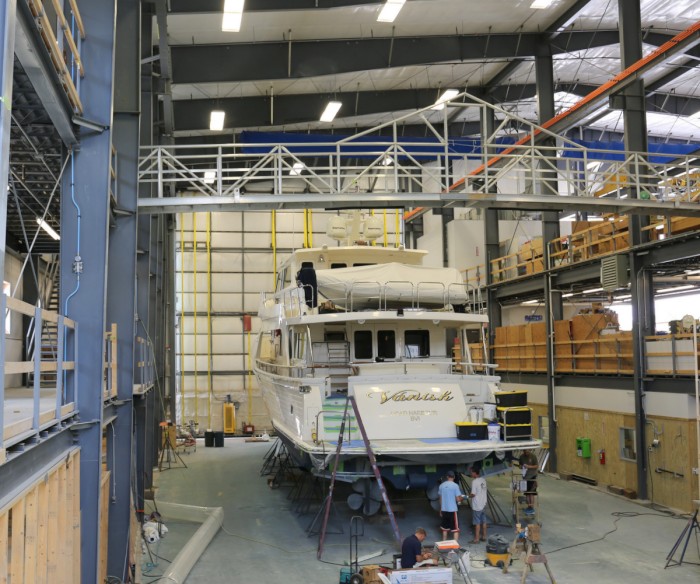
As you may have guessed, we've been rather busy over the last few weeks with little time to put pen to paper or fingertips to blogs as in this case. The annoying drip I'd written about in the 28 June, 2015 blog on the shaft seal which we were monitoring, continued to drip. It changed from a few drips underway to a few drips at anchor. Then the other shaft seal started to do exactly the same thing at the same time within 5 days of the first sign of drips. Now that's strange don't you think? Yes it is. When we experienced a similar problem in the Dominican Republic in 2013, it turned out to be a metallurgical issue according to the manufacturer of the seals, PSS. Surely this couldn't be happening to us again could it?
We'd had a plan, not a hard plan, but it was a plan nevertheless. We would cruise as far north as possible this season and see where we'd end up but you can't head off into remote areas if you have these sorts of issues so we felt it was best to get to the bottom of it. We spent a couple of days at anchor on Roque Island in the shifting fog on the phone to PSS going through various methods of diagnosing the problem, from sanding off the space between the bellows and the rotor to increasing the bellows pressure but nothing changed. Finally after exhausting all tried and true solutions, they suggested going to the Front Street Shipyard in Belfast, Maine, a highly reputable shipyard with fantastic facilities including two lifts of 440 tons and 150 tons and over 100 professionals capable of dealing with a multitude of servicing requirements. To tell you the truth, we haven't hauled Vanish for 2 years and 3 months, the longest we've ever kept a vessel in the water without doing maintenance. Antifouling was done in 2013in the Dominican Republic but we could have gone another 12 months. However, we've been developing a wish list of items to buy, fix and maintain so the prop shaft leak sealed the deal.
Before being hauled out, a very extensive galvanic test was performed on every electrical system on the boat. After an entire day of testing, every system checked properly except for the bow thruster which was putting a rather large amount of current into the water every time it was being used. Once we were washed down, the prop shafts were removed the same afternoon and to our amazement, we saw that both shaft seal rotors were pitted and very corroded. It was determined that the rotor corrosion was galvanic corrosion, most likely the result of the faulty bow thruster. No amount of tightening of the bellows or sanding was going to stop water leaking through this mess. They were rusty and terribly deteriorated in just over two years. Strange! We decided to have new rotors made from a highly corrosion resistant N50 stainless steel. Now we needed to figure out why the thruster was leaking so much voltage.
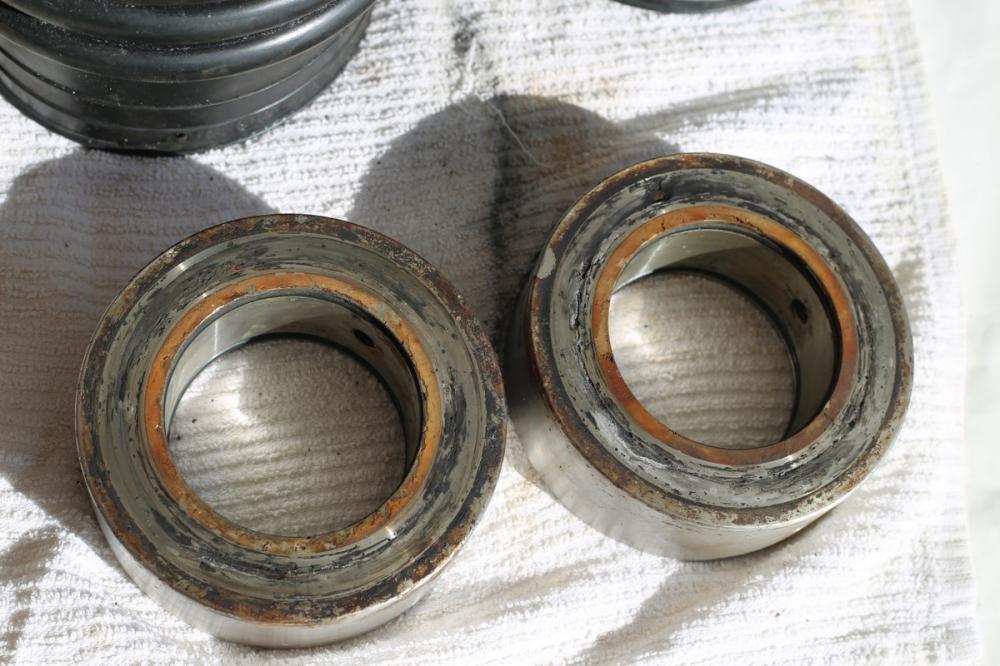
Initially it was thought that the grommets and seals that electrically insulate the bow thruster motor from the water might be faulty. This is actually a fairly common problem so the bow thruster was removed and new seals and nylon washers were put into place.
We'd spent a week living in the shipyard before it was decided to move us into a giant shed to do the bottom paint while we waited for the new rotors to be manufactured. After a very substantial amount of bottom preparation, new antifouling was applied and this time we used American approved Seahorse Biocop TF over a primer. All stainless steel fittings under the waterline and props were spraycoated with Petit Prop Coat Barnacle paint. We also changed the gear box oil in both bow and stern thrusters, and serviced the stabilisers as this hadn't been done for 5 years.
On one of our recent trips, we were sorely outdone in the underwater lighting display put on by practically every power boat in every anchorage in Panama. This was a bit of an indulgence but high on our priority list so it was a good time to install four very powerful OceanLED underwater lights. In perfect water conditions such as the Bahamas, the lights will shine for up to 150 ft. There are around 300 different programs which will make the lights strobe, pulse, and rotate, even to music if we desire it in every colour of the rainbow.
Although we could have stayed in a motel in town we thought we'd be more comfortable on the boat so I will gloss over the unpleasant parts of living in a shed. After a week, we were dropped back into the water and a new galvanic test showed that now the bow thruster was spiking off the chart to the right-hand side but not the left-hand side. This was apparently a key indicator of something but what? More phone calls and much head scratching before the manufacturer asked us if there was any carbon build-up on the bow thruster? We looked and yes there was black powder on the outside of the thruster. The bow thruster 25 hp motor weighing about 150 lb was removed and Mike drove 4 hours to Massachusetts to take it to Imtra Marine, who does all servicing of Sidepower thrusters in the United States. This was becoming more like a detective story than anything else we've encountered so far.
After several hours with the bow thruster motor being completely dismantled, the source of all our problems was revealed. Last year, when we were in Charleston, North Carolina, a severe thunderstorm struck a yacht in our marina. The stray electricity went through the water and destroyed equipment on several nearby yachts including us. We replaced two stern thruster batteries, the bow thruster controller and several fuses but didn't realise that our bow thruster had been compromised as it had been working normally although we only used it once or twice last year. This year, however, we had used the bow thruster a lot while retrieving the anchor and docking. The tech at Imtra said this was a very unusual occurrence as it had destroyed a lot of insulation in several field coils yet had not done enough damage to stop it from working at the full 25 hp. He said this was a very rare event as normally a good lightning strike like this makes it inoperable.
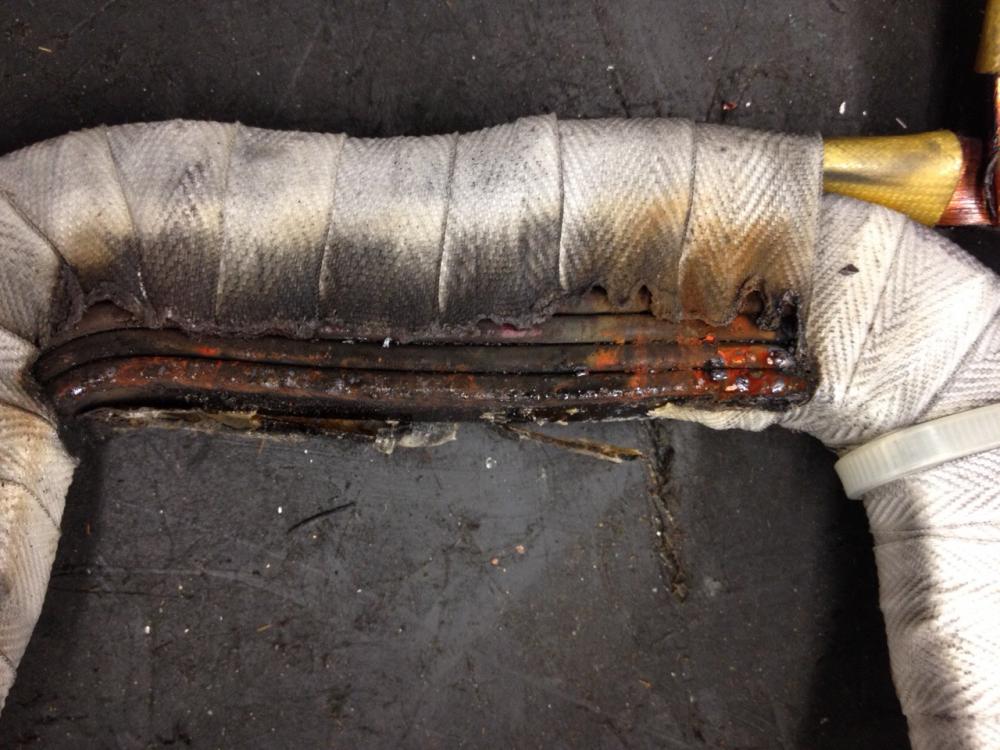
This completely explains the stray current and the high amount of corrosion seen on our shaft seals. We had no choice but to buy a completely new bow thruster motor. After installation of this motor, a galvanic test was re-performed on all of the systems on the boat and no stray current was found from any system. Stray current is an insidious problem as the symptoms from that stray current can show up almost anywhere on the boat and are seldom related to the faulty piece of equipment. Because of this, we purchased a galvanic meter and will now perform a galvanic test over all systems every couple of months on Vanish. Who knew?
We'd had a plan, not a hard plan, but it was a plan nevertheless. We would cruise as far north as possible this season and see where we'd end up but you can't head off into remote areas if you have these sorts of issues so we felt it was best to get to the bottom of it. We spent a couple of days at anchor on Roque Island in the shifting fog on the phone to PSS going through various methods of diagnosing the problem, from sanding off the space between the bellows and the rotor to increasing the bellows pressure but nothing changed. Finally after exhausting all tried and true solutions, they suggested going to the Front Street Shipyard in Belfast, Maine, a highly reputable shipyard with fantastic facilities including two lifts of 440 tons and 150 tons and over 100 professionals capable of dealing with a multitude of servicing requirements. To tell you the truth, we haven't hauled Vanish for 2 years and 3 months, the longest we've ever kept a vessel in the water without doing maintenance. Antifouling was done in 2013in the Dominican Republic but we could have gone another 12 months. However, we've been developing a wish list of items to buy, fix and maintain so the prop shaft leak sealed the deal.
Before being hauled out, a very extensive galvanic test was performed on every electrical system on the boat. After an entire day of testing, every system checked properly except for the bow thruster which was putting a rather large amount of current into the water every time it was being used. Once we were washed down, the prop shafts were removed the same afternoon and to our amazement, we saw that both shaft seal rotors were pitted and very corroded. It was determined that the rotor corrosion was galvanic corrosion, most likely the result of the faulty bow thruster. No amount of tightening of the bellows or sanding was going to stop water leaking through this mess. They were rusty and terribly deteriorated in just over two years. Strange! We decided to have new rotors made from a highly corrosion resistant N50 stainless steel. Now we needed to figure out why the thruster was leaking so much voltage.
Initially it was thought that the grommets and seals that electrically insulate the bow thruster motor from the water might be faulty. This is actually a fairly common problem so the bow thruster was removed and new seals and nylon washers were put into place.
We'd spent a week living in the shipyard before it was decided to move us into a giant shed to do the bottom paint while we waited for the new rotors to be manufactured. After a very substantial amount of bottom preparation, new antifouling was applied and this time we used American approved Seahorse Biocop TF over a primer. All stainless steel fittings under the waterline and props were spraycoated with Petit Prop Coat Barnacle paint. We also changed the gear box oil in both bow and stern thrusters, and serviced the stabilisers as this hadn't been done for 5 years.
On one of our recent trips, we were sorely outdone in the underwater lighting display put on by practically every power boat in every anchorage in Panama. This was a bit of an indulgence but high on our priority list so it was a good time to install four very powerful OceanLED underwater lights. In perfect water conditions such as the Bahamas, the lights will shine for up to 150 ft. There are around 300 different programs which will make the lights strobe, pulse, and rotate, even to music if we desire it in every colour of the rainbow.
Although we could have stayed in a motel in town we thought we'd be more comfortable on the boat so I will gloss over the unpleasant parts of living in a shed. After a week, we were dropped back into the water and a new galvanic test showed that now the bow thruster was spiking off the chart to the right-hand side but not the left-hand side. This was apparently a key indicator of something but what? More phone calls and much head scratching before the manufacturer asked us if there was any carbon build-up on the bow thruster? We looked and yes there was black powder on the outside of the thruster. The bow thruster 25 hp motor weighing about 150 lb was removed and Mike drove 4 hours to Massachusetts to take it to Imtra Marine, who does all servicing of Sidepower thrusters in the United States. This was becoming more like a detective story than anything else we've encountered so far.
After several hours with the bow thruster motor being completely dismantled, the source of all our problems was revealed. Last year, when we were in Charleston, North Carolina, a severe thunderstorm struck a yacht in our marina. The stray electricity went through the water and destroyed equipment on several nearby yachts including us. We replaced two stern thruster batteries, the bow thruster controller and several fuses but didn't realise that our bow thruster had been compromised as it had been working normally although we only used it once or twice last year. This year, however, we had used the bow thruster a lot while retrieving the anchor and docking. The tech at Imtra said this was a very unusual occurrence as it had destroyed a lot of insulation in several field coils yet had not done enough damage to stop it from working at the full 25 hp. He said this was a very rare event as normally a good lightning strike like this makes it inoperable.
This completely explains the stray current and the high amount of corrosion seen on our shaft seals. We had no choice but to buy a completely new bow thruster motor. After installation of this motor, a galvanic test was re-performed on all of the systems on the boat and no stray current was found from any system. Stray current is an insidious problem as the symptoms from that stray current can show up almost anywhere on the boat and are seldom related to the faulty piece of equipment. Because of this, we purchased a galvanic meter and will now perform a galvanic test over all systems every couple of months on Vanish. Who knew?
I Like Buoys
07 July 2015 | Trafton Island, Maine, USA
Vicki– Weather: Air 16 c/60 f, Wind 10kn SW, Sea 8.6 c/46 f , Clouds High Haze/Foglike
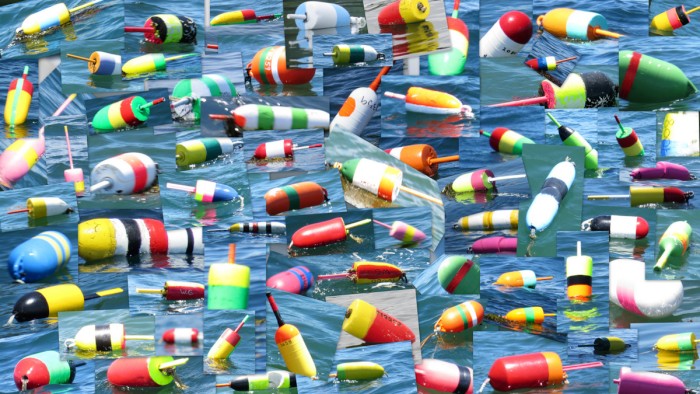
Well we’re definitely back in Buoy Country up here in Maine. The fog, the pot buoys, the screeching seagulls and the seals all have a beautiful and familiar feel to them reminiscent of our previous visit in 2012. So far we haven’t come across as many pot buoys as in 2012 but we still have to be extremely vigilant as the lobstermen have placed them in harbours, anchorages and all navigable passages. I spend a great deal of time racing from side to side taking photos of all of the different styles and colours of buoys while we do everything we can to avoid running over them as we don’t want them getting caught in our props.
We weathered the blow in Quahog Bay over a week ago where we were confined to the boat for a day of horizontal rain and 30 knot gusts of wind. Unfortunately we chose “Mad Max Fury Road” to watch on TV which was a bad choice. It was far more interesting watching the weather outside as we sat in comfort inside in the warmth of Vanish.
We moved over to Rockland, Maine which is one of our favourite towns as we especially like Hamilton’s Marine Store the Puffin Center and a number of restaurants in town such as Café Miranda, Thorndike Cremery, and the Sunfire Mexican restaurant and many other interesting shops and galleries. Kevin, the Marina Manager of Landings Marina told us that the blow we went through a few days ago was like a hurricane at Rockland. He said the wind was out of the east to 40 -45 knots and the docks were heaving so much that it was impossible to walk on them. He said it was the worst blow they’ve had since May 2014. He also went on to tell us that during the 2014/15 winter, Rockland had an average February temperature of -14.4 c/8 f and the entire harbour was iced over out to the rock wall. It’s so hard to imagine but ice breakers were used to make way into the harbor. At nearby Bangor, 139” (3.5 meters) of snow was received for the winter season, the snowiest season in 52 years which is double their normal amount. This might explain why the water temperatures are still so low as the water temp was only 14 c/57 f. At Jonesport, another fishing village we visited, the locals told us they received 30 feet (9 meters) of snow last winter and that temperatures in Alaska were warmer than in their town.
After a few days with 4th July approaching we headed up to Bar Harbor but first we had to pay a visit to David Marlow’s mooring buoy and summer home off Eggemoggin Reach. Earlier we’d contacted him by email hoping he and Barbara were home but he’s such a busy man that we think he was probably overseas at the time. We did a pirouette around the buoy taking happy snaps and continued on with our scenic tour. The following day at Bar Harbor we went ashore for the Independence Day Parade and lunch. In the afternoon we took Oli’s bus tour to the top of 1,500 ft Cadillac Mountain to see the panoramic view of the offshore islands and bays before we headed back and settled ourselves on the foredeck to watch the fireworks. As always, there is much to see and places to explore. With the sea temperature now down to 8.6 c/46 f off Trafton Island I don’t think we’ll be doing any swimming in Maine this cruising season.
Please see Gallery for more photos.
We weathered the blow in Quahog Bay over a week ago where we were confined to the boat for a day of horizontal rain and 30 knot gusts of wind. Unfortunately we chose “Mad Max Fury Road” to watch on TV which was a bad choice. It was far more interesting watching the weather outside as we sat in comfort inside in the warmth of Vanish.
We moved over to Rockland, Maine which is one of our favourite towns as we especially like Hamilton’s Marine Store the Puffin Center and a number of restaurants in town such as Café Miranda, Thorndike Cremery, and the Sunfire Mexican restaurant and many other interesting shops and galleries. Kevin, the Marina Manager of Landings Marina told us that the blow we went through a few days ago was like a hurricane at Rockland. He said the wind was out of the east to 40 -45 knots and the docks were heaving so much that it was impossible to walk on them. He said it was the worst blow they’ve had since May 2014. He also went on to tell us that during the 2014/15 winter, Rockland had an average February temperature of -14.4 c/8 f and the entire harbour was iced over out to the rock wall. It’s so hard to imagine but ice breakers were used to make way into the harbor. At nearby Bangor, 139” (3.5 meters) of snow was received for the winter season, the snowiest season in 52 years which is double their normal amount. This might explain why the water temperatures are still so low as the water temp was only 14 c/57 f. At Jonesport, another fishing village we visited, the locals told us they received 30 feet (9 meters) of snow last winter and that temperatures in Alaska were warmer than in their town.
After a few days with 4th July approaching we headed up to Bar Harbor but first we had to pay a visit to David Marlow’s mooring buoy and summer home off Eggemoggin Reach. Earlier we’d contacted him by email hoping he and Barbara were home but he’s such a busy man that we think he was probably overseas at the time. We did a pirouette around the buoy taking happy snaps and continued on with our scenic tour. The following day at Bar Harbor we went ashore for the Independence Day Parade and lunch. In the afternoon we took Oli’s bus tour to the top of 1,500 ft Cadillac Mountain to see the panoramic view of the offshore islands and bays before we headed back and settled ourselves on the foredeck to watch the fireworks. As always, there is much to see and places to explore. With the sea temperature now down to 8.6 c/46 f off Trafton Island I don’t think we’ll be doing any swimming in Maine this cruising season.
Please see Gallery for more photos.
Nothing Worse Than A Leaky Shaft
28 June 2015 | Quahog Bay, Maine, USA
Vicki & Tech Team – Weather: Air 13c/55f, Wind 30kn gusts E, Heavy Rain, Sea Ruddy Cold
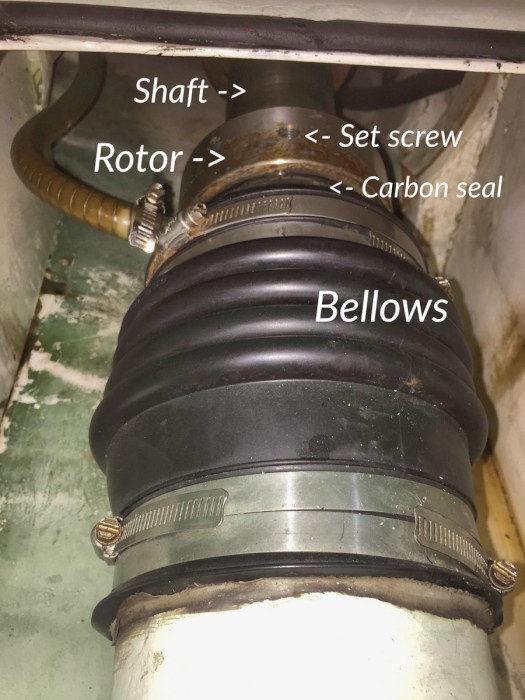
Maynard has always liked a dry boat. Don't we all? When we were faced with the problem with the PSS shaft seals leaking gallons of water per hour back in May 2013 in the Dominican Republic, we had Vanish hauled out. Back then, there was a manufacturing fault with the stainless steel rotors and both seals, so PSS replaced both of our shaft seal sets in entirety. We've had no problems since then until last week when Mike found a small amount of water in the engine room bilge which he traced back to the port shaft seal located under his microwave oven in the crew cabin. He always tastes the water to see if it's fresh or salty to know what kind of problem we have and this was definitely salty.
The shaft seals that PSS makes are "dripless" seals and therefore there shouldn't be any water coming from them at any time. Maynard and Mike did a few elimination tests and some troubleshooting and discovered that the port side bellows and rotor unit measured just over 10 inches and the starboard bellows and rotor unit measured 9 5/8". This may not sound like a big difference but it was obvious that the port side rotor had slid forward considerably and was not providing enough pressure in order to form a good seal. We confirmed this with the PSS technician over the phone who said that over 10 inches is almost no seal at all. This means that if the rotor slid any further forward there would be a substantial amount of water leaking into the boat that would be difficult to stop. Somehow, the set screws that hold the rotor in place had loosened and allowed the rotor to slide forward on the shaft.
Maynard and Mike set to work to figure out a way to get the rotor pushed back aft along the shaft to get the proper compression. This is easier said than done as there is an immense amount of water pressure on the bellows. After about two hours of trying various different ideas involving a shaft collar, zinc, screw drivers, pry bars, and allen wrenches they decided that the only way to solve the issue was to rig up an hydraulic jack that would push the rotor back aft. We have a small Craftsman 2 ton hydraulic jack onboard and with a few modifications it proved to be quite handy.

The boys soon discovered that "canister" hydraulic jacks don't function when they are turned horizontally because this position doesn't allow the pressure to build in the canister as it is "jacked up". They rigged it at an angle so it would function and slowly but surely they were able to push the bellows far enough aft so that a positive seal would be formed between the carbon seal and the rotor. Once the rotor was back in place to 9 5/8" blue Loctite was added to the threads on the set screws and they were tightened to spec. It sounds so easy and straightforward but the shaft seal compartment is located in a small cubby hole with an even smaller access port on top. Only one person can fit in there and a lot of the time three or four hands were needed. The job took Mike and Maynard a total of 6 hours from start to finish, most of which was spent crammed into a small hole. Since the repair, we have gone 3 days at anchor with no water in the compartment and yesterday we turned on the engines and rotated the shaft three times forward and three times backward with no sign of a drip. We will continue to monitor the compartment and see how it responds with a nice long day or two at sea.
Today, the weather has turned cold, wet and windy with driving rain but excellent conditions if you are one of the many seals bobbing around the boat. It's also a good day to watch the latest release of the box office hit Mad Max Fury. The anchor alarm better stay quiet.
The shaft seals that PSS makes are "dripless" seals and therefore there shouldn't be any water coming from them at any time. Maynard and Mike did a few elimination tests and some troubleshooting and discovered that the port side bellows and rotor unit measured just over 10 inches and the starboard bellows and rotor unit measured 9 5/8". This may not sound like a big difference but it was obvious that the port side rotor had slid forward considerably and was not providing enough pressure in order to form a good seal. We confirmed this with the PSS technician over the phone who said that over 10 inches is almost no seal at all. This means that if the rotor slid any further forward there would be a substantial amount of water leaking into the boat that would be difficult to stop. Somehow, the set screws that hold the rotor in place had loosened and allowed the rotor to slide forward on the shaft.
Maynard and Mike set to work to figure out a way to get the rotor pushed back aft along the shaft to get the proper compression. This is easier said than done as there is an immense amount of water pressure on the bellows. After about two hours of trying various different ideas involving a shaft collar, zinc, screw drivers, pry bars, and allen wrenches they decided that the only way to solve the issue was to rig up an hydraulic jack that would push the rotor back aft. We have a small Craftsman 2 ton hydraulic jack onboard and with a few modifications it proved to be quite handy.

The boys soon discovered that "canister" hydraulic jacks don't function when they are turned horizontally because this position doesn't allow the pressure to build in the canister as it is "jacked up". They rigged it at an angle so it would function and slowly but surely they were able to push the bellows far enough aft so that a positive seal would be formed between the carbon seal and the rotor. Once the rotor was back in place to 9 5/8" blue Loctite was added to the threads on the set screws and they were tightened to spec. It sounds so easy and straightforward but the shaft seal compartment is located in a small cubby hole with an even smaller access port on top. Only one person can fit in there and a lot of the time three or four hands were needed. The job took Mike and Maynard a total of 6 hours from start to finish, most of which was spent crammed into a small hole. Since the repair, we have gone 3 days at anchor with no water in the compartment and yesterday we turned on the engines and rotated the shaft three times forward and three times backward with no sign of a drip. We will continue to monitor the compartment and see how it responds with a nice long day or two at sea.
Today, the weather has turned cold, wet and windy with driving rain but excellent conditions if you are one of the many seals bobbing around the boat. It's also a good day to watch the latest release of the box office hit Mad Max Fury. The anchor alarm better stay quiet.
Cloud Appreciation
27 June 2015 | Snow Island, Quahog Bay, Maine, USA
Vicki - Air 18c/64f, Water 14c/57c, Cloud 8/8, Wind 1kn S
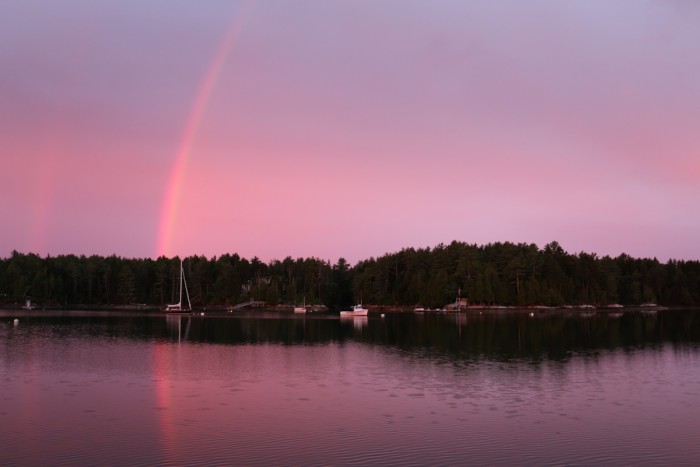
You can’t be in too much of a hurry in Maine. There’s so much to see and do and enjoy here. As a recent new member to the Cloud Appreciation Society based in the U.K., I am madly taking photos of wonderful sunrises and sunsets and the amazing variety of clouds up here. The above photo was taken at 5 a.m. when our cabin lighting turned purple. Why does everything seem to be happening at 5 a.m. these days! I just had to see what was going on outside and was presented with a double rainbow over the nearby moored yacht. We have been out to lunch numerous times from our latest anchorage and completed many maintenance jobs including the bilge leak which we will discuss in the next entry.
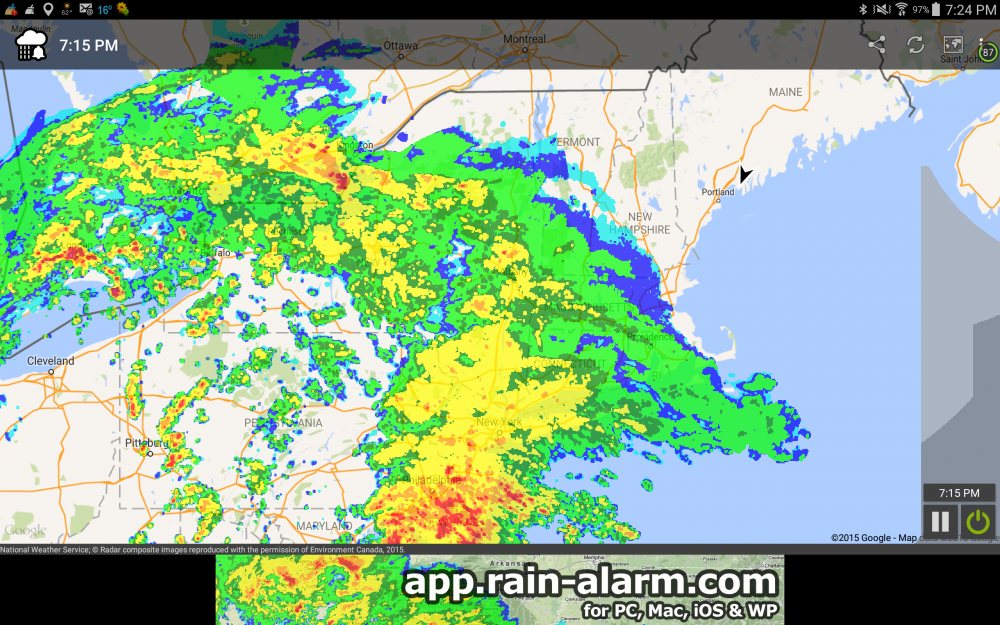
We are currently awaiting a large weather event due to arrive this evening with rain and an easterly wind to 40 knots backing to the west. We’ve brought the dinghy and kayaks onboard, let out more chain. The movies, jigsaws and popcorn await.

We are currently awaiting a large weather event due to arrive this evening with rain and an easterly wind to 40 knots backing to the west. We’ve brought the dinghy and kayaks onboard, let out more chain. The movies, jigsaws and popcorn await.
Uber Fog
23 June 2015 | Boston, Massachusetts, USA
Vicki – Air 16 c/61 f, Water 13 c/55 f, Dense Fog - Visibility 100 m
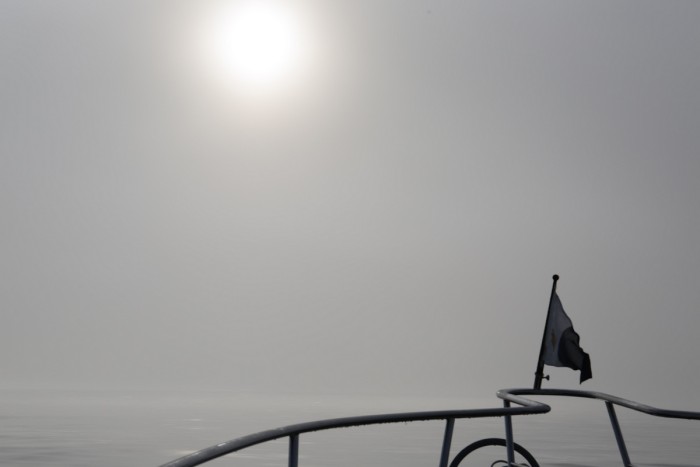
Why? Why can’t it be a nice clear day, darn it! At 5 am, it looks light but dark in our cabin. A peek through the blinds and all I can see is thick dense fog. I can barely see the rock wall 200 feet away across from the dock we’re tied to let alone the green starboard hand mark just outside the marina. Oh well, this is all part of cruising in these latitudes and I just have to get used to it all over again. It’s cold too and for the first time in many weeks, I dig out a pair of socks and shoes and a jumper. We ease ourselves off the dock quietly and glide away into the white misty soup, hoping we can orient ourselves correctly by mentally ticking off all channel markers while looking on the radar for Boston’s high speed ferries and lobster boats. My job is to check Maynard’s navigation on my own Navionics programme on my tablet and spot the lobster buoys in our way. Again, we used our horn a few times to alert others of our presence and after a couple of hours we were out to sea with good visibility again due to another cold front approaching from the WSW.
We were in Boston for a few days after transiting the Cape Cod Canal in brilliant warmth and sunshine. As we’ve been through a couple of times in 2012, the Canal Master already had our details on file. We were blessed with little traffic and a very easy trip through the 8 mile length of the canal which circumvents the need to round Cape Cod. Again, we needed to time our transit on slack tide as the canal has 5 knots of current at its peak. It saves a lot of time and is one of the highlights of travelling by boat in this area. Because we love the sound of our newly improved ship’s horn, we honked it a couple of times at the waving onlookers along the canal’s banks (mostly for our pleasure).
 Low Res.JPG)
When in town, we are always in need of transportation. Hiring a car or finding taxis can be very problematic but the solution for us is to use Uber, a transportation network company based in the US, but now launched overseas. We’ve downloaded the app onto our phones and when we need a ride anywhere, we send out a request on Uber and usually within a few minutes a driver will come by and take us wherever we need to go. No tips and no trickery with clean vehicles all based on a star rated system. If the drivers aren’t up to scratch, they are eliminated from being Uber drivers. If the passengers misbehave, they too are blacklisted. Everybody wins, except the taxi companies. We were able to travel all over Boston looking for groceries, maintenance items and things we needed in a fraction of the time with a fraction of the expense. Oh how I wish I’d invented Uber as this is now a multi-billion dollar money making machine.
We’ve decided to keep pointing north, so Maine, here we come. But what‘s that seawater doing in the bilge under Mike’s microwave oven in the crew cabin?
We were in Boston for a few days after transiting the Cape Cod Canal in brilliant warmth and sunshine. As we’ve been through a couple of times in 2012, the Canal Master already had our details on file. We were blessed with little traffic and a very easy trip through the 8 mile length of the canal which circumvents the need to round Cape Cod. Again, we needed to time our transit on slack tide as the canal has 5 knots of current at its peak. It saves a lot of time and is one of the highlights of travelling by boat in this area. Because we love the sound of our newly improved ship’s horn, we honked it a couple of times at the waving onlookers along the canal’s banks (mostly for our pleasure).
When in town, we are always in need of transportation. Hiring a car or finding taxis can be very problematic but the solution for us is to use Uber, a transportation network company based in the US, but now launched overseas. We’ve downloaded the app onto our phones and when we need a ride anywhere, we send out a request on Uber and usually within a few minutes a driver will come by and take us wherever we need to go. No tips and no trickery with clean vehicles all based on a star rated system. If the drivers aren’t up to scratch, they are eliminated from being Uber drivers. If the passengers misbehave, they too are blacklisted. Everybody wins, except the taxi companies. We were able to travel all over Boston looking for groceries, maintenance items and things we needed in a fraction of the time with a fraction of the expense. Oh how I wish I’d invented Uber as this is now a multi-billion dollar money making machine.
We’ve decided to keep pointing north, so Maine, here we come. But what‘s that seawater doing in the bilge under Mike’s microwave oven in the crew cabin?
False Alarm
17 June 2015 | Mattapoisett, Massachusetts, USA
Vicki – Weather: Air 18c/64f, Water 18c/64f, Sky 6/8 Cirrus Clouds, Wind 30 kn N
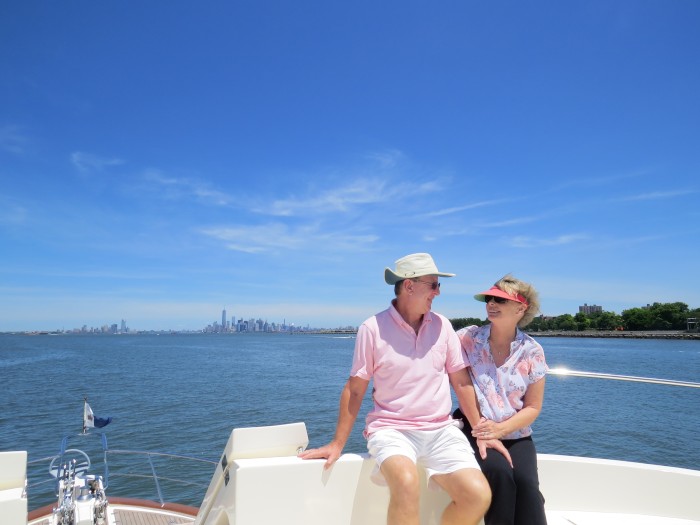
Leaving our gnatty problem behind, we departed Norfolk, Virginia and pointed the bow north again heading for New York. We arrived after two days and one night enjoying a sea of less than a meter. As we move into the higher latitudes, we’re seeing light in the sky before 4.20am with sunrise at 5.00am and sunset at 8.20pm which makes night passages far more enjoyable as it is easier to see other vessels. We stayed at an anchorage south of New York called Atlantic Highlands but we didn’t like all the wash from the ferry traffic nor the exposure to shifting winds plus we had a short weather window so we left on Saturday morning making our way up the Hudson River past all the names you hear of but never expect to see. We passed Coney Island, Brooklyn, Staten Island, then on up the East River past the Statue of Liberty and Ellis Island, Manhattan and the Freedom Tower, the Empire State Building and many famous bridges. We needed to time our passage through New York to pass Hells Gate where the Harlem River meets the East River with a tide race of over 5 knots. As it was, with clear skies after overnight rain, people were out in droves on many sightseeing vessels and their own yachts, and it was quite tricky avoiding fast moving incoming ships, crazy kayakers who took their lives into their hands for a high adrenalin paddle, the commercial mayhem of the Staten Island Ferries, and tugs pushing and pulling barges in the restricted waters. Add to that the noise of helicopters flying overhead and the noise of the city, we were all on constant lookout to ensure we made it through easily. We happened to pass two police boats on the river as well at the Roosevelt Four Freedom Park where Hillary Clinton was making her Presidential campaign launch.
We anchored at another of our favourite spots near Huntington, Long Island called Eatons Neck. It provides all round protection from strong winds and is a great spot to head over to town 1 mile away in the dinghy to see a movie, have dinner or reprovision at Waldbaums. During Hurricane Sandy in 2012, we kept an eye on the wind readings at this spot as we thought it would have been an ideal place to weather the storm. However, as luck would have it, it recorded the highest wind speeds of 92 knots during the storm. We saw no evidence anywhere that the Hurricane had had any effect on the area but residents told us it was really bad. I think we were lucky we weathered Hurricane Sandy in Freeport, The Bahamas. At least it was warm whereas Eatons Neck was slammed with wind then snow. This year It seems much cooler than our previous visit and we are seeing more weather events with two rain cold fronts in the past week.
Another favourite anchorage on Long Island is near the town of Orient, again a very protected quiet spot. Maynard always sets two alarms at anchor before bed. One is the anchor alarm on his Samsung tablet in case we drag anchor and as we had a long day ahead, he set the bedside alarm clock for 6.30am. When an alarm went off, I leapt out of bed like a good Captain’s wife, brushed my teeth, turned on the shower then noticed it was unusually dark outside. Feeling quite rotten, I went back into the cabin where Maynard asked me what on earth I was doing? “Well it’s awfully dark, but aren’t we leaving now?’ “No,” says the Captain. “It’s half past midnight. That was my anchor alarm going off due to a misread of some co-ordinates. I wondered what you were doing in there.” You’ve got to be joking! No wonder I felt as if I hadn’t had any sleep. Back to bed. At least no one can accuse me of being a slouch. We all thought it was pretty funny the next day.
We departed Orient in less than ¼ mile visibility of fog and a temperature of 12 deg c (53 deg f) and headed up to Massachussets, a distance of 86 miles.
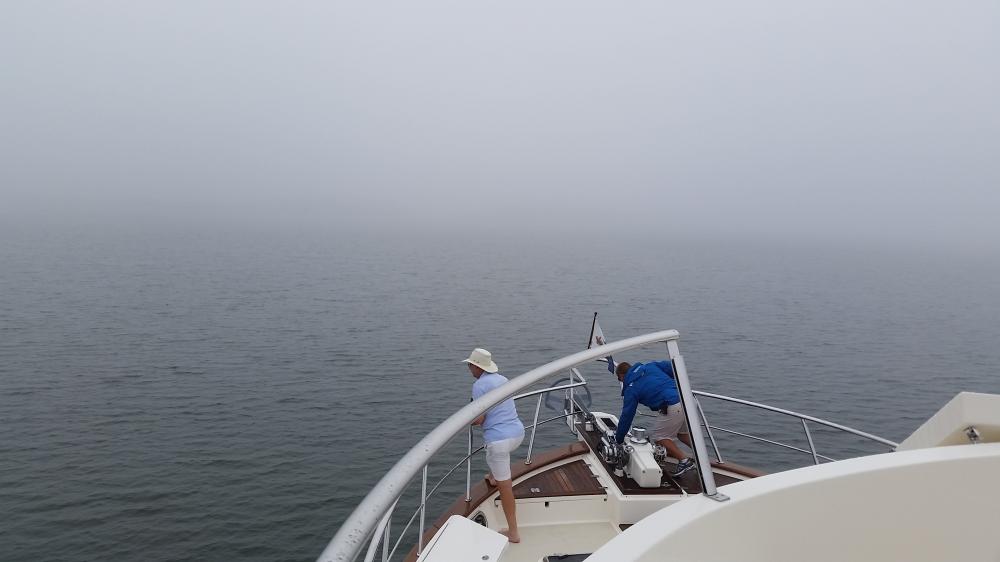
The radar was working overtime with fishing vessels, ferries, day fishermen, sport fisher boats and all manner of radar signatures on the screen. In poor visibility we are supposed to sound our horn for 5 seconds every two minutes to alert other vessels of our position. We haven’t used the horn for 3 years and unfortunately, our first toot sounded like a long agonising honk from a sickly goose that just wouldn’t die as the compressor kept the honk going for at least 20 seconds. We had to resort to ringing our new beautiful functional solid stainless steel ship’s bell numerous times when we’d see a blip on the radar moving fast towards us. Our Marlow bell weighs around 30 – 40 lbs and has a beautiful full lustrous tone in the gloomy fog. It is so loud, one has to wear ear muffs when ringing the bell. After over 6 hours, the fog lifted a little and we saw the spume of a nearby whale. Another front was moving in so by the time we arrived in Mattapoisett, MA, the sun was out but the air was very cool with the impending front which arrived this morning with northerly gusts of 30 knots. Our horn is now fixed and cleaned and in good working order and we are now ready for any further foggy days.
We anchored at another of our favourite spots near Huntington, Long Island called Eatons Neck. It provides all round protection from strong winds and is a great spot to head over to town 1 mile away in the dinghy to see a movie, have dinner or reprovision at Waldbaums. During Hurricane Sandy in 2012, we kept an eye on the wind readings at this spot as we thought it would have been an ideal place to weather the storm. However, as luck would have it, it recorded the highest wind speeds of 92 knots during the storm. We saw no evidence anywhere that the Hurricane had had any effect on the area but residents told us it was really bad. I think we were lucky we weathered Hurricane Sandy in Freeport, The Bahamas. At least it was warm whereas Eatons Neck was slammed with wind then snow. This year It seems much cooler than our previous visit and we are seeing more weather events with two rain cold fronts in the past week.
Another favourite anchorage on Long Island is near the town of Orient, again a very protected quiet spot. Maynard always sets two alarms at anchor before bed. One is the anchor alarm on his Samsung tablet in case we drag anchor and as we had a long day ahead, he set the bedside alarm clock for 6.30am. When an alarm went off, I leapt out of bed like a good Captain’s wife, brushed my teeth, turned on the shower then noticed it was unusually dark outside. Feeling quite rotten, I went back into the cabin where Maynard asked me what on earth I was doing? “Well it’s awfully dark, but aren’t we leaving now?’ “No,” says the Captain. “It’s half past midnight. That was my anchor alarm going off due to a misread of some co-ordinates. I wondered what you were doing in there.” You’ve got to be joking! No wonder I felt as if I hadn’t had any sleep. Back to bed. At least no one can accuse me of being a slouch. We all thought it was pretty funny the next day.
We departed Orient in less than ¼ mile visibility of fog and a temperature of 12 deg c (53 deg f) and headed up to Massachussets, a distance of 86 miles.

The radar was working overtime with fishing vessels, ferries, day fishermen, sport fisher boats and all manner of radar signatures on the screen. In poor visibility we are supposed to sound our horn for 5 seconds every two minutes to alert other vessels of our position. We haven’t used the horn for 3 years and unfortunately, our first toot sounded like a long agonising honk from a sickly goose that just wouldn’t die as the compressor kept the honk going for at least 20 seconds. We had to resort to ringing our new beautiful functional solid stainless steel ship’s bell numerous times when we’d see a blip on the radar moving fast towards us. Our Marlow bell weighs around 30 – 40 lbs and has a beautiful full lustrous tone in the gloomy fog. It is so loud, one has to wear ear muffs when ringing the bell. After over 6 hours, the fog lifted a little and we saw the spume of a nearby whale. Another front was moving in so by the time we arrived in Mattapoisett, MA, the sun was out but the air was very cool with the impending front which arrived this morning with northerly gusts of 30 knots. Our horn is now fixed and cleaned and in good working order and we are now ready for any further foggy days.
Gnat Pretty
12 June 2015 | Norfolk, Virginia, USA
Vicki - Air 27C/80.6F: Water 24C/75F, Clear
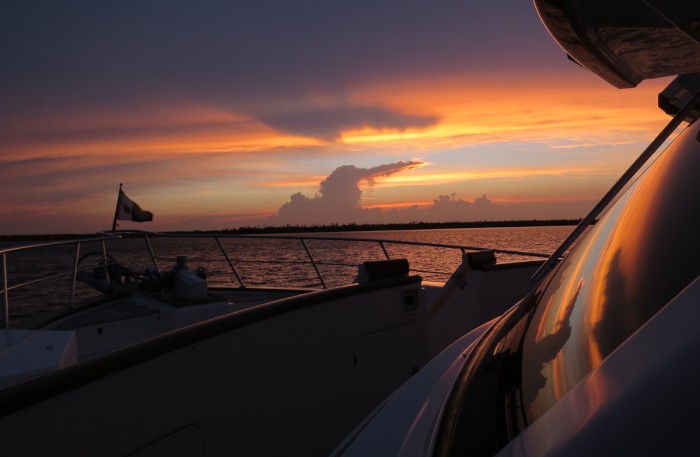
For reasons which have escaped us for now, we thought it would be great fun to enjoy motoring the 208 mile stretch between Beaufort , North Carolina and Norfolk, Virginia via the ICW. We'd never done it before... how hard could it be ...what could go wrong.... blahdy blahdy blah. One of our biggest fears was coming across a barge, like the one shown in the video below, in a narrow channel which the ICW is famous for. Mike too the below video while we were docked at the Jarrett Bay Shipyard near Beaufort. There are many long stretches where the channel is less than 100 feet wide.
ICW Barge Video
So off we headed North along the tree lined waterway in 12 feet of tea coloured swamp water. Parts of it are heavily wooded with pine and cypress while other sections are low flat swampland. We passed many lovely homes and docks where residents obviously enjoy the passing parade of watercraft outside their doors. 57 miles passed with nervous ease on the first day along the Neuse, Bay, Pamlico and Pungo Rivers which flow into Pamlico Sound (west of Cape Hatteras). We anchored for the night at Deep Pungo , the closest town being a pleasantly named Leechville, NC feeling very pleased with our adventure so far.
The following day under bright blue skies, we found ourselves in the straight 20 mile Alligator River - Pungo River Canal following a confident looking down east Duffy boat named "Two's Company", who we dubbed our 'submerged log buster'. We stayed in the middle of the waterway at all times never straying one side or the other for fear of running over fallen trees and stumps lurking below the surface. Trees seem to be constantly falling and rotting away. We could see that the ICW has grown wider over time with erosion as there is no speed limit but sections are controlled with No Wake Zones. We did not pass a single vessel heading south during our 3 days on the ICW. Thank you ICW angels. On the evening of the 2nd night, we anchored at 36 12.2'N;75 56.5'W a beautiful flat anchorage in a wide area of the North River, just north of Albermarle Sound and watched a distant storm followed by a gorgeous sunset (above photo). The past two days had been quite tiring with the intense concentration and hand steering. We did not want to make any mistakes but it turned out that navigation was the least of our problems.
Mike awoke on the 3rd morning at 5am to a very weird sound. He thought it sounded like a high tech fan we'd set up in the salon to bring air throughout the boat so he moved his mosquito netting aside and came up on deck from his crew quarters to see an unforgettable sight. The entire aft deck area was a seething biomass of black swarming blind mosquitoes called midges flies. The sound was like a turbo engine from the millions of midges beating their wings while clinging to Vanish as they busily laid aqua green eggs with gay abandon.
(Turn up the sound on your computer....)
Midges flies video
It was a scene out of some hideous nightmare. The deck was sticky with egg casings. He called Maynard but it was hard for him to breathe as they were buzzing thickly around his head. Maynard bravely went outside and tried to shoo them away with a towel but they went into a frenzy before he and Mike ran to the bow where there was a breeze and fewer midges. The aft bridge deck was also a sea of insects as they covered the dinghy, the outside table, cushions, the kayaks and SUP covers. A few hundred had come inside Vanish which needed to be sought out and destroyed before they laid their eggs and stained our furniture and carpet. Overnight, we'd left one of our aft doors open to catch the breeze although luckily the screen doors were closed. The midges had clumped between the screen door and the now closed aft door to a depth of about 4".
What to do? Maybe they'll fly away if we leave. No. They didn't.
Maybe they'll die fast. No. They didn't.
Let's hose them off. Ok.
Oh no, the writer in her early morning fugh left a tap running, for the first time in her life, by mistake and our tanks were now almost empty. Scrap that idea. We'll have to find a dock with water to wash-down as we can't run the watermaker in this dirty, silty, brackish water. First we have to pass under 5 bridges, 8 swing or lift bridges and negotiate a lock today in order to get ourselves out of this ditch.
To get through all of the bridges, we needed to time our arrival at each of the them by doing around 9 to 10 knots to pass through them at a specific time by radioing ahead to advise our approach. It took calculations and concentration on top of the constant disgusting reminder outside. On we went, weighed down with about a billion midges flies clinging to every previously clean waxed surface on Vanish. But then the dragonflies caught wind of the unprecedented banquet to be had onboard so they too swarmed our boat enjoying the party. The number of dragonflies was astounding. We were an absolute smorgasbord for Earth's food chain. I half expected bald eagles and alligators to join in the party.
As we continued our voyage, discussing how best to deal with this debacle, we were passed by a power boat whose name I won't repeat (even though I'd like to), at too high of a speed. Before this, we didn't think we needed to take all of the sea precautions of bolting down every drawer, door etc. in the ICW nor did we think we needed to engage the stabilisers. The wake he left was the worst we've ever encountered in over 9,000 sea miles. Let's just say we didn't think it was ...... Pure Bliss. A coffee table tipped over, drawers were flung open, a kettle full of hot water spilled all over the galley but worst of all, Mike's full sized fridge in the crew area flew open and spilled its guts onto the lazarette floor. The soft food flew out first followed by the heavy items crushing everything into a colourful paste. Milk, yoghurt, orange juice, tomatoes, split coke cans and sticky donuts. Gee and it's only 8 am. The day is going well so far!
We entered the Great Lock about 10 miles from Norfolk, Virginia and as Tammy, our Lock Tender took our lines to tie us to the side of the lock while the water dropped by 2 ft, she spied our disgusting passengers clinging to our little cruise liner. "Whatcha got there, Vanish?" she said just loud enough for the other couple of boats nearby to overhear. Tammy had never seen anything like it on a pleasure boat in her life. Of course, there was plenty of time to stare at Vanish in the lock as the lock broke down due to debris getting caught in the lock gates. Meanwhile, Mike decided to phone a pest control company in Norfolk and after explaining our predicament was told that this was the worst infestation of midges flies he'd ever heard of in 20 years. He kept saying, "I'm sorry, I'm so sorry," as if he was somehow responsible because he was a Virginian. He said we were the unfortunate victims of a midge fly swarm. He also said they never travel more than ¼ mile from their nest meaning we anchored less than ¼ mile from them in an offshore breeze during a swarming. We were just unlucky.
As we exited the ICW in the Chesapeake Bay, we all cheered as we clicked over 10,000 miles on Vanish since 2012, all of them done by both Maynard and Vicki. Had we been able to go outside and enjoy a bottle of champagne, we would have done so, but instead we slunk our way onto a dock amid a cloud of midges. A few thousand jumped ship along with some very fat dragonflies once they saw their cousins dying en masse under clouds of Baygon. Mike took vengeance with bug spray, a high powered hose, soap, and brushes to wash away the piles of brown bodies mixed with turquoise coloured rivers and puddles of midges goo. 11 hours of work has been invested in the clean-up to date. There is still much to do as the green egg casings have stained some of the gelcoat and teak which will need scrubbing, polish and wax. Vanish will be back to normal in no time.
So is there a moral to this story? No. Not really. Live for today. Life is a wonderful unfolding story especially if you decide to do the ICW.
(For more photos see Gallery 'Gnat Pretty')
ICW Barge Video
So off we headed North along the tree lined waterway in 12 feet of tea coloured swamp water. Parts of it are heavily wooded with pine and cypress while other sections are low flat swampland. We passed many lovely homes and docks where residents obviously enjoy the passing parade of watercraft outside their doors. 57 miles passed with nervous ease on the first day along the Neuse, Bay, Pamlico and Pungo Rivers which flow into Pamlico Sound (west of Cape Hatteras). We anchored for the night at Deep Pungo , the closest town being a pleasantly named Leechville, NC feeling very pleased with our adventure so far.
The following day under bright blue skies, we found ourselves in the straight 20 mile Alligator River - Pungo River Canal following a confident looking down east Duffy boat named "Two's Company", who we dubbed our 'submerged log buster'. We stayed in the middle of the waterway at all times never straying one side or the other for fear of running over fallen trees and stumps lurking below the surface. Trees seem to be constantly falling and rotting away. We could see that the ICW has grown wider over time with erosion as there is no speed limit but sections are controlled with No Wake Zones. We did not pass a single vessel heading south during our 3 days on the ICW. Thank you ICW angels. On the evening of the 2nd night, we anchored at 36 12.2'N;75 56.5'W a beautiful flat anchorage in a wide area of the North River, just north of Albermarle Sound and watched a distant storm followed by a gorgeous sunset (above photo). The past two days had been quite tiring with the intense concentration and hand steering. We did not want to make any mistakes but it turned out that navigation was the least of our problems.
Mike awoke on the 3rd morning at 5am to a very weird sound. He thought it sounded like a high tech fan we'd set up in the salon to bring air throughout the boat so he moved his mosquito netting aside and came up on deck from his crew quarters to see an unforgettable sight. The entire aft deck area was a seething biomass of black swarming blind mosquitoes called midges flies. The sound was like a turbo engine from the millions of midges beating their wings while clinging to Vanish as they busily laid aqua green eggs with gay abandon.
(Turn up the sound on your computer....)
Midges flies video
It was a scene out of some hideous nightmare. The deck was sticky with egg casings. He called Maynard but it was hard for him to breathe as they were buzzing thickly around his head. Maynard bravely went outside and tried to shoo them away with a towel but they went into a frenzy before he and Mike ran to the bow where there was a breeze and fewer midges. The aft bridge deck was also a sea of insects as they covered the dinghy, the outside table, cushions, the kayaks and SUP covers. A few hundred had come inside Vanish which needed to be sought out and destroyed before they laid their eggs and stained our furniture and carpet. Overnight, we'd left one of our aft doors open to catch the breeze although luckily the screen doors were closed. The midges had clumped between the screen door and the now closed aft door to a depth of about 4".
What to do? Maybe they'll fly away if we leave. No. They didn't.
Maybe they'll die fast. No. They didn't.
Let's hose them off. Ok.
Oh no, the writer in her early morning fugh left a tap running, for the first time in her life, by mistake and our tanks were now almost empty. Scrap that idea. We'll have to find a dock with water to wash-down as we can't run the watermaker in this dirty, silty, brackish water. First we have to pass under 5 bridges, 8 swing or lift bridges and negotiate a lock today in order to get ourselves out of this ditch.
To get through all of the bridges, we needed to time our arrival at each of the them by doing around 9 to 10 knots to pass through them at a specific time by radioing ahead to advise our approach. It took calculations and concentration on top of the constant disgusting reminder outside. On we went, weighed down with about a billion midges flies clinging to every previously clean waxed surface on Vanish. But then the dragonflies caught wind of the unprecedented banquet to be had onboard so they too swarmed our boat enjoying the party. The number of dragonflies was astounding. We were an absolute smorgasbord for Earth's food chain. I half expected bald eagles and alligators to join in the party.
As we continued our voyage, discussing how best to deal with this debacle, we were passed by a power boat whose name I won't repeat (even though I'd like to), at too high of a speed. Before this, we didn't think we needed to take all of the sea precautions of bolting down every drawer, door etc. in the ICW nor did we think we needed to engage the stabilisers. The wake he left was the worst we've ever encountered in over 9,000 sea miles. Let's just say we didn't think it was ...... Pure Bliss. A coffee table tipped over, drawers were flung open, a kettle full of hot water spilled all over the galley but worst of all, Mike's full sized fridge in the crew area flew open and spilled its guts onto the lazarette floor. The soft food flew out first followed by the heavy items crushing everything into a colourful paste. Milk, yoghurt, orange juice, tomatoes, split coke cans and sticky donuts. Gee and it's only 8 am. The day is going well so far!
We entered the Great Lock about 10 miles from Norfolk, Virginia and as Tammy, our Lock Tender took our lines to tie us to the side of the lock while the water dropped by 2 ft, she spied our disgusting passengers clinging to our little cruise liner. "Whatcha got there, Vanish?" she said just loud enough for the other couple of boats nearby to overhear. Tammy had never seen anything like it on a pleasure boat in her life. Of course, there was plenty of time to stare at Vanish in the lock as the lock broke down due to debris getting caught in the lock gates. Meanwhile, Mike decided to phone a pest control company in Norfolk and after explaining our predicament was told that this was the worst infestation of midges flies he'd ever heard of in 20 years. He kept saying, "I'm sorry, I'm so sorry," as if he was somehow responsible because he was a Virginian. He said we were the unfortunate victims of a midge fly swarm. He also said they never travel more than ¼ mile from their nest meaning we anchored less than ¼ mile from them in an offshore breeze during a swarming. We were just unlucky.
As we exited the ICW in the Chesapeake Bay, we all cheered as we clicked over 10,000 miles on Vanish since 2012, all of them done by both Maynard and Vicki. Had we been able to go outside and enjoy a bottle of champagne, we would have done so, but instead we slunk our way onto a dock amid a cloud of midges. A few thousand jumped ship along with some very fat dragonflies once they saw their cousins dying en masse under clouds of Baygon. Mike took vengeance with bug spray, a high powered hose, soap, and brushes to wash away the piles of brown bodies mixed with turquoise coloured rivers and puddles of midges goo. 11 hours of work has been invested in the clean-up to date. There is still much to do as the green egg casings have stained some of the gelcoat and teak which will need scrubbing, polish and wax. Vanish will be back to normal in no time.
So is there a moral to this story? No. Not really. Live for today. Life is a wonderful unfolding story especially if you decide to do the ICW.
(For more photos see Gallery 'Gnat Pretty')
The Battery Whisperer
07 June 2015 | Jarrett Bay Marine Industrial Park, Beaufort, North Carolina, USA
Vicki + Tech Team. Weather: Air 25C/77F; Water 26C/79F
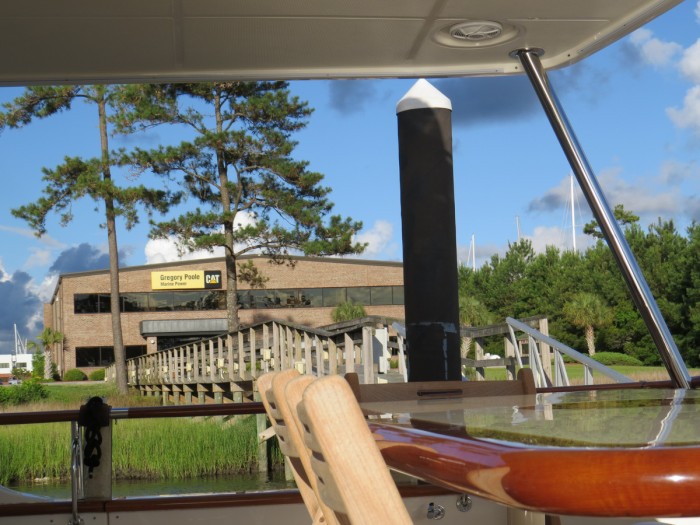
We decided we should head into Beaufort to have the stabiliser pump fixed instead of relying on the one pump for an indefinite amount of time. Gregory Poole the CAT dealer in this area did a great job for us in 2012 when we were last here in the area having our engines serviced. This time, they offered a dock space for us right outside their facility for as long as we needed on Adams Creek on the ICW about 8 miles north of Beaufort . We’ve never traversed any part of the ICW before so this was a new experience for us. For anyone in countries other than the USA who have never heard of the ICW, it is an inland waterway 3,000 miles in length on the Atlantic and Gulf of Mexico coasts used by tugs, barges, sailing and motor yachts of every shape and size. It is supposed to be dredged to a minimum of 12 feet but there are many stories of vessels running aground and others having prop damage by hidden logs. We like the wide open space and safety of the ocean however, there are certain sections of the ICW that are quite safe for us to navigate.
Jarrett Bay Marine Industrial Park is a full service shipyard with 175 acres of boat storage, boat building and all services needed for any vessel. It has at least 6 boat lifts ranging in size from 220 ton down to 50 ton and is very impressive. The hydraulics on the NAIAD stabiliser are driven by a Vickers Vein Pump that is mounted to the Power Take Off (PTO) on the front end of each of our CAT C-18 Engines. When we removed the NAIAD stabiliser pump we found that the splines on both the male end (NAIAD) and the female end (CAT) were stripped. The debate was which part was at fault as the CAT engines are under warranty. After some debate, CAT agreed it was their problem so they replaced the stabiliser pump and the PTO gear. The NAIAD tech we spoke to thought that the check valve cartridges in the manifold may have played a part so they were replaced as well. The engines were started and the pump functioned without any problem. The stabiliser pump problem is fixed for the time being but we will keep a close eye on the splines to see if this occurs again. The Vickers pump that drives the stabilisers can be examined easily, so we’ve added it to the Maintenance Calendar to check it every few months.
Our second job was to fix the raw water pump for the port genset as we’ve had quite a few fail. They either leak oil or they leak water after 300 – 400 hours which is way too fast. We found out that Onan has superseded the original pump. The new one is a bit different with bent inlets and outlets where the original pumps were straight so we had to get a hose kit as well and Mike was able to re-plumb the raw water system so the new pump would function properly. We bought a second pump and hose kit so when the starboard side leaks again we will just replace it. We hope this fixes the problem that has been bothering us all along. Tim at Gregory Poole also recommended doing a 1000 hour valve adjustment on the engines even though the CAT manual says every 3000 hours. All of the valves were within tolerance or slightly loose which is a good thing. We also ran barnacle buster through the raw water system on both engines as it hasn’t been done for a couple of years and it cleaned out the scale and growth.
While anchored last week, each time Maynard started the starboard genset, it would take longer and longer to fire up. Maynard and Mike were concentrating on fuel starvation problems and were talking about it one day in the car on the way to lunch. I piped up and said, “Well it works when we’re plugged into shore power but doesn’t work when we’re on the anchor so maybe it’s something to do with power.” Lo and behold Vicki hit on an idea. Lightbulb moment…it’s a battery problem! Sure enough, the battery was dropping to 9.4 v on startup instead of low 11’s so we then needed to source two new AGM 8d batteries which we achieved on the weekend. They weigh 165 lbs each so it was quite a job to remove the old batteries and install the new ones. I have a hidden talent of feeling when batteries are about to fail as I caught Maynard’s Yacht Controller’s near dead battery last week as well. After sitting for 8 months, it is expected that a boat with so many systems will have issues and only so many systems can be exercised at the dock. We are not at all surprised that a few pumps and batteries need some tlc. All problems seem to be fixed now and we are ready to head off again soon. The decision is whether to pass Cape Hatteras at sea for our third time since 2012, or take on the challenge of the ICW up to Norfolk, Virginia.
Jarrett Bay Marine Industrial Park is a full service shipyard with 175 acres of boat storage, boat building and all services needed for any vessel. It has at least 6 boat lifts ranging in size from 220 ton down to 50 ton and is very impressive. The hydraulics on the NAIAD stabiliser are driven by a Vickers Vein Pump that is mounted to the Power Take Off (PTO) on the front end of each of our CAT C-18 Engines. When we removed the NAIAD stabiliser pump we found that the splines on both the male end (NAIAD) and the female end (CAT) were stripped. The debate was which part was at fault as the CAT engines are under warranty. After some debate, CAT agreed it was their problem so they replaced the stabiliser pump and the PTO gear. The NAIAD tech we spoke to thought that the check valve cartridges in the manifold may have played a part so they were replaced as well. The engines were started and the pump functioned without any problem. The stabiliser pump problem is fixed for the time being but we will keep a close eye on the splines to see if this occurs again. The Vickers pump that drives the stabilisers can be examined easily, so we’ve added it to the Maintenance Calendar to check it every few months.
Our second job was to fix the raw water pump for the port genset as we’ve had quite a few fail. They either leak oil or they leak water after 300 – 400 hours which is way too fast. We found out that Onan has superseded the original pump. The new one is a bit different with bent inlets and outlets where the original pumps were straight so we had to get a hose kit as well and Mike was able to re-plumb the raw water system so the new pump would function properly. We bought a second pump and hose kit so when the starboard side leaks again we will just replace it. We hope this fixes the problem that has been bothering us all along. Tim at Gregory Poole also recommended doing a 1000 hour valve adjustment on the engines even though the CAT manual says every 3000 hours. All of the valves were within tolerance or slightly loose which is a good thing. We also ran barnacle buster through the raw water system on both engines as it hasn’t been done for a couple of years and it cleaned out the scale and growth.
While anchored last week, each time Maynard started the starboard genset, it would take longer and longer to fire up. Maynard and Mike were concentrating on fuel starvation problems and were talking about it one day in the car on the way to lunch. I piped up and said, “Well it works when we’re plugged into shore power but doesn’t work when we’re on the anchor so maybe it’s something to do with power.” Lo and behold Vicki hit on an idea. Lightbulb moment…it’s a battery problem! Sure enough, the battery was dropping to 9.4 v on startup instead of low 11’s so we then needed to source two new AGM 8d batteries which we achieved on the weekend. They weigh 165 lbs each so it was quite a job to remove the old batteries and install the new ones. I have a hidden talent of feeling when batteries are about to fail as I caught Maynard’s Yacht Controller’s near dead battery last week as well. After sitting for 8 months, it is expected that a boat with so many systems will have issues and only so many systems can be exercised at the dock. We are not at all surprised that a few pumps and batteries need some tlc. All problems seem to be fixed now and we are ready to head off again soon. The decision is whether to pass Cape Hatteras at sea for our third time since 2012, or take on the challenge of the ICW up to Norfolk, Virginia.
A Second Chance
02 June 2015 | Cape Lookout, nr Beaufort, North Carolina, USA
Vicki - Weather - Air 25C/77F, Water 24C/75F, Showers
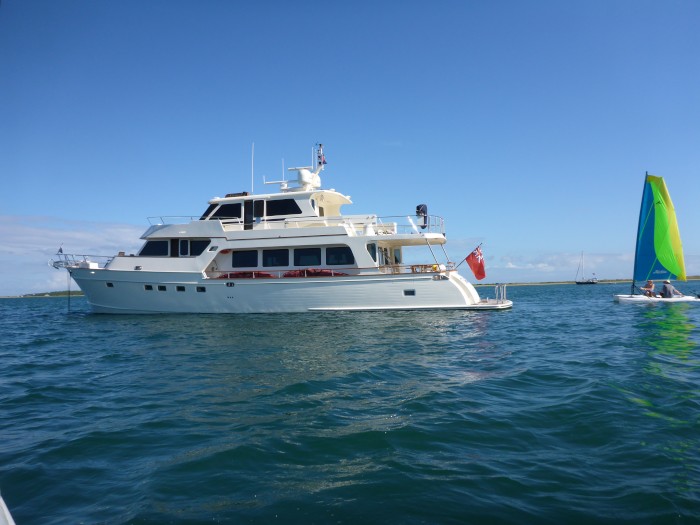
Time just keeps marching on and in the blink of an eye 8 months has slipped by since we last stepped foot on board our lovely Vanish. We certainly didn't mean to be away that long but it was discovered that Maynard had advanced prostate cancer. He became critically ill after a botched biopsy and nearly passed away from septicemia last year. After this event, we found one of the world's best prostate doctors in Brisbane, Australia, Dr. John Yaxley, but he told Maynard to wait 3 months to recover from this deadly blood poisoning before he would remove his prostate. His recovery from the prostatectomy went perfectly and after a further 3 months we were ready to head back to the US. Maynard is now back to full health and feeling better than ever and ready to live his life to the fullest. He is a shining example of how important it is for all men to have regular check-ups and follow up on any numbers which are too high. Find it. Fix it. Move on.
The 2015 cruising season started again just two weeks ago for us as we prepared Vanish for this year's voyage north. During our time away, Mike oversaw all maintenance and various projects, one of which was to fit brand new carpet to the salon, master cabin, bridge and steps up to the bridge. Whilst we love the timber flooring, we love the warmth and comfort of a wool carpet and find that the maintenance is still extremely low as long as no one parties too hard. We decided on 100% Tip Shear Wool Bloomsberg Ivory. Whilst our antifouling is still good after two years, the PropSpeed had completely worn off both props and running gear which had quite a lot of barnacle growth. One day we were once again eating at Cilantros Mexican restaurant and noticed a few fellas at a nearby booth wearing t-shirts with the Domineys Machine and Propeller Shop prop logo. Turns out, they are one of the largest marine propeller shops on the east coast and are located of all places, in Brunswick, Georgia. They put us in touch with a diver from Jacksonville, FL named Ollie Price who polished both props to perfection.
I have to say that without doubt, the Brunswick Landing Marina in Brunswick, Georgia was the perfect spot for us to leave Vanish for such an extended period of time. At Christmas, Mike decorated Vanish with a ton of Christmas lights and we actually won the Christmas Light Competition, a hotly contested event in the marina. The marina sits in a channel only at best 200 feet across with virtually no current, just tidal rise and fall. A large expanse of marshland is on one side and a park area and quiet town is on the other side. People leave their yachts and cars here for months/years with little fear of hurricanes or freezing or snow. We experienced a few close calls with lightning but this is common in an area with such storm activity. Each day we would see either turtles, manatees, dolphins and hordes of fish and flocks of beautiful birds out the window on our T dock. We hired a rental car so it was easy to visit the local fabulous restaurants at Fox's Pizza, Cilantros Mexican, and especially Pam Pam's the best cupcake bakery anywhere.
Within a week, we'd completed the provisioning and Maynard had found a weather window for our trip. As we hadn't anchored out since the previous year, we spent our first night a few miles south of the marina in St. Simons Sound off Jekyll Island so we could thoroughly check all systems before heading out to sea. We encountered a couple of issues on our two day trip up to Beaufort, North Carolina. One of them was a small leak in the portside generator which was solved by replacing the raw water pump with a spare. The next issue we had was during the second day on a routine afternoon watch with seas of 2 - 4 ft when our stabilisers stopped working with no alarm and no warning. We usually run with just one engine during sea passages and have set up the boat to have an hydraulic stabiliser pump attached to each engine. Our starboard stabiliser pump had failed and we were running the starboard engine at the time. The difference in having no stabiliser was pronounced although not hideous as the beam seas were small.
Numerous calls were made to Vic at Naiad to help diagnose our problem. Vic suggested checking all the electronics such as fuses, solenoid etc as the mechanical side of the system seldom fails. After failing to find any electrical problems, we simply switched engines knowing that they are independent and we found that the portside engine worked perfectly suppling pressure to the stabilisers and we then decided to diagnose the problem later once we got to port. This stabilised the boat and gave us time to analyse the problem once we reached the anchorage. It pays to have two of everything.
We were lucky that the seas were kind and as we weren't in a great hurry, we went into the Cape Lookout anchorage near Beaufort for a few days of well-deserved rest and relaxation after our 308 mile journey. While we were back in Australia, Mike severed his achilles tendon while playing basketball in March. He has had to endure surgery and subsequent physio to be able to do this trip with us but he is now wearing his moon boot less often and can do 100% of all that's required to help us. We spent a pleasant 4 days swimming and sailing in this idyllic anchorage, one of the very best on the east coast of the USA and are now heading up the ICW to pay a visit to a CAT dealer for a day or two. Life is very good on Vanish.
The 2015 cruising season started again just two weeks ago for us as we prepared Vanish for this year's voyage north. During our time away, Mike oversaw all maintenance and various projects, one of which was to fit brand new carpet to the salon, master cabin, bridge and steps up to the bridge. Whilst we love the timber flooring, we love the warmth and comfort of a wool carpet and find that the maintenance is still extremely low as long as no one parties too hard. We decided on 100% Tip Shear Wool Bloomsberg Ivory. Whilst our antifouling is still good after two years, the PropSpeed had completely worn off both props and running gear which had quite a lot of barnacle growth. One day we were once again eating at Cilantros Mexican restaurant and noticed a few fellas at a nearby booth wearing t-shirts with the Domineys Machine and Propeller Shop prop logo. Turns out, they are one of the largest marine propeller shops on the east coast and are located of all places, in Brunswick, Georgia. They put us in touch with a diver from Jacksonville, FL named Ollie Price who polished both props to perfection.
I have to say that without doubt, the Brunswick Landing Marina in Brunswick, Georgia was the perfect spot for us to leave Vanish for such an extended period of time. At Christmas, Mike decorated Vanish with a ton of Christmas lights and we actually won the Christmas Light Competition, a hotly contested event in the marina. The marina sits in a channel only at best 200 feet across with virtually no current, just tidal rise and fall. A large expanse of marshland is on one side and a park area and quiet town is on the other side. People leave their yachts and cars here for months/years with little fear of hurricanes or freezing or snow. We experienced a few close calls with lightning but this is common in an area with such storm activity. Each day we would see either turtles, manatees, dolphins and hordes of fish and flocks of beautiful birds out the window on our T dock. We hired a rental car so it was easy to visit the local fabulous restaurants at Fox's Pizza, Cilantros Mexican, and especially Pam Pam's the best cupcake bakery anywhere.
Within a week, we'd completed the provisioning and Maynard had found a weather window for our trip. As we hadn't anchored out since the previous year, we spent our first night a few miles south of the marina in St. Simons Sound off Jekyll Island so we could thoroughly check all systems before heading out to sea. We encountered a couple of issues on our two day trip up to Beaufort, North Carolina. One of them was a small leak in the portside generator which was solved by replacing the raw water pump with a spare. The next issue we had was during the second day on a routine afternoon watch with seas of 2 - 4 ft when our stabilisers stopped working with no alarm and no warning. We usually run with just one engine during sea passages and have set up the boat to have an hydraulic stabiliser pump attached to each engine. Our starboard stabiliser pump had failed and we were running the starboard engine at the time. The difference in having no stabiliser was pronounced although not hideous as the beam seas were small.
Numerous calls were made to Vic at Naiad to help diagnose our problem. Vic suggested checking all the electronics such as fuses, solenoid etc as the mechanical side of the system seldom fails. After failing to find any electrical problems, we simply switched engines knowing that they are independent and we found that the portside engine worked perfectly suppling pressure to the stabilisers and we then decided to diagnose the problem later once we got to port. This stabilised the boat and gave us time to analyse the problem once we reached the anchorage. It pays to have two of everything.
We were lucky that the seas were kind and as we weren't in a great hurry, we went into the Cape Lookout anchorage near Beaufort for a few days of well-deserved rest and relaxation after our 308 mile journey. While we were back in Australia, Mike severed his achilles tendon while playing basketball in March. He has had to endure surgery and subsequent physio to be able to do this trip with us but he is now wearing his moon boot less often and can do 100% of all that's required to help us. We spent a pleasant 4 days swimming and sailing in this idyllic anchorage, one of the very best on the east coast of the USA and are now heading up the ICW to pay a visit to a CAT dealer for a day or two. Life is very good on Vanish.
Sweet Georgia
12 September 2014 | Brunswick, Georgia, USA
Vicki, Maynard, Mike – 95 deg F/35 deg C, Calm, 6/8 Cloud
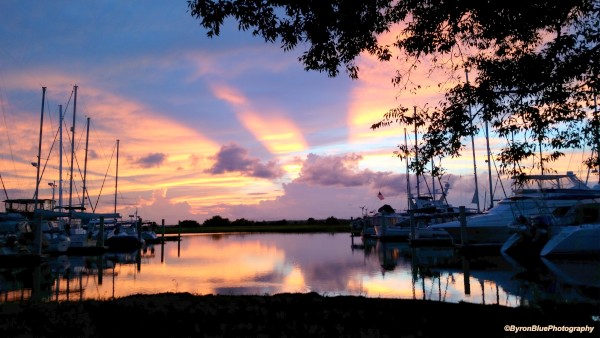
There's no doubt that cutting land ties can be extremely difficult. We recently met a newly retired couple who sold everything except their car, bought a yacht and put their excess worldly goods into two plastic boxes. I know some people can achieve this goal but we are nowhere near this step and probably never will be. In fact, as you have gathered by our lack of blog entries this year, Maynard's work has increased tremendously especially in the USA. Our dream of spending idle hours at anchor in far flung places is still there, but the plan has been temporarily modified. That's life sometimes. Luckily we've been able to use Vanish as our home base so that we can fly/drive to and from the office in Louisiana when necessary.
Vanish was based in Charleston this year for 4 months after we completed the delivery from Freeport in the Bahamas. As we had so much downtime in the USA where one can buy every conceivable consumer item, we thought we would take advantage of this and improve Vanish even more than she already is. Maynard wanted to optimise our anchoring setup. Now that we have our new beautiful shiny Duplex anchor chain, he wanted to have the option of two anchors that were fully functional and wouldn't involve flaking rode or chain into the anchor lockers, whether we were in shallow or deep water anchorages. He and Mike pulled the anchors over to the dock and took all the chain and rope out of both anchor lockers, laying everything out on the dock in Charleston. These are the changes we made in Charleston after installing the Duplex chain:
Port Side: Originally had a Rocna 55 anchor with 150 feet (43m) of ½ inch galvanized chain and 330 ft (100m) of ½ inch rope at the end coiled perfectly so it would all fit in the locker. We changed the rope on this side making it only 30 feet long so we have access to the 150 feet of heavy chain which will be perfect for use in shallow water anchorages where heavy ground tackle and the Rocna anchor will be better. Rocnas are known for their holding ability with short scope.
Starboard Side: Originally had a CQR 180 pound anchor with 330 feet (100m) of Duplex 3/8 inch chain and 100 feet of rope hung on the wall of the anchor locker and could only be accessed after a serious effort. We changed this around so we now have the 330 feet of Duplex chain with 200 feet of ½ inch rope attached to that giving us around 530 feet of total scope that will be more than sufficient for most deep-water anchorages worldwide. This side still has the 180 CQR which we have been very happy with.
The reason we have been so fastidious and careful about our anchor setup is that David Marlow has engineered the anchor chain storage lockers to be well aft of the bow. This is great from a boat performance point of view as it puts all this weight in a more buoyant part of the boat but the lockers do have limits on what can be stored in them. This set up maximises what we can store and requires no human interaction at any stage of anchoring.
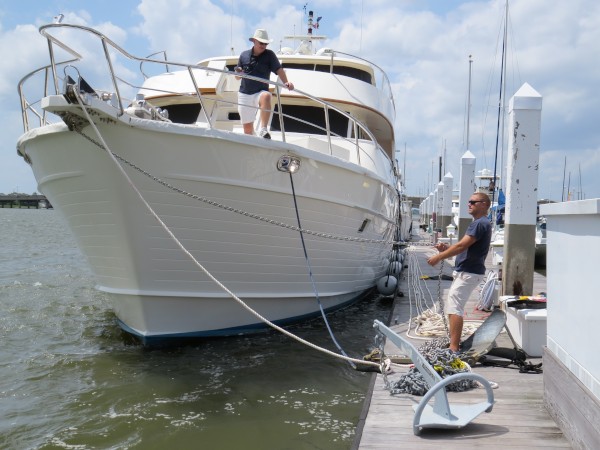
Another project was with regard to the aft deck area. We like to spend time sitting outside for meals, drinkies, socialising etc. It is sometimes too sunny, too windy or raining to sit outside so we found an excellent canvas guy in Charleston (Chet of Waterland Canvas) who installed a sunshade made of a product called AwnTex 120. It is a vinyl encapsulated polyester mesh and provides 90% shade for the entire aft deck. The shade is made into five sections so we can set up whichever screen we need for any particular anchorage or circumstance.
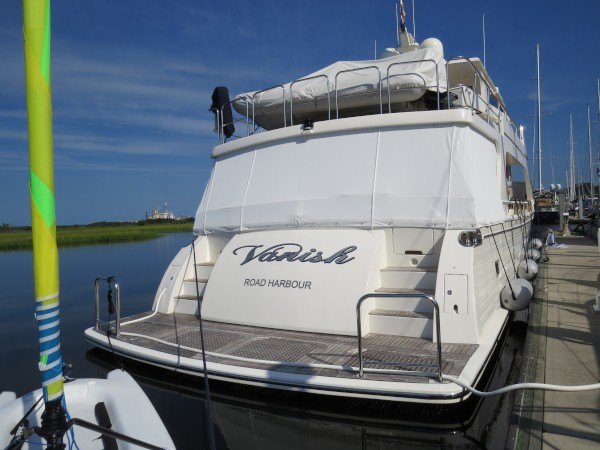
During our stay in Charleston, in the midst of one of many storms, a lightning bolt struck a nearby yacht. The stray electricity in the water entered a couple of nearby vessels including us which, in turn, damaged the electrics in both our bow and stern thrusters, a thruster joystick, and one video camera AV switcher. Luckily, we discovered these well before we left on our next passage during a routine maintenance check.
After analysing the different symptoms of each problem we pulled out the manual and Marlow diagrams to try to find all of the different components throughout the boat. This is sometimes the hardest part as solenoids, fuses, cables, and switches can be well hidden and aren't always right near each other. The bow thruster was non-responsive and in our trials we removed a fuse on one of the solenoids to check if it was good (it was) and reinstalled it. As soon as we did, the solenoid clicked over and reset itself and started working again. The stern thruster had a battery failure and thankfully those batteries are isolated from the house batteries so we just needed to simply replace them. The thruster joystick up on the bridge would not turn off unless it was switched off at the breaker panel so we unplugged the joystick from the stern control station and plugged it in up on the bridge where it functioned perfectly. This apparently was also a result of the lightning damage so we ordered a new one and installed it. Also, the feed from the engine room camera was not coming through the AV switch on the bridge. This is very important when we're at sea because we can see anything abnormal almost instantly. Smoke, major exhaust leaks and water leaks can be spotted easily. There wasn't much to trouble shoot with this so we had to mail the AV switcher to California to get it repaired. Everything that malfunctioned was working perfectly just two weeks earlier during Mike's routine maintenance checks, so we found it hard to blame these issues on anything but the lightning. Other vessels had similar/worse issues from the lightning strike as well.
We are currently keeping an eye on three weather systems in the Atlantic. One is called Hurricane Edouard which is 1,000 miles east of the Leeward Islands. The other two both have a 20% chance of formation. One of these is currently over Florida and the other is off the Cape Verde Islands off Africa. After thoroughly investigating and enjoying Charleston, Myrtle Beach, and Savannah, we motored out of the busy harbour of Charleston last Friday passing the major historic island of Fort Sumter where the first engagement of the Civil War began in 1861. We headed south in overcast weather with rain showers in seas of less than a meter and 10 knots of SE wind. It felt awfully good to be back at sea with the lack of vibes and wide open spaces and provided us with a chance to test ourselves and all boat systems again. We spent the night at anchor near the town of Beufort, South Carolina in a beautiful spot then headed off again the following morning to find our new home for Vanish before unsettled stormy weather arrived. As it was, a low had formed just offshore from us so we were eager to find Vanish's new temporary home in case the low turned into a tropical depression.
Vanish is now in a small protected marina in Brunswick, Georgia. The town hasn't seen a significant hurricane since 1899 so we feel we are in the best possible place to hopefully avoid any tropical activity. The marina is located in a small tributary off the Brunswick River called the East River. There are many yachts in the marina all waiting for the hurricane season to be over. We are at the end of a T dock on a very narrow waterway looking over chartreuse wetland grasses. This morning there was great excitement as we spotted a flock of over 60 flamingoes.......... well after a bit of research .........turns out they weren't flamingos but they were definitely pink birds called roseate spoonbills. There were also great blue herons and other wading birds which were searching for small fish and crustaceans at low tide just opposite the boat in the marshland.
It is very peaceful spot and the town has restaurants and all that we need to reprovision. Unfortunately, we need to leave Vanish again as Maynard is now needed back in Australia. Mike who has been with us for almost 18 months has continued with projects and normal maintenance while we've been in the USA and will continue to do so during this work trip. Vanish has never looked better and we are truly thankful for his help and to have such a well-designed, comfortable, practical vessel which suits us in every way possible and is a perfect home.
(See Gallery for more photos.)
Dodging Bullets
04 July 2014 | Charleston, South Carolina, USA
Vicki - Hot, humid
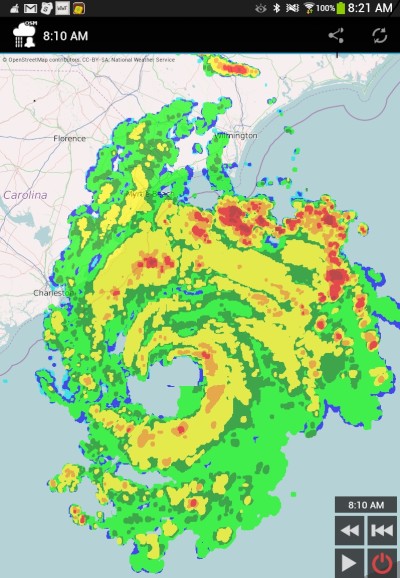
Last weekend Maynard noticed a cluster of thunderstorms which had formed off the east coast of Florida and had the potential of forming into the USA’s first tropical storm. This did in fact occur and luckily for us with Vanish settled in Charleston, Hurricane Arthur passed just to our east as you can see in the above photo. Last night it roared its way between Beaufort and Point Lookout, North Carolina with 100 mph winds and storm surge and is now barrelling offshore along the east coast of the US heading for Yarmouth, Nova Scotia where we visited in 2012. As work has taken a front seat so far this season, we have not yet spent much time on Vanish. Mike, however, prepared the boat for us by tying extra lines and putting out extra fenders in case the hurricane turned west into Charleston. These hurricanes are a constant worry each summer and not something we want to go through again if we can help it. Once our work commitments have lessened, we will be back on board and ready for some anchor time.
One Day At A Time
12 June 2014 | USA
Vicki
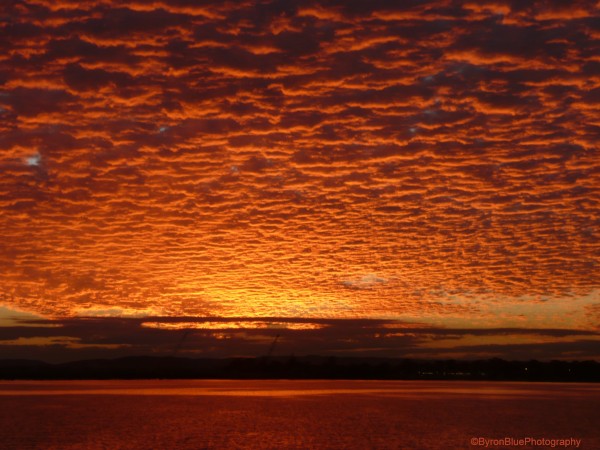
Our blog this season has started out slowly as Maynard has been working in the U.S. meaning that Vanish has had to take a back seat for a few weeks. On top of that, we've experienced two major events in our lives. Firstly, we are now proud Grandparents to Grandchild number six named Charley who we look forward to meeting when we return home. Secondly, Maynard’s younger brother passed away suddenly on June 1 in California. Coping with life events can be difficult at the best of times but it is even harder when we cannot always be where we’re needed the most. We hope to return to Vanish soon to recharge our personal batteries and plan the next stage of our adventure.
Angels & Radars
29 May 2014 | South Carolina
Vicki
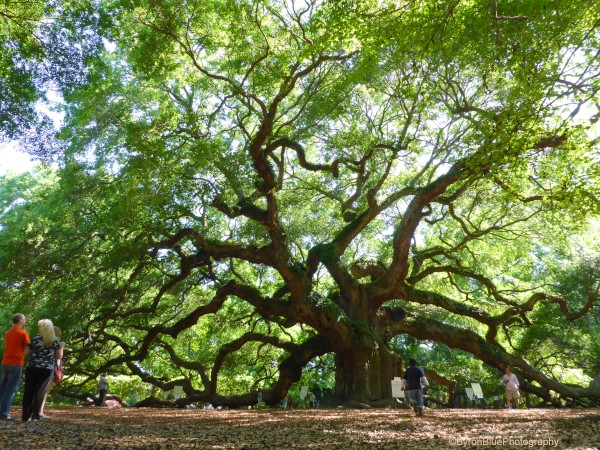
During our visit to Charleston, we visited the above tree named Angel Oak, a live oak estimated to be around 400 years old. Its circumference is 28 ft and its height is 66 ft. It is a beautiful shady tree and has endured many hurricanes in its long life including the most recent Hurricane Hugo in 1989. Some of its limbs are growing along the ground and from tip to tip, the longest branch distance is 187 ft. It was truly impressive and something we love to compare to our large trees on our property at home.
As we rely on our radar systems to guide us safely at night and in tricky situations with fog and poor visibility, it was worthwhile while in the Bahamas for Mike to try to fix a problem with our 12 kw radar which stopped working properly after a series of tremendous lightning storms in Panama (see blog 10 October 2013 Lightning in the Anchorage). We have two Raymarine radar units on Vanish, a 12 kw long range radar and a 4kw short range radar. Since we didn’t know for sure exactly what had happened to the long range radar, it was difficult to try to locate the problem. The only way to diagnose the problem was through a process of elimination. The easiest test was to buy a replacement cable to see if that was the problem. The radar “talks” with the Raymarine Seatalk system with a simple Ethernet Cat 5 cable. But the cable that Raymarine sells runs the power with the Cat 5 cable in one. I wanted to isolate them both to find out if there was a power issue or an info issue. We bought a 25 ft long Ethernet cable from the hardware store in the Bahamas and plugged one end into the “brain” inside the Radar unit and the other through a hatch and into the Seatalk station on the bridge below. Mike fired up the system and lo and behold, the bar started spinning as it was supposed to.
The next step was to order a whole new cable from Raymarine as the input on the Radar unit has a special plug and we couldn’t just run a cable through the hatch. We ordered a 15 meter cable and tested that through the window as well… and it didn’t work! The radar bar was spinning but no information was being transmitted to the screens. After a few hours on the phone with Raymarine Tech Support, they had no idea what the problem might be so their suggestion was to remove the “brain” from the Radome and bring it to a Raymarine service facility where they could test to see if it was operational. Mike had a feeling that this was not the issue so he worked with the settings in the bridge and got it working! Since the Radar was disconnected, the Raymarine system had “forgotten” about the second radar, so he needed to go in and tell the computer to look for it.
The next problem was to run the cable. It’s only about 12 meters from the Bridge control up to the mast but it is a very difficult 12 meters. He had to remove every other panel from the overhead in the bridge and fish the cable inch by inch. It took a full 8 hour day to run the cable the 12 meters! But now we have a fully functioning long range radar and we didn’t have to ship a 50 lb. computer to Raymarine from the Bahamas. Problem solved and great work by Mike.
At Home
17 May 2014 | Charleston, South Carolina, USA
Vicki - Temp 23C (73F), Cloud 1/8, Clear
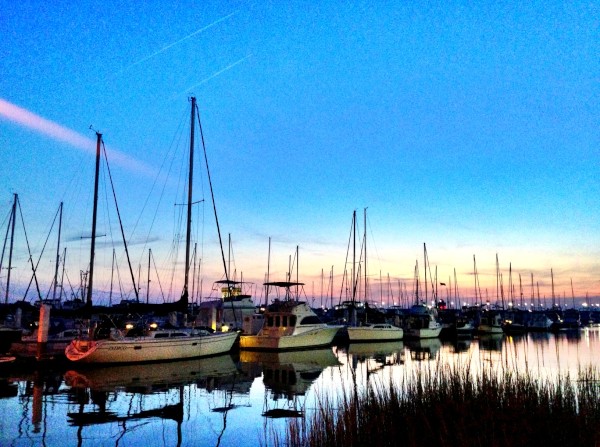
The Gulf Stream provided us with up to 3.7 knots of northward flowing current on our trip from the Bahamas to the USA. The highest temperature we documented of the Gulf Stream was 27.3C (81F), considerably cooler than our voyage north in 2012 when we were being chased by Tropical Storm Debbie. People can joke about how much fuel we power boaters use but you might be surprised to know that the last time we added fuel to Vanish was in Panama in September last year, over 2,000 miles from our current position. We still have over a quarter of a tank of fuel left but we will take on more at this marina as it is so convenient. Our trip to Charleston took less than 48 hours at an average speed of 9 kn with the 3 of us doing 3-1/2 hour watches during the night and 4 hours during the day. We would also get together for lunch and dinner and chat about our various watch experience. On leaving the Bahamas we saw a couple of vessels on AIS heading for Bermuda and Florida but it became quiet with only one ship headed for Africa and another heading for Mexico. As we closed the US, ships started appearing more regularly in all directions but they were easy to track with radar and AIS.
Over the last two years we have been asked several times if there were any changes we would have made to Vanish. Last week we discussed our decision to replace the larger galvanised anchor chain to 3/8" Cromax stainless 318LN. We also felt the need to change out our Microphor toilets in the three guest cabins and the one up on the bridge deck. Microphor toilets use compressed air to power the flush and don't have any mechanical parts which can be a big advantage; however we noticed some irregularities in the flushing cycle when we were at sea. They can also slosh around at sea as water is always in the bowl. This is definitely not a good thing. Our goal has been to create a robust, seagoing vessel that we can trust in remote, harsh environments. We have loved the electric Tecma toilet that we have in the master bathroom so we decided to replace all four of the Microphor heads with brand new Tecma Silence Plus heads. This way we would also have five sets of spares by having the same high quality toilets throughout the boat.
We got quite an expensive quote from the local marine guys in Freeport, so Mike decided that he wanted to take on the challenge of installing the toilets himself. True to form, Marlow had already pre-wired the boat in anticipation that we might want to switch to electric heads at some point. With the help of a local contractor, Mike finished off the electrical and found a way to reroute the plumbing inside of the new Tecma head so it would be compatible with where the black water pipes come out of the deck. With the addition of the necessary 30 amp breakers and a lot of hose clamps we were able to complete a full refit of the toilet system at a fraction of the cost. We are very happy with the result as the toilets are fantastic, and they are also much more efficient than the old Microphors.
Why is it that I fall in love with almost every place I temporarily hang my hat! Charleston has another big tick on my ever-growing list with its friendly safe environment, our marina situation, its rivers, swampland, climate, beautiful homes and oak trees and wonderful downtown area. We're so lucky to always be 'at home' on Vanish no matter what country or town we're visiting and I think that's a huge advantage.
(Above Photo by Mike P)
Southern Charm
12 May 2014
Vicki – Temp 31C, Wind 10 kn SE
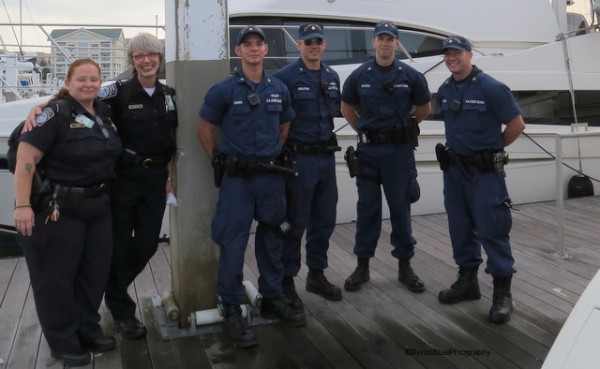
In what seems like a blink of an eye, we have completed our first passage of 2014. All the stars aligned for us and in fact we had 80% moon, 2 to 4 feet following seas, SE winds of 15 to 20 knots and an arrival time where we arrived on slack tide in the early morning daylight hours before the winds increased. But where did we go? Ah, I thought you'd never ask. If you've been following our adventures, you'll know that we make it a priority to stay out of the hurricane zone (as defined by our insurance company) which is between 10 deg and 30 deg north. The decision we needed to make was whether to head south to Panama again, as we loved our season last year, or whether to retrace our steps from the 2012 season. Maynard's work commitments have increased considerably this year, so we decided it was best in the long run to stay in or close to the USA.
Traveling throughout the Caribbean, we have had virtually no interaction with authorities on the water. Because of the constant hassling by the officious US Government authorities in 2012, I was concerned about returning to the USA. In fact, there has been an outcry by residents and international vessels and a lot of discussion about boardings by the Coast Guard and local police which are pretty common place throughout the USA. Apparently, lately there has been an effort to try to improve public perception of these frequent boardings. They are also attempting to improve their database so that the same boat is not boarded multiple times in a short voyage. This has a long way to go because currently, the local police which have also started random boardings, do not co-ordinate with the Coast Guard. In the article we've read, it pointed out that one person's experience in the New York area was that he was boarded 5 times on a short voyage, 4 by 4 different police departments and once by the Coast Guard. In fact, just outside our marina berth, we have seen multiple boardings by the local Sherriff, the local police and very well armed Coast Guard. On the other side of the coin, there is a lot of boat traffic here and we've observed that they are the best behaved boaters we have ever seen.
So, where are we? Charleston, South Carolina. The last time we were here was 18 October 2012 and my blog from that date was less than favourable. We were glad to leave. Imagine our surprise when we arrived at 7 am, tied up at our berth and four Coast Guard and two Customs & Border Patrol arrived to clear us into the USA. We were tired from our voyage and had not had time to clean our vessel or even take a shower. BUT something had changed. All of the Officers smiled, they welcomed us to their country and were genuinely interested in us as people. Most surprising of all, they had done extensive research on Vanish on the internet well before we arrived. They knew of our blog, our experience with racing in the Sydney to Hobart Yacht races and various articles written on us in US boating magazines. We were greatly impressed and the whole clearing in process was easy and efficiently done. While we filled out paperwork, four Officers meticulously opened every cabinet throughout the entire vessel which took a considerable amount of time. We have been to countries known for drug problems within the past 12 months eg. Dominican Republic, Colombia, Panama, Jamaica and the Bahamas so it was not unexpected that we would be checked but we are boring law-abiding vegetarians so we have no problem with their inspections. If the Charleston southern hospitality clearing in process is an example of what to expect this season, we'll be happy campers er.........boaters.
A New Season and A Big Problem Solved
07 May 2014 | Bahamas
Maynard & Vicki - Temp 28C/82F, Wind 10-15 kn SE, Cloud 1/8
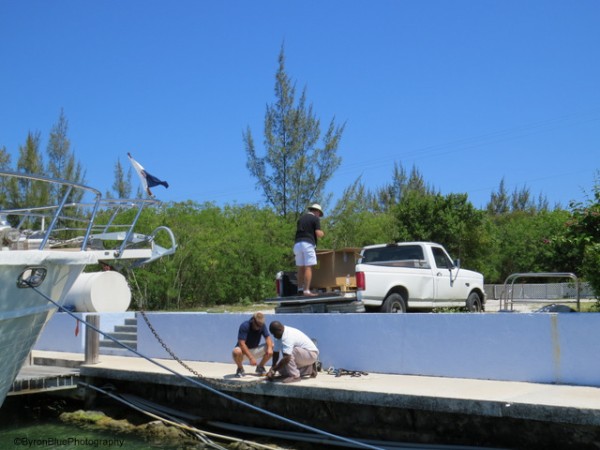
Vanish has performed extremely well for us over the past 2 years. During our trip home, we left a job list which was primarily composed of routine maintenance for Mike to carry out. In addition to these maintenance jobs we had two larger jobs on our "wish list". These were to change out our anchor chain and to replace four guest toilets. Whilst we have anchored in a lot of different conditions and have never dragged anchor, Maynard has not been entirely comfortable with the amount of chain we have carried. With regard to the anchor chain, we carry 70 meters (230 ft) of ½" high tensile G4 galvanised anchor chain with 30 meters (100 ft) of 1" nylon rode. At times this has proved to be inadequate in some of the deeper depths that we encountered in Panama and will encounter in our future travels. Occasionally this particular chain would become very stiff and would form a high pyramid in the anchor locker which always had the potential of jamming the windlass. Because of this piling up, we have restricted ourselves to using 50 meters or less of chain which we acknowledge is sometimes marginal. This always made us slightly nervous as the anchor system wasn't entirely bullet-proof and we often felt we did not have enough chain in any sort of problematic weather. This 70 meters of chain weighs over 270 kg (600 lb). Given the occasional pyramid issue and the weight, Maynard was reluctant to add any more G4 chain to an already heavy bow locker.
After considerable research, we have ordered 100 meters (330 ft) of 3/8" Cromax DUPLEX (318LN stainless) chain. This is highly specialiased (eg. $$$$ expensive) chain made in Bad Edorf, Germany by Ketten Waelder. This chain weighs 40% less than ½" G4 high tensile chain and has a similar breaking strength but costs four times as much. Unlike other chain, it can actually stay submerged in salt water with no negative side effects. It has the slippery shiny quality of stainless steel with superior strength of high tensile galvanised chain and will not form a pyramid. We've had to conduct a lot of research to find proper fittings that are a size that will fit this relatively small chain yet will still have an adequate breaking strength. After much research, we found acceptable shackles made by a company called Titan in Canada. We now have a chain system which is slightly weaker than the bollards we attach the snubbing line to, which holds the chain. We've given this a lot of thought but feel that the effort and expense to put this together will give us comfort at some of the undoubtedly windy and deep water anchorages we may visit.
For our engineering readers the following are specific numbers we used to design our primary ground tackle. Standard ½" anchor chain has a breaking strength of 15,000 lb and ½" high tensile anchor chain has a breaking strength of 26,000 lb. The cost per foot for standard chain is around $7.50 per foot and high tensile galvanised chain is around $10 per foot. Stainless steel 316L ½"- has a breaking strength of 25,000 lb. chain and costs around $16 per foot. Cromax ½" 318LN stainless has a breaking strength of nearly 38,000 lb which is way more than what is required for Vanish. All of these varieties of ½" chain weigh approximately 2.6 lb per foot. It turns out that we could downsize our chain two sizes to 3/8" using Cromax chain and we still achieve a breaking strength of 22,000 lb which is slightly less than the load rating of the bollards which our snubbing lines are attached to. 3/8" Cromax chain weight is 1.5 lb per foot which is over a 43% reduction in weight from a standard ½" chain.
To calculate the load required for our chain, we derived the wind profile from our stability report and published charts and have determined that a 40kn wind exerts approximately 5,500 lb of force on Vanish and a 60kn wind exerts a force of 11,000 lb. 90kn would exert a force of 22,000 lb. In the extremely unlikely case that we experience winds of 60 kn or more, first of all Vicki would be choppered off the boat (just joking), and we would probably use the engines to relieve some of the force on the gear. We would also deploy a least 30 meters of 1" nylon rode which will greatly reduce any shock loads by at least 30 - 50%. We will be using Titan shackles which have a breaking strength of 22,000 lb to attach to our 180 lb Lewmar CQR anchor. For the time being, we are going to keep the 120 lb Rocna anchor attached to 40 meters of high tensile standard ½" chain with 100 meters of 1" nylon rode. Incidentally, the 1" nylon rode has a breaking strength of approximately 30,000 lb. Lastly, we discussed the affect of having lighter chain on the catenary of the ground tackle. Due to the relatively high weight of Vanish and its twin keel configuration shearing is minimal and catenary effect is eliminated in any wind over 25 knots.
Shipping this chain has been a tricky operation as it had to be air freighted from Germany to the USA, bonded in the States then transited while still in bond to the Bahamas and cleared as a replacement part for a "foreign vessel in transit". Lots of paperwork and phone calls. We have the best situation for unloading our old chain and replacing it with the new Cromax as Vanish's bow is just feet from an unused parking lot. It was incredibly easy to take off the old chain and replace it with the new as you can see from the above photo. We look forward to testing our new chain and reporting our findings. Any questions or comments are appreciated and if anyone wants more specific information on the DUPLEX chain go to their website www.swi-tec.us If anyone is still reading this, our next blog will be the story of the changeover of our toilets. Woohoo!! Don't despair ladies, we'll get to the fun things soon enough.
We will be leaving the Bahamas soon, as hurricane season is approaching once again.
(Go to Photo Gallery for more photos.)
Work Horses
03 April 2014 | The Bahamas
by Mike Porter
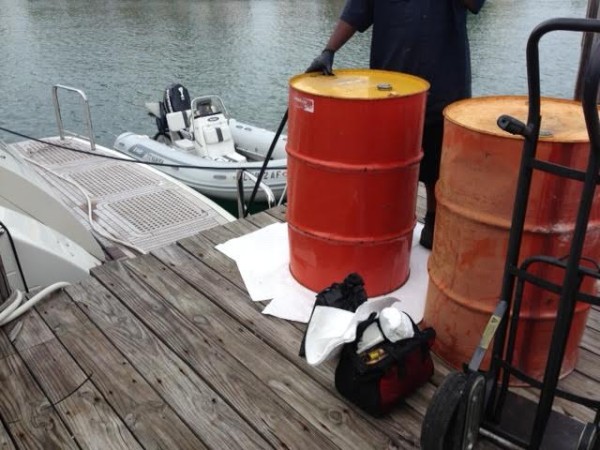
Time has flown by since our last blog around Christmas but of course, work never stops on our Vanish. We haven't had a "Tech Corner" for a while so we thought it might be about time. We have been doing some serious maintenance and minor refits onboard Vanish over the winter season in Freeport, Bahamas. The main piece of major maintenance that we completed was our 1,000 hour service on the main engines. What follows is a brief synopsis of the service and what we learned.
The Caterpillar C18 1000 hour service consists of 5 key tasks:
- Inspect the heat exchangers and change coolant
- Clean and Test the after cooler cores
- Inspect housings and replace sea water impellers
- Inspect the Turbochargers
- Replace the Closed Crankcase Ventilation Filter
We also decided to change the oil on both engines, both generators, and both transmissions while we were at it. We hired an engineer from Bradford Marine in Freeport named Dinyar to help Mike and answer any questions we might have along the way. It was also easiest to get the filters, oil, and coolant through Bradford Marine. We have a Reverso oil change pump that allows us to drain and fill the engines and generators from a quick connect on the swim platform. This makes things a lot easier so we don't have to carry oil cans all over the boat. We are always sure to take an oil sample and send it in to the Caterpillar Research Center in Peoria, Illinois, USA. After draining the oil we replaced all of the Racor filters (2 for each engine and each generator, a total of 8) as well as one fuel and one oil filter on each unit. After refilling the oil we brought the engines and generators up to temperature individually and made sure the oil was at the correct level on the dipstick and all temperatures and pressures were normal.
The ZF transmission oil was extremely clean already but we decided to keep up with manufacturer recommendations and change that. The only difference was that this oil had to be filled with a funnel directly on the unit's fill cap. Next, we drained the coolant from the main engines. It was somewhat difficult to find the lowest point to extract the coolant and the starboard engine had a drain plug slightly lower than the port engine so we got an extra gallon or so out of that engine. Dinyar made it clear that this wasn't a big issue to worry about as the goal was to get the majority out of it. We removed overflow containers and scrubbed them since they had a little sludge residue in them. We refilled the coolant through the fill cap on the top of the coolant reservoir and then filled the overflow containers to the cold line. Again we brought the engines up to temperature and made sure levels and pressures were normal.
Taking off the aftercooler cores would be the biggest task of the whole service because the housings are 2 feet by 3 feet of solid steel. Thankfully the engine room is big enough to allow two people to lift them off. We can't imagine what it would have been like if it were any smaller. There are 34 bolts that need to be removed as well as disconnecting the inlet and outlets. The entire unit is 75 pounds so we had to be very careful to not let it fall, and it is important to remember to close the sea-cock before removal. The next step was to remove the aftercooler core from the housing for cleaning and examination. To clean the core we filled it completely with diluted barnacle buster to remove any growth or scale. After letting it sit for 2 hours we emptied the barnacle buster into a 5 gallon bucket and rinsed it with fresh water. Then we sprayed both sides with fresh water on low pressure, and dried the core using a shop-vac and an air pump we use to fill the fenders. It is important to make sure that there is free air flow through the core and the easiest way to test was to put the air pump on "inflate" and see if you can feel the air blowing through the other side of the core.
We greased the inlet/outlets with a high-temp grease and reinstalled the core into the housing. It was very difficult to reinstall the core onto the engine without ruining the new gasket. With two people, one could guide the core and make sure the gasket wasn't crushed while the other did the heavy lifting.
While we had the sea-cock still closed we figured it was best to inspect and change the sea water impellers. We were very happy to see that both impellers were in great condition and weren't missing a single fin. It is important to inspect the impeller housings for irregular wear or damage, feel the inside with your bare fingers for any grooves or abrasions. The impellers have a thread on the outer end so they are easy to remove with the provided bolt and a socket wrench. Dinyar taught us that when installing a water impeller you should use grease that is dissolvable in water. Silicone based grease resists water and can cause the impeller fins to stick. We used dish soap (Joy to be precise).
Our Cat-18 engines are twin turbocharged, so we had four total turbos to inspect. To inspect the turbo you simply remove the air filter to expose the turbo fan. Grab the center of the fan and spin it, listen for any scraping of the fan against the housing and watch for any irregular motion or wobbling. Then wiggle the turbo fan back and forth and up and down to see if it is loose at all. The fan should spin perfectly and not hit any of the sides. Visually examine for any corrosion or foreign objects. K&N makes a good filter cleaning and oil kit and we are sure to clean and oil the filters whenever we remove them.
Replacing the Closed Crankcase Ventilation filter is simple. All you have to do is remove the clips on the plastic housing, being careful due to there usually being a small amount of oil in the bottom, and take out the old filter and put in a new one. Our engine service went very smoothly and thankfully we didn't have to replace any major parts or have any continued maintenance out of the ordinary. We have been using a fuel additive called Enerburn which is a newer product being used in many types of diesel engines all across the world. Enerburn is a catalyst that is designed to help diesel fuel burn cleaner, reduce engine wear, increase gas mileage, and generally help the engine perform better over a long period of time. You can take a look at the benefits of Enerburn on their website www.enerburn.com. We were very eager to see the results of the oil sample to see if the Enerburn was worth adding.
It turns out our oil sample came back with very good results and the soot and carbon levels were very low even though we did nearly 400 hours since the last service. This is a testament to the Enerburn as well as the ability of the CAT engines themselves to perform at such a high level. We will continue to monitor the engines' performance through these oil samples as often as possible. We are continuing with other maintenance on Vanish before we head off again in the next month or so.
Beer, Parties & Virgins
30 December 2013
Vicki
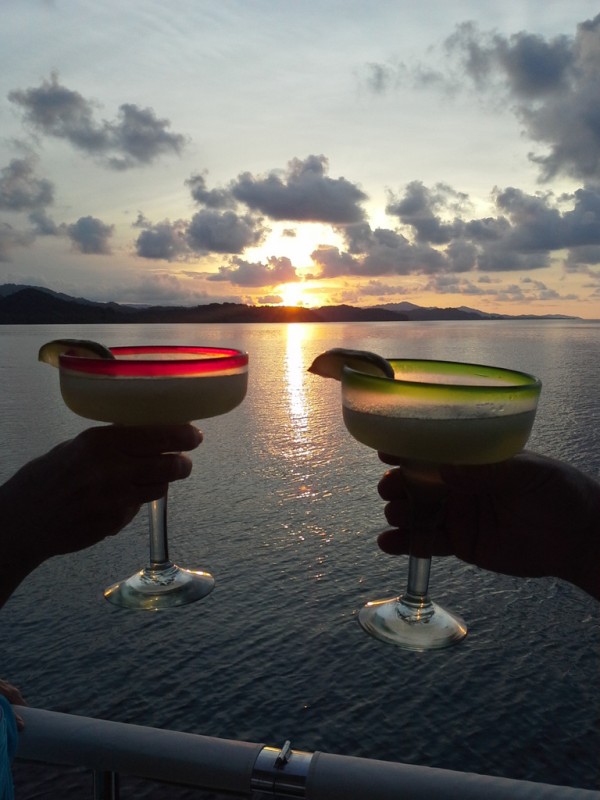
It’s New Year’s Eve and another year has flown by on Vanish. The above photo was taken on sunset in the islands of Kuna Yala in Panama a couple of months ago. It reminds us of all that we enjoyed and achieved in the last few months, from passage making to snorkelling, swimming, peace, sunsets, people, new lands and great adventures. With Vanish safe and sound in the Bahamas and Maynard out of hospital, we decided to fly back home via Virgin Australia for a couple of months. However, Maynard’s vertigo was still causing debilitating problems. It turns out he had a condition called BPV which stands for Benign Positional Vertigo (but the best way to remember it is Beer Parties & Virgins!), something neither of us had ever heard of. As it can reoccur, possibly at sea in a remote area, I decided to try a treatment called the Epley Manoeuvre. This should be done by a specialist, doctor or physio and only takes a couple of minutes. In layman’s terms, by moving his head in a certain sequence, it moves the culprit of the vertigo, a loose crystal in the inner ear to a place where it doesn’t cause the brain to have conniptions. We were lucky and after a day, Maynard had no more vertigo.
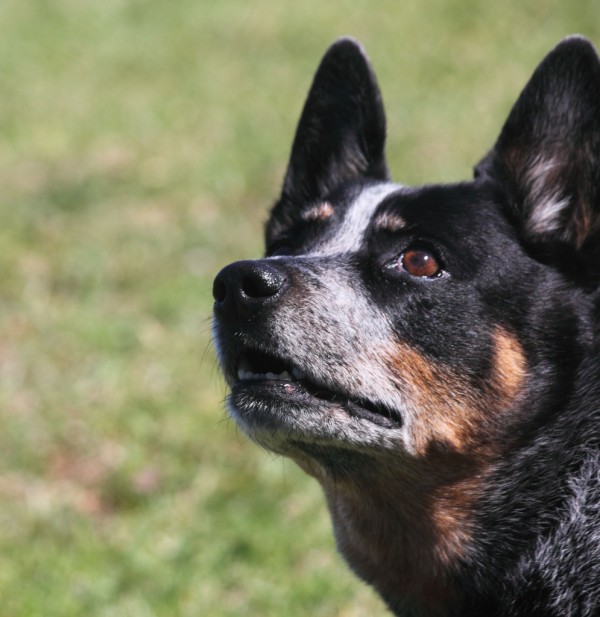
We’re enjoying our time with family and our 12 year old Australian Cattle Dog Bindi. The wild red-necked wallabies on our property have reproduced and have definitely enjoyed their time while we’ve been away with so much grass to eat and few predators. There seems to be well over a 100 on our land.
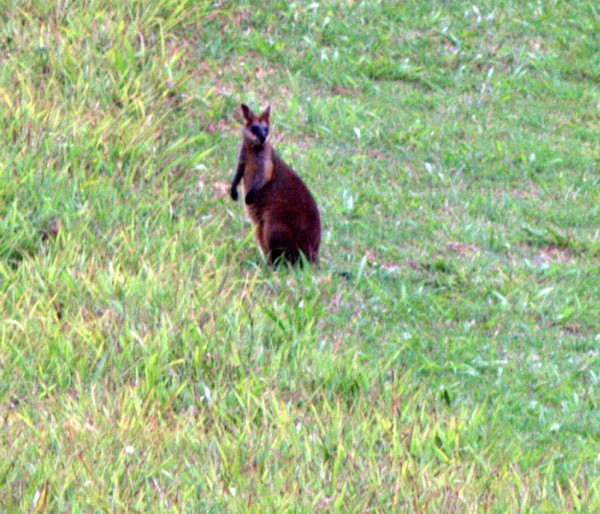
Vanish will be undergoing routine maintenance which Mike will oversee with Maynard’s guiding hand. I will post anything we find interesting for you and thank you for following us in 2013. Have a very Happy New Year and we’ll see you in 2014.
Merry Christmas to Everyone
24 December 2013
Vicki & Maynard
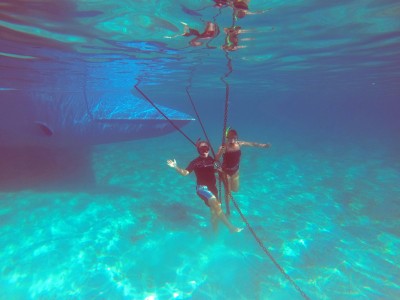
Wishing all our family and friends a very Merry Christmas from the crew of Vanish. For some Christmas cheer, you can watch our latest video of Vicki perforning poi dancing in the dark with her latest high tech poi lights. See Favourites in the Side Bar of this page.
Wide Open Throttle
19 December 2013 | Approaching Grand Bahama, Bahamas
Vicki
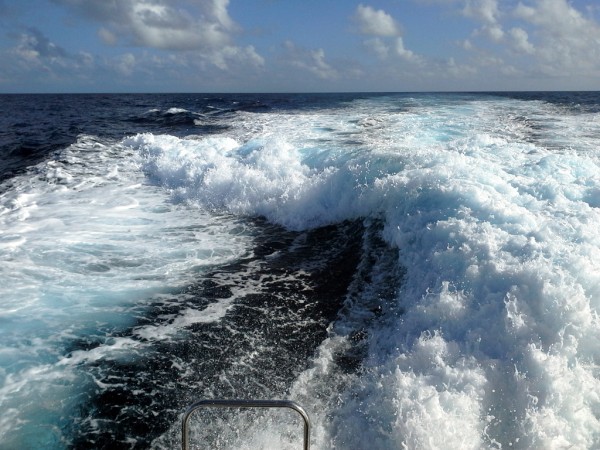
At the end of each long passage we bring both C-18 engines up to full operating temperature. Here we are doing 16 knots at 2,000 rpm for 15 minutes. We do this to ensure that we minimise carbon build up in the turbos as we generally cruise around at a leisurely 8 or 9 knots at 1100 rpm. This low rpm can lead to carbon build-up. We mix a product called Enerburn into our fuel at the rate of 1 gallon of Enerburn per 2,500 gallons of diesel which is supposed to minimise carbon build-up no matter what rpm we run the engines at. We are about to do the 1,000 hour service just after Christmas and in that service, the turbos will be inspected and we'll report back and let you know their condition. Given that Enerburn is a very expensive product, it will be very interesting to see how well it has worked and whether we should continue to use it.
If you look under Favorites to the right of this page in the Side Bar, you will see the latest video of Vanish at near wide open throttle coming into Freeport, Grand Bahama at the end of our passage from Jamaica. (Make sure you turn up the sound on your device.) It looks like we need a few more toys on board, a surfboard, a body board, a tractor tube and maybe and a tow rope and some skis. The video shows the power and speed of Vanish at just over 16 knots turning her two 40 inch props.
http://www.youtube.com/watch?v=00VqJ2sAJXA&feature=youtu.be
A Struggle Home
13 December 2013 | Exumas, New Providence Island, Berry Islands, Grand Bahama the Bahamas
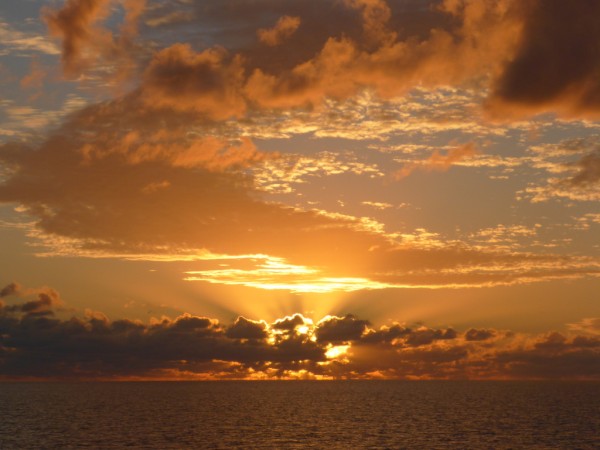
Thank you to everyone who sent wonderful and funny comments regarding our videos. You have spurred us on to try more in the near future if we find other worthy subjects. After the encounter with the rambunctious pigs, we visited the nurse sharks of Staniel Cay in the Exumas, Bahamas which seem to just laze around the marina waiting for scraps the fishermen discard from their catches. There are dozens of them hanging around waiting to be fed. When we were here earlier in the year, we could actually pat the sharks on their heads without getting our hands bitten off which is not something I would try back home. Wherever we anchored near Staniel Cay, one or two nurse sharks would lie under Vanish or circle the boat making us disinclined to swim. We snorkeled over to Thunderball Cave though as we wanted to see it again after our previous visit earlier this year. I spotted a resting nurse shark hidden under a rock overhang but as no other tourists had seen it, I thought it best to keep it to myself as some of the tourists were already quite nervous in the water.
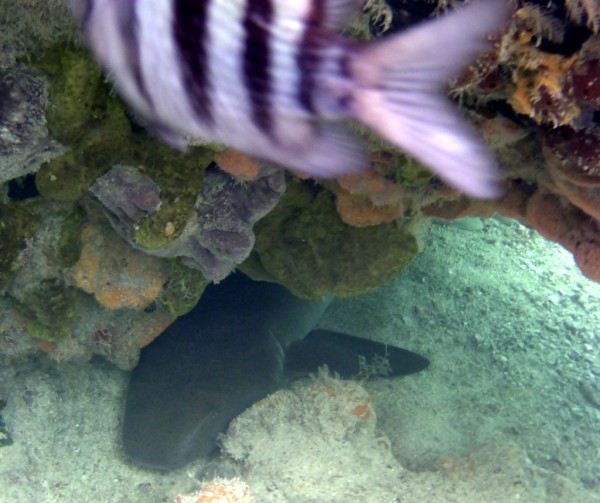
We've now spent 2 weeks cruising the Bahamas. We spent a pleasant day at Shroud Cay where we took the dinghy at high water through the mangrove lined waterway over to the Atlantic Ocean side. The following day we anchored near Highborne Cay before continuing north of the Exumas to New Providence Island where Nassau, the capital of the Bahamas, is located. Maynard wanted to keep moving while the weather held. We anchored at West Bay which is on the north-eastern side of New Providence in a well sheltered bay with a couple of other vessels.
North of New Providence Island are the Berry Islands, a distance of around 60 miles and seas exposed to the North Atlantic Ocean. With 22 knots of wind and associated swell, the seas built to between 3 meters (9 ft) and 4 meters (13 ft) along the contour line where the seabed changed from 3000 meters (9,800 ft) to 20 meters (65 ft). However, it went back down to about 1 meter as we followed the coastline of the Berry Islands and anchored at Bullock Harbour in 2.8 meters of water. Our last sea passage of 60 miles to Freeport on Grand Bahama was ahead of us where we endured Hurricane Sandy last year.
On the morning we were due to leave the Berry Islands, Maynard suddenly had an extremely bad vertigo episode out of nowhere after rolling over in bed. He was disoriented, terribly nauseous but stabilised after an hour and we decided to go ahead and leave. I was concerned as there are serious medical diagnoses with someone with vertigo but after I conducted various tests (I am not a doctor though, just a good nurse!), we decided it was more likely to be an inner ear problem. Maynard rested during the passage but was able to dock Vanish in the marina at Freeport.
We're currently in a very small, quiet marina near Freeport. We have complete access to resort facilities; restaurant, pool, spa, and beach etc and 24 hour security. Maynard was back to normal the day after we arrived but the following day he went downhill fast, so fast that he needed to be hospitalised in Rand Memorial Hospital in Freeport. It was a very traumatic 24 hours trying to cope with emergency room procedures, overworked doctors and lax nurses in an underfunded Government hospital system like nothing we're used to in Australia (which has the best medical care in the World). After many medical procedures, it was determined by his Guyanan doctor that he had a virus which had manifested in his inner ear, our original diagnosis. We never wanted to tick the box of testing out a foreign country's medical system but sometimes you don't get to choose. He's back on Vanish now and feeling 90% which is a great relief.
We've completed 1,536 miles since we left Panama a few weeks ago. Since we departed Freeport in February this year, we've travelled 4,000 miles via Turks & Caicos, Dominican Republic, Colombia, Panama and Jamaica. Vanish will be in Freeport for a while so that we can get annual maintenance done and a few items on our wish list brought over from the USA. It feels great being back in the Bahamas where we feel so comfortable and Vanish is safe and sound.
For more pics, see Photo Gallery.
Such A Pig
07 December 2013 | Big Major Spot Cay, Exuma, The Bahamas
Vicki – Air 25c, Water 25C, Wind 20 kn E, Cloud 4/8
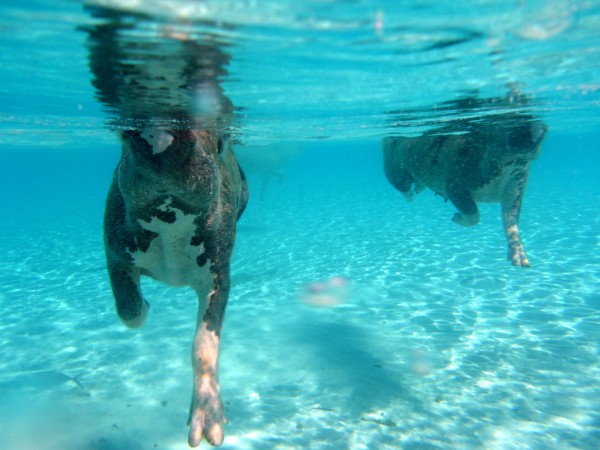
'There was movement in the bushes, for the word had passed around,
That the crew in that there dinghy had some food,
And there wasn't that much time - stomachs never stay that full,
So all the pigs were gathering to the fray."
The word spread like wildfire on the beach through various snorts, grunts and noses held high. Hey, see that new dinghy in town? Those people have our absolute favourite; peanut butter sandwiches! Get out of my way, run across the sand, push the piglets aside, run, I want to be first; now swim, swim like the wind, we're coming, wait for us. Mayhem ensued with pigs swimming in circles around our dinghy as we spread peanut butter onto bread and tossed it into gaping mouths. Bad idea. Throw the bread away from the dinghy to stop the more aggressive beasts climbing in. HEY, don't eat the GoPro you stupid wild galoot! Get OFF our dinghy! Oh geez! A hungry stingray swooped under the lashing pigs trotters as he attempted to forage for scraps as well. Meanwhile, tourists snorkelled through the pigs blissfully unaware that they were firing whoopsies at will and biting each other.
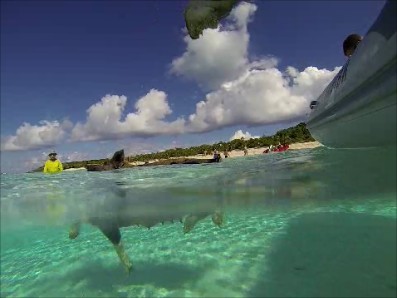
We were now in shallow water and the pigs could easily climb right into our dinghy. If they'd jumped in, we would have jumped out. Maynard started up the engine once he'd ensured there wouldn't be a pig massacre in the prop blades and backed ourselves out of there. It was fast, it was furious, it was fun. The Swimming Pigs of the Exumas. A must see.
Click on Swimming Pigs of the Exumas video under Favorites on the right of this screen page.
Producer: Michael P
Music & Photography by: Vicki
Actors: Alvin, Banjo, Patterson, Babe and the Gang
Song: Allein by Pryda - Eric Prydz Presents Pryda
http://www.youtube.com/watch?v=phAERTk5p0s&list=HL1386451474&feature=mh_lolz
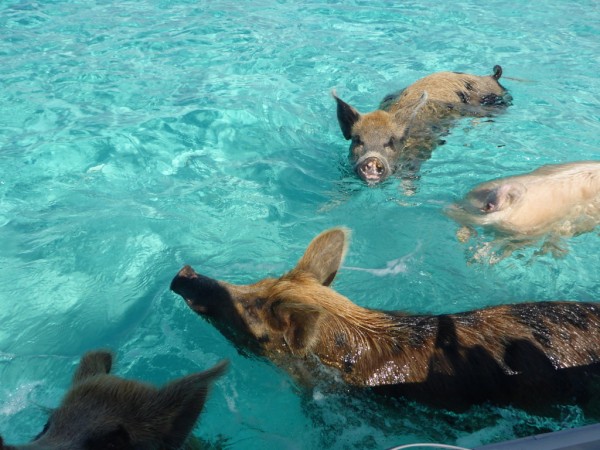
Life's A Beach
05 December 2013 | Black Point, Great Guana Cay, Exumas, The Bahamas
Please enjoy this 2 minute video of life under Vanish. Best viewed on computer screen with music turned up loud.
Photographed & Directed by: Michael P
Actors: Capt Maynard & Rambo the Remora
Music: Vicki
Song: Life's A Beach by Touch & Go
http://www.youtube.com/watch?v=wlHOyi71YZ8&feature=youtu.be
If you are having trouble viewing it, go to the side bar of this page on the right and look under Favorites, then click Life's A Beach and the video should play automatically.
Photographed & Directed by: Michael P
Actors: Capt Maynard & Rambo the Remora
Music: Vicki
Song: Life's A Beach by Touch & Go
http://www.youtube.com/watch?v=wlHOyi71YZ8&feature=youtu.be
If you are having trouble viewing it, go to the side bar of this page on the right and look under Favorites, then click Life's A Beach and the video should play automatically.
Captain Strikes Vanish
03 December 2013 | Black Point, Great Guana Cay, Exumas, The Bahamas
Vicki - Air 25C, Water 25C, Cloud 6/8, Wind 3 kn E
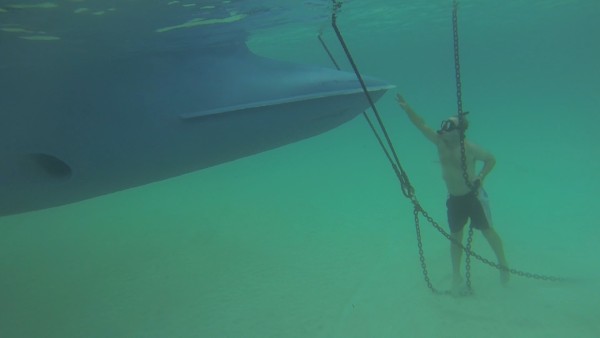
We thought you might like this photo of Maynard standing on the white sands of the Exumas touching Vanish’s bulb this afternoon. We’re anchored in 2.6 m (8 ft) of crystal clear Bahamian turquoise water just before sunset. The bridle snubber is attached to Vanish’s high tensile ½” anchor chain. This is a Gopro screen shot from an upcoming Vanish video for your enjoyment. Stay tuned. Pretty cool eh?
Confessions of a Ship's Captain
01 December 2013 | Departure from Port Antonio, Jamaica Heading for Bahamas
Vicki
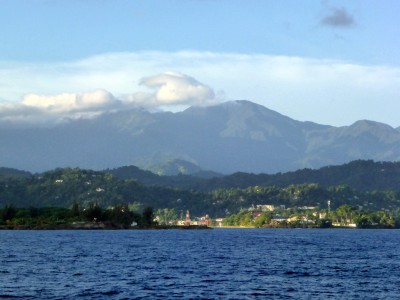
Today is Sunday 1st December 2013 and the Captain 'fessed up this morning over breakfast. Sometimes, too much knowledge is a dangerous thing for the First Mate and knowing me for 32 years, Maynard finally showed me some of the literature he'd downloaded on his e-Pad regarding "The Hole", the SW quadrant of the Caribbean. He was right in keeping such knowledge to himself as I probably wouldn't have been brave enough to head to South and Central America if I knew what he knew. He'd downloaded a book called "A Thinking Man's Guide to Voyages South: The Many Faces of Caribbean Cruising by Frank Virgintino at www.freecruisingguides.com where he said, "Once you enter The Hole, there is no turning back as the size of the seas off Columbia, strength of the wind and current make it near impossible to retrace your steps. This part of the Caribbean has the highest and roughest seas due to the fetch of more than 1,200 miles from the Lesser Antilles and the entire area west of Columbia, and east of Nicaragua can become very dangerous. The area is also VERY remote, rarely visited by cruisers and you are not going to find marinas or repairs easily and finding fresh water can be a challenge." The trip back to the Bahamas is a 1,500 mile upwind journey against the persistent and often very strong North-east trade winds which prevail in the Caribbean. For our Aussie friends, this is a distance equivalent of going from Cairns to Wilsons Promontory in Victoria. Great! Thanks dear!
None of the cruising guides suggested taking the direct route from Bocas del Toro, Panama to Jamaica but if an appropriate weather window appears early in the Trade Wind season, it's definitely the fastest and easiest way to head North. Maynard checks weather sites every day without fail looking for patterns. The most accurate site he's found has been zyGrib.org where he looks at 20 different wind and wave parameters using both the European and American GFS models. In such remote areas, he also uses satellite infrared photographs on intellicast.com. We had considered leaving Vanish in Panama for the winter but the engines and air conditioners need servicing, the 48 mile radar stopped working, and we want to replace 5 of our toilets with Tecma toilets. Having water in the bowl at sea is a big no-no with a rolling or pitching vessel. Michael, who has now been with us for 6 months, is totally trustworthy in completing our job list but doing so in Panama was going to be very difficult. We found a yard in Port Antonia, Jamaica with a 100 ton lift, but the logistics of importing parts and sourcing competent workers was too great so we pushed on.
After arriving in Jamaica, we were quickly tired of the blaring 21 hours per day of onshore music for 3 days straight. We moved 90 miles in an overnight passage onto Port Antonio, Jamaica on the north coast and dropped anchor off the Errol Flynn Marina at 6am. What we didn't expect in this pretty port was the music to be louder that night than Montego Bay. A DJ in the park, 300 feet from Vanish, aimed his speakers towards the Bay and screamed into the microphone until 2am on Monday night. He was in full swing whipping the crowd into frenzied dancing as if they were under the influence of Voodoo magic. It would have been interesting to see but we just weren't in the mood after 5 nights of broken sleep, and we were ready to stick a pin in a Voodoo DJ Doll. We couldn't wait to leave but the clearing out procedure took over 3 hours when the unfriendly Official found that his friendly counterparts in Montego Bay had failed to give us a Cruising Permit (Coastwise Clearance). This simple mistake could have cost us $1000 but Captain Maynard explained patiently how we were inundated with paperwork and many Officials in Montego Bay and that it was just an oversight. One needs to take Ships Papers and Passports when clearing in and out of countries and a great deal of humility, patience, compliments, deference and anything else that gets the process completed as quickly as possible.
The Errol Flynn Marina in Port Antonio was home to only 3 boats in its 35 berths and the Marina Manager was living on one of the boats. We anchored off the marina and, for the first time in our sailing history, were charged $35 a night for the privilege. The chart showed that we were not allowed to anchor inside a large turning circle intended for cruise ships but as cruise ships no longer visit Port Antonio, we had to anchor off the marina. Initially, we were charged $35 per day but on checkout we were charged an extra $10 per day for our third person and these charges did not include rubbish removal or any other marina service.
We'd noticed a rusting yacht anchored in the prime spot off the marina and wondered how he could afford the minimum fee of $35/day and when we asked about it, the marina staff informed us that the yacht 'Imagine' had been anchored there for 20 years. So 365 days/year x 20 years x $35/day = $255,500! Ha, can you Imagine? Good luck retrieving that mate. It was amazing that the vessel had survived hurricanes, theft and scuttling for 20 years. We left Jamaica with Appleton Rum, Jamaica Blue Coffee and a desire to see more of it one day when we had the time.
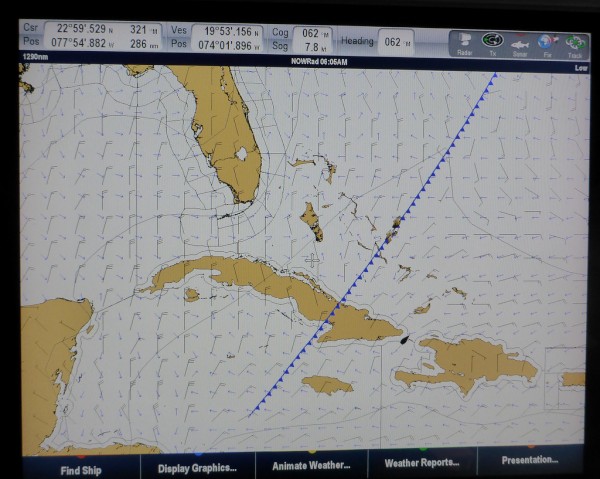
A cold front which created severe weather in the USA was predicted to stall over Western Cuba. This front disrupted the trade winds and created a relatively light wind zone in front of it. It was forecast to be stationery for approximately 24 hours. This was the window we used to get through the notorious 45 mile wide Windward Passage between Cuba on our port side and Haiti off our starboard bow, an area which is often very rough due to strong north-east winds pushing against equally strong currents. Ten hours after departing Jamaica, Maynard had an important Board Meeting at 5pm. Courtesy of our new Fleet Broadband 250 Sat Phone the hour long Board Meeting went smoothly and without a hitch.
During my night watch close to Cuba, after a sliver of moon rose around 2 a.m., I slid open the fly-bridge door to look outside in the dark but my senses could only pick up a dry dusty smell. There were no lights and no activity anywhere even though the chart warned of Minor and Major Operations and a Submarine Surface Transit area. I had no idea until then that Guantanamo (Gitmo) was in this area, where Australian detainee David Hicks was imprisoned for 6 years. We kept our fingers crossed that Vanish had no issues in this area as we would have been in some trouble if we'd needed to stop in either Haiti or Cuba. Off the NE corner of Cuba the seas rose to 3 to 4 meters and the wind shifted from North to East and accelerated to 25 knots causing the seas to be very uncomfortable for around 5 hours. 45 miles past the Windward Passage we were in the lee of the southern-most island of the Bahamas, called Great Inagua Island. As the seas became more settled we realised that we would need to speed up to arrive in Georgetown before Customs and Immigration closed at 5 pm on Friday. It was Thursday and we didn't want to be stuck in quarantine for the weekend. Maynard started both engines and we were doing an average of 9.8 kn SOG.
Around 250 miles from Georgetown in the Bahamas, Maynard watched Mike on the bridge camera looking at something in the engine room for some time. Mike had noticed what appeared to be thick, dark oil spraying from the port prop shaft. There were just a few drops so he wiped it up and re-checked it at the end of his watch where he found a few more drops. The oil seemed to be coming off the ends of the large bolts that connect the prop shaft to the flexible coupling which connects to the transmission. It didn't really make much sense to any of us because there is a seal and a coupling there but no oil reservoir. If the oil were coming from the transmission it would not be dark and would probably spray out further forward of where we observed it.
We decided to blow out the engines and see what would happen with higher RPMs. The centrifugal force ended up extrapolating the issue and quite a bit more oil sprayed from the bolts. There was no way to stop and do any more investigation safely as both props turn even when steaming under one engine. With the engines at normal RPMs there was minimal oil spray so we decided to push on and investigate the problem at anchor.
After successfully clearing into Georgetown by 4pm on Friday afternoon the guys started by removing a fiberglass step over the shaft and were able to reach the shaft seal and the bolts. Two of the eight bolts were extremely loose and both were covered in the dark oil we observed at sea. This was the same prop shaft that we had so much trouble with in Casa de Campo in the Dominican Republic where they used a ton of penetrating oil to try to free the shaft. We think that this is the source of the oil because there is no oil in the whole unit including the shaft, shaft seal, coupling and the housing.
The next issue was to re-tighten the bolts that were loose; they were hex bolts but with a female receptor of about 17 mm in size (see Photo Gallery). As we don't have a 17 mm allen wrench on board, we had to get creative and make our own tool. We found the proper sized bolt that was half threaded and put two nuts on the end so we could get a wrench on it. We tightened all the bolts and cleaned the penetrating oil from the two bolts. This should solve the issue, and is a great way to rotate the prop shafts (which we do monthly as routine maintenance) without having to turn on the engines, a great tip for other Marlow owners. This was the first time we wished that penetrating oil didn't work so well! Crisis averted.
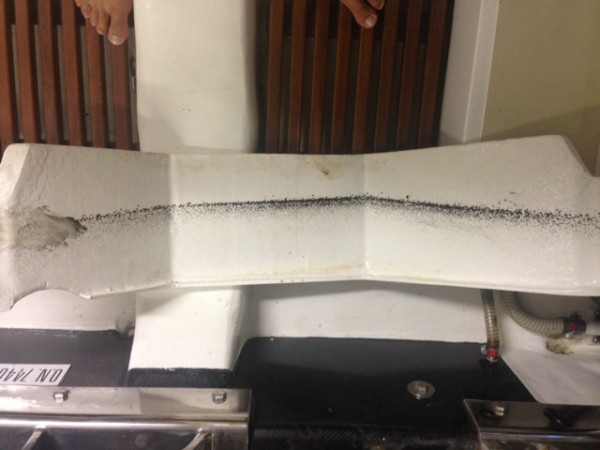
We are now enjoying the delights again of the beautiful Bahamas. The 2013 Atlantic hurricane season was the least active season so far this century and among the quietest on record since 1950. In addition, the 2013 Atlantic hurricane season ended with something that hasn't happened in 45 years. No hurricanes were rated Category 2 or greater in the Atlantic, Caribbean or Gulf of Mexico, the first year without a Cat 2 or stronger hurricane in the Atlantic basin since 1968. The season's lone two hurricanes, Humberto and Ingrid, only reached Cat 1 strength. A happy weather news story is hard to find these days.
We are heading to our old stomping ground Port Lucaya on Grand Bahama where we rode out Hurricane Sandy last year. Our same berth is open for us and we are looking forward to the familiarity and comforts we enjoyed last season.
(For more photos, Click on Photo Gallery)
None of the cruising guides suggested taking the direct route from Bocas del Toro, Panama to Jamaica but if an appropriate weather window appears early in the Trade Wind season, it's definitely the fastest and easiest way to head North. Maynard checks weather sites every day without fail looking for patterns. The most accurate site he's found has been zyGrib.org where he looks at 20 different wind and wave parameters using both the European and American GFS models. In such remote areas, he also uses satellite infrared photographs on intellicast.com. We had considered leaving Vanish in Panama for the winter but the engines and air conditioners need servicing, the 48 mile radar stopped working, and we want to replace 5 of our toilets with Tecma toilets. Having water in the bowl at sea is a big no-no with a rolling or pitching vessel. Michael, who has now been with us for 6 months, is totally trustworthy in completing our job list but doing so in Panama was going to be very difficult. We found a yard in Port Antonia, Jamaica with a 100 ton lift, but the logistics of importing parts and sourcing competent workers was too great so we pushed on.
After arriving in Jamaica, we were quickly tired of the blaring 21 hours per day of onshore music for 3 days straight. We moved 90 miles in an overnight passage onto Port Antonio, Jamaica on the north coast and dropped anchor off the Errol Flynn Marina at 6am. What we didn't expect in this pretty port was the music to be louder that night than Montego Bay. A DJ in the park, 300 feet from Vanish, aimed his speakers towards the Bay and screamed into the microphone until 2am on Monday night. He was in full swing whipping the crowd into frenzied dancing as if they were under the influence of Voodoo magic. It would have been interesting to see but we just weren't in the mood after 5 nights of broken sleep, and we were ready to stick a pin in a Voodoo DJ Doll. We couldn't wait to leave but the clearing out procedure took over 3 hours when the unfriendly Official found that his friendly counterparts in Montego Bay had failed to give us a Cruising Permit (Coastwise Clearance). This simple mistake could have cost us $1000 but Captain Maynard explained patiently how we were inundated with paperwork and many Officials in Montego Bay and that it was just an oversight. One needs to take Ships Papers and Passports when clearing in and out of countries and a great deal of humility, patience, compliments, deference and anything else that gets the process completed as quickly as possible.
The Errol Flynn Marina in Port Antonio was home to only 3 boats in its 35 berths and the Marina Manager was living on one of the boats. We anchored off the marina and, for the first time in our sailing history, were charged $35 a night for the privilege. The chart showed that we were not allowed to anchor inside a large turning circle intended for cruise ships but as cruise ships no longer visit Port Antonio, we had to anchor off the marina. Initially, we were charged $35 per day but on checkout we were charged an extra $10 per day for our third person and these charges did not include rubbish removal or any other marina service.
We'd noticed a rusting yacht anchored in the prime spot off the marina and wondered how he could afford the minimum fee of $35/day and when we asked about it, the marina staff informed us that the yacht 'Imagine' had been anchored there for 20 years. So 365 days/year x 20 years x $35/day = $255,500! Ha, can you Imagine? Good luck retrieving that mate. It was amazing that the vessel had survived hurricanes, theft and scuttling for 20 years. We left Jamaica with Appleton Rum, Jamaica Blue Coffee and a desire to see more of it one day when we had the time.

A cold front which created severe weather in the USA was predicted to stall over Western Cuba. This front disrupted the trade winds and created a relatively light wind zone in front of it. It was forecast to be stationery for approximately 24 hours. This was the window we used to get through the notorious 45 mile wide Windward Passage between Cuba on our port side and Haiti off our starboard bow, an area which is often very rough due to strong north-east winds pushing against equally strong currents. Ten hours after departing Jamaica, Maynard had an important Board Meeting at 5pm. Courtesy of our new Fleet Broadband 250 Sat Phone the hour long Board Meeting went smoothly and without a hitch.
During my night watch close to Cuba, after a sliver of moon rose around 2 a.m., I slid open the fly-bridge door to look outside in the dark but my senses could only pick up a dry dusty smell. There were no lights and no activity anywhere even though the chart warned of Minor and Major Operations and a Submarine Surface Transit area. I had no idea until then that Guantanamo (Gitmo) was in this area, where Australian detainee David Hicks was imprisoned for 6 years. We kept our fingers crossed that Vanish had no issues in this area as we would have been in some trouble if we'd needed to stop in either Haiti or Cuba. Off the NE corner of Cuba the seas rose to 3 to 4 meters and the wind shifted from North to East and accelerated to 25 knots causing the seas to be very uncomfortable for around 5 hours. 45 miles past the Windward Passage we were in the lee of the southern-most island of the Bahamas, called Great Inagua Island. As the seas became more settled we realised that we would need to speed up to arrive in Georgetown before Customs and Immigration closed at 5 pm on Friday. It was Thursday and we didn't want to be stuck in quarantine for the weekend. Maynard started both engines and we were doing an average of 9.8 kn SOG.
Around 250 miles from Georgetown in the Bahamas, Maynard watched Mike on the bridge camera looking at something in the engine room for some time. Mike had noticed what appeared to be thick, dark oil spraying from the port prop shaft. There were just a few drops so he wiped it up and re-checked it at the end of his watch where he found a few more drops. The oil seemed to be coming off the ends of the large bolts that connect the prop shaft to the flexible coupling which connects to the transmission. It didn't really make much sense to any of us because there is a seal and a coupling there but no oil reservoir. If the oil were coming from the transmission it would not be dark and would probably spray out further forward of where we observed it.
We decided to blow out the engines and see what would happen with higher RPMs. The centrifugal force ended up extrapolating the issue and quite a bit more oil sprayed from the bolts. There was no way to stop and do any more investigation safely as both props turn even when steaming under one engine. With the engines at normal RPMs there was minimal oil spray so we decided to push on and investigate the problem at anchor.
After successfully clearing into Georgetown by 4pm on Friday afternoon the guys started by removing a fiberglass step over the shaft and were able to reach the shaft seal and the bolts. Two of the eight bolts were extremely loose and both were covered in the dark oil we observed at sea. This was the same prop shaft that we had so much trouble with in Casa de Campo in the Dominican Republic where they used a ton of penetrating oil to try to free the shaft. We think that this is the source of the oil because there is no oil in the whole unit including the shaft, shaft seal, coupling and the housing.
The next issue was to re-tighten the bolts that were loose; they were hex bolts but with a female receptor of about 17 mm in size (see Photo Gallery). As we don't have a 17 mm allen wrench on board, we had to get creative and make our own tool. We found the proper sized bolt that was half threaded and put two nuts on the end so we could get a wrench on it. We tightened all the bolts and cleaned the penetrating oil from the two bolts. This should solve the issue, and is a great way to rotate the prop shafts (which we do monthly as routine maintenance) without having to turn on the engines, a great tip for other Marlow owners. This was the first time we wished that penetrating oil didn't work so well! Crisis averted.

We are now enjoying the delights again of the beautiful Bahamas. The 2013 Atlantic hurricane season was the least active season so far this century and among the quietest on record since 1950. In addition, the 2013 Atlantic hurricane season ended with something that hasn't happened in 45 years. No hurricanes were rated Category 2 or greater in the Atlantic, Caribbean or Gulf of Mexico, the first year without a Cat 2 or stronger hurricane in the Atlantic basin since 1968. The season's lone two hurricanes, Humberto and Ingrid, only reached Cat 1 strength. A happy weather news story is hard to find these days.
We are heading to our old stomping ground Port Lucaya on Grand Bahama where we rode out Hurricane Sandy last year. Our same berth is open for us and we are looking forward to the familiarity and comforts we enjoyed last season.
(For more photos, Click on Photo Gallery)
By George We've Done It
29 November 2013 | Georgetown, Exumas, The Bahamas
Vicki - Air 26C, Sea 26C, Distant Showers, Wind E 15kn
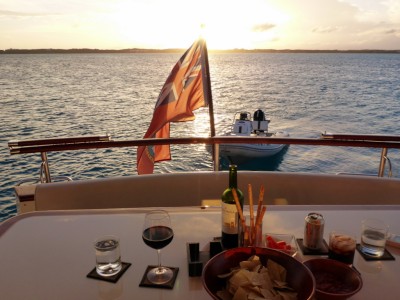
Just to let you know that we’ve arrived safely in Georgetown at the southern end of the Bahamas in the Exumas after a 3 day, two night 500 mile passage straight through from Port Antonio, Jamaica. In total, we have now traveled against the wind 1,250 miles from Panama. We’re watching the sunset celebrating with wine and Panamanian rum. Life is good. We will fill you in on the details once we’re rested and tidy again.
Hip to Zip
25 November 2013 | Port Antonio, Jamaica
Vicki – Air 28C, Water 28C, Showers and occasional thunder, Wind 15 kn E
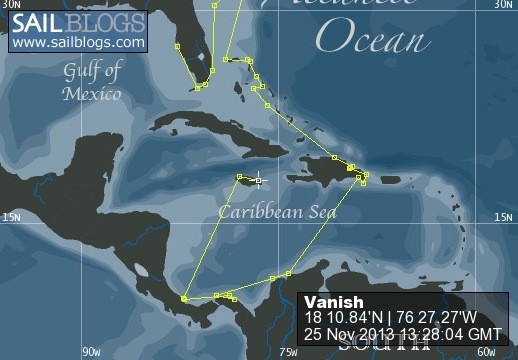
Montego Bay, aka Mo Bay, aka The Hip Strip, loves loud music which seems to come from clubs along the foreshore a long distance away. It was played at full volume for 21 hours a day the entire time we were anchored. With a moderating sea and light winds on Sunday, we opted to weigh anchor and do an overnight passage along the northern coastline of Jamaica heading east towards the protected anchorage of Port Antonio 90 miles away, which you can see on the above map. We also wanted to check out the Errol Flynn Marina at Port Antonio as their website sounded marvellous. We left at 5pm in 0.5 m swell and 2 – 10 knots of easterly wind. We took our normal watches we’ve grown accustomed to over the months. Maynard took the first watch from 7 pm – 10.30 pm, Michael took the second watch of 10.30 pm to 2 am and I took the third watch of 2 am – 5.30 am. Usually, we are all quite busy on each watch scanning the horizon, checking the radar for blips which can indicate fishing vessels or pangas and rain or storms, and we also monitor the infrared camera (FLIR), write a log each hour and scan engine gauges, battery useage, lights and alarms. I used to struggle to stay awake but have taken up the habit of drinking a disgusting can of diet coke which helps enormously. Our watches allow each of us to have up to 7 hours of sleep before the next watch begins.
Last night was particularly exciting as Maynard’s daughter gave birth to her 2nd child in England, our 5th Grandchild named Oliver. Thanks to the good work of Maynard and Michael fixing our satellite internet system which had died in Kuna Yala many weeks ago, we received photos of him within hours of his birth. We arrived at 6 am in good shape and anchored in the protected waters off the marina. They are charging us $35/day to anchor which compares to $1.75 per foot per day berthed in the marina. Three other marinas we’ve visited in the Bahamas, Colombia and Panama have all charged us well under $1 per foot. This seems to be the reason there are only 4 vessels currently in the 35 berths and we’re not inclined to tie up at any cost as we want to move on again soon. After another lengthy visit, paperwork and vessel inspection from the local Water Police and Coast Guard, we decided to walk into town which is undergoing road works right now. It was chaos with bumper to bumper traffic, broken footpaths, and people in all states of mind wandering the streets. This is not a place we could cope with easily and will leave as soon as the weather is right. The marina is named after Hobart born Australian actor Errol Flynn (1909-1959) who lived here with his 3rd wife and daughter in the 1950’s. Mrs Patricia Wyman Flynn is still alive and lives on a 1600 acre cattle and coconut growing property in the Blue Mountains, famous for its Jamaica Blue Coffee.
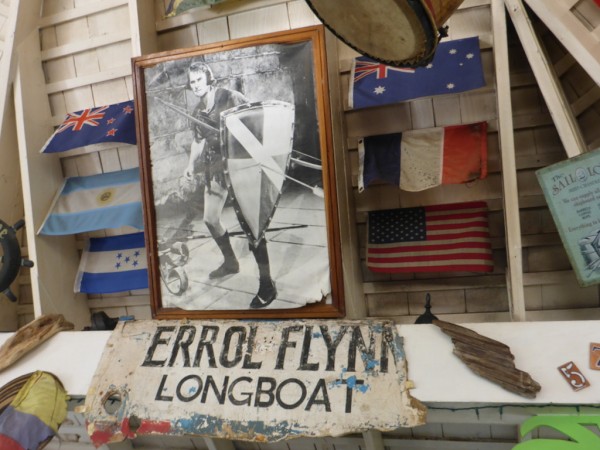
Our next passage will take us north through the Windward Passage which divides Cuba and Haiti. In fact, last night we could easily see the many storms flashing on the southern side of Cuba as we glided along the Jamaican coastline. We’ll probably see Coast Guard vessels patrolling the Passage for illegal migrants and trafficking but hopefully it will all be an uneventful and smooth passage.
Scoring Big Time
23 November 2013 | Montego Bay, Jamaica
Vicki – Air 28C, Sea 28C, Wind 25 kn E, Cloud 6/8
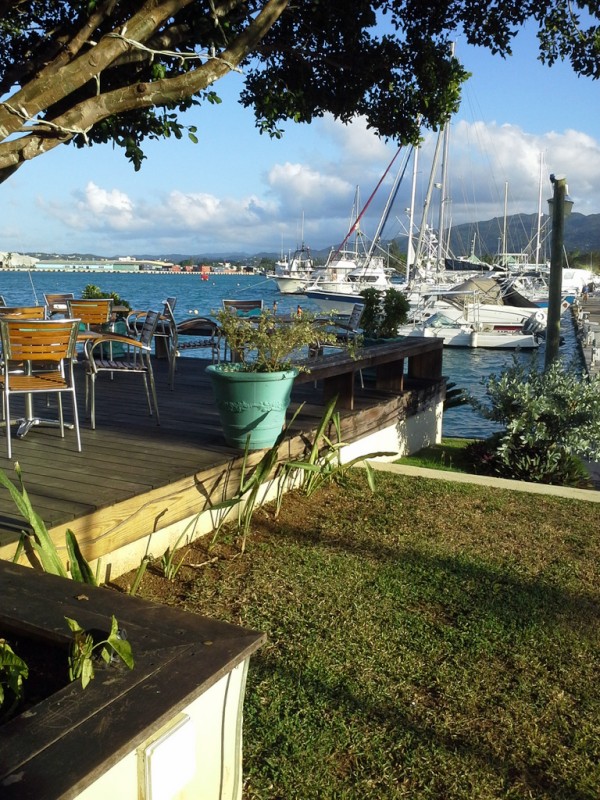
Clearing into Jamaica on Friday couldn't have been a more pleasant experience. Three Customs and Immigration Officials met us inside the famous and well-appointed Montego Bay Yacht Club (MBYC). Jamaica is not exactly on the normal cruising route and takes an effort to reach, particularly if you are cruising upwind as we were. From Panama, most cruisers head north towards Costa Rica then hug the Belize and Mexico Coast, round the NW tip of Cuba staying 12 miles off and head to the USA or the Bahamas. Our Aussie friends on the 62 ft Swan "IO" left the day before we did from Red Frog Marina in Panama. They faced an 1800 mile windward passage to Antigua while ours was a 1500 mile windward passage. We both took different strategies as they decided to make as much easting as possible along the coast of South America then turn NE towards their destination of Antigua. The same weather window allowed us to head north in seas which started out at 2 meters then dropped to 1 to 1.5 meters and wind of 10 - 15 knots and gusts to 20 knots during rain squalls. The trade winds have kicked in down south for the season and IO are beating to wind in 30 kn as they head towards Santa Marta, Colombia although they still have a long way to go. We certainly wished that they had been with us in the friendliest Yacht Club we've ever visited while clearing into our 7th country in just over a year.
I think we met every employee in the MBYC; they all seemed to know we were coming in and went out of their way to show us around the Club. We signed the Visitors Book (with entries back to 1993!), and met the Head Chef, Ryan, who sat down with us to say he would cook anything... anything we'd like. We brought our faded RQYS Burgee to the Club and everyone stood around laughing and chatting as they watched it being nailed up beside 123 other Burgees from around the World. We saw the Pineapple Cup trophy behind the bar for the 811 nautical mile race from Florida to Montego Bay. This race has been running biennially for 31 years and was won last year by "Shockwave".
Jamaica has a long and interesting history. Christopher Columbus was believed to be the first European to step foot in Jamaica on 5th May, 1494 and described it as “the fairest isle that eyes have beheld”. We totally agree and I think we need to come back and spend more time here sometime, somehow. They also grow the fabulous Jamaica Blue Mountain Coffee and produce Appleton Rum which the bar staff “insisted” we try. How could we resist? Maynard is also a cricket fanatic and as Jamaica was a British Colony for part of their history until 1964, cricket is a well-established sport. Australia and the West Indies have had many battles on the field over the years. My sister is a well-known International cricket scorer and has probably met almost every famous cricketer around the world. She has even met Sir Viv Richards who was born in Antigua. Currently, Australia are playing against England back home in Australia for a trophy called the Ashes at the Gabba cricket field in Brisbane. She is retiring after 30 years of dedicated work and the newspapers have written the following:
“Australia’s most prolific run scorer will be retiring after the Gabba Test match, with Queensland stalwart Judy Harris to end her stellar scoring career. Harris is the official scorer in her 30th and final Test match in Brisbane. If only Australia’s top order had her composure. She’s handled every dramatic collapse by the Aussies with more poise than any willow-wielding millionaire.”
Sure wish we could be in two places at once. We love Jamaica but we would also love to be in Brisbane with my sister Jude as she scores her final International Test Match.
For more pics see Photo Gallery
What Garbage
21 November 2013
Vicki – Air 28C, Water 28C, Cloud 4/8, Swell 1m, Wind 1 kn
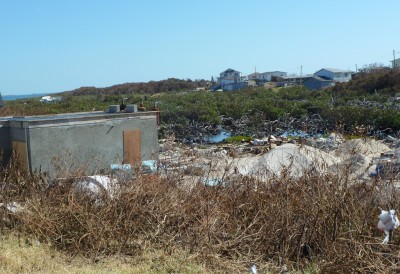
As we expected, there were a few comments about the exercise bike photo. We enjoy the feedback and think it’s probably worthwhile discussing the issue of garbage. World-wide, garbage is becoming a real problem. The First World does a pretty good job of keeping garbage out of sight and out of mind reasonably ecologically. This is done at some considerable expense. In the Third World there is seldom much provision made for any garbage. In San Blas, various pristine islands seemed to be the place where the locals stored the cruiser’s garbage at $1 a bag. This garbage is often thrown in the low and formally pristine wetland areas of the islands where humans don’t live. At other times, we could smell the acrid plastic as they attempted to burn it off. In some of the small islands of the Bahamas, it was not uncommon to see low areas littered with discarded refrigerators, stoves and mounds of plastic associated with their lives (see above photo taken at Little Grand Cay, Bahamas).
We have now spent nearly a year in the Third World and early on, we had to make a decision on how to handle garbage. As vegetarians who have a lot less garbage than most people, we meticulously separate our garbage into various categories which are suitable for disposal at sea complying with all international regulations. We feel this is far more ecologically advantageous than giving garbage to locals who either throw it into a lagoon or pile it into wetland areas. Occasionally when we have stayed at marinas in Third World countries, we have had no choice but to leave our garbage there but we still feel it is inferior to proper disposal at sea. To put everybody’s minds at ease, the rusting exercise bike, which we’ve been carrying around for over 6 months, had no plastic on it. We never throw plastic overboard and we felt that burying the bike in almost 7000 feet of water was far preferable to leaving it in the remote places we visited in Colombia or Panama. The International MARPOL treaty basically prohibits all waste disposal within 25 miles of shore (some glass and papers are allowed) and you are allowed to dispose most general waste besides plastic and hazardous material as soon as you’re more than 12 miles offshore, as long as it doesn’t float. People in the First World have to remember that in places like Bocas del Toro the average wage is $7 a day and garbage is the last thing they worry about. We have been constantly distressed to see how much litter is in the streets, rivers and piled up on beaches. It is not at all uncommon to see people drink from a can or plastic bottle and then throw it into the gutter. Sadly, it is not always possible to comply with First World niceties everywhere on the planet. We simply try to do our best to leave the minimum impact on all places we visit. Again, we are happy to have your feedback and please know that we respect the sea more than you could ever know.
We’ve been at sea for 4 days and 3 nights now and are currently approaching Jamaica where we will stop for a short visit. Vanish has taken us over 8,000 miles since June last year. We’ve done 640 miles upwind on this leg but still have a long way to go but at least the hard part is done. The weather window turned out to be as good as we hoped so we look forward to getting back to cruising.
(For further info check out http://marinedebris.noaa.gov/outreach/pdfs/101MARPOLPstr.pdf)
We have now spent nearly a year in the Third World and early on, we had to make a decision on how to handle garbage. As vegetarians who have a lot less garbage than most people, we meticulously separate our garbage into various categories which are suitable for disposal at sea complying with all international regulations. We feel this is far more ecologically advantageous than giving garbage to locals who either throw it into a lagoon or pile it into wetland areas. Occasionally when we have stayed at marinas in Third World countries, we have had no choice but to leave our garbage there but we still feel it is inferior to proper disposal at sea. To put everybody’s minds at ease, the rusting exercise bike, which we’ve been carrying around for over 6 months, had no plastic on it. We never throw plastic overboard and we felt that burying the bike in almost 7000 feet of water was far preferable to leaving it in the remote places we visited in Colombia or Panama. The International MARPOL treaty basically prohibits all waste disposal within 25 miles of shore (some glass and papers are allowed) and you are allowed to dispose most general waste besides plastic and hazardous material as soon as you’re more than 12 miles offshore, as long as it doesn’t float. People in the First World have to remember that in places like Bocas del Toro the average wage is $7 a day and garbage is the last thing they worry about. We have been constantly distressed to see how much litter is in the streets, rivers and piled up on beaches. It is not at all uncommon to see people drink from a can or plastic bottle and then throw it into the gutter. Sadly, it is not always possible to comply with First World niceties everywhere on the planet. We simply try to do our best to leave the minimum impact on all places we visit. Again, we are happy to have your feedback and please know that we respect the sea more than you could ever know.
We’ve been at sea for 4 days and 3 nights now and are currently approaching Jamaica where we will stop for a short visit. Vanish has taken us over 8,000 miles since June last year. We’ve done 640 miles upwind on this leg but still have a long way to go but at least the hard part is done. The weather window turned out to be as good as we hoped so we look forward to getting back to cruising.
(For further info check out http://marinedebris.noaa.gov/outreach/pdfs/101MARPOLPstr.pdf)
Exercise Bike Falls From Sky
20 November 2013 | 170 Miles South of Jamaica
Vicki – Air 28C, Water 28C, Wind 10 kn N, Swell 1.5 m, Choppy, Cloud 6/8, Distant Showers
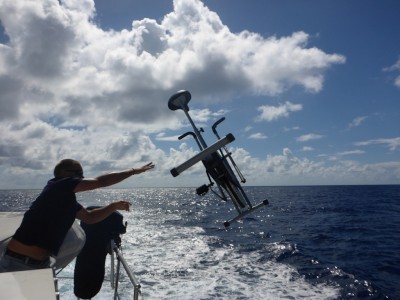
The weirdest things happen to Vanish. We're motoring along minding our own business 170 miles south of Jamaica in about 6,500 feet of water and next thing, this rusting exercise bike just fell out of the sky. Mike tried to catch it as you can see by his outstretched arm, but just missed.
The Hitch Hiker
19 November 2013 | At Sea - 13 deg 12.827N; 080 27.436W
Vicki – At Sea, Air 29C, Water 29C,Cloud 4/8, Wind 11kn N, Swell 1.5M, Barom 1008 mb
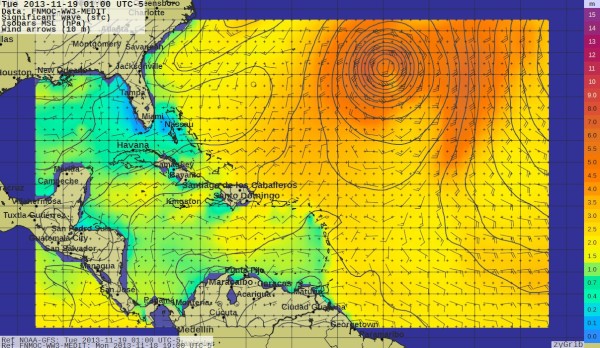
It was extremely hard to leave Bastimentos Island and the Red Frog Marina, especially after I saw my first wild capuchin monkey on a tree near the pool at my favourite villa as I took a last look around. But a good weather appeared over the weekend allowing us to head north towards Jamaica so yesterday we headed out to sea at 0800 in very heavy rain and short sharp 2 m swells. Maynard assured me that the swells would be worse at the beginning but lessen the further north we went and he was right. Windows for a comfortable direct passage between Panama and Jamaica are rare as the trade winds whip across the Caribbean Sea at 25 kn year round. However, when a hurricane or tropical storm forms in the Atlantic, it often disrupts the trade winds. Tropical Storm Melissa has been forming over the last few days and is now a huge storm measuring 230 miles across its centre. As you can see above, TS Melissa has completely disrupted the trades and this has resulted in a great diminution of the swell in the central Caribbean. The swells here are often very steep and have a short period and going against it can be very tiring and hard on crew and equipment so finding a window like this is very important. The swell in the centre of the above storm is around 10 meters and where we are in the green colour is 1 – 2 meters. We should be passing Jamaica on Thursday and may even stop for a rest unless the weather dictates that we need to keep moving.
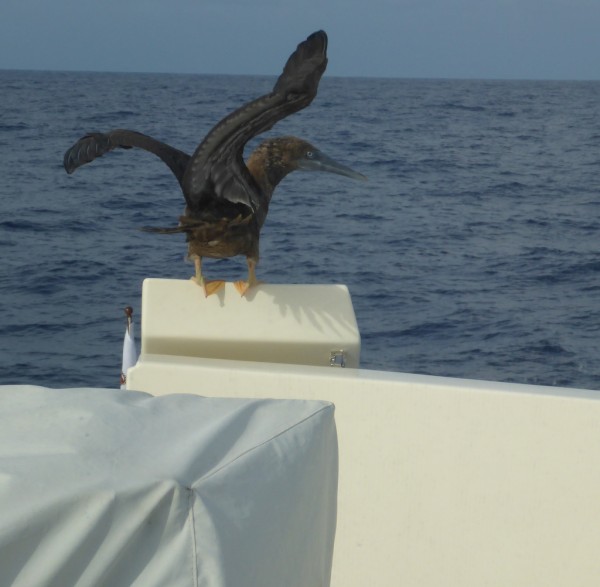
We were accompanied yesterday by a brown booby bird which stayed with us for 5 hours hovering above the deck before swooping down to catch flying fish. We estimated he caught around 3 fish an hour. Around 4.45pm he landed a few times before deciding to sit on the cover of our Portugese Bridge for the night. He yawned a couple of times then rested his head in his feathers until sunrise at 0620 this morning, stretched his wings a couple of times and flew away 20 minutes later to a freighter which just happened to be passing us heading south about 3 miles off our beam. Perhaps he does this every night hitch hiking the Caribbean on whatever vessel comes his way and as we’ve only seen 3 vessels in the last 2 days, he’s a very lucky bird.
Velcro Bay
16 November 2013 | Red Frog Marina, Bastimentos island, Bocas Del Toro, Panama
Vicki – Air 27C, Cloud 8/8, Thundery and Rainy, Wind 20kn NE
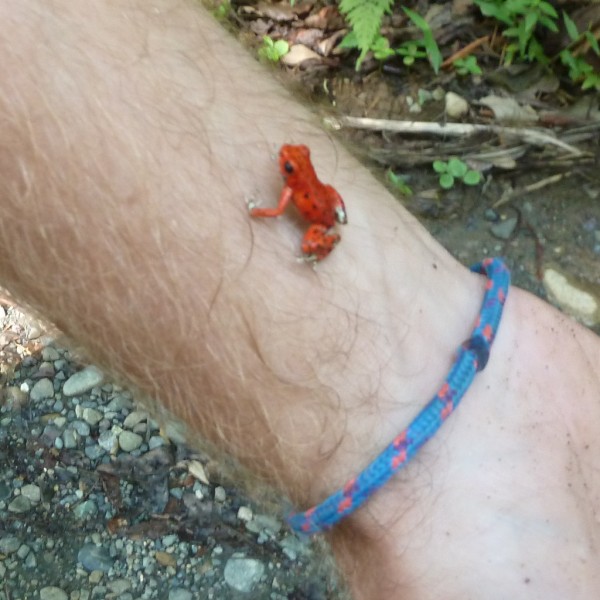
Recently our son in Australia saw a programme on TV detailing the most poisonous animals in the world. Number 1 on the list is the poison-dart frog. The above Strawberry Poison-Dart Frogs (Oophaga pumilio) are called dart frogs due to the indigenous use of their toxic secretions on the tips of blow darts. Many poison-dart frogs secrete toxins through their skin glands from eating ants, centipedes and mites which serve as a chemical defence against predation. The most poisonous is the golden poison dart frog found on the Pacific coast of Colombia and has enough toxin on average to kill up to 20 men. Scientists have used the toxins of yet another poison-dart frog from Ecuador to make painkillers which have potency 200 times that of morphine. The pretty little strawberry poison-dart frog, the one both Mike and I picked up and allowed to jump all over our hands and arms, is close to harmless for humans although it would be wise not to touch your mouth or let them hop on an open wound. I’d read another blogger’s post weeks ago describing the lady’s children playing with them without problems so I figured they were pretty safe. However, we won’t order a strawberry poison-dart frog pizza anytime soon and will leave them alone in future…just in case.
Storms rolled in around 3 am today and popped and crackled for 4 hours before turning into steady rain and we’ve had rumbles most of the day. Boats always have niggling maintenance problems which can be investigated during wet weather. Maynard and Mike have been looking for the source of an air leak in our Microphor toilets for many months. The air leak turns on a compressor pump once every 20 minutes on average but with miles of line between the compressor and our toilets, it’s hard to find the leak and Maynard is about ready to replace them which is quite a large undertaking. The Tecma toilet in our cabin and the Vacuflush in the crew cabin are on a different system so they are not the problem. We’ve had no malfunctions or anything disgusting to report but it’s just annoying at this stage. It’s a work in progress and one they’ll keep working on.
Another pressing issue is whether to leave Panama or not. This is the reason the Red Frog Marina is also called Velcro Bay. One can get stuck by accident or by intention. If you are like us and write Pros, Cons and Option Lists, then you’ll understand the difficulties involved in making the ‘right’ decision for us.
Crystal Cylinders
13 November 2013 | Red Frog Marina, Bastimentos island, Bocas del Toro, Panama
Vicki – Air 26C, Rain/Showers/Thunder, Cloud 8/8, Surf > 1meter, Wind 5 kn
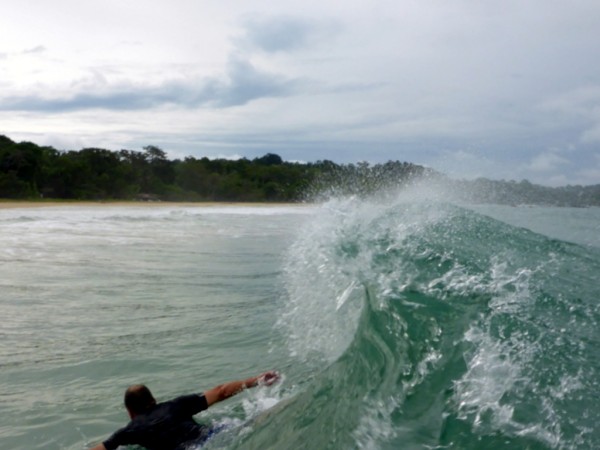
The sad truth about sailing is that weather windows don’t grow on trees. While Maynard and PHK worked their magic going through seismic for a week, those delicious flat seas and gentle breezes were coming to an end. We are not too disappointed as we have fallen in love with Panama and are finding it hard to leave. The HSVC (High Seas Vagabond Community) make friends easily. We are always stopping to say hi to new found friends in town and on Bastimentos Island where Red Frog Marina is located. There’s not much not to like. Even the Panamanian President Ricardo Martinelli visited the Red Frog Beach bar and a villa this week. He waved to us as we sat having sundowners on Vanish when he and his entourage departed late in the day.
We’ve learned that fresh produce arrives in Bocas Town on Tuesdays and Thursdays around 10 am, and that there are only one or two stores in town whose fresh and cold foods can be trusted. I found out yesterday after chatting to a dejected backpacker in town who was suffering an ear infection and hundreds of sand flea bites after staying at the sad looking Palmar Tent Lodge near Red Frog Beach that as the Bocas Town doctors are currently on strike, it’s best to be treated by Dr Dan, the local vet. This story was backed up by another friend who told us that you can get your dog treated and get an x-ray of your broken bones all at the same time with dear Dr. Dan. Two for the price of one. I know for sure that this wouldn’t happen in Australia…...well at least I don’t think so.
As one of our readers (trm_tqoe) pointed out, we’re on a great adventure and we never know what’s around the corner for us. The Panamanian lifestyle is relaxed, quiet and inexpensive and the weather is always fascinating with storms, rain, and sunshine and the cruising is world class with no risk or hurricanes. The fact that there are so many ex-pats living in Panama is not all to do with dodging tax codes in western countries or criminal activity. People are friendly, life is easy and it is terribly tempting to sign a cheque and buy a piece of property. Up until now, we’ve snorkeled and paddle boarded in calm conditions yet this week with windier conditions, the surf is pumping so we’re now enjoying the body surfing. I take my hat off to surf photographers taking pictures in the impact zone as I took on about 10 pounds of sand in my togs capturing the Photo Gallery shots for Eric and friends but it was a great deal of fun. When and IF we leave is yet to be determined. There's not much time left and pretty soon we'll have to make up our minds.
Are There Any Bugs in Panama?
06 November 2013 | Red Frog Marina, Bastimentos Island, Bocas del Toro, Panama
Vicki - Sunny, Air 29C, Cloud 5/8, Wind 6 kn N
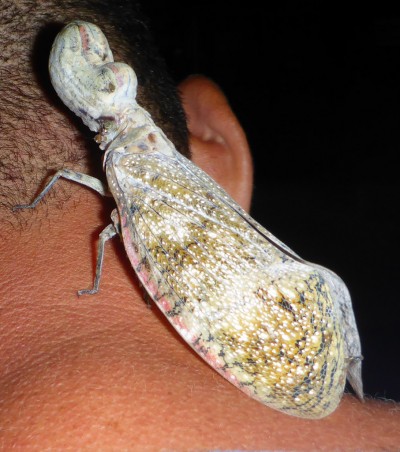
Compared to our home in Australia, we've seen very few flies, mosquitoes, sandflies or any other bugs in the last 2 months. However, last night the above gorilla flew into the Kayukos Restaurant at the marina while we were having dinner and caused considerable excitement. The nervous 'volunteer' above let someone put it on his neck long enough for me to take a picture. It maybe a moth but we haven't identified it yet. If anyone knows what it is, please leave a comment below.
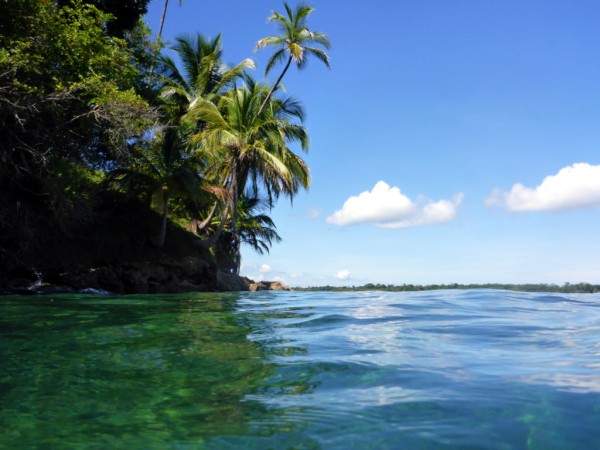
We continue to take advantage of the great weather and ideal snorkelling conditions above at Hospital Point, 2 miles from the marina.
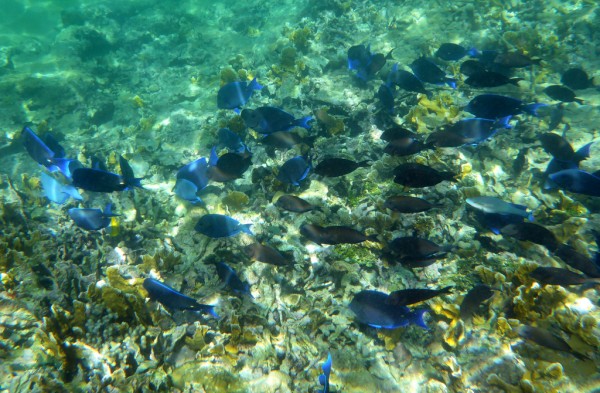

We continue to take advantage of the great weather and ideal snorkelling conditions above at Hospital Point, 2 miles from the marina.

Kanga in a Panga
04 November 2013 | Red Frog Marina, Bastimentos Island, Bocas del Toro, Panama
Vicki – Sunny, Air 30C, Water 29C, Wind 3 kn N
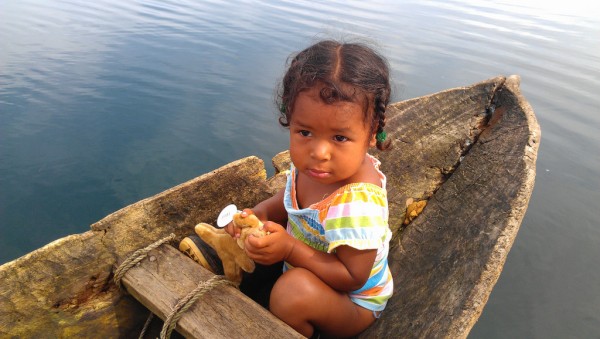
Once again after about 5 days, marina fever sets in so we spent a few days on anchor at various spots in the Bocas del Toro region about 10 miles from the Red Frog Marina. We were hit by a fierce thunderstorm at midnight (is there any better time?) near the Panamanian mainland in Logan Bight. It was all hands on deck as this one was accompanied by wind which swung us towards land and with torrential rain, Maynard started the engines and radars and realised one of the radars wasn’t working and the other had an issue. Well that’s just great and what a good time to find out! Luckily the anchor held, the storm abated and the following day was spent tracing the problem. After a bit of effort, one radar is working but Mike and Maynard are still working on finding out why our 48 mile radar is stuck in sleep mode.
We met a few of the local inhabitants, one who brought his beautiful little child wearing gumboots in his leaky panga over to Vanish. I ran inside to find her a stuffed kangaroo toy and held it out for her to take. I had the feeling that this was her first ever toy as she didn’t understand how to take it from me so I had to hold her arm, open her hand and I placed it gently in her palm. She squeezed the fur and touched the roo’s plastic eyes and looked up with such a lovely shy smile. These people have very little but all of them seem happy and are a joy to talk to when they drop by. Another visitor Ricardo told us to take our dinghy up a jungle mangrove creek to look for monkeys which he’d seen yesterday but we couldn’t find them. The only one we have seen was a pet capuchin monkey in Bocas Town one day. We couldn’t swim in the bays near the mainland as they were so full of massive clusters of jellyfish clinging together. The locals told us that we would vomit if we were stung by these cluster jellies. We found some good snorkelling and swimming areas offshore then headed back to our temporary home at Red Frog Marina while we awaited Prent’s arrival, Maynard’s work colleague from Louisiana who is here for the week.
There are a few Aussies in the marina at present and coincidentally one of them is Stuart Broom and his wife Suzie. Stuart goes back a long way as we competed against him in the Hamilton Island Big Boat Series in 1999 and he was on board a yacht which t-boned Cruz by accident on our port side (he was not on the helm though). We both remembered it well and reminisced about those ‘good ‘ol days’. They are crewing on a yacht and heading to Jamaica after hurricane season. We also learned that this is a very big week for all Panamanias as they celebrate 4 holidays this week; the Day of the Dead on Nov 2, Separation Day Nov 3, Flag Day Nov 4, Colon Day Nov 5 and yet another holiday on Nov 10 for the Uprising in the Villa de Los Santos. Our previously deserted beautiful Red Frog Beach was filled with over 1,200 people yesterday on Separation Day (Panama’s equivalent of 4th July) with a constant stream of partying pangas bringing visitors to and from the mainland and Bocas Town to the beach with DJ’s, rock music, beer games, and a fair bit of activity not allowed elsewhere. Today, a Panamanian Navy patrol boat has decided it’s time to make its presence felt and things are a little more under control it seems. Once Maynard and Prent have completed their work commitments, we will be looking for the first weather window to head north.
Earthquakes & Unwanted Guests
27 October 2013 | Bocas del Toro, Panama
Vicki – Air 27C/80F (Real Feel 44 C/111F), Cloud 8/8, Wind Calm, Earth Calm
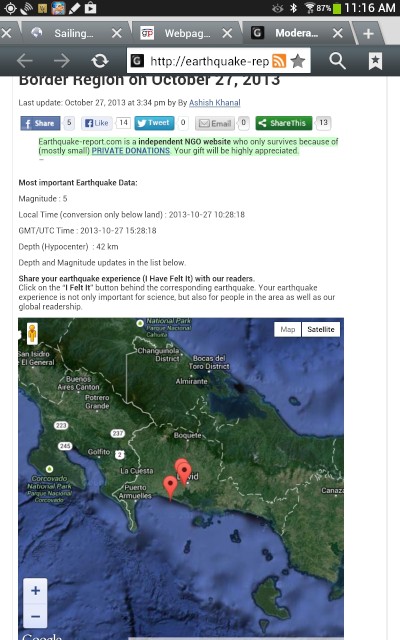
Over the past year we’ve endured Hurricane Sandy in the Bahamas, swum with pigs in the Exumas, almost blew up the engine of a rental car in the middle of the Dominican Republic, trekked through the jungle in a fierce lightning storm in Colombia and today experienced a 5.1 magnitude earthquake 50 miles from here at 10.28 am this morning. We didn’t feel it on the water but I wish I’d been on land at the time. Call me crazy! It lasted around 15 seconds and shook loose items and furniture.
And now to the issue of guests. We never like it when they just turn up uninvited, make a mess, spread themselves everywhere and don’t know when to leave. Prent you can relax, I’m afraid the guests who are the worst are the dreaded six legged kind; weevils. Panama heat and humidity circulating around Orville Reddenbacher popcorn, rolled oats and wheat flour is a ticking time bomb if you don’t stay vigilant. After moving our entire dry stores onto the dock for the entire marina’s enjoyment, we systematically went through every single box and annihilated anything suspicious. Daily checks from now on though.
And now to the issue of guests. We never like it when they just turn up uninvited, make a mess, spread themselves everywhere and don’t know when to leave. Prent you can relax, I’m afraid the guests who are the worst are the dreaded six legged kind; weevils. Panama heat and humidity circulating around Orville Reddenbacher popcorn, rolled oats and wheat flour is a ticking time bomb if you don’t stay vigilant. After moving our entire dry stores onto the dock for the entire marina’s enjoyment, we systematically went through every single box and annihilated anything suspicious. Daily checks from now on though.
Dash in the Dark
26 October 2013 | Red Frog Marina, Bocas del Toro, Panama
Vicki – 30C, Cloud 8/8, Wind 2 kn W
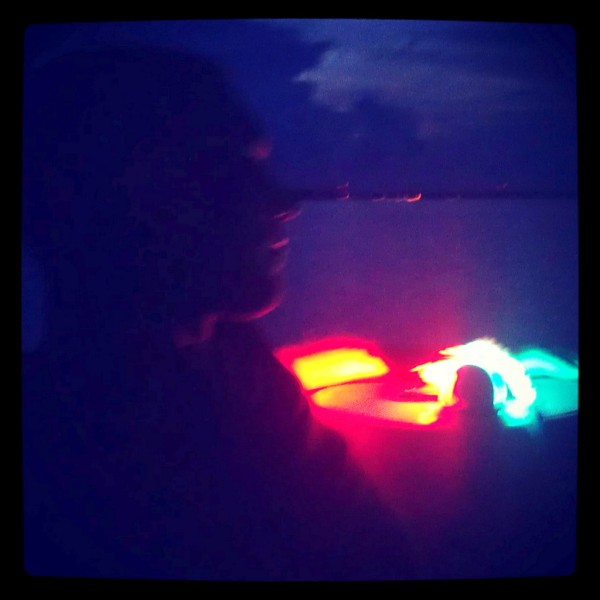
In case you missed last night’s Picture of the Day on Instagram at mv_vanish, I’ve posted it again above as it demonstrates how fortunate we are to have a good dinghy on board our vessel. The Red Frog Marina is about a 5 mile distance from Bocas Town where our new favourite restaurants are located. That’s quite a distance when you are traveling at night with no moon, no navigation aids and many unlit water taxis buzzing around on a busy Friday night. However, we’d been across this stretch of water a few times in the daylight. Our chart plotter in the dinghy showed the route quite clearly as we headed out of the marina past mangrove islands and a few unlit anchored yachts in search of a meal in town. Our AB inflatable dinghy is 14 feet in length with an aluminium bottom, a centre console, automatic bilge pump, navigation lights, chart plotter, the latest generation 2 stroke 40 hp Evinrude motor and an awning which we lowered to increase our speed across the water. The best thing about our dinghy is its size as we've been used to a much smaller size on Cruz Control, our previous sailing yacht. At 14 feet it fits easily on the bridge deck and the fact that we are able to travel 5 miles over open water safely at speeds in excess of 20 knots with three full grown adults is something we’ve never been able to do before. The aluminium hull allows us to beach the dinghy anywhere without fear of gashing the fiberglass hull and keeps the overall weight of the dinghy low enough to lift with most davits.
In the distance past Bocas Town, a large storm cloud lit up with beautiful lightning while another was lighting the sky behind us over the mountains. At 4700 rpm we glided across the water at 20 knots in less than 15 minutes where we tied up to a wobbly dock attached to a restaurant in town which we’ve been using over the last week or so. Mike kept a sharp lookout on the bow as we swept past an anchored US Coast Guard vessel that is here presumably to keep narcotics at bay. We slowed down near town so we could see the darkened pangas and watercraft that would shine a torch at us to lets us know of their presence. The salad and wood-fired pizza at La Italiana was delicious and the street life odd and entertaining so it was an exhilarating and memorable evening for us all.
(Photo Gallery has a couple more pics of the dinghy taken a few weeks ago.)
Slothing Around
21 October 2013 | Red Frog Marina, Bastimentos Island, Bocas del Toro, Panama
Vicki – 28C, Cloud 8/8, Wind Calm, Storm during the afternoon
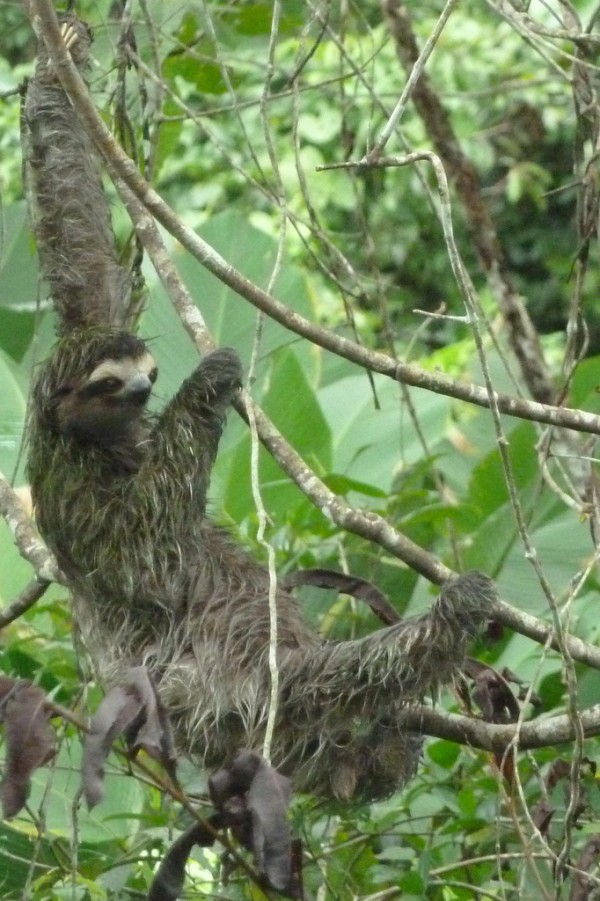
After waking up to a rainy day at Zapatilla Cay which made snorkelling less appealing, we moved Vanish around to Bocas Town where we anchored for a couple of days. Bocas has a population of around 3,500 with many restaurants, hostels, dive shops, and grocery stores and actually reminded us very much of Byron Bay with backpackers from all over the world in the 20 – 30 year old range. We stocked up on bread from the bakery and fresh food from numerous grocery stores and spent the afternoons snorkelling at nearby sites as the weather had cleared again. Bocas Town also has an airport, a hospital and drug stores and infrastructure we haven’t seen for many many weeks. We wanted to do some land based activities as well so we decided to head over to the nearby Red Frog Marina which we’d heard so many good things about. We topped up our diesel at $US4.40 per gallon, a darn side cheaper than the prices in Queensland which are around $7.50 per gallon. In fact, it’s hard to get used to the low prices of everything everywhere we go compared to home. Food, alcohol, fuel, accommodation, activities, taxis, marina berth prices, everything is ½ to 2/3 less. Our berth is perfect as we have a nice breeze, there are virtually no bugs of any kind, the wildlife starts right at the marina office with the above sloth living in a nearby tree and all kinds of birds, lizards and monkeys live in the adjacent jungle. This particular sloth is a 3 toed sloth and I’ve found out that they live 25-30 years, weigh between 4 – 8 kg (8-16 lbs), move at a speed of 0.015mph avg, eat leaves, bugs, petals, defecate once a week on the ground, and give birth to their young in the trees and are around 18 inches long. We’re still hoping to see some monkeys but have seen many red frogs which are found nowhere else in the world but here on Bastimentos Island. They are also known as strawberry poison dart frogs and are tiny at just one inch in length. We’ve hired a golf buggy which we use to explore part of the 1600 acres of property owned by the marina and have visited the beautiful villas, beaches and three low key restaurants in the area. There are no grocery stores or marine services here which is a negative but it seems to be the ideal place to keep a boat for the hurricane season. It’s quite easy to take a panga to town to do any shopping as the marina provides a shuttle a couple of times a week or one can take one’s own dinghy or hail a passing water taxi. From the marina, we can go paddle-boarding and we have access to Red Frog Beach where we can swim, surf and snorkel. So much to do, so little time.
On We Go ....For Now
15 October 2013 | Zapatilla Cay, Bocas del Toro, Panama
Vicki – 27C/80F, Water 30C/86F, Wind 5 kn W, Cloud 6/8, Distant Storms
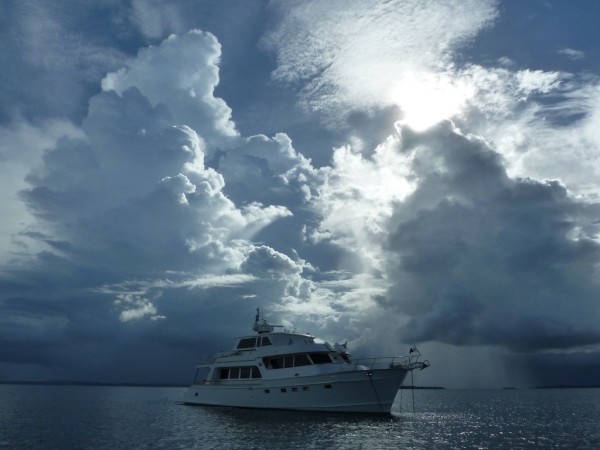
Tempting as it was to turn left at the Panama Canal, book a spot and take Vanish back to Brisbane (or Chile), we felt we still have unfinished business here. These cruising grounds are spectacular and one could spend a lifetime discovering new peaceful anchorages while enjoying the constant change of weather and scenery, eating healthy food and snorkeling almost every day. We're still under 10 deg south and out of the official hurricane zone but the seasons are moving on with November 15 fast approaching and we need to position ourselves for the next phase of our trip. There's so much to consider and we are conflicted with our family and dog back home in Australia against Maynard's need to be in the US next year to oversee drilling a well in the Gulf of Mexico. Then there's the route to take; we can go back to Colombia and head north to Dominican Republic or keep heading west in Panama before turning right and heading north to Guatemala, Belize and Mexico. Either way, we are heading north but we have to avoid late hurricanes or the dreaded northerly Christmas winds. OR we can just keep Vanish in Panama at the Red Frog Marina at Bocas del Toro and spend another season in this beautiful country. Sometimes, humans don't do well if they have too many choices and we can certainly vouch for that. Many sleepless nights ahead I'm afraid.
Yesterday we departed Portobelo and headed west towards Colon and the Panama Canal, took a few happy snaps for our family and our readers and went onto our intended anchorage at the Chagres River which is the river that is the outlet of the Gatun Lake, a dam built specifically for the Panama Canal. We've crossed many river bars in our previous yachts but there were a number of challenges here. Firstly, there are few navigation aids in Panama, and none for this river. The entrance is shallow at 3 meters, and then there are two reefs we needed to pass between. There is also the issue with current coming down the river in the wet season with trees and debris and the river is 100 meters across and we are 25 meters in length so it is a bit tight but the sight of a wrecked yacht washed up on the beach at the entrance said it all. Normally, we would have dropped the dinghy in the water and checked out the depths ourselves but the swell was over a meter and it was too tricky to manoeuvre. Even though this may have been our best chance of getting up close and personal with the birds and wildlife, we all decided there were too many risks. Given the seas and weather were perfect for an overnight passage, we decided to go onto Bocas del Toro overnight, against a 2 knot coastal current in the Mosquito Gulf, a distance of 150 miles from the river to our current anchorage at Zapatilla Cay. Bocas del Toro is a sparsely populated province with a main town called Bocas Town and many islands covered in jungle with perfect beaches, wildlife preserves, national parks, Chirique villages and a few marinas including the IGY Red Frog Marina.
Panama Canal Decision Time
14 October 2013
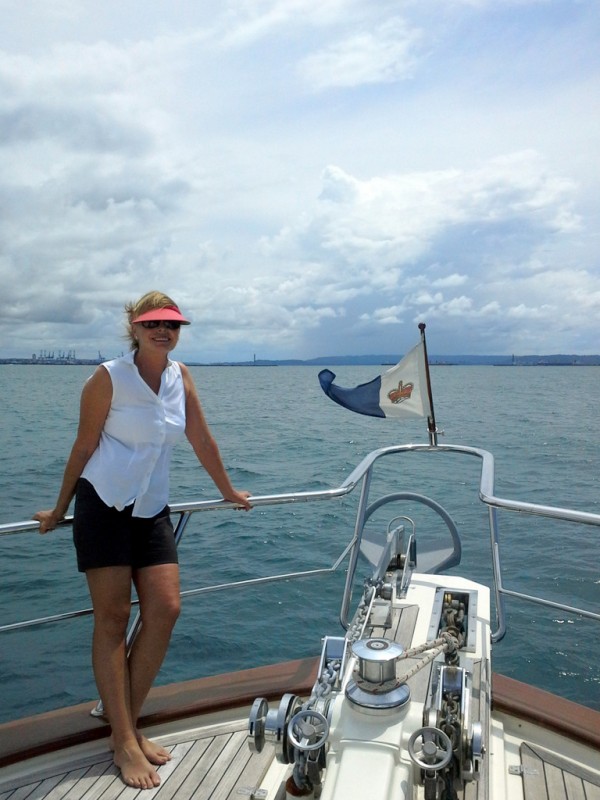
Do we go through or do we go on?
Internet Junkies
11 October 2013 | Cacique near Isla Linton, Panama
Vicki & Michael – Air 24C/75F, Wind 1 kn SW, Raining and most probably a storm out there somewhere close
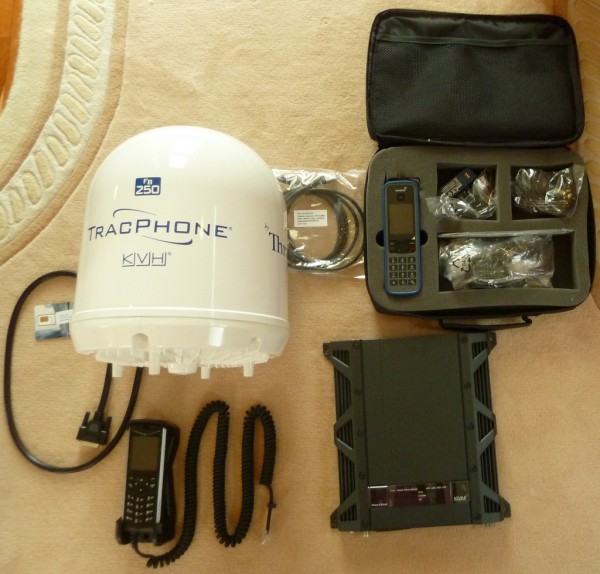
After two agonising weeks trying to stay in touch using local lightning affected Kuna cell phone towers to get internet and phone reception on Vanish’s highly boosted boat phone, we ripped the boxes apart which contained our new KVH Fleet Broadband 250 TracPhone, antennae, KVH below deck terminal and new sat phone. The bolts for the old antennae were hidden in the ceiling of the bridge so 3 lights and a leather covered panel needed to be carefully removed. We didn’t have a proper Marlow tool to pop off the ceiling so we had to be very gentle trying to pry it off without damaging the leather. In place of the special tool we got inventive and carefully used 6 butter knives as levers.
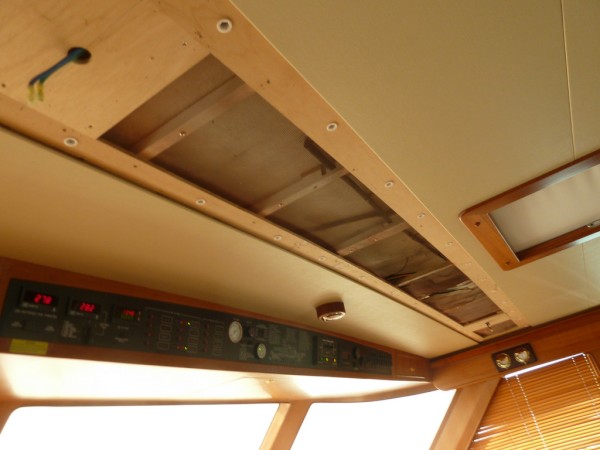
It actually worked so after prying the ceiling panel off Maynard and Mike had access to the antenna cable and the 4 bolts holding the satellite antenna onto the top of the bridge. They easily removed all 4 through bolts and lifted the antenna from above to unscrew the cable. The new FB250 antenna was installed by attaching the cable that was already run and screwing in one of the bolts to hold it in place for our test. The old below deck terminal was located underneath the instrument panel in the bridge deck but was virtually inaccessible. They removed the screen for the forward looking sonar so the screws and wires could all be reached easily, in the process discovering a pinched wire on the forward looking sonar that we have never been able to get working properly.
After removing the old terminal they plugged in the new FB250 Terminal. Thankfully the old FB150 and new FB250 use the exact same wiring and baseplate for the antenna so their first idea was to just install the new antenna and terminal and that would be an effective test to see if the wiring was a problem or not. Then came the fateful test. The old SIM card with our data plan on it was inserted, they flipped the breaker and turned on the terminal and… success! It worked perfectly! After making a test phone call and email to Prent who is in our time zone, we were fully satisfied that the problem on the FB150 must have been the antenna or the terminal and that the wiring is obviously fine, thankfully because running all new wires would have been extremely time consuming, difficult and exhausting. The next step was to properly attach and waterproof the antenna using SikkaFlex and the old through bolts. Next, they attacked the problem of attaching the terminal to the bulkhead in a manner that would be more accessible in the future. During this process, they were reading through the literature provided with the new unit and realized that the manual spent a lot of time discussing grounding the terminal. The electrician who installed our old FB150 terminal had neglected to attach a ground wire from the terminal to the hull.
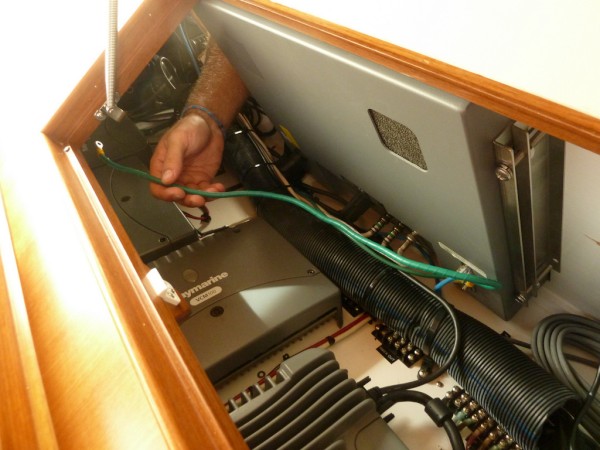
We are highly suspicious that this was our problem with the FB150 in the first place as we are cruising one of the most active areas for lighting in the entire world. We have been constantly surrounded by thunderstorms and there is lighting at least in the distance most of the day and night, as was the case on the day it stopped working. They found a proper wire and connected the grounding point on the terminal to the grounding point on one of the Raymarine display screens and from there it is taken to ground below deck. The terminal was drilled into the bulkhead and the forward looking sonar screen was attached, the ceiling panel popped back and after a total of 12 hours of work, hey presto we’re back in business.
Lightning in the Anchorage
10 October 2013 | Isla Linton, Panama
Vicki - Stormy
One hour of spectacular natural fireworks tonight:
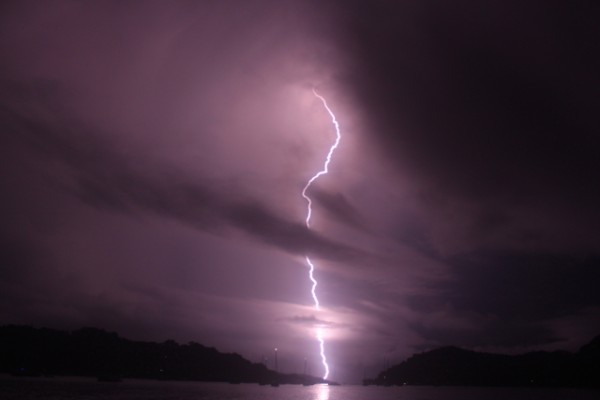

The Black Christ
09 October 2013 | Portobello, Panama
Vicki – Air 27C/80F, Water 29C/84F, Cloud 8/8, Wind 5kn W, Rolling Storms, 9 33.354'N:79 40.191'W
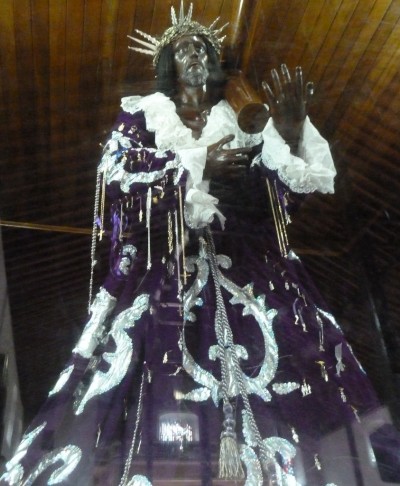
The weather has changed. We've enjoyed a month of fairly sunny skies with storms during the day or night but over the last couple of days, the cloud cover is 8/8 with torrential rain, fierce lightning and thunder. Panama has two seasons, a dry season from December to April and a wet season from May through to November. The wet season winds are unpredictable with squalls which bring heavy rain but are of short duration. Over the past couple of nights, even with the blinds closed, our cabin is lit up almost all night long with strobe like lightning flashing across the sky from every direction. I count the seconds it takes for the thunder to arrive so I know whether the storm is approaching or leaving us which makes no sense really as all that happens is I lose sleep and another storm rolls in behind the one that's just left. The cloud cover is so thick at times during the day that we have to put the cabin lights on. This morning during one of a dozen storms since midnight, I looked out to see a motorised panga heading to town with four passengers quite happily standing up holding umbrellas while lightning bolts darted into the sea and danced above their heads. I guess they are used to it. We actually love this weather as it's so intense, tropical and different to most places on the planet.
We dropped anchor amongst 65 yachts, many of which look abandoned, in the Bay of Portobello yesterday. The Lonely Planet Guide painted a poor picture of Portobello saying it is economically depressed with homes situated amongst the colonial ruins, which turned out to be quite true. We walked all over the town and it was indeed quite poor but felt safe. The town has many historical sites including forts all around the Bay, a Customs House, canons, a museum and church.
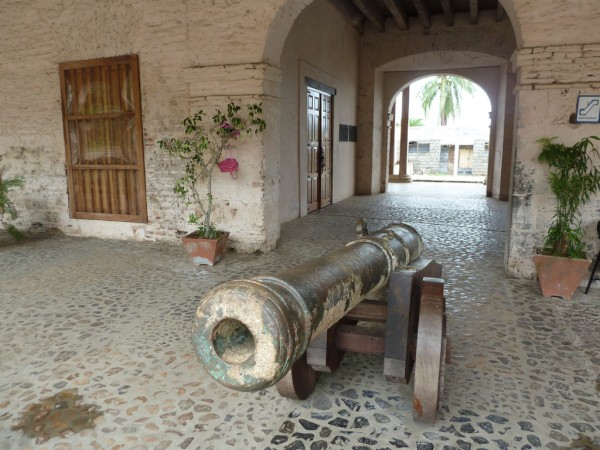
The Bay of Portobello was discovered in 1502 by Columbus and the City of San Felipe de Portobello was officially founded in 1597. It became one of the most important sites for transferring 45 fleets of galleons laden with gold and silver from South and Central America to Seville in Spain between 1574 and 1702. The ruins of the fortifications can be seen along the shoreline. We also visited the Church of San Felipe de Portobello which is home to the Black Christ of Portobello, a wooden statue of Jesus of Nazareth possibly dated around 1658. This local saint is worshipped by followers throughout Latin America and 60,000 people come to celebrate the Black Christ Festival on October 21.The life sized effigy is said to have countless miracles attributed to it and thousands of devotees walk up to 120 miles from their homes while many crawl the last mile on hands and knees wearing purple robes which they discard at midnight on the steps of the church. The figurine has 63 robes all donated by Panamanians, some of which are over 100 years old. The robes are changed twice a year and each one is used just once.
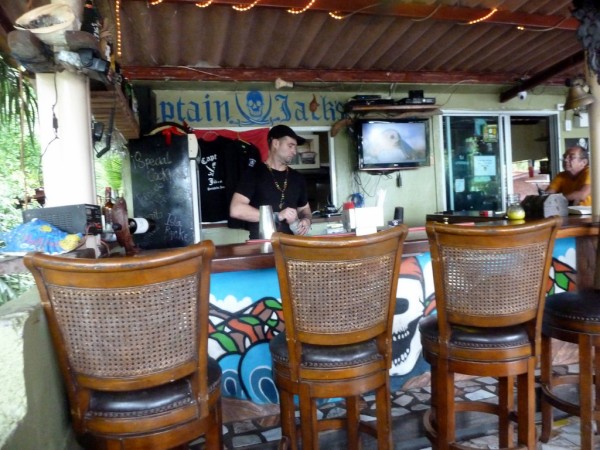
A well-known yachtie bar, restaurant, hostel named Captain Jacks is perched above the bay next to a stream adjacent to dense vegetation filled with wonderful birds. The barman, Jeff, provided us with a wealth of information on electricians, mechanics, canvass work etc and the ability to get anything bought or worked on in Portobello, including arranging lines and line handlers to transit the canal without the need to stay in Shelter Bay Marina in Colon. He also let me use his personal computer so I could post the last few blogs at long last. My computer didn't like his router which was irritating beyond belief. Oh how we rely on technology! While drinking some well-earned refreshments, we hatched the plan of hiring a driver (Jeff's friend) from Portobello to take us the 50 mile drive to Colon to pick up the satellite equipment and do some provisioning as well. Brilliant idea. This would save taking Vanish into the isolated Shelter Bay Marina but there was one big hiccup. Maynard found out he had a Board Meeting and couldn't go but Michael was more than happy to make the trip himself with the trusted driver. Michael has been a fantastic hand on Vanish as he is so happy and willing to learn and try anything. Our trip would not be the same without him. He regaled us with many stories of his adventure into one of the most dangerous cities in the world, described in the guide books as an "urban jungle racked with violent crime, a sprawling slum of decaying colonial grandeur and desperate human existence." Let me just say here, "Mrs. Porter, your son is fine and we would never ask him to do anything we wouldn't do ourselves." He witnessed the utmost poverty with people wearing bare rags sleeping outside Reys Supermarket in Colon in the rain where he bought our provisions. Huge armed guards wearing urban camouflage clothing and riot gear were inside and outside the store. The ATM at the supermarket had no cash that day (I wonder why?), but luckily the debit card worked. His driver Jose, and Michael enjoyed lunch and were back at the boat before dark with the satellite equipment and good fresh food. And now the fun begins with the sat installation.
P.S. Still looking forward to seeing some poop throwing monkeys ....from a distance.
We dropped anchor amongst 65 yachts, many of which look abandoned, in the Bay of Portobello yesterday. The Lonely Planet Guide painted a poor picture of Portobello saying it is economically depressed with homes situated amongst the colonial ruins, which turned out to be quite true. We walked all over the town and it was indeed quite poor but felt safe. The town has many historical sites including forts all around the Bay, a Customs House, canons, a museum and church.

The Bay of Portobello was discovered in 1502 by Columbus and the City of San Felipe de Portobello was officially founded in 1597. It became one of the most important sites for transferring 45 fleets of galleons laden with gold and silver from South and Central America to Seville in Spain between 1574 and 1702. The ruins of the fortifications can be seen along the shoreline. We also visited the Church of San Felipe de Portobello which is home to the Black Christ of Portobello, a wooden statue of Jesus of Nazareth possibly dated around 1658. This local saint is worshipped by followers throughout Latin America and 60,000 people come to celebrate the Black Christ Festival on October 21.The life sized effigy is said to have countless miracles attributed to it and thousands of devotees walk up to 120 miles from their homes while many crawl the last mile on hands and knees wearing purple robes which they discard at midnight on the steps of the church. The figurine has 63 robes all donated by Panamanians, some of which are over 100 years old. The robes are changed twice a year and each one is used just once.

A well-known yachtie bar, restaurant, hostel named Captain Jacks is perched above the bay next to a stream adjacent to dense vegetation filled with wonderful birds. The barman, Jeff, provided us with a wealth of information on electricians, mechanics, canvass work etc and the ability to get anything bought or worked on in Portobello, including arranging lines and line handlers to transit the canal without the need to stay in Shelter Bay Marina in Colon. He also let me use his personal computer so I could post the last few blogs at long last. My computer didn't like his router which was irritating beyond belief. Oh how we rely on technology! While drinking some well-earned refreshments, we hatched the plan of hiring a driver (Jeff's friend) from Portobello to take us the 50 mile drive to Colon to pick up the satellite equipment and do some provisioning as well. Brilliant idea. This would save taking Vanish into the isolated Shelter Bay Marina but there was one big hiccup. Maynard found out he had a Board Meeting and couldn't go but Michael was more than happy to make the trip himself with the trusted driver. Michael has been a fantastic hand on Vanish as he is so happy and willing to learn and try anything. Our trip would not be the same without him. He regaled us with many stories of his adventure into one of the most dangerous cities in the world, described in the guide books as an "urban jungle racked with violent crime, a sprawling slum of decaying colonial grandeur and desperate human existence." Let me just say here, "Mrs. Porter, your son is fine and we would never ask him to do anything we wouldn't do ourselves." He witnessed the utmost poverty with people wearing bare rags sleeping outside Reys Supermarket in Colon in the rain where he bought our provisions. Huge armed guards wearing urban camouflage clothing and riot gear were inside and outside the store. The ATM at the supermarket had no cash that day (I wonder why?), but luckily the debit card worked. His driver Jose, and Michael enjoyed lunch and were back at the boat before dark with the satellite equipment and good fresh food. And now the fun begins with the sat installation.
P.S. Still looking forward to seeing some poop throwing monkeys ....from a distance.
Howls of Joy
08 October 2013 | Isla Linton, Panama
Vicki – Air 27C/80F, Water 29C/84F, Cloud 8/8, Wind 5kn W, Storms Lurking
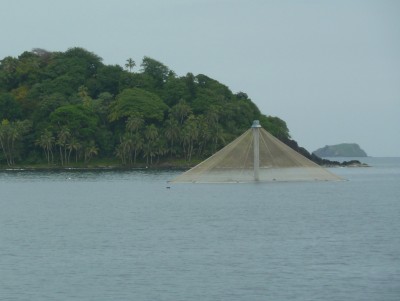
It’s hard to believe, but we’ve spent an entire month in Kuna Yala. The weather was ideal, the snorkelling was fabulous and our anchorages were calm and stress free with few boats to bother us. The Panamanian authorities are used to cruisers not clearing into Panama from Colombia in the Kuna Yala region straight away so we knew we had time to enjoy it all. However, needing our sat phone working, we headed to El Porvenir early in the morning, anchored off the island and went ashore where we were cleared into Panama within an hour while thunder rolled and boomed outside the immigration building. We paid our fees in US Dollars, the official currency of Panama and left the building. The storm was very close so we raced back to Vanish, lifted the anchor and headed out to sea where we skirted the back of the storm to avoid the lightning. The sea was less than a meter and quite comfortable. Panama runs basically west to east so we headed 60 miles westward and passed between the mainland and Isla Grande. Isla Grande is one of Panama’s favourite surf spots and many competitions take place here although they must occur in the dry season when the swells are large as there was barely a ripple when we entered. We then moved down to an all-round protected anchorage Maynard had researched called Isla Linton, one of the best anchorages in this part of the coast.
Isla Linton sits a few hundred meters off the Panama mainland and is privately owned but uninhabited, except for a few monkey families who are the real owners of the island. We were warned to be very cautious as they appear friendly at first, sitting on you and eating out of your hand but as soon as they realise you intend to leave, they become upset and may bite. They also throw their do-do at you which I thought must have been a joke but it’s true and is not a pleasant thought on a hot steamy day, well any day actually. We decided not to visit the Isla. When entering the anchorage, we also needed to avoid a fish farm producing cobia. There were three large circular cages in the middle of the entrance with vessels nearby and also another fish contraption covered in a towering net. We also passed a thick coil of anchored rope floating on the surface near the fish farm which we saw just in time to veer away. There’s no way we would enter this anchorage at night.
We dropped anchor near a few floating plastic drink bottles and later learned it marked a wreck underneath. Lucky again. Once we’d turned off the motors and gensets, the first thing we heard were the howler monkeys calling each other from Isla Linton to their mates on the mainland. The calls sounded quite unreal as we’ve never heard such sounds in an anchorage in our lives. We could also hear many bird sounds and finally realised we could hear and see macaws in the jungle covered hills. We all just looked at each other and grinned as we all felt we may as well be on another planet. There were a few houses on the water’s edge and a road with a few cars. During the night wave after wave of thunderstorms passed us out to sea but the thunder was almost constant. The mountains further inland reach around 900 meters (3,000 ft) and are often covered by rising mist and a dense layer of cloud on top. Around 9 am a roll cloud came in and drenched the boat, sending the howler monkeys into vocal mayhem. Either someone was messing with their bananas or perhaps they love heavy rain. Again, we waited for the storm to pass and headed out to sea this time travelling just 11 miles west to the town of Portobello which sits on the Bay of Portobello, discovered in 1502 by Christopher Columbus. We’ve received confirmation that our satellite equipment has arrived in Colon so we are only 40 miles from our precious package.
Isla Linton sits a few hundred meters off the Panama mainland and is privately owned but uninhabited, except for a few monkey families who are the real owners of the island. We were warned to be very cautious as they appear friendly at first, sitting on you and eating out of your hand but as soon as they realise you intend to leave, they become upset and may bite. They also throw their do-do at you which I thought must have been a joke but it’s true and is not a pleasant thought on a hot steamy day, well any day actually. We decided not to visit the Isla. When entering the anchorage, we also needed to avoid a fish farm producing cobia. There were three large circular cages in the middle of the entrance with vessels nearby and also another fish contraption covered in a towering net. We also passed a thick coil of anchored rope floating on the surface near the fish farm which we saw just in time to veer away. There’s no way we would enter this anchorage at night.
We dropped anchor near a few floating plastic drink bottles and later learned it marked a wreck underneath. Lucky again. Once we’d turned off the motors and gensets, the first thing we heard were the howler monkeys calling each other from Isla Linton to their mates on the mainland. The calls sounded quite unreal as we’ve never heard such sounds in an anchorage in our lives. We could also hear many bird sounds and finally realised we could hear and see macaws in the jungle covered hills. We all just looked at each other and grinned as we all felt we may as well be on another planet. There were a few houses on the water’s edge and a road with a few cars. During the night wave after wave of thunderstorms passed us out to sea but the thunder was almost constant. The mountains further inland reach around 900 meters (3,000 ft) and are often covered by rising mist and a dense layer of cloud on top. Around 9 am a roll cloud came in and drenched the boat, sending the howler monkeys into vocal mayhem. Either someone was messing with their bananas or perhaps they love heavy rain. Again, we waited for the storm to pass and headed out to sea this time travelling just 11 miles west to the town of Portobello which sits on the Bay of Portobello, discovered in 1502 by Christopher Columbus. We’ve received confirmation that our satellite equipment has arrived in Colon so we are only 40 miles from our precious package.
Staying in Touch
03 October 2013 | Lemmon Cays, Kuna Yala, Panama
Vicki – Air 27C/80F, Cloud 8/8, Wind 2 kn S
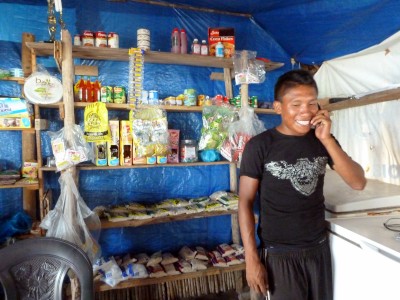
Diagnosing the problem with our KVH satellite phone was a major task for Maynard and Mike. We had no idea if it was a problem at our end or their end so two sleepless nights were spent emailing and talking to technicians in Australia on a very expensive intermittent mobile phone line, tracing wiring, sending out debug information and writing over 200 emails. Everything was checked including the satellite and two sim cards but it seems that our equipment just up and died. It underlined the fact that we are very dependent on our communication equipment and if it doesn’t work, we cannot stay out here. Our only option was to order an entire new upgraded system, a KVH Fleet Broadband 250 including terminal box and antennae and have it shipped to Colon, Panama from Miami in the USA, not a particularly easy task. We’ve also ordered a hand held Immarsat mobile sat phone as another backup. It should all arrive next week in Colon and the guys will install it themselves. Our fingers are crossed that these efforts will be successful. We need to stay in touch and don’t like cutting back on using the internet. What little internet we have using the boat phone is for Maynard’s work commitments, with just a bit left over to post a blog entry. However, it means we now need to go to Colon.
A few days ago we moved 11 miles west to Lemmon Cays as we’d read that there was a resort and restaurant on the island of Banedup. Our imaginations were running wild with the thought of marguerita pizzas, pastas, Mexican food etc. We could hardly wait to see what surprises were waiting for us. The surprise was that the ‘resort’ was deserted except for three locked Kuna huts and a ‘store’ selling odd items;` a bit of rice and a packet or two of Doritos. A Kuna lady swung in a hammock chatting on her cell phone near a couple of bench seats which probably formed part of the ‘restaurant’. It was all very laid back with nothing resembling a place to eat and not what our minds had conceived. Fortunately, we are still living well on the provisions we purchased a month ago in Santa Marta, Colombia.
Each day we look out on perfect tropical islands surrounded by aqua coloured water and reefs. Turtles pop up occasionally and Kunas drop by for a chat or stop to show us their latest huge lobster or crab catches. We try to exercise a few hours per day by snorkelling, stand up paddleboarding, kayaking, swimming, windsurfing etc. A Kuna family, Tito and his wife Floriana and their 2 grandchildren, came by yesterday as Floriana wanted to show me her molas and beaded ankle bracelets. Her molas were perfectly sewn but I asked her in broken Spanish and sign language if she was experiencing trouble with her eyesight as short-sightedness often sets in around age 50. She nodded. I decided to give her my backup reading glasses and when she put them on and looked at her handiwork on her molas, her face lit up like a Christmas tree with so much joy and appreciation as she could see so clearly. If any yachties are coming to Kuna Yala in the future, please try to bring reading glasses for both the older men and women as they desperately need them. I wish I’d brought a suitcase full. Flippers, masks, magazines and small toys are also something they would love as well. Also, the albino children need wide brimmed hats, long sleeve shirts and sunglasses.
Maynard’s foot has improved with only 9 spines embedded in the soft arch of his foot. They are gradually pushing themselves out from the skin while others have dissolved. We feel lucky as this could have been so much worse.
Another decision point is coming our way. The Panama Canal is only 80 odd miles west. Do we transit the canal and bring Vanish back to Australia, do we stay in Panama or do we head through Central America and elsewhere? We’re headed somewhere but not sure where yet.
A few days ago we moved 11 miles west to Lemmon Cays as we’d read that there was a resort and restaurant on the island of Banedup. Our imaginations were running wild with the thought of marguerita pizzas, pastas, Mexican food etc. We could hardly wait to see what surprises were waiting for us. The surprise was that the ‘resort’ was deserted except for three locked Kuna huts and a ‘store’ selling odd items;` a bit of rice and a packet or two of Doritos. A Kuna lady swung in a hammock chatting on her cell phone near a couple of bench seats which probably formed part of the ‘restaurant’. It was all very laid back with nothing resembling a place to eat and not what our minds had conceived. Fortunately, we are still living well on the provisions we purchased a month ago in Santa Marta, Colombia.
Each day we look out on perfect tropical islands surrounded by aqua coloured water and reefs. Turtles pop up occasionally and Kunas drop by for a chat or stop to show us their latest huge lobster or crab catches. We try to exercise a few hours per day by snorkelling, stand up paddleboarding, kayaking, swimming, windsurfing etc. A Kuna family, Tito and his wife Floriana and their 2 grandchildren, came by yesterday as Floriana wanted to show me her molas and beaded ankle bracelets. Her molas were perfectly sewn but I asked her in broken Spanish and sign language if she was experiencing trouble with her eyesight as short-sightedness often sets in around age 50. She nodded. I decided to give her my backup reading glasses and when she put them on and looked at her handiwork on her molas, her face lit up like a Christmas tree with so much joy and appreciation as she could see so clearly. If any yachties are coming to Kuna Yala in the future, please try to bring reading glasses for both the older men and women as they desperately need them. I wish I’d brought a suitcase full. Flippers, masks, magazines and small toys are also something they would love as well. Also, the albino children need wide brimmed hats, long sleeve shirts and sunglasses.
Maynard’s foot has improved with only 9 spines embedded in the soft arch of his foot. They are gradually pushing themselves out from the skin while others have dissolved. We feel lucky as this could have been so much worse.
Another decision point is coming our way. The Panama Canal is only 80 odd miles west. Do we transit the canal and bring Vanish back to Australia, do we stay in Panama or do we head through Central America and elsewhere? We’re headed somewhere but not sure where yet.
Spine Pain
28 September 2013 | Eastern Holandes Cays (The Swimming Pool), Kuna Yala (San Blas), Panama
Vicki – Air 26C/79F, Water 30C/86F, Cloud 8/8, Wind 8 kn SW, Distant Storms
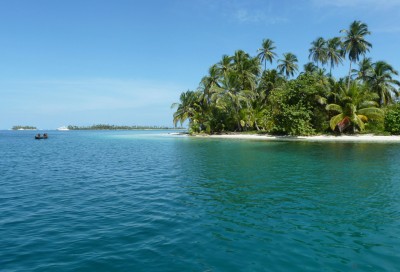
It appears that Maynard has achieved a bit of a World Record. About a week ago while beaching his stand-up paddleboard, he stepped barefoot onto a “nest” of sea urchins and the spines went into the underside of his foot. “Ow, I’ve just cut myself,” he said but when he looked at his foot, he saw black spines protruding which he tried to brush away. Then the pain and swelling set in. We rushed back to Vanish, checked our medical books and internet and started treatment which consisted of a priority large rum and coke and soothing music while I donned a headlamp and grabbed tweezers and a magnifying glass to help me see the spines. After two hours, I’d only managed to pull out four spines and actually pushed two others deeper which didn’t go down well with the patient. There are no doctors within cooee distance so we needed to get the situation under control immediately. Digging them out was impossible. We alternated between soaking his foot in hot vinegar then hot water mixed with salt and antiseptic. The internet stated that if there were more than one spine injury we should seek medical assistance. Maynard had 45 embedded spines. We have a large store of antibiotics which we would have used but after 2 days of soaking and using rubbing alcohol and Betadine, the swelling went away. After 30 days the spines are supposed to dissolve under the skin. In these remote areas we know we have to be very proactive with any medical issues as they can quickly get out of hand.
The Kuna Indians have a long and interesting history. There are 340 islands in this 20 mile stretch and associated mainland territory called Kuna Yala and the Kuna Indians effectively control this quarter of Panama. There are no roads on the mainland area here at all. In fact, we’ve read in our Panama Cruising Guide by Eric Bauhaus, a must for cruising in this area that there are many places no human has ever set foot. The jungle is host to beautiful birds, monkeys and jaguars. The Kunas live on some of the islands and there are a few communities along the coastline. We visited the village of Playon Chico where we hoped to find more delicious Kuna bread and potatoes and to see how the people live. The village huts are packed tightly together and built with cane siding, palm frond roofs and held together by creeper vines with not a nail in sight with floors made of hard packed sand. The door heights are very low and we needed to bend over to enter the doorways. Everything was extremely basic. We were told that 300 adults live in the village but there were too many children to count. As the gene pool is so limited, we estimated that around 5% of the population were albinos. All the villagers treated us kindly and were extremely helpful in showing us around. The village also had a school as we saw children wearing neat uniforms.
Snorkelling is excellent with 30 deg water temperatures and no current to fight against due to the fact that the tidal range is 6 inches to 1 ft. The coral is very pretty but for heaven’s sake don’t touch it like I did when I momentarily lost my brain. Coral stings like hell – sorry for saying hell, but it really hurt eh. For two weeks we’ve experienced low wind but in the last couple of days, we’ve had the chance to sail the Hobie and our new windsurfer. Storms rumble in the mountains, out to sea or overhead almost daily and always between 2 am and 6 am for some reason. We’ve developed the habit of putting all our computers and electronic equipment in the microwaves, our own Faraday Cage to hopefully protect them from lightning strike damage We are currently anchored in a large anchorage at Eastern Holandes Cays known as the Swimming Pool as it’s so flat. There are a few yachts and power boats scattered around. Truly, if you want isolation, a warm climate and low stress, this is the place to be.
Pangas and ulus drop by on a regular basis with locals wishing to sell crabs or lobsters, but yesterday’s panga visit brought Mola Lisa, a well-known Kuna transvestite who embroiders beautiful molas. She is one of 9 children and learned to sew from her mother who handed down all her traditional designs to Lisa. She started sewing at the age of 7 and told me that only the women sew molas while the men fish and tend crops of potatoes, pineapples, yucca and bananas in the mountains. She is an expert on Kuna history and her designs capture the importance of their mythological creatures, sea life, spiritualism and traditional medicine men, women and babies in pretty geometric designs.
During the week, our KVH satellite equipment fatally died meaning we are relying on the boat phone for data and calls, a very expensive option. This means that I can’t post photos at present nor daily Instagrams until we somehow find a replacement unit or go to a marina. Having reliable communication is paramount so we are working on getting back on line as fast as possible.
The Kuna Indians have a long and interesting history. There are 340 islands in this 20 mile stretch and associated mainland territory called Kuna Yala and the Kuna Indians effectively control this quarter of Panama. There are no roads on the mainland area here at all. In fact, we’ve read in our Panama Cruising Guide by Eric Bauhaus, a must for cruising in this area that there are many places no human has ever set foot. The jungle is host to beautiful birds, monkeys and jaguars. The Kunas live on some of the islands and there are a few communities along the coastline. We visited the village of Playon Chico where we hoped to find more delicious Kuna bread and potatoes and to see how the people live. The village huts are packed tightly together and built with cane siding, palm frond roofs and held together by creeper vines with not a nail in sight with floors made of hard packed sand. The door heights are very low and we needed to bend over to enter the doorways. Everything was extremely basic. We were told that 300 adults live in the village but there were too many children to count. As the gene pool is so limited, we estimated that around 5% of the population were albinos. All the villagers treated us kindly and were extremely helpful in showing us around. The village also had a school as we saw children wearing neat uniforms.
Snorkelling is excellent with 30 deg water temperatures and no current to fight against due to the fact that the tidal range is 6 inches to 1 ft. The coral is very pretty but for heaven’s sake don’t touch it like I did when I momentarily lost my brain. Coral stings like hell – sorry for saying hell, but it really hurt eh. For two weeks we’ve experienced low wind but in the last couple of days, we’ve had the chance to sail the Hobie and our new windsurfer. Storms rumble in the mountains, out to sea or overhead almost daily and always between 2 am and 6 am for some reason. We’ve developed the habit of putting all our computers and electronic equipment in the microwaves, our own Faraday Cage to hopefully protect them from lightning strike damage We are currently anchored in a large anchorage at Eastern Holandes Cays known as the Swimming Pool as it’s so flat. There are a few yachts and power boats scattered around. Truly, if you want isolation, a warm climate and low stress, this is the place to be.
Pangas and ulus drop by on a regular basis with locals wishing to sell crabs or lobsters, but yesterday’s panga visit brought Mola Lisa, a well-known Kuna transvestite who embroiders beautiful molas. She is one of 9 children and learned to sew from her mother who handed down all her traditional designs to Lisa. She started sewing at the age of 7 and told me that only the women sew molas while the men fish and tend crops of potatoes, pineapples, yucca and bananas in the mountains. She is an expert on Kuna history and her designs capture the importance of their mythological creatures, sea life, spiritualism and traditional medicine men, women and babies in pretty geometric designs.
During the week, our KVH satellite equipment fatally died meaning we are relying on the boat phone for data and calls, a very expensive option. This means that I can’t post photos at present nor daily Instagrams until we somehow find a replacement unit or go to a marina. Having reliable communication is paramount so we are working on getting back on line as fast as possible.
What A Mess
16 September 2013 | Playon Chico, Kuna Yala (San Blas), Panama
Vicki – 8/8 Cloud, 82F/27C, Rumbling Storms Nearby, 2 kn S
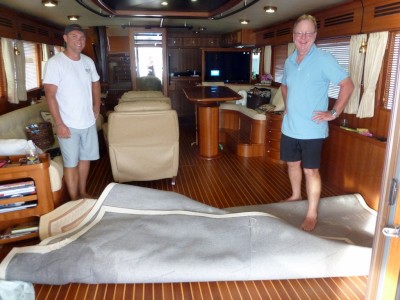
The tropics have many redeeming features. The clouds are spectacular, the rain is thick and heavy, and the air and water temperatures are the same – hot. The only decision to be made each day is whether to wear a bathing costume or the lightest flimsiest material possible to protect one from the sun. However, there are a few downsides. As we anchor out most of the time, our solar panels provide a great deal of power to the boat meaning that we don’t need to run the gensets more than about 3 hours a day. This means that we don’t run air conditioning a lot as the boat is open to the breezes and whatever temperature is outside, is also inside the boat. When provisioning in Colombia, we knew from prior experience in the tropics that all fruit or vegetables such as pineapples, apples, potatoes, onions etc needed to be stored in our refrigerators as they will rot in no time at all. The one exception I made was to buy two very large delicious looking watermelons at 10 cents/pound in Santa Marta which I lovingly wrapped in separate beach towels and placed in a wicker basket in the salon.
It was a scorcher on Saturday morning with 100% humidity and 92F (33 C) and watermelon was on the menu. I walked over to the wicker basket sitting on our salon carpet and lo and behold, sweet sticky watermelon juice came bubbling up between my toes. Oh nooooooo. As I picked up the basket, the rotting smell and melon bits were ghastly. One of the melons had popped and the other was preparing itself to disgorge onto the carpet. We now had a 3 ft x 2 ft sugary wet mess fermenting on the carpet in this lovely tropical heat. I tried sopping it up with towels and dousing it with water but this was not going to work. There was nothing for it but to lock up the boat, clear our minds, go for a snorkel and think of a strategy.
On our return, we opened the door of the hot salon and you can just imagine the smell. We’d decided to take the carpet outside to wash the damaged section but needed to move all the furniture including the salon table which was screwed through the carpet to the floor. This all took a great deal of effort but rolling up the carpet and lifting it outside was a real heart popper as the carpet weighs at least 300+ lbs (150 kg). We washed and hosed the area with around 150 gallons of water then used a wet/dry vac, more towels to soak up dampness then brought it all back inside, replaced the furniture, washed 5 loads of towels, ran the watermaker and were all done by 10 pm. The next morning revealed a carpet with no smell and no stains although it will take a week to fully dry out. That’s the tropics for you.
Lesson of the Day: Don’t put watermelons in a basket on the carpet. Period!
It was a scorcher on Saturday morning with 100% humidity and 92F (33 C) and watermelon was on the menu. I walked over to the wicker basket sitting on our salon carpet and lo and behold, sweet sticky watermelon juice came bubbling up between my toes. Oh nooooooo. As I picked up the basket, the rotting smell and melon bits were ghastly. One of the melons had popped and the other was preparing itself to disgorge onto the carpet. We now had a 3 ft x 2 ft sugary wet mess fermenting on the carpet in this lovely tropical heat. I tried sopping it up with towels and dousing it with water but this was not going to work. There was nothing for it but to lock up the boat, clear our minds, go for a snorkel and think of a strategy.
On our return, we opened the door of the hot salon and you can just imagine the smell. We’d decided to take the carpet outside to wash the damaged section but needed to move all the furniture including the salon table which was screwed through the carpet to the floor. This all took a great deal of effort but rolling up the carpet and lifting it outside was a real heart popper as the carpet weighs at least 300+ lbs (150 kg). We washed and hosed the area with around 150 gallons of water then used a wet/dry vac, more towels to soak up dampness then brought it all back inside, replaced the furniture, washed 5 loads of towels, ran the watermaker and were all done by 10 pm. The next morning revealed a carpet with no smell and no stains although it will take a week to fully dry out. That’s the tropics for you.
Lesson of the Day: Don’t put watermelons in a basket on the carpet. Period!
Bliss in San Blas
13 September 2013 | Snug Harbour, Near Playa Chico, Kuna Yala (San Blas Islands), Panama
Vicki – Air 25C/78F Min, 27C/81F Max, Water 30 deg C, Cloud 7/8, Storm rumbling nearby, Wind <1knNE
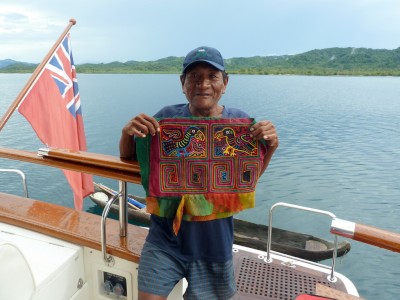
Remember that great song by Van Halen called Panama? It's now our new anthem on Vanish played daily on sunset as loud as possible with not a soul in sight for miles. Maynard and I never thought in a million years that we'd be in Panama on our own vessel, yet here we are. The overnight passage from Puerto Velero to the eastern end of the San Blas Islands went extremely well with less than a meter of swell and storms behind us, in front of us, to the side of us, but never on top of us. We're now anchored in 15 meters of water in a harbour with protection from almost all weather and we are the only vessel here. The native Kuna Indians who live here are unique in that they have preserved their culture and traditions the best out of all the tribes in the Americas. The area is reachable by sea and air with a few airstrips built by North Americans during WWII. The Kunas are the second smallest in stature in the world next to pygmies and are very healthy and energetic. They have very little crime, they cannot intermarry and do not allow foreigners to buy their land. The cruising grounds here are incredibly beautiful with white beaches which the Kuna people sweep every few days. Coconut palms and weird tropical fruit such as lonnie grow abundantly. We were given four lonnie fruit by Kuna Munoz and told it is a natural remedy when rubbed on the skin used for aches and pains and can also be taken with water to increase one's energy.
On our first day, we were visited by at least 5 dugout canoes called ulus selling lobsters (5 for $US5), large crabs, snapper, pineapples, yucca, bananas, coconuts, cucumbers, potatoes and their famous embroidery work called molas. The Kuna speak broken Spanish and a little English mixed with the Kuna language so we are able to communicate quite well. Kunas marry when they are considered mature and often the women choose their husbands. They also control the money and the husbands move into the women's family compound. Their currency is US Dollars but the charges are minimal. An "Anchor Man" came by in his ulu and handed me a receipt book which he wanted me to fill out and I saw that he wanted me to write the name of our yacht, date, country etc. The $US10 fee allows us to stay for a period of time, but I could not figure out how long. When I looked through the book, I noticed that we are only the 7th boat to visit this year. Another Kuna named Dyon sold us a few of his wife's molas . Each mola takes 6 months to embroider using unique patterns of birds, crabs, and chickens in colourful block stitching. The women wear them as part of their blouses and when they are tired of them, they sell them to passing vessels. Dyon's village has some electricity generated from solar panels and they actually have limited internet and a few cell phones with the data transmitted via microwave link to repeater stations in Punta San Blas and Isla Pinos. As long as those solar panels are exposed to the sun, they can make their phone calls but we wonder, who are they calling? Yesterday, Dyon brought us fresh baked Kuna bread which his wife had baked at 7 am. It was soft, hot and absolutely delicious when he delivered it in his ulu at 8.30. Our mission is to find Dyon again and order more bread as we love it.
Until recently, coconuts were the official means of exchange and every coconut palm is owned by a tribal member on all of their islands. For this reason, we are not allowed to take any coconuts, nor are we allowed to do any diving. These wonderful friendly people experience very little stress. They are blessed with a perfect climate, abundant rain, good soil, rainforest fruits and wood and a sea rich with many varieties of crustaceans and fish.
We have travelled the Pacific, North America and the Caribbean and this is without doubt the most beautiful, idyllic place we have ever seen even though Palmyra Island is a close second. The storm clouds are spectacular and the temperature is 10 deg cooler than anywhere else in the Caribbean. The water is the kind of temperature where you can just slide in and enjoy it even though we were inspected by a 6 ft crocodile sneaking past our swim platform.
Every Kuna has assured us they are harmless so we swim, paddle board and kayak, something we would never do in Australia with crocodiles. There are other yachts here and we love the isolation. The cruising is fantastic; the list of positives is endless. Would someone please tell me what day it is as we've lost track of time already and if we're still on planet Earth. We can't believe our luck. We've hit the jackpot and can now see why cruisers come to the San Blas and never leave.
p.s. If you have access to Google Earth, enter our Latitude and Longitude
9 19.257'N:78 deg 15.340'W
and you will see our exact anchored location and see where the San Blas Islands are located.
On our first day, we were visited by at least 5 dugout canoes called ulus selling lobsters (5 for $US5), large crabs, snapper, pineapples, yucca, bananas, coconuts, cucumbers, potatoes and their famous embroidery work called molas. The Kuna speak broken Spanish and a little English mixed with the Kuna language so we are able to communicate quite well. Kunas marry when they are considered mature and often the women choose their husbands. They also control the money and the husbands move into the women's family compound. Their currency is US Dollars but the charges are minimal. An "Anchor Man" came by in his ulu and handed me a receipt book which he wanted me to fill out and I saw that he wanted me to write the name of our yacht, date, country etc. The $US10 fee allows us to stay for a period of time, but I could not figure out how long. When I looked through the book, I noticed that we are only the 7th boat to visit this year. Another Kuna named Dyon sold us a few of his wife's molas . Each mola takes 6 months to embroider using unique patterns of birds, crabs, and chickens in colourful block stitching. The women wear them as part of their blouses and when they are tired of them, they sell them to passing vessels. Dyon's village has some electricity generated from solar panels and they actually have limited internet and a few cell phones with the data transmitted via microwave link to repeater stations in Punta San Blas and Isla Pinos. As long as those solar panels are exposed to the sun, they can make their phone calls but we wonder, who are they calling? Yesterday, Dyon brought us fresh baked Kuna bread which his wife had baked at 7 am. It was soft, hot and absolutely delicious when he delivered it in his ulu at 8.30. Our mission is to find Dyon again and order more bread as we love it.
Until recently, coconuts were the official means of exchange and every coconut palm is owned by a tribal member on all of their islands. For this reason, we are not allowed to take any coconuts, nor are we allowed to do any diving. These wonderful friendly people experience very little stress. They are blessed with a perfect climate, abundant rain, good soil, rainforest fruits and wood and a sea rich with many varieties of crustaceans and fish.
We have travelled the Pacific, North America and the Caribbean and this is without doubt the most beautiful, idyllic place we have ever seen even though Palmyra Island is a close second. The storm clouds are spectacular and the temperature is 10 deg cooler than anywhere else in the Caribbean. The water is the kind of temperature where you can just slide in and enjoy it even though we were inspected by a 6 ft crocodile sneaking past our swim platform.
Every Kuna has assured us they are harmless so we swim, paddle board and kayak, something we would never do in Australia with crocodiles. There are other yachts here and we love the isolation. The cruising is fantastic; the list of positives is endless. Would someone please tell me what day it is as we've lost track of time already and if we're still on planet Earth. We can't believe our luck. We've hit the jackpot and can now see why cruisers come to the San Blas and never leave.
p.s. If you have access to Google Earth, enter our Latitude and Longitude
9 19.257'N:78 deg 15.340'W
and you will see our exact anchored location and see where the San Blas Islands are located.
Navigational Tools and Apps
10 September 2013 | Offshore Colombia - 10 deg 51.115N;70 deg 24.643W
Vicki – Cloud 5/8, Air 30 deg C, Air 30 deg C, Wind 6 kn SW, Sea < 1m
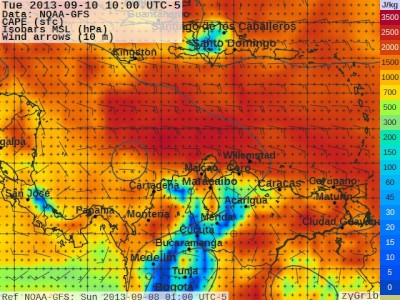
Before leaving Santa Marta yesterday, Maynard downloaded a programme called ZyGrib (you can find it on Google) which was suggested to us by Diana and Andrew who are soon to complete a 4 year round the world trip on their cutter rigged yacht 35ft Saviah. It is a very comprehensive World-Wide weather forecasting programme which has the normal functions of wind and waves but also has a lot of other indicators such as winds and isobars at various altitudes in the atmosphere, CAPE and CIN. These initial tools are very handy for storm predictions, especially in the tropics. CAPE is a measure of how much electricity is actually stored in the atmosphere and CIN is a measure of the atmosphere's capacity to store electricity. Using these two maps, one can get an idea as to where the thunderstorm hotspots might be well in advance of actually seeing any sign of a storm. The above CAPE map which was generated at the time of writing this post shows that the Central Caribbean has high capacity for thunderstorms whereas the area where we are which is about 40 miles from Cartagena has a relatively low electrical charge and hence accounts for the clear weather we're currently experiencing with a few cumulus clouds in the vicinity. You can also see that the winds are very light and the sea state is no more than 0.3 m which was ZyGrib's forecast.
After refueling at the Santa Marta Marina and saying fond goodbyes to the staff, we motored 57 miles yesterday following the Colombian coastline passing the Magdalena River which has a reputation for large debris and weird currents and waves. We've seen numerous large logs floating 4 to 5 miles offshore and clumps of weed which we've managed to dodge. We arrived at Puerto Velero as the sun was setting. Interestingly, the book The Cruising Guide to Colombia, our Raymarine Charts and the latest paper Colombian chart all had the point at Puerto Velero plotted 1mile north of its actual position. The Magdalena River dumps so much sediment into this area that all charts say that depths and land forms can significantly change from year to year so a visual approach was necessary. The Magdalena River is one of the largest rivers in South America. We anchored opposite a marina in a large sheltered bay with good mud holding in 6 m of dead flat water.

Storms popped up after sundown so Maynard set the anchor alarm on a new App on his Samsung Galaxy 8.0 Note with inbuilt accurate GPS called My Anchor Watch. There are versions for Android or Apple. This is a really fantastic App as we can now turn off all boat electronics to save electricity overnight. The App itself keeps a very close track of the vessel's position and has a loud alarm which sounds as soon as you get a preset distance away from the anchor. Maynard found this App recommended on Kens Blog. Ken is currently on a Nordhavn 68 and has written one of the most followed blogs ever on a power boat. It Is full of information and we've read his 3 books generated from that blog as they are so interesting. Thank you Ken.
At 0730 we were visited by Colombian Armada Nacionale (Coast Guard) who came on board to check our Zarpe (Clearance) papers, inspect the boat and make sure all was well. We told them we were just about to weigh anchor and they looked disappointed as they would have allowed us to stay much longer if we wished to do so. They were extremely polite and cheerful and loved the boat. They probably don't see too many like ours down this way.
If you're wondering about buying Colombian fuel, we were charged $US4.40 per gallon and have been polishing the fuel on a 2 micron filter with no significant problems yet.
After refueling at the Santa Marta Marina and saying fond goodbyes to the staff, we motored 57 miles yesterday following the Colombian coastline passing the Magdalena River which has a reputation for large debris and weird currents and waves. We've seen numerous large logs floating 4 to 5 miles offshore and clumps of weed which we've managed to dodge. We arrived at Puerto Velero as the sun was setting. Interestingly, the book The Cruising Guide to Colombia, our Raymarine Charts and the latest paper Colombian chart all had the point at Puerto Velero plotted 1mile north of its actual position. The Magdalena River dumps so much sediment into this area that all charts say that depths and land forms can significantly change from year to year so a visual approach was necessary. The Magdalena River is one of the largest rivers in South America. We anchored opposite a marina in a large sheltered bay with good mud holding in 6 m of dead flat water.

Storms popped up after sundown so Maynard set the anchor alarm on a new App on his Samsung Galaxy 8.0 Note with inbuilt accurate GPS called My Anchor Watch. There are versions for Android or Apple. This is a really fantastic App as we can now turn off all boat electronics to save electricity overnight. The App itself keeps a very close track of the vessel's position and has a loud alarm which sounds as soon as you get a preset distance away from the anchor. Maynard found this App recommended on Kens Blog. Ken is currently on a Nordhavn 68 and has written one of the most followed blogs ever on a power boat. It Is full of information and we've read his 3 books generated from that blog as they are so interesting. Thank you Ken.
At 0730 we were visited by Colombian Armada Nacionale (Coast Guard) who came on board to check our Zarpe (Clearance) papers, inspect the boat and make sure all was well. We told them we were just about to weigh anchor and they looked disappointed as they would have allowed us to stay much longer if we wished to do so. They were extremely polite and cheerful and loved the boat. They probably don't see too many like ours down this way.
If you're wondering about buying Colombian fuel, we were charged $US4.40 per gallon and have been polishing the fuel on a 2 micron filter with no significant problems yet.
Win Win
08 September 2013 | Santa Marta, Colombia
Vicki – 6/8 Cloud, Air 31 deg C, Water 30 deg C, Wind 5 kn NE, Storm Coming
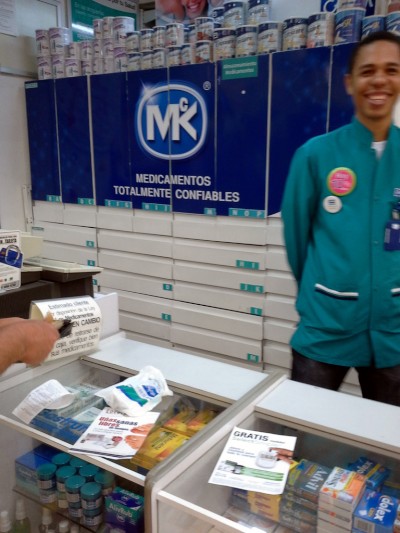
On Friday, Dino, our Colombian Shipping Agent returned our passports and gave us our Clearance Papers. We were now ready to cast off our lines, pay our bills and head for Panama in the next day or so. But first, we had other important business to attend to as it was Maynard's birthday so we wandered into Santa Marta for a nice lunch on probably the hottest, most humid day we've felt. It was noon and the first thing we noticed was that the streets were practically deserted with no taxis, no motor cycles, no donkeys and very few people. Turned out that Colombia was to play soccer against Ecuador Friday afternoon in nearby Barranquilla and everyone in the country had either gone home to watch it on tv or were already in the local bars hydrating at a rapid rate. We dragged our already severely dehydrated bodies back to the boat as no suitable eating establishments were open. The weather was a precursor to a massive storm which hit Barranquilla before kick-off and the game was delayed while water was removed from the field by a bunch of guys stabbing the ground with pitch forks in order to drain away the water. How funny. This impressive storm also made its way up to Santa Marta and before we knew it, we were experiencing 30 knots of wind and drenching rain but it felt so much better.
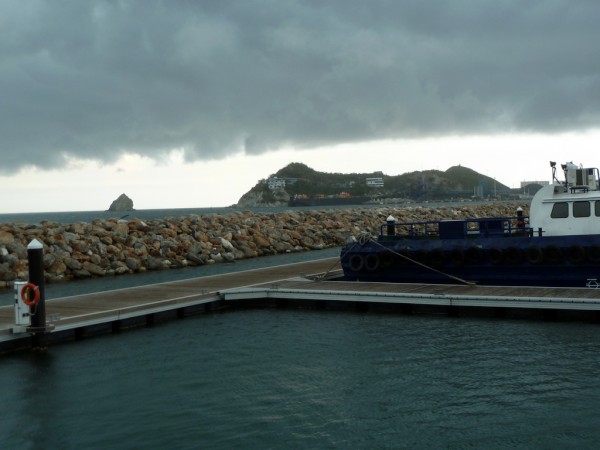
We headed up to the Captains Lounge at the Marina to watch the game and sat with the most enthusiastic, noisy, excited Colombian marina staff and boat owners you could imagine. Then an Ecuadorian star mid fielder was given a red card and had to leave the field which opened up their back line allowing Colombia to make a quick score, the only score of the game. It was tense and exciting and then the lights went out on the field causing a ½ hour delay but the massive crowd sat patiently. There was much drama at the end of the game when Ecuador was awarded a controversial penalty shot. Their star striker slotted the ball just left of the goal and the 50,000 spectators at the stadium and all of Santa Marta erupted with cheering, fire crackers, and horn blasts. This win moved Colombia to No. 1 on the South America World Cup qualifying table and we were there to feel it and see it with the Colombians. We headed into town again for a late celebration dinner and as it was still raining we had to duck and dodge the flooded streets. Michael wasn't wearing his shoes when we walked through the small town park near the restaurant and while walking along the sidewalk suddenly received a shock from a metal cover sitting flush with the concrete. He jumped a bit and we thought we might have to crash tackle him but he was ok. He wore his thongs after that. There was only one other hiccup. Maynard's back tore again.
Maynard has been reading that prescription drugs are super cheap in these types of countries and as he was saving his last anti-inflammatory Mobic pill, we jumped in our $US 2 taxi the following day to visit the Drugueria at the grocery store called Exito. We showed the smiling attendant the packet and he checked under "M" in his drawer for Meloxicam and handed over a box for $US 2. (Everything seems to cost about $US 2, as even a packet of Marlboro cigarettes which we don't smoke also cost $US 2). In Australia, this exercise would have cost well over $100 after going to the doctor and paying for the prescription. Well, this was a tremendous win and worked like a charm so he bought 3 boxes and coughed up $ US 6 and crab walked away with the biggest grin on his face I've seen for a while. I am happy to say that he feels a lot better so we think we're clear to leave soon.

We headed up to the Captains Lounge at the Marina to watch the game and sat with the most enthusiastic, noisy, excited Colombian marina staff and boat owners you could imagine. Then an Ecuadorian star mid fielder was given a red card and had to leave the field which opened up their back line allowing Colombia to make a quick score, the only score of the game. It was tense and exciting and then the lights went out on the field causing a ½ hour delay but the massive crowd sat patiently. There was much drama at the end of the game when Ecuador was awarded a controversial penalty shot. Their star striker slotted the ball just left of the goal and the 50,000 spectators at the stadium and all of Santa Marta erupted with cheering, fire crackers, and horn blasts. This win moved Colombia to No. 1 on the South America World Cup qualifying table and we were there to feel it and see it with the Colombians. We headed into town again for a late celebration dinner and as it was still raining we had to duck and dodge the flooded streets. Michael wasn't wearing his shoes when we walked through the small town park near the restaurant and while walking along the sidewalk suddenly received a shock from a metal cover sitting flush with the concrete. He jumped a bit and we thought we might have to crash tackle him but he was ok. He wore his thongs after that. There was only one other hiccup. Maynard's back tore again.
Maynard has been reading that prescription drugs are super cheap in these types of countries and as he was saving his last anti-inflammatory Mobic pill, we jumped in our $US 2 taxi the following day to visit the Drugueria at the grocery store called Exito. We showed the smiling attendant the packet and he checked under "M" in his drawer for Meloxicam and handed over a box for $US 2. (Everything seems to cost about $US 2, as even a packet of Marlboro cigarettes which we don't smoke also cost $US 2). In Australia, this exercise would have cost well over $100 after going to the doctor and paying for the prescription. Well, this was a tremendous win and worked like a charm so he bought 3 boxes and coughed up $ US 6 and crab walked away with the biggest grin on his face I've seen for a while. I am happy to say that he feels a lot better so we think we're clear to leave soon.
The Jitters
05 September 2013 | Santa Marta, Colombia
Vicki – Afternoon/Night Storms, 6/8 Cloud, 30 deg C, Over Night 24 deg C, Wind 3 kn NW then NE
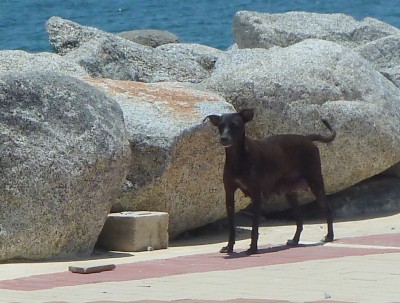
While waiting patiently for Maynard's back to heal we took the opportunity to slowly wander around the marina looking at the other boats, as you do. Chatting to fellow sailors can be fascinating as you get to find out what's ahead or if asked, advise them what we've encountered. We met a couple on the day they arrived from the San Blas Islands, Panama looking ....well, a bit fried, or even frazzled. Once we started chatting they told us they'd just spent a month in San Blas but their ketch had been hit by lightning not just once, but twice on two separate occasions and they'd had two other very near misses and just wanted to get the hell outa there as they couldn't take the lightning any more. They were in the cockpit at the time and said they saw a yellow ball of phosphor travel down the mast. Their engine died temporarily but unbelievably, they had no other issues. It just so happens that this is where we and another couple we've met want to go. We know of at least 5 boats who have been hit by lightning this season in the San Blas and it is certainly a worry for us. Their story made us all get the jitters.
We felt we should stop and consider whether we should change strategies and perhaps head east towards Trinidad instead. Now that Tropical Storm Gabriel has formed near Puerto Rico, the winds will probably die allowing us to sneak across the top of South America while all the action is further north. When a hurricane follows its typical track around Puerto Rico or Hispaniola, then the tradewinds along the north coast of South America can stop or temporarily reverse. This creates a weather window for boats travelling west to east. In fact, another yacht did exactly that this morning and is now heading east to Bonaire. We certainly have developed the vagabond type of reputation, going where the wind blows. In fact, Vanish was originally named Vagabundo by David Marlow at the time of her purchase. It really doesn't matter where we go as long as we stay out of the hurricane zone. Anyway, we've ditched that plan and are readying ourselves for a 250 mile trot down to the San Blas as we've heard it's a stunningly beautiful place and we don't want to miss it.
Vanish has now sat in the IGY Santa Marta Marina for over 3 months and we've felt extremely safe and well looked after by the staff. Today we met the UK IGY Executive Vice President Kenny Jones who has taken us under his wing and will help us out if needed at any other IGY marina we plan on visiting. Again I've encountered the problem of homesickness as well as marina fever and the need to get back out on the water. This, mixed with a new attachment to a dog caring for her puppies living in the rock wall at the marina (above pic) makes each day a bit of a challenge. I've called her Rocky Mumma and I've been sneaking fresh water and dog food to her each night. Apparently this is at least her 3rd litter in the rocks. She has changed rapidly over the past 2 weeks from a starving, skittish, frightened animal to a tail-wagging happy, relaxed dog although she is still very protective of her tiny pups who we can hear whimpering in the darkness. At least she's felt happiness for 2 weeks of her short life and I just hope someone else will help her when we leave. The same can't be said for so many other miserable creatures here such as Chocolate, Woody, Harley, Skinny and many others but we try to find and feed a lucky dog or two each day in the streets as I always carry dry dog food in my handbag everywhere I go. I try to ignore the dog problem here but find it impossible. I wish there was something I could do.
Oh yes, we also had another problem which drained Maynard's, Michael's and my energy last week. Stupidly, I thought I could find the female equivalent of our happy crewmember Michael to look after cooking, provisioning and the interior. The person we found and flew in from the US had a glorified resume and I will never use that particular crew agency ever again. Within less than a day, we knew we were in trouble with her and sent her back to the US after only 3 days of endless problems. We have, however, between the 3 of us, completed all the provisioning and many other jobs required for this next passage.
The San Blas islands have very limited internet but we will try to write as often as possible. We will do our best to stay connected. We may be in this isolated area for around a month so just keep checking.
We felt we should stop and consider whether we should change strategies and perhaps head east towards Trinidad instead. Now that Tropical Storm Gabriel has formed near Puerto Rico, the winds will probably die allowing us to sneak across the top of South America while all the action is further north. When a hurricane follows its typical track around Puerto Rico or Hispaniola, then the tradewinds along the north coast of South America can stop or temporarily reverse. This creates a weather window for boats travelling west to east. In fact, another yacht did exactly that this morning and is now heading east to Bonaire. We certainly have developed the vagabond type of reputation, going where the wind blows. In fact, Vanish was originally named Vagabundo by David Marlow at the time of her purchase. It really doesn't matter where we go as long as we stay out of the hurricane zone. Anyway, we've ditched that plan and are readying ourselves for a 250 mile trot down to the San Blas as we've heard it's a stunningly beautiful place and we don't want to miss it.
Vanish has now sat in the IGY Santa Marta Marina for over 3 months and we've felt extremely safe and well looked after by the staff. Today we met the UK IGY Executive Vice President Kenny Jones who has taken us under his wing and will help us out if needed at any other IGY marina we plan on visiting. Again I've encountered the problem of homesickness as well as marina fever and the need to get back out on the water. This, mixed with a new attachment to a dog caring for her puppies living in the rock wall at the marina (above pic) makes each day a bit of a challenge. I've called her Rocky Mumma and I've been sneaking fresh water and dog food to her each night. Apparently this is at least her 3rd litter in the rocks. She has changed rapidly over the past 2 weeks from a starving, skittish, frightened animal to a tail-wagging happy, relaxed dog although she is still very protective of her tiny pups who we can hear whimpering in the darkness. At least she's felt happiness for 2 weeks of her short life and I just hope someone else will help her when we leave. The same can't be said for so many other miserable creatures here such as Chocolate, Woody, Harley, Skinny and many others but we try to find and feed a lucky dog or two each day in the streets as I always carry dry dog food in my handbag everywhere I go. I try to ignore the dog problem here but find it impossible. I wish there was something I could do.
Oh yes, we also had another problem which drained Maynard's, Michael's and my energy last week. Stupidly, I thought I could find the female equivalent of our happy crewmember Michael to look after cooking, provisioning and the interior. The person we found and flew in from the US had a glorified resume and I will never use that particular crew agency ever again. Within less than a day, we knew we were in trouble with her and sent her back to the US after only 3 days of endless problems. We have, however, between the 3 of us, completed all the provisioning and many other jobs required for this next passage.
The San Blas islands have very limited internet but we will try to write as often as possible. We will do our best to stay connected. We may be in this isolated area for around a month so just keep checking.
Pesos From Heaven
28 August 2013 | Santa Marta, Colombia
Vicki – 29 deg C/84 deg F, 6/8 Cloud, Afternoon Storms, 95% Humidity, Water Temp 30C/85F
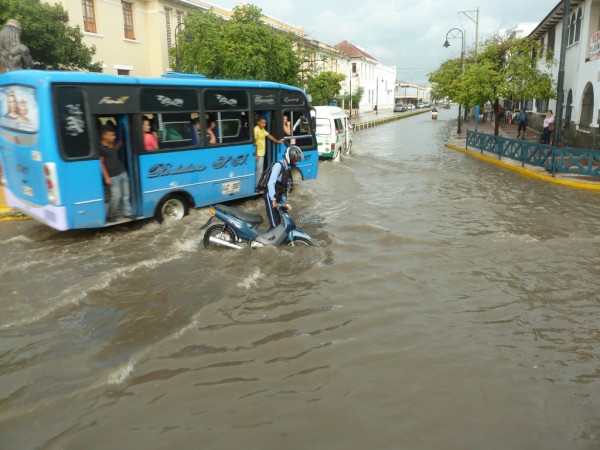
I know you've been waiting a long time for this update and I bet you've wondered if we were ever going to go back to Colombia but here we are and all is well. During our home/work vacation, Maynard spent many hours reading blogs about boats whose owners travel back and forth, sometimes being away for very long periods only to come back to mould, exploded batteries, fried electrical systems, flooding, pests and other shocking scenarios. Luckily, we'd had just enough time to teach our new crew member Michael how to go through his daily checklist on all systems and he and Maynard regularly emailed and telephoned each other to deal with any problems. One day, Mike emailed us to say he had a fresh water leak in an air conditioning unit which thankfully turned out to be just a loose fitting. The dialog between Maynard and Michael worked really well. If we had left Vanish to fend for herself in the Santa Marta Marina, who knows what problems we would have had to face on our return. By using and flushing the boat systems regularly, we seem to have avoided major problems. The Marina staff have treated us with incredible respect and politeness and have done everything in their power to help us in every way. The boat is completely safe and we feel so fortunate having found such a modern, clean, well-functioning marina with lots of space, no surge, and good weather in a country so different and so far from the USA.
It turns out that not only do the houses and hotels in the town of Santa Marta have no hot water, it has no, I mean NO, drainage system. So when it rains, all the streets turn into fast running drains full of any garbage left on the streets. Bastidas, the main street in town in the above picture, turned into a raging torrent yesterday during a particularly heavy downpour. We waited for the water to drop about 2 feet before heading into town. Local street vendors love the rain as they make a killing placing boards across puddles and charging a few pesos to the passers-by who want to keep their feet dry. Pesos from heaven indeed and a very lucrative business in the wet season.
The roads are a challenge on any normal given day, but during rain, the dangers are hidden. The motorcyclist above just happened to drop his front tire into a crack where it became well and truly stuck while buses, vans, taxis and dozens of other motorbikes whizzed past. He spent a long time yanking on the tire whilst avoiding being run over or swept down current. Where does all the water end up? In the marina of course and out to sea. Yesterday the marina was dirty brown with floating cardboard boxes and sytrofoam but today it is clean with crystal clear sea water.
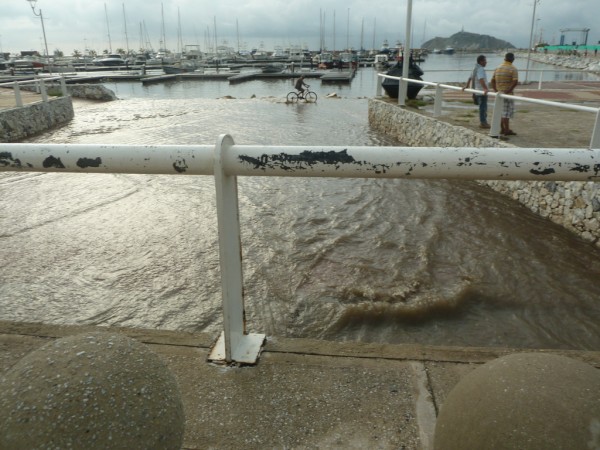
Maynard has unfortunately torn a back muscle while retrieving my suitcase at the Barranquilla, Colombia baggage claim. It was full of Sees Chocolates ...well that's a slight exaggeration but I do like those chokkies. He's not a good patient and is anxious to head out but a bad back takes time to heal so we are currently working at provisioning and readying ourselves for the next leg to the San Blas Islands, Panama, a distance of around 250 miles. But we're not going anywhere until he stops walking like a crab.
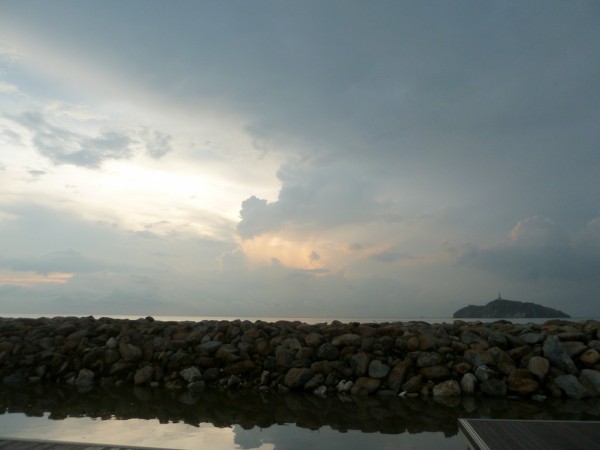
Break
11 June 2013 | Colombia, South America
Vicki

We’ll be taking a break until the end of August with work and home commitments. When we return, we'll be heading off again so in the meantime, take care and we look forward to the next phase of Vanish adventures.
| Vessel Name: | Vanish |
| Vessel Make/Model: | Marlow Voyager 76LR |
| Hailing Port: | Brisbane, Queensland, Australia |
| Crew: | Maynard and Vicki |
| Home Page: | sailblogs.com/member/vanish |
Vanish's Photos - Lazy Shark
Photo 4 of 8 | Back To Album |
Alison, Maynard, Nick and Vicki in the Yacht Club Pub on Green Turtle Cay. Dollar notes were plastered all over the walls and ceiling along with colourful burgees from visiting yachts.
Added 6 December 2012
Vanish
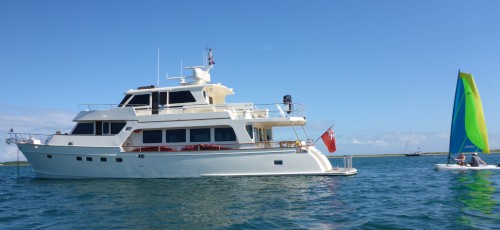
Who: Maynard and Vicki
Port: Brisbane, Queensland, Australia
Favourites - Videos & Websites
- Flopper Stopper Info
- Puffin Live Streaming (During June/July/August)
- Video - Life's A Beach
- Video - Swimming Pigs of Staniel Cay, Exuma, Bahamas
- Wide Open Throttle
- Free Cruising Guides
- Intellicast Infrared Weather
- zyGrib Weather Forecasting
- Pink Sand Beach at Harbour Island aka Briland, Eleuthera, The Bahamas
- Power & Motoryacht Magazine Article on Vanish Mar 2013
- Amazing Limbo Dancer Vicki Filmed at Port Lucaya, Grand Bahama Dec 2012
- Puffin and Foghorn Sounds at Matinicus Rock, Maine, USA
- Take A Peek Inside Vanish

